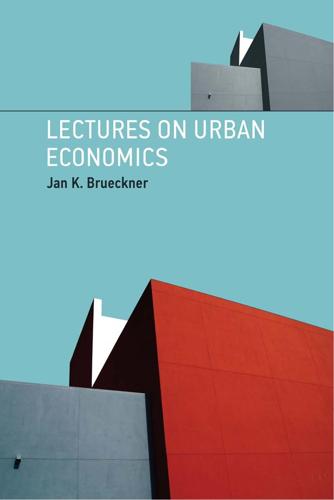
Lectures on Urban Economics
by
Jan K. Brueckner
Published 14 May 2011
HT321.B78 2011 330.09173'2—dc22 2011006524 10 9 8 7 6 5 4 3 2 1 Contents Preface 1 1.1 1.2 1.3 1.4 1.5 1.6 1.7 2 2.1 2.2 2.3 2.4 2.5 2.6 2.7 2.8 3 3.1 3.2 3.3 3.4 3.5 3.6 3.7 ix Why Cities Exist 1 Introduction 1 Scale Economies 2 Agglomeration Economies 5 Transport Costs and Firm Location 10 The Interaction of Scale Economies and Transportation Costs in the Formation of Cities 16 Retail Agglomeration and the Economics of Shopping Centers 18 Summary 20 Analyzing Urban Spatial Structure Introduction 23 Basic Assumptions 25 Commuting Cost 26 Consumer Analysis 27 Analysis of Housing Production 33 Population Density 39 Intercity Predictions 42 Summary 50 23 Modifications of the Urban Model 51 Introduction 51 A City with Two Income Groups 51 Commuting by Freeway 56 Adding Employment Outside the CBD 57 Durable Housing Capital 61 Cities in Developing Countries 65 Summary 68 vi 4 4.1 4.2 4.3 4.4 4.5 4.6 4.7 5 5.1 5.2 5.3 5.4 5.5 5.6 5.7 5.8 6 6.1 6.2 6.3 6.4 6.5 6.6 6.7 7 7.1 7.2 7.3 7.4 7.5 8 8.1 8.2 8.3 Contents Urban Sprawl and Land-Use Controls 69 Introduction 69 Empirical Evidence on the Spatial Sizes of Cities 70 Market Failures and Urban Sprawl 73 Behavioral Impacts of Urban Sprawl 80 Using Land-Use Controls to Attack Urban Sprawl 80 Other Types of Land-Use Controls 84 Summary 89 Freeway Congestion Introduction 91 Congestion Costs 92 91 The Demand for Freeway Use 95 Traffic Allocations: Equilibrium and Social Optimum Congestion Tolls 104 Choice of Freeway Capacity 110 Application to Airport Congestion 112 Summary 114 99 Housing Demand and Tenure Choice 115 Introduction 115 Housing Demand: The Traditional and Hedonic Approaches The User Costs of Housing 119 Tenure Choice 124 Down-Payment Requirements, Tenure Choice, and Mortgage Default 130 Property Abuse and Tenure Choice 133 Summary 136 Housing Policies Introduction 137 Rent Control 137 137 Housing-Subsidy Programs 145 Homelessness and Policies to Correct It Summary 157 Local Public Goods and Services Introduction 159 153 159 The Socially Optimal Level of a Public Good 161 Majority Voting and Voting with One’s Feet 163 116 Contents vii 8.4 8.5 8.6 8.7 Public-Good Congestion and Jurisdiction Sizes 174 Capitalization and Property-Value Maximization 179 Tax and Welfare Competition 183 Summary 185 9 Pollution 9.1 9.2 9.3 9.4 9.5 9.6 Introduction 187 Pollution from a Single Factory and Governmental Remedies 188 Bargaining as a Path to the Social Optimum: The Coase Theorem 196 Cap-and-Trade Systems 200 Evidence on Air Pollution and Property Values 204 Summary 205 10 Crime 187 207 Introduction 207 The Economic Theory of Crime 208 Additional Aspects of the Theory 215 How to Divide a Police Force Between Rich and Poor Neighborhoods 221 10.5 Summary 229 10.1 10.2 10.3 10.4 11 11.1 11.2 11.3 11.4 11.5 Urban Quality-of-Life Measurement Introduction 231 Theory: The Roback Model 233 Measuring Urban Quality of Life 241 Additional Issues 244 Summary 245 Exercises 247 References 273 Index 281 231 Preface This book offers a rigorous but nontechnical treatment of major topics in urban economics.
…
The results show no impact of such a move, indicating that suburban living has no causal effect on obesity. Thus, these two studies suggest that both of the alleged behavioral impacts of urban sprawl are absent in the data. 4.5 Using Land-Use Controls to Attack Urban Sprawl 4.5.1 Urban growth boundaries and sprawl The discussion in section 4.3 showed that two price-based instruments can be used to address urban sprawl. The first of these instruments 10. In their empirical work on the determinants of sprawl, Burchfield et al. (2006) equate sprawl with scattered development. Urban Sprawl and Land-Use Controls 81 was a development tax, designed to correct the market failure associated with open-space amenities.
…
Instead of residing in a city that contains both rich and poor households, with public services shared between the two groups, high-income households may have an incentive to form their own homogeneous communities at the edge of the city, reinforcing the tendency toward spatial expansion already spurred by the above fundamental forces (see Nechyba and Walsh 2004). Public-sector issues are discussed in detail in chapter 8. Urban Sprawl and Land-Use Controls 4.3 73 Market Failures and Urban Sprawl 4.3.1 The market failure related to open-space amenities Urban economists have identified several market failures that may be relevant to urban sprawl. The first involves the amenity benefits generated by open space, which are lost when this space is consumed by urban development. Suppose, in particular, that each acre of agricultural land yields b dollars of open-space benefits to society, over and above the benefits resulting from the crops it produces.
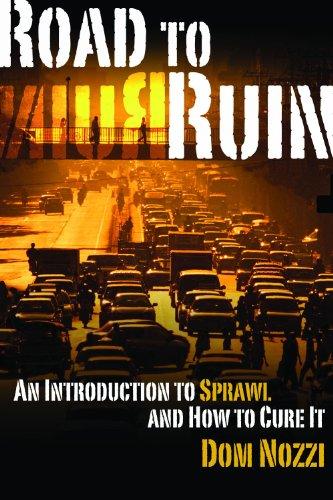
Road to ruin: an introduction to sprawl and how to cure it
by
Dom Nozzi
Published 15 Dec 2003
For decades, traffic engineers who design roadways actually referred to walkers in the Highway Capacity Manual as ‘traffic interruptions.’ ”7 Whatever a community makes its main form of transportation profoundly shapes the way it will use its land, not the other way around. Weak land use plans and feeble regulations did not create urban sprawl, for example; pouring money into roads and cars did. And whatever transportation our community chooses—for most of us, cars—also shapes our quality of life. As we have learned over the years, single-mindedly choosing car transportation has dispersed and isolated us and degraded our communities’ quality of life, environment, and financial health.
…
All such remedies force us to drive more often; encourage more people and businesses to move from in-town locations; make walking, bicycling, and riding the bus more diffi-cult; degrade our quality of life with noise, hazards, and air pollution; cost us a lot of money; and move our once unique communities closer to becoming Anywhere, USA. As it has become more clear that auto-oriented urban sprawl puts our quality of life in a downward spiral, people-friendly solutions have started to present themselves again. We could develop vacant, underused in-town property instead of more remote “greenfield” suburbs. We could design more modest, low-speed streets and build fewer enormous parking lots.
…
With a car at our command, we don’t have to trudge to the subway, huddle in the rain or snow waiting for a bus, or simmer in the summer sun sweating our way six miles to work on a bicycle. So we’re in agreement. We’re keeping our Expeditions, F-150s, Blazers, and Explorers. It is irrational for us not to. WHAT DO THOSE SUVs COST US? Of course, we pay a price for all that convenience. Air, water, and noise pollution. Injury and death. Environmental degradation. Loss of land. Urban sprawl. Our time. Lots and lots of money. Social and emotional isolation. Clean Air Air pollution is an easy place to start, because nearly everyone agrees that cars cause it—or a large portion of it. Beyond that agreement, the arguments get murky. Just to make clear the correlation between driving cars and air pollution . . .
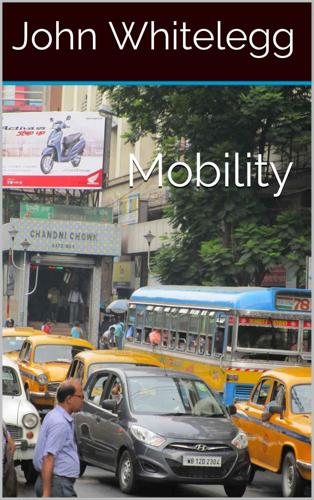
Mobility: A New Urban Design and Transport Planning Philosophy for a Sustainable Future
by
John Whitelegg
Published 1 Sep 2015
The Atlanta system burdens city and regional administrations with unaffordable costs and a widening gap between revenue and expenditure. It also causes enormous problems for ordinary families. The impact on ordinary families of similar situations in Australian cities has been very well documented by Dodson and Sipe (2008). The consequences of misguided policies in Australian cities to encourage urban sprawl, longer distances for most journey purposes and high levels of dependency on private cars has been to give ordinary families huge problems of managing budgets, coping with rising petrol prices and in extremis being unable to get to work and joining the ranks of the urban poor. Urban poverty in this case is directly linked to all those policies that have combined to produce sprawl, car dependency, and lack of destinations that are easily accessible and grossly inadequate public transport.
…
E-mobility is currently promoted as part of the maximum mobility objective and to provide a green smokescreen to reinforce the mobility paradigm by suggesting that mobility can be zero carbon/lower carbon and non-polluting. If e-mobility can be delivered to the extent that it can replace the vast majority of petrol/diesel car trips in Europe (and this has not yet been demonstrated) the result will be hugely expensive and many more roads with all their damaging effects will be funded and built. Urban sprawl will continue to consume valuable land that could be used for food production and land also provides valuable landscape, ecological and biodiversity services that are destroyed when new roads occupy that space. Distances travelled will increase and as distances increase so walking and cycling decline.
…
E-mobility offers some relief from damaging exhaust emissions and their health impacts but sits very uneasily in the wider context of polices and measures that could increase accessibility reduce congestion and reduce deaths and injuries in the road traffic environment. It cannot deliver on these wider societal objectives and should be more correctly seen as a device to maintain the growth of mobility and in particular the growth of private motorised transport and urban sprawl. It is not located within a coherent sustainable transport policy context characterised by the demotion of mobility as a societal objective. This demotion is now recognised as an overdue policy change by a United Nations report (United Nations, 2013) and this same report recommends its replacement by comprehensive accessibility objectives: “Achieving transport affordability objectives require actions that support non-motorised transport; reduce the financial costs of transport services; and increase transportation affordability through improved land-use accessibility.”
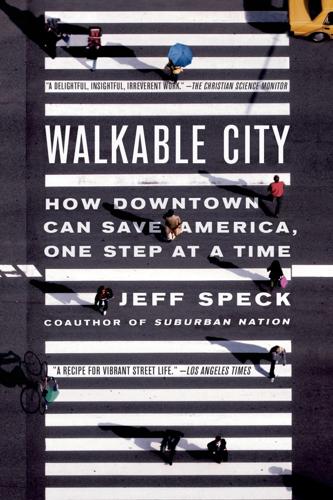
Walkable City: How Downtown Can Save America, One Step at a Time
by
Jeff Speck
Published 13 Nov 2012
This is why Chris Leinberger believes that “all the fancy economic development strategies, such as developing a biomedical cluster, an aerospace cluster, or whatever the current economic development ‘flavor of the month’ might be, do not hold a candle to the power of a great walkable urban place.”37 WHY JOHNNY CAN’T WALK The obesity bomb; Clearing the air; American car-nage; Tense and lonely The best day for being a city planner in America was July 9, 2004. That’s when Howard Frumkin, Lawrence Frank, and Richard Jackson published their book Urban Sprawl and Public Health. Until that day, the main arguments for building walkable cities were principally aesthetic and social. More significantly, almost nobody but the planners was making them. But it turns out that while we were shouting into the wilderness about the frustrations, anomie, and sheer waste of suburban sprawl, a small platoon of physicians was quietly doing something much more useful: they were documenting how our built environment was killing us.
…
.● And sometimes when children do walk to school, their parents are visited by the police: a Salt Lake City newspaper carried in December 2010 the story of Noah Talbot, of South Jordan, who was picked up by the police on the way to school and his mother issued a citation for child neglect.5 Jackson and his coauthors note how “children are increasingly medicated for inattentiveness or hyperactivity, even as many are losing their opportunities for exercise at school or in the neighborhood. There are third-grade classes in which as many as a third of the boys are on Ritalin or similar medications.”6 To summarize the findings of Urban Sprawl and Public Health—which are echoed by a growing number of epidemiologists nationwide—the inactivity-inducing convenience, often violent speed, and toxic exhaust of our cars have contributed mightily to the circumstance that “for the first time in history, the current generation of youth will live shorter lives than their parents.”7 THE OBESITY BOMB In any meaningful discussion about American health (and health care), obesity has to be front and center.■ In the mid-1970s, only about one in ten Americans was obese, which put us where much of Europe is right now.
…
The study concluded that an hour spent driving triples your risk of heart attack in the hours that follow.32 A Belgian paper published in The Lancet found that traffic exposure accounts for more heart attacks worldwide than any other activity, even including physical exertion.33 Closer to home, a Miami study found that “after driving their cars across the city for forty-five minutes, university students had higher blood pressure, higher heart rates, and lower frustration tolerance.” This study is mentioned in Urban Sprawl and Public Health, where Dr. Jackson and his colleagues go on at length about driving stress, road rage, and their significant impacts on our national well-being. And the numbers are not insignificant—but let’s step back from health for a minute and talk about happiness. Is motoring around and around really how we want to be spending so much of our time?
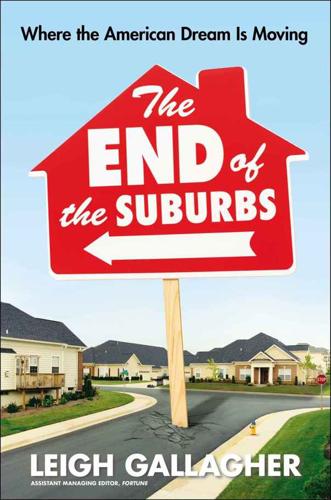
The End of the Suburbs: Where the American Dream Is Moving
by
Leigh Gallagher
Published 26 Jun 2013
That same year, a report written by Russ Lopez of the Boston University School of Publish Heath for Fannie Mae entitled Thirty Years of Urban Sprawl in Metropolitan America warned of the dangers of our settlement patterns. “Urban sprawl is emerging as a major environmental, health and social issue,” Lopez wrote. California’s Inland Empire, the twenty-seven-thousand-square-mile zone between Los Angeles and the Riverside/San Bernardino hubs, emerged as a poster child of urban sprawl, a massive region where two-thirds of residents lived more than ten miles from a central business district, and the packed highways and clogged arterial roads had led to almost unbearable rates of congestion and pollution.
…
By 2000, metropolitan areas covered: U.S. Census Bureau. That same year: Russ Lopez, Thirty Years of Urban Sprawl in Metropolitan America: 1970–2000: A Report to the Fannie Mae Foundation. a massive region where two-thirds of residents: Scott Gold and Massie Ritsch, “Swallowed by Urban Sprawl,” Los Angeles Times, October 18, 2002. In 2002 a report: Reid Ewing, Rolf Pendall, and Don Chen, Measuring Sprawl and Its Impact, Smart Growth America, 2002. “There is no ‘there’ there”: Gold and Ritsch, “Swallowed by Urban Sprawl.” The historian Lewis Mumford: Jackson, Crabgrass Frontier, pp. 237, 244; Lewis Mumford, The Culture of Cities (Mariner Books, 1970).
…
California’s Inland Empire, the twenty-seven-thousand-square-mile zone between Los Angeles and the Riverside/San Bernardino hubs, emerged as a poster child of urban sprawl, a massive region where two-thirds of residents lived more than ten miles from a central business district, and the packed highways and clogged arterial roads had led to almost unbearable rates of congestion and pollution. In 2002 a report by the nonprofit agency Smart Growth America rated it the nation’s worst example of urban sprawl. “There is no ‘there’ there,” said one of the authors of the report. • • • Experts, academics, and other influential thinkers have been expressing concern about our modern pattern of suburban development since the first Levittown. Intellectuals worried early on about the postwar suburbs’ uniformity and lack of character. The historian Lewis Mumford denounced Levittown almost as soon as it went up, saying it was using “new-fashioned methods to create old-fashioned mistakes.”
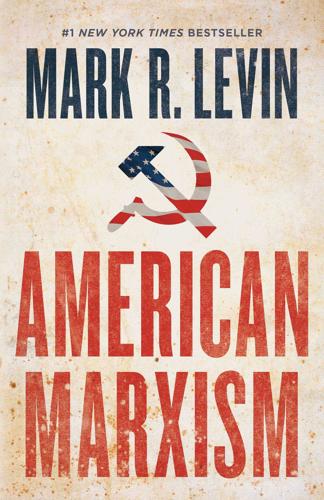
American Marxism
by
Mark R. Levin
Published 12 Jul 2021
Nonetheless, try as Latouche might, the inspiration behind this eco-totalitarian movement is, for innumerable activists, undeniably Marxism. In his essay “Urban Sprawl, Climate Change, Oil Depletion, and Eco-Marxism,” University of Miami political science professor George A. Gonzalez writes: “The U.S. urban zones are the most sprawled in the world…. Urban sprawl can only be fully comprehended within the political economy framework developed by Karl Marx. Marx’s concepts of value and rent are indispensable to understanding the profligate use of fossil fuels—vis-à-vis urban sprawl—that has significantly contributed to oil depletion and to the recent global warming trend.
…
For Latouche, they are utterly void of ecological considerations and adopt capitalist goals related to production and growth. Yet, for both the enemy is economic progress. “Urban sprawl,” writes Gonzalez, “was deployed in the United States during the 1930s as a means of reviving U.S. capitalism from the Great Depression. The sprawling of urban zones greatly increased the need for automobiles and other consumer durables. This use of urban sprawl to increase economic demand is consistent with Marx’s argument that demand within capitalism is malleable and is geared toward increasing the consumption of goods and services produced through social labor.
…
The quartet continues: “Degrowth has evolved into an interpretative frame for a social movement, understood as the mechanism through which actors engage in a collective action. For instance, anti-car and anti-advertising activists, cyclists and pedestrian rights campaigners, partisans of organic agriculture, critics of urban sprawl, and promoters of solar energy and local currencies have started seeing degrowth as an appropriate common representative frame for their world view.”9 The social movement envisioned by these utopians would drag America into a regressive, impoverished society with widespread economic and social dislocation—that is, a pre-industrialized environment where progress comes to an end, for that is the goal.

The Human City: Urbanism for the Rest of Us
by
Joel Kotkin
Published 11 Apr 2016
“Census reveals African-American children are leaving large U.S. cities as their young parents head for better life in suburbs,” Daily Mail, http://www.dailymail.co.uk/news/article-2009903/African-American-children-leaving-biggest-U-S-cities-young-parents-head-suburbs.html. DUNN, Ross E. (1987). The Adventures of Ibn Battuta: A Muslim Traveler of the 14th Century, Berkeley: University of California Press. DURKIN, Martin. (2012, January 13). “Three Cheers for Urban Sprawl,” New Geography, http://www.newgeography.com/content/002622-three-cheers-urban-sprawl. DYOS, H.J. et al. (1968). “Agenda for Urban Historians,” The Study of Urban History, New York: St. Martin’s Press. EARNSHAW, Martin. (2008). “Communities on the Couch,” The Future of Community, London: Pluto Press. EASTERBROOK, Gregg. (1999, March 15).
…
“Jews and the Jewish Birthrate,” aish.com, http://www.aish.com/jw/s/48899452.html. WHYTE, William H. (1965). “The Anti-City,” Metropolis: Values in Conflict, Belmont: Wadsworth. WILFORD, John Noble. (2000, December 19). “In Maya Ruins, Scholars See Evidence of Urban Sprawl,” New York Times, http://www.nytimes.com/2000/12/19/science/in-maya-ruins-scholars-see-evidence-of-urban-sprawl.html. WILKINSON, Francis. (2014, April 9). “Why are Liberal Cities Bad for Blacks?” Bloomberg View, http://www.bloombergview.com/articles/2014-04-09/why-are-liberal-cities-bad-for-blacks. WILKINSON, Thomas O. (1965). The Urbanization of Japanese Labor: 1868–1955, Amherst: The University of Massachussetts Press.
…
If people move to the periphery, it is not because they are deluded or persuaded by advertising but because they perceive that is where their quality of life is higher.178 As we’ve seen, suburban and urban expansion are nothing new. New archeological evidence points to the earliest cities being formed by combining several discrete small communities; even the ancient Maya had what researchers described as “urban sprawl,” complete with large houses and even an archaic version of strip malls. For his part, Aristotle spoke about cities as the union of “several villages.” Suburbs and small communities are not new phenomena but instead are woven into the history of urban life.179 Rather than demonizing and belittling the suburbanite, urbanists would be far better off taking a more human-city approach and focusing on how to improve life not only in the city cores but also in extensive areas that have developed around them.
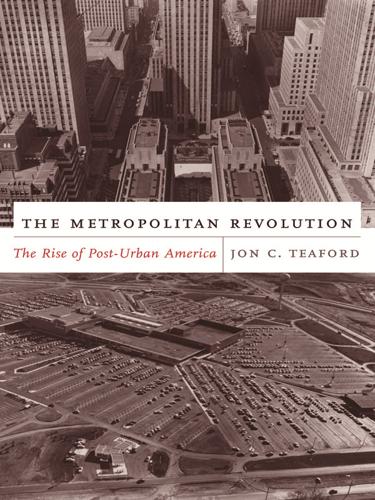
The Metropolitan Revolution: The Rise of Post-Urban America
by
Jon C. Teaford
Published 1 Jan 2006
Smith, and Jerry Adler, “Sprawling, Sprawling … ,” Newsweek, 19 July 1999, pp. 23, 25. 23. Donald C. Williams, Urban Sprawl: A Reference Handbook (Santa Barbara, Calif.: ABC-CLIO, 2000), p. 1. 24. James Howard Kunstler, The City in Mind: Notes on the Urban Condition (New York: Free Press, 2001), p. 43. 25. Phillip J. Langman, “American Gridlock,” U.S. News & World Report, 28 May 2001, p. 19. 26. Kunstler, City in Mind, p. 41. 27. Michelle Cottle, “House Arrest,” New Republic, 6 August 2001, p. 18. 28. John G. Mitchell, “Urban Sprawl,” National Geographic, July 2001, p. 71. 29. Lacayo, “Brawl over Sprawl,” p. 45; Randal O’Toole, The Vanishing Automobile and Other Urban Myths (Brandon, Ore.: Thoreau Institute, 2001), p. 32; Bruce Katz, “The Permanent Campaign,” Urban Land, May 2003, p. 49. 30.
…
As early as 1952, the upscale Saint Louis suburb of Clayton attracted the corporate headquarters of the Brown Shoe Company, and in 1962 a thirteen-story office building opened, followed a year later by a sixteen-story office tower. In 1966 the St. Louis Post-Dispatch observed that the suburb’s burgeoning skyline “no longer blended into the county’s amorphous urban sprawl, but now appeared more like a little Tulsa or perhaps an Omaha, than just another incorporated outskirt of St. Louis.”34 FIGURE 3.3 Office buildings at Northland Shopping Center, Southfield, Michigan, 1965. (Walter P. Reuther Library, Wayne State University) On the West Coast, Stanford University was nurturing the suburbanization of business.
…
Through the creation of entire new communities, Americans could supposedly correct the urban flaws resulting from the unplanned development of the past. Rather than segregating rich and poor, white and black, the new cities could embrace social and racial heterogeneity and provide housing and jobs for a diverse and hopefully harmonious population. Moreover, through enlightened planning, the new communities could halt mindless urban sprawl and offer something better than the prevailing pattern of unrelated housing subdivisions and garish commercial strips along traffic-jammed highways. They could also provide adequate open space and recreational facilities and preserve rather than bulldoze the natural beauty of the countryside. And they could foster imaginative modern architecture rather than create additional rows of the banal boxes with neo-colonial trim so typical of suburbia.
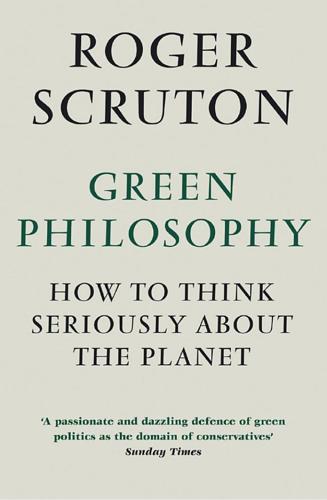
Green Philosophy: How to Think Seriously About the Planet
by
Roger Scruton
Published 30 Apr 2014
I am thinking of the following: the initiative of American nature lovers, acting upon the United States Congress, to create national parks, the action by Iceland to protect the breeding ground of the Atlantic cod, the legislation that freed Ireland from polythene bags, the clean energy initiatives in Sweden and Norway, the Swiss planning laws that have enabled local communities to retain control over their environments and to manage those environments as a shared possession, the British ‘Green Belt’ policies that brought an end to urban sprawl, the initiatives of lobster-catchers in Maine and cod-fishers in Norway to establish self-regulating fisheries with local people in charge. These are small-scale achievements, but they are real, and could, if replicated more widely, change the face of the earth for the better.26 Moreover, they are successful because they appeal to a natural motive – the shared love of a shared place.
…
The Campaign for the Preservation (subsequently Protection) of Rural England (CPRE) was launched in 1925, and now has branches all over the country, doing what they can in the cause of the ‘beauty, tranquillity and diversity of the countryside’. The efforts of the CPRE were boosted by the historian G. M. Trevelyan, whose book Must England’s Beauty Perish?, published in 1926, awoke the reading public to the threats posed by urban sprawl and the growing network of roads. Trevelyan’s warning was amplified in 1928, when the architect Clough Williams-Ellis, founder of the model town of Port Merion in Wales, published England and the Octopus, describing the danger for both town and country of ribbon development – sprawl along the roads between conurbations.
…
City councils and central government connived with the developers to desecrate our ancient cities, and to place the working class on Bauhaus perches above the ruins. Coventry, one of the greatest medieval cities in Europe, lost 30 per cent of its timber-frame houses as a result of bombing; the city council got rid of the rest; and the example is by no means untypical.330 Unfortunately, although the Town and Country Planning Act of 1946 put a stop to urban sprawl, it could not save the cities themselves, many of which were in the hands of corrupt councillors and vengeful oikophobes. The destruction of agriculture had begun in the wake of the First World War, with the introduction of large-scale mechanized farming and the purchase of the bankrupt holdings by absentee investors.

The New Urban Crisis: How Our Cities Are Increasing Inequality, Deepening Segregation, and Failing the Middle Class?and What We Can Do About It
by
Richard Florida
Published 9 May 2016
These data on population growth, urban expansion and density, and those in the paragraph below on streets are from Shlomo Angel, Atlas of Urban Expansion, Lincoln Institute of Land Policy, 2016. 24. UN-Habitat, Streets as Tools for Urban Transformation in Slums. 25. Mark Swilling, “The Curse of Urban Sprawl: How Cities Grow and Why This Has to Change,” The Guardian, July 12, 2016, www.theguardian.com/cities/2016/jul/12/urban-sprawl-how-cities-grow-change-sustainability-urban-age. 26. Letty Reimerink, “Medellín Made Urban Escalators Famous, but Have They Had Any Impact?,” Citiscope, July 24, 2014, http://citiscope.org/story/2014/medellin-made-urban-escalators-famous-have-they-had-any-impact; “City of the Year,” Wall Street Journal Magazine, 2012, http://online.wsj.com/ad/cityoftheyear. 27.
…
Data on Ferguson are from Elizabeth Kneebone, “Ferguson, MO, Emblematic of Growing Suburban Poverty,” Brookings Institution, August 15, 2014, www.brookings.edu/blogs/the-avenue/posts/2014/08/15-ferguson-suburban-poverty; James Russell, “Ferguson and Failing Suburbs,” Jamessrussell.net, August 17, 2015, http://jamessrussell.net/ferguson-and-failing-suburbs; Stephen Bronars, “Half of Ferguson’s Young African-American Men Are Missing,” Forbes, March 18, 2015, www.forbes.com/sites/modeledbehavior/2015/03/18/half-of-fergusons-young-african-american-men-are-missing. 13. On the connection between commuting time and economic mobility, see Reid Ewing, Shima Hamidi, James B. Grace, and Yehua Dennis Wei, “Does Urban Sprawl Hold Down Upward Mobility?” Landscape and Urban Planning 148 (April 2016): 80–88. 14. On the delivery of local services to the suburbs, see Arthur Nelson as cited in Leigh Gallagher, The End of the Suburbs: Where the American Dream Is Moving (New York: Portfolio Penguin, 2013). For the UCLA study, by the California Center for Sustainable Communities, see Laura Bliss, “L.A.’s New ‘Energy Atlas’ Maps: Who Sucks the Most Off the Grid,” CityLab, October 6, 2015, www.citylab.com/housing/2015/10/las-new-energy-atlas-maps-who-sucks-the-most-off-the-grid/409135.
…
Of course, nearly 20 percent of Bell’s population lives below the poverty line, which means that its residents use less air conditioning, fewer computers, and so on. On the overall cost of sprawl to the US economy, see Todd Litman, “Analysis of Public Policies That Unintentionally Encourage and Subsidize Urban Sprawl,” London School of Economics and Political Science, for the Global Commission on the Economy and Climate for the New Climate Economy, 2015, http://static.newclimateeconomy.report/wp-content/uploads/2015/03/public-policies-encourage-sprawl-nce-report.pdf. 15. Christopher Ingraham, “The Astonishing Human Potential Wasted on Commutes,” Washington Post, February 25, 2016, www.washingtonpost.com/news/wonk/wp/2016/02/25/how-much-of-your-life-youre-wasting-on-your-commute. 16.

The Biggest Prison on Earth: A History of the Occupied Territories
by
Ilan Pappé
Published 21 Jun 2017
However, sheep did graze this hillside when the rural Palestinian village of Sheikh al-Badr was situated there. A few of its houses still remain, next to the American hotels frequented by Israeli members of the Knesset who do not live in Jerusalem. The village was gradually swallowed by the city, becoming part of the urban sprawl until it was ethnically cleansed by Israeli forces in 1948. It was a famous part of the city, as it overlooked one of Jerusalem’s best-known landmarks: the Valley of the Cross. Tradition has it that the tree that provided the wood for Christ’s cross stood there and this is why it is said that on that spot Greek Orthodox monks built an impressive monastery, still there today, albeit surrounded by new Jewish neighbourhoods and ring roads.
…
On this land, the government developed the shechunot (‘neighbourhoods’), a euphemism used to describe the new Jewish colonies built in East Jerusalem so as to single them out as part of the new post-1967 Israel. It was through land robbery by the state, endorsed by all the Zionist parties, that these urban sprawls were created. A very thorough and exhaustive study by the Palestinian researcher Khalil Tafakji enables us to follow this process very carefully, facilitated by the helpful way he lists the names and locations of the new settlements. This act of recording is extremely important, as only a handful of Israeli Jews within the consensus, including the Zionist peace camp, would recognize these neighbourhoods as settlements.
…
So while the ink was still drying on the Oslo Accord, Greater Jerusalem was reinvented as an area consisting of 600 square kilometres, which included 15 per cent of the West Bank (just one block of it, Maleh Edumain, is nearly 1 per cent of the West Bank).7 Satellite settlements in areas adjacent to this new Greater Jerusalem were built with the future intention of serving as land bridges between Greater Jerusalem and the rest of the Israeli colonies in the West Bank. This expansion soon covered the ancient hills of North and East Jerusalem with a new urban sprawl of modern housing dressed up here and there with orientalist façades that resembled the very houses demolished to build these new ‘neighbourhoods’. As Eyal Weizman elucidated so clearly in his book Hollow Land, the 1968 master plan for Jerusalem was committed to both a colonial and oriental heritage dating back to the British urban planning of 1917 – with two huge differences.
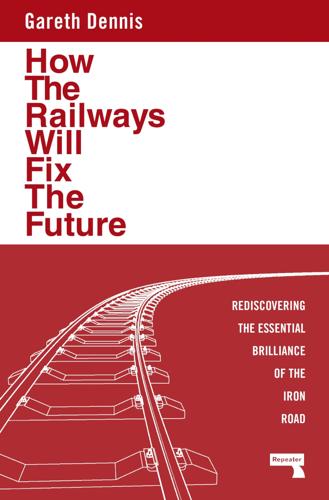
How the Railways Will Fix the Future: Rediscovering the Essential Brilliance of the Iron Road
by
Gareth Dennis
Published 12 Nov 2024
Responding to the need for greater robustness and resilience in the face of this onslaught requires a greater number of engineers and skilled people, and making the best use of them means relying on systems that move more people with less infrastructure. That means mass transit, not roads. Climate change and current patterns of human development are exacerbating and accelerating biosphere fragmentation and collapse. Rail has a vital role to play in minimising urban sprawl, reducing land take and stitching once-fragmented habitats back together. Consumerism, the rampant capitalism it fuels and the consequent unchecked race for resources result in the mass exploitation of labour in the global south, including children, who are already the most vulnerable to the effects of climate change.
…
Doing so would naturally necessitate consideration of all transport modes, not just rail, which in turn would require the input of all levels of government: not just Westminster, but the devolved nations, city regions and councils. Mode share describes the means of flow of people and goods. These flows are complex, with tidal flows like those in travel to work areas, and linear flows along major corridors. Transport flow is fractal, with urban sprawl (residential or otherwise) acting like small branches, feeding larger branches, feeding into trunks, which then split out into branches again in urban areas. Different means of travel overlay onto each other, perhaps with slightly different trunks (such as a motorway, railway, metro line, heavily used bus route, etc.), but all will map together to show broad flows of people between and within urban areas.
…
Do we prioritise speed, frequency, or a balance of the two? On some transport corridors, only one type of rail service is necessary. In undeveloped areas between cities, long-distance high-speed services minimise both journey times and the number of trains needed to shift large numbers of people. Once you reach the urban sprawl, however, the demands on the railway can become more complex. Long-distance trains generally and correctly just serve the major urban centre, while suburban services provide links across the wider built-up area. The highest-capacity railway is a railway where all of the trains do the same thing, one after the other, meaning they can move like a conveyor belt in unison, delivering the maximum passenger (or freight) throughput on the infrastructure.
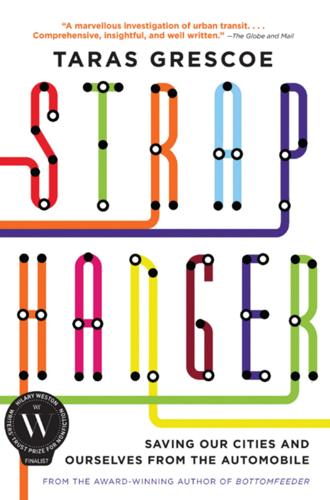
Straphanger
by
Taras Grescoe
Published 8 Sep 2011
The baby boom generation is past its child-bearing years, and the proportion of the population in their thirties, the cohort traditionally most likely to buy a house, is at an historic low. There is a corollary to suburban living: utter car dependency. Although the suburbs we’ve built for ourselves depend on cars to function, there is another, more subtle symbiosis at work between urban sprawl and the automobile. My time on the road in Los Angeles and Phoenix was probably the longest uninterrupted stretch I’ve spent in a car in the last decade, and it made me grateful I don’t own one. By pitting you against everybody else on the road, driving turns travel itself into competition. After two weeks, I was looking for any excuse to ditch my ride, go for a walk in a park, eavesdrop on a conversation, or just feel the sidewalk under my feet.
…
When the French state began building the RER in the early 1960s, it had specific development goals in mind: the Schéma directeur, a kind of regional master plan inspired by Stockholm’s suburban mass transit system, called for new RER stations to concentrate the population in such satellite towns as Cergy-Pontoise, Évry, and Marne-ta-Vallée. Paris’s suburbs would continue to grow, but it would be railways, not highways, that would carry the bulk of the traffic, serving suburban university campuses, airports, and the new high-rise employment centers at La Défense. The goal of the RER was to limit urban sprawl, and it worked. While suburbanization continued—in the six years after line A opened in 1969, central Paris would lose 400,000 inhabitants—the city did not bleed into its hinterland anything like a London or a Moscow. The RER prevented low-density development by encouraging suburbanites, very few of whom use cars to commute, to live within walking distance of stations.
…
Public transport didn’t structure central Paris the way it did New York or Los Angeles, which grew and evolved simultaneously with their subway and streetcar lines: with infinite care, the métro was shoehorned into an ancient walking city. It was the extensive RER system, which allows suburbanites to live within walking distance of train stations, that played the greatest role in transforming modern Paris, permitting the creation of dense suburbs while limiting urban sprawl. The métro, in contrast, preserved the integrity of the historic city. Why build expressways, after all, when an efficient, reliable, and comfortable alternative could always be found underfoot? And that is how the métro saved Paris. Le Supermétro My instructions were clear: be on the platform at République station, no later than 11:40 a.m.
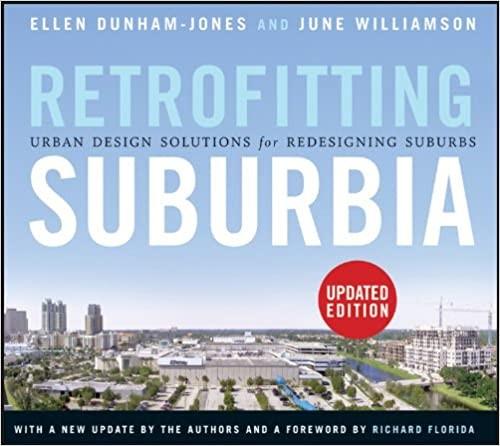
Retrofitting Suburbia, Updated Edition: Urban Design Solutions for Redesigning Suburbs
by
Ellen Dunham-Jones
and
June Williamson
Published 23 Mar 2011
For a comparison of average energy use and carbon dioxide emissions per person in cities versus suburbs, see Alex Williams, “Don’t Let the Green Grass Fool You,” New York Times, February 10, 2008. 15 See Howard Frumkin, Lawrence Frank, and Richard Jackson, Urban Sprawl and Public Health: Designing, Planning, and Building for Healthy Communities (Washington, DC: Island Press, 2004). 16 See Reid Ewing et al., “Relationship Between Urban Sprawl and Physical Activity, Obesity, and Morbidity,” American Journal of Health Promotion 18:1 (2003); and Lawrence Frank, Martin Andresen, and Tom Schmidt, “Obesity Relationships with Community Design, Physical Activity, and Time Spent in Cars,” American Journal of Preventive Medicine 27:2 (2004). 17 A useful summary of the wide range of research in this area is presented in “Understanding the Relationship between Public Health and the Built Environment,” prepared by Design, Community & Environment; Dr.
…
Lawrence Frank, a chaired professor at the University of British Columbia, to document the wide range of health effects related to living in sprawl, including the impact of car emissions, accident rates, social isolation, and, in particular, reduced levels of physical activity. Recognizing the growing correlation between urban sprawl and human sprawl, they note that the percentage of obese Americans more than doubled, from 15% to 31%, between 1980 and 2000. What also more than doubled over the same time period is the number of hours the average American spent driving.15 While there are plenty of other factors at work, subsequent research has shown that people who live in walkable neighborhoods have lower body mass indices on average than those in nonwalkable neighborhoods.16 The collective implication of these studies is that suburbs are not quite the healthy places in which to raise a family as has commonly been perceived, nor are cities as unhealthy.17 The implications for policy makers to change development regulations are profound—as are the obstacles.
…
Casto Corporation dorm buildings Dover, Kohl & Partners Dover, Victor Downtown Kendall/Dadeland (Miami-Dade County, Florida) demographic analysis morphological analysis overview regulating urbanizing framework Downtown Park Forest DPZ. see Duany Plater-Zyberk & Company drivable sub-urban development Duany, Andres Duany Plater-Zyberk & Company (DPZ) Echelon Mall eclecticism Economic Research Associates edge cities. see also Downtown Kendall/ Dadeland evolution of future of Greenway Plaza infilling Addison Circle Century City Coliseum Central Area effectiveness of Hacienda Business Park Legacy Town Center Nassau Hub Perimeter Place Tukwila Urban Center Tysons Corner redirecting retrofits across multiple parcels Edge City: Life on the New Frontier book edgeless cities Edible Estates book EDS. see Electronic Data Systems elastic tissues Belmar defined Downtown Kendall/Dadeland Mashpee Commons University Town Center Electronic Data Systems (EDS) Elkus Manfredi Architects Ellis, John Emhart Manufacturing Research Building (Bloomfield, Connecticut) Enaje, Stephanie energy efficiency Englewood (Colorado) Cinderella City Mall CityCenter Englewood environment, effect of urban sprawl on Envision Utah exclusionary zoning face-to-face contact Fairfax (Virginia) farming Fast Food Nation: The Dark Side of the All-American Meal book FasTrax system favored quarter Federal Realty Investment Trust festival centers figure-field diagrams Belmar Downtown Kendall/Dadeland Mashpee Commons University Town Center financing first suburbs Fishman, Robert flats Florida. see also Downtown Kendall/ Dadeland Apollo Beach Charlotte Harbor Koger Center Miami-Dade County Mizner Park Picayune Strand Temple Terrace Winter Park Village Florida, Richard Foley’s department stores foreclosure foreign-born population form-based codes fractured governance franchises Frank, Lawrence, Dr.
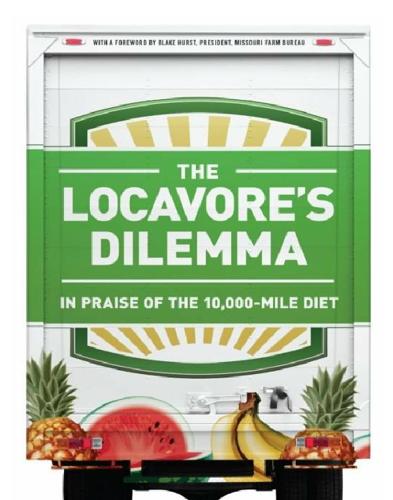
The Locavore's Dilemma
by
Pierre Desrochers
and
Hiroko Shimizu
Published 29 May 2012
Increased farming biodiversity is not only desirable from an ecological perspective, but also more aesthetically pleasing than factory farming. In addition, large-scale producers are much less likely to be held accountable by distant consumers for the damage they cause to ecosystems. Promoting local food production also encourages land conservation for agricultural purposes and is an indirect way to fight urban sprawl. Unlike imported food, locally grown produce is often sold without packaging that then gets thrown away. • Security: Populations fed by local producers can always count on them in times of crisis such as during wars or with sudden price hikes on imported food items. By their very nature, international food markets only cater to the highest bidders and are not concerned with the fate of marginal populations.
…
Of course, additional trade-offs are also present in the case of more modest urban agriculture proposals, from rooftop gardening to the raising of backyard chickens, whose small size and consequent inability to generate economies of scale (try using a tractor on top of a high-rise building or obtaining large-scale discounts on the costs of inputs when farming small backyards) will always confine the practice to the realm of hobby gardeners, or, at best, high-margin luxury producers—either way, a result that is a far cry from the affordable and abundant food promised by locavores. “Protecting” the farmland that surrounds large cities from “urban sprawl” (in other words, preventing residential, industrial, and commercial development on agricultural land) through strict zoning is equally problematic. While restricting development might suit the sensibilities of people who already own residential property in thriving cities, it also unavoidably drives up housing prices, thus affecting disproportionately people of more modest means and newcomers (to say nothing of farmers’ children who would like to get out of this line of work and cash in on the family property).
…
(Of course, many individuals argue that markets are too short-sighted and that future agricultural land shortages are looming. Yet, because in advanced economies we now produce much more food on the same piece of land than in the not so distant past, much more agricultural land is currently reverting to a “wild” state than swallowed by “urban sprawl.”47) Also, nothing prevents environmentalists from purchasing land they deem worth preserving rather than using political power to declare private farmland part of a “greenbelt” and prevent its owner from selling it to developers or converting it to other uses. Prohibiting the redevelopment of agricultural land might appeal to the sensibilities of well-off or already established urbanites and environmentalists, but it is a selfish policy that ignores the economic benefits of urbanization and the needs of people of lesser means.48 Time and Trade-offs Finally, another point lost on many locavores is that the one thing that money cannot buy is more time, thus making it the scarcest commodity of all.
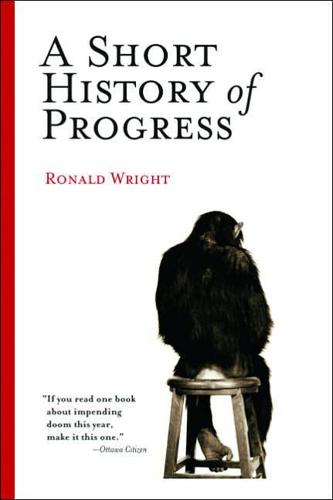
A Short History of Progress
by
Ronald Wright
Published 2 Jan 2004
First, terrorism is a small threat compared with hunger, disease, or climate change.57 Three thousand died in the United States that day; 25,000 die every day in the world from contaminated water alone. Each year, 20 million children are mentally impaired by malnourishment.58 Each year, an area of farmland greater than Scotland is lost to erosion and urban sprawl, much of it in Asia. Second, terrorism cannot be stopped by addressing symptoms and not the cause. Violence is bred by injustice, poverty, inequality, and other violence. This lesson was learnt very painfully in the first half of the twentieth century, at a cost of some 80 million lives.59 Of course, a full belly and a fair hearing won’t stop a fanatic; but they can greatly reduce the number who become fanatics.
…
See Alan Kolata, Tiwanaku and Its Hinterland: Archaeology and Paleoecology of an Andean Civilization (Washington, DC: Smithsonian Books, 1996); and Charles Stanish, Ancient Titicaca: The Evolution of Complex Society in Southern Peru and Northern Bolivia (Berkeley, CA: University of California Press, 2003). 37. Twenty-one square kilometres. 38. The white man was not the first to be guilty of urban sprawl in great rectangles across American landscapes. 39. Webster, for example, (Ancient Maya, p. 297) notes maize pollen at Copan by 2000 B.C. Other Maya cities also began as farming villages at about this time. 40. The early text is on a stela at El Portón, in highland Guatemala. See Sharer, Ancient Maya, p. 79. 41.
…
H., 15, 135n20 rulers, see kings Rwanda, 185n64 salt and soil, 77, 78, 79, 157n62 science and religion, collision, 10 science fiction, 122 scientific method, 10 Scientific Romance, A (Wright), 83, 122–23 scientific romances, 119, 122 Second World War, 121 Secret Agent, The (Conrad), 120, 147n47 sheep, 43, 159n9 slavery, 71, 114 smallpox, 50, 112, 116–17 social Darwinism, 130, 186n70 social safety net, 127, 183n60 social structure, see classes; “pyramids,” social Solon, 87 Soros, George, 129 Soviet Union, 6 Spanish conquests, 86, 112, 174n15 spearthrower, 141n13 speech, 13, 135n19 Steinbeck, John, 124 stock market, 129 Sumerians, 33, 65–79, 82, 83 blind to impact on nature, 87 city-states, 68, 70 classes, 71 collapse, 83, 158n3 emergence of civilization, 33, 149n1 environment, 67–68, 74–75 floods, 74–77, 156n55, 156n56 human sacrifice, 71–73 irrigation and effects, 68, 77–79 kingship, 70–73 population, 68, 154n38, 157n2 priesthood, 69, 70 slaves, 71 temple prostitution, 70, 154n35 trade, 69 writing, 69–70 ziggurats, 69, 153n32 Tainter, Joseph, 92, 107, 125, 128, 181n52 Tattersall, Ian, 38 technological determinism, 47 technology concerns, 122, 182n54 early machinery, 177n28 as measure of progress, 4–7, 46–47 temple prostitution, 70, 154n35 Teotihuacan, 95, 163n38 terrorism, 49, 126, 147n47 Tikal, 95–96, 97, 98, 99, 100, 105, 165n49, 167n55 Time Machine, The (Wells), 120, 121 Tiwanaku, 94, 163n36, 166n52 towns and villages, Neolithic, 48–49 trade China with Rome, 104, 170n75 Sumerians, 69 trees, 59–60, 86, 185n67 United Nations, 128 United States deficits, 186n69 hostility to conservation, 124, 129–30, 181n49 imperial expansion, 86, 159n7 Ur, 78, 79, 154n38 urban sprawl, 126 Uruk, 67, 70, 79 Ussher, Archbishop, 11 Utnapishtim, 75–77, 156n56 Utopia (More), 115–16 Victorian ideal of progress, 3 violence, 33–34, 71–73, 126, 139n5, 140n6 Waiting for the Barbarians (Coetzee), 71, 122 War of the Worlds, The (Wells), 117, 178n35 warfare, 33–34, 48–49, 121 early humans, 24–26 twentieth century, 121, 180n43 waste, 125 weapons, 5–6, 29, 31, 121, 179n41 of early humans, 36, 141n13 Webster, David, 100, 101, 145n39 Wells, H.
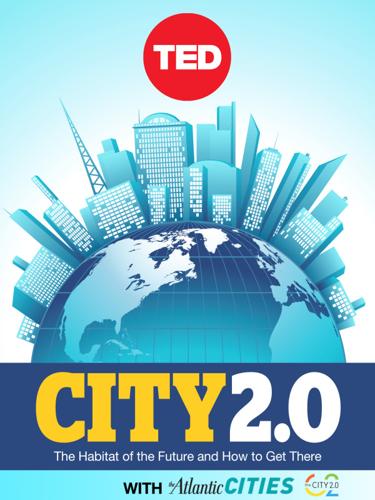
City 2.0: The Habitat of the Future and How to Get There
by
Ted Books
Published 20 Feb 2013
Thousands of people walk daily along La Rambla, the leafy three-quarter-mile pedestrian mall in Barcelona, Spain. Image: nito/Shutterstock Walkable cities Why redesigning our communities around walking is the best medicine By Jeff Speck The best day to be a city planner in America was July 9, 2004 — the day Howard Frumkin, Lawrence Frank, and Richard Jackson published their book Urban Sprawl and Public Health: Designing, Planning, and Building for Healthy Communities. Until that day, the main arguments for building more pedestrian-friendly cities were principally aesthetic and social. More significant, almost nobody but city planners was making these arguments. But it turns out that while we were shouting into the wilderness about the frustrations, anomie, and sheer waste of suburban sprawl, a small platoon of physicians was quietly doing something much more useful: documenting how our built environment is killing us.
…
Mills, Active Transportation for America (Washington, D.C.: Rails-to-Trails Conservancy, 2008), 44. 5. E. Kolbert, “XXXL: Why Are We So Fat?,” The New Yorker, July 20, 2009. 6. Ibid. 7. Peirce. 8. C.B. Leinberger, The Option of Urbanism (Washington D.C.: Island Press, 2009), 76. 9. H. Frumkin, L. Frank, and R. Jackson, Urban Sprawl and Public Health: Designing, Planning, and Building for Healthy Communities (Washington, D.C.: Island Press, 2004), 100. 10. E. Noonan, “A Matter of Size,” Boston Globe, March 7, 2010. 11. C. Lutz and A. Lutz-Fernandez, Carjacked (New York: Palgrave McMillan, 2010), 172. 12. “State of the Air 2011 City Rankings,” American Lung Association. 13.

The State and the Stork: The Population Debate and Policy Making in US History
by
Derek S. Hoff
Published 30 May 2012
He said, “Sometime ago I came across a comment that the major problems confronting the world today could be summarized as bombs, babies, and bulldozers: Nuclear bombs and missiles which might destroy civilization overnight; an excess of babies which could frustrate efforts at economic development; and bulldozers which are well on their way to leveling the world’s countryside to make way for a chaotic urban sprawl.”70 In the months before Kennedy’s November 1963 assassination, Congress and the bureaucracy moved ahead of the president and set the stage for what historian Donald Critchlow identifies as a quiet “policy revolution.”71 In August, Sen. Joseph Clark (D-Pa.) gave the first major speech in Congress identifying a need for population reduction at home and abroad.72 Clark and Sen.
…
Judith Morgan, a ZPG vice-president, said that the organization’s chapters were “local salespersons for land use planning, discussions of growth control mechanisms” and the “advocacy of [local] population ‘caps.’ ”187 Given the dramatic increase in the suburban population in midcentury America, ZPG hardly 194 chapter 6 could have avoided the issue of urban sprawl. Yet the emphasis on local growth fostered a certain amount of middle-class, “not in my backyard” (NIMBY) sentiment, which diluted the critique of aggregate population and consumption increases. Reservations about population growth helped shape American environmental policies well before the takeoff of the zero population growth movement of the late 1960s.
…
Advocates of a national growth policy acknowledged the increase of the aggregate population, but their primary concern was the deleterious effects of distribution, for example, the “sprawl” created by the expanding megalopolises concentrated along the Atlantic and Pacific coasts.47 Hence, many proposals for a national growth strategy included efforts to subsidize population relocation.48 The campaign for growth policy united liberals, who opposed the ecological effects of urban sprawl, and conservatives, who focused on the social ills of the city. Within Nixon’s inner circle, Moynihan personified the connections between growing fears of an urban crisis, the drive for growth policy, and the broader population debate. He chaired the White House’s informal Urban Affairs Council, and it was no coincidence that he subsequently spearheaded the population issue.
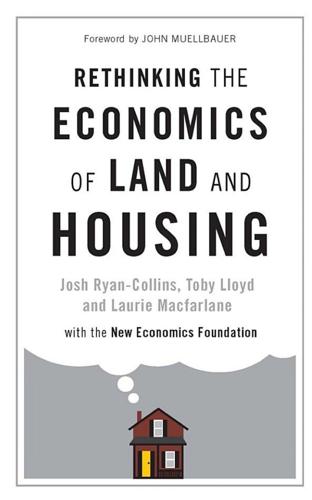
Rethinking the Economics of Land and Housing
by
Josh Ryan-Collins
,
Toby Lloyd
and
Laurie Macfarlane
Published 28 Feb 2017
In the case of the suburbanisation of cities, these costs can be seen today in the prevalence of low-density, car-dependent neighbourhoods and the resulting road congestion, economic and environmental costs (Litman, 2015) – although these impacts are far less pronounced in Britain than in many other developed economies, thanks to the much greater constraints on urban sprawl imposed after the Second World War. The combined effect of increased social housing and new private development meant that by the time war broke out again in 1939, an additional 4 million homes had been built since 1918 (Marshall, 1969). This period marked the beginning of the next major shift in land’s economic significance as it became the site of what has come to be regarded as a near-universally entitled consumption good: the family home.
…
In 2011, Altoona became the first place to shift the entire burden of property tax onto the land, in effect making it a full land value tax area. Evidence suggests that the split-rate taxation system in Pennsylvania has positively stimulated the construction and refurbishment of residential and commercial buildings, and resulted in a more efficient use of land (Cohen and Coughlin, 2005) and helped to curb urban sprawl (Banzhaf and Lavery, 2010). 7.4 Financial reform We laid out in Chapter 5 the central role of the financial system and its pro-cyclical interaction with land as the key challenge facing modern economies today. In modern economies, not least the UK, new loans collateralised against property have become the main source of the money supply and house prices have become intimately linked to consumption demand and economic growth via the collateral channel.
…
London: Bank of England. http://www.bankofengland.co.uk/financialstability/Pages/fpc/fsdiscussionpapers/080416.aspx. Bank of England. 2016d. ‘Three Centuries of Macroeconomic Data’. London: Bank of England. http://www.bankofengland.co.uk/research/Pages/onebank/threecenturies.aspx. Banzhaf, H. Spencer, and Nathan Lavery. 2010. ‘Can the Land Tax Help Curb Urban Sprawl? Evidence from Growth Patterns in Pennsylvania’. Journal of Urban Economics 67 (2): 169–179. Barker, Kate. 2004. Review of Housing Supply: Delivering Stability: Securing Our Future Housing Needs: Final Report: Recommendations. London: HMSO. Barlow, S. M. 1940. Report of the Royal Commission on the Distribution of the Industrial Population.
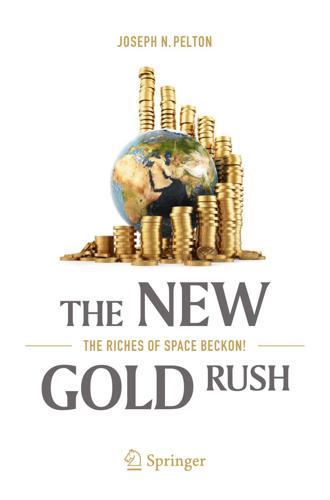
The New Gold Rush: The Riches of Space Beckon!
by
Joseph N. Pelton
Published 5 Nov 2016
The ISS really was no more than a space research station; in contrast this solar shield and transport terminal would protect Earth from trillions of dollars of devastating losses, perhaps save millions of lives, provide a constant supply of clean energy from space, and serve as a cost-efficient way station to the rest of the Solar System. And this is just one idea about how humans could reshape the structure of the inner Solar System to make it more usable and to help protect Earth from future catastrophic losses [1]. 5. Urban Sprawl is Bad, Urban Density is Good, Super Urbanization is Bad Again. For many years urban planners have sung a consistent song about the dangers, wastes and polluting effects of urban sprawl . The thought is that urban density can make for more efficient transportation, water, handling of sewage, communications, power, and storm sewer systems, and that housing, offices, schools, medical facilities, and shopping areas are also more effective and cost efficient.
…
Here is the ten point program that could make the world safer, more prosperous, and help us suffer much less strife and warfare.1.Seek agreement on global population control and associated incentives as a means to stop eating our planet alive. 2.Move to adopt sustainability as a strategy to create and achieve new wealth. 3.Encourage the world’s space agencies to prioritize planetary protection programs—including space shields to preserve modern infrastructure. 4.Recognize that urban sprawl is bad, urban density is good, while super urbanization and mega cities are bad again. 5.Refocus efforts on developing systems to address priority needs related to climate change, potable water and U. N. goals for sustainable development. 6.Deploy new space- and ground-based infrastructure for education and health care. 7.Recognize the unrealized potential of the coming singularity and the new abundance. 8.Adopt a new system of laws and regulation for the twenty-first century for global cooperation in space and on the planet. 9.Redefine and re-incentivize exploitation of “the global commons” for the twenty-first century based on sustainability and equitable sharing. 10.Recognize that humanity is at the turning point.
…
S. regulatory actions Space Mission Planning Advisory Group (SMPAG) Space navigation Space R&D programs Space Resource Exploration and Utilization Act of 2015 common heritage of mankind global commons legal enforcement outer space change policing regulatory system Sentinel infrared telescope space colonies traffic control and management Space Resource Utilization Space Swiss Systems (S3) Space tourism Space transportation ICAO radiation danger radio frequencies, allocation of SARPS traffic management and control Space-based navigation Space-based war-fighting systems SpaceHab Spaceplane system aerospace organizations safe and non-polluting development Space Ship 2 Space Swiss Systems (S3) SpaceShipOne and space tourism SpaceShipOne SpaceShipTwo Star wars Stratobus Stratolaunch Subspace/protospace Super automation Super urbanization Syncom 2 T TASI SeeTime Assignment Speech Interpolation (TASI) TDRS SeeTracking and Data Relay Satellite (TDRS) system Ten Point Program the global commons global population control humanity laws and regulation mega-structures and intellectual infrastructure planetary protection programs singularity space- and ground-based infrastructure sustainability urban sprawl Time and human technological progress Time Assignment Speech Interpolation (TASI) Tiny 40-kg Early Bird satellite Tracking and Data Relay Satellite (TDRS) system Transformational Satellite System (TSat) Transitional satellite (TSAT) Treaty on Principles Governing the Activities of States in the Exploration and Use of Outer Space Tripartite space governance unit TSat SeeTransformational Satellite System (TSat) TSAT SeeTransitional satellite (TSAT) U U.
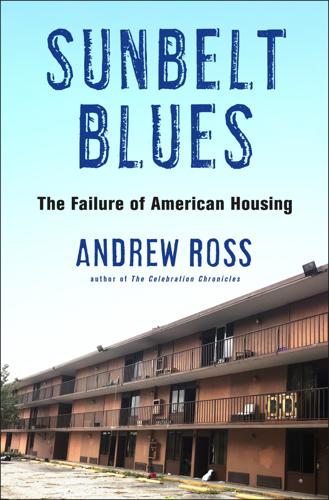
Sunbelt Blues: The Failure of American Housing
by
Andrew Ross
Published 25 Oct 2021
Over those same years, large Wall Street landlords like Invitation Homes (owned by the Blackstone Group) and American Homes 4 Rent were also being sued for a litany of complaints very similar to those in Celebration: negligent maintenance for mold, water penetration, infestations, and defective fixtures. There were also complaints of fee stacking—such as charging a late fee for nonpayment of a previous late fee—and of price gouging on rents. Stories about chronic neglect by corporate owners emerged across the entire housing landscape, from rural towns to urban sprawl. In its marketing materials, Invitation Homes boasted of providing a “worry free” living environment with “peace of mind” through “exceptional resident services,” including “24/7 emergency maintenance.”20 Yet tenants experienced service more akin to that of a slumlord, with long waits for major repairs, and most other maintenance jobs left in their own hands.
…
The environmental groups noted that the county already had a large surplus of approved but unbuilt residential units—62,356 of them—inside the UGB, in addition to 25.8 million square feet of similarly unused commercial space, so there was no demonstrated need to extend the boundary for further development.8 The agency agreed, ruling that Osceola’s proposed amendment was unnecessary, environmentally damaging, and likely to promote urban sprawl since it would remove any incentive to develop the “vacant underutilized land” that lay within the UGB.9 In other words, if the Northeast District plan were approved, Osceola would be pulling the rug out from under the smart growth commitments it had made only three years previously.10 Luckily for the developers, the agency’s days were numbered.
…
See Gabrielle Russon, “Disney World Is Suing over Its Property Taxes—Again,” Orlando Sentinel, June 12, 2020, https://www.orlandosentinel.com/business/tourism/os-bz-disney-rick-singh-20200612-6hiunjd6hjef3c7si5imzjte3e-story.html. It also takes advantage of the state’s agricultural tax break to preserve rural land from urban sprawl. Often called the “two-cow tax break” because of the low bar it sets for landowners seeking an exception, the law is widely abused by developers and corporations like Disney. Jason Garcia, “Ca$h Cow: Tavistock, Disney and Others Save Millions from Tax Break Meant to Help Farmers,” Orlando Sentinel, February 19, 2021, https://www.orlandosentinel.com/news/os-prem-ne-florida-farming-property-tax-break-20210217-xngxwwbc4vakjlrbcq5sfltdcq-htmlstory.html. 15.
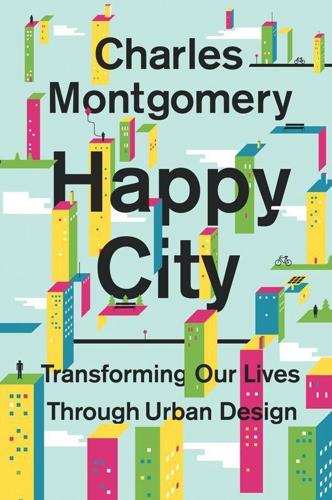
Happy City: Transforming Our Lives Through Urban Design
by
Charles Montgomery
Published 12 Nov 2013
The innovation precipitated a powerful new economic engine: as people moved from inner cities to detached homes in increasingly distant sprawl, they bought furniture and appliances to fill those homes, and cars to move between increasingly disconnected destinations. The market economist’s case for suburban sprawl goes like this: if you can judge what makes people happy by observing how they spend their money, then the fact that so many people have purchased detached homes in urban sprawl is proof that it leads to happiness. As writers such as Robert Bruegmann and Joel Kotkin have argued, sprawl fulfills American’s preferences for privacy, mobility, and detachment from the problems of high-density environments. By this way of thinking, sprawl reflects every individual’s natural-born right to maximize utility.
…
Mableton, you may recall, showed up in Lawrence Frank’s urban-health studies as one of those towns that is so unwalkable that people get fatter just living there. The unincorporated community fifteen miles west of downtown Atlanta is the kind of place where you could drive for days and never quite feel that you had arrived anywhere. Tendrils of asphalt braid and curl through the semi-urban sprawl northeast of Atlanta’s Perimeter beltway, with cul-de-sacs and strip malls and business parks evenly scattered over the rolling terrain. If you circled the dying mall down on Veterans Memorial Highway—cruelly misnamed the Village at Mableton—or doubled back and headed up to the big-box power centers that cling to the East-West Connector, you would find yourself increasingly disoriented, and you would not have found anything you’d call a downtown—certainly not the view from the post office parking lot.
…
T. Cacioppo, D. S. Lauderdale, and C. Ober, “Loneliness Is Associated with Sleep Fragmentation in a Communal Society,” SLEEP 2011; 34(11):1519–26. live longer: Putnam, Robert D., Bowling Alone (New York: Simon and Schuster Paperbacks, 2000); Frumkin, Howard, Lawrence Frank, and Richard Jackson, Urban Sprawl and Public Health: Designing, Planning, and Building Healthy Communities (Washington, DC: Island Press, 2004); Seeman, T. E., “Social Ties and Health: The Benefits of Social Integration,” Annals of Epidemiology, 1996: 442–51; Hirdes, J. P., and W. F. Forbes, “The Importance of Social Relationships, Socioeconomic Status, and Health Practices with Respect to Mortality Among Healthy Ontario Males,” Journal of Clinical Epidemiology, 1992: 175–82; Veenstra, Gerry, “Social Capital and Health (Plus Wealth, Income Inequality and Regional Health Governance),” Social Science and Medicine, 2002: 849–68; Berkman, Lisa F., “The Role of Social Relations in Health Promotion,” Psychosomatic Medicine, 1995: 245–54.
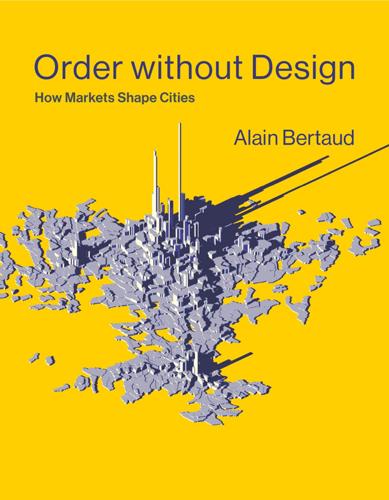
Order Without Design: How Markets Shape Cities
by
Alain Bertaud
Published 9 Nov 2018
From NIMBY, “not in my backyard,” an expression used by pressure groups to prevent development of any type, including indispensable public services like hospital and homeless shelters. 19. Jan K. Brueckner and David A. Fansler, “The Economics of Urban Sprawl: Theory and Evidence on the Spatial Sizes of Cities,” Review of Economics and Statistics 65, no. 3 (1983): 479–482, quote on 479. 20. Jan K. Brueckner, “Urban Sprawl: Lessons from Urban Economics,” Brookings-Wharton Papers on Urban Affairs, Brookings Institution, Washington, DC, 2001. 21. Edward L. Glaeser and Matthew E. Kahn, “Sprawl and Urban Growth,” NBER Working Paper 9733, National Bureau of Economic Research, Cambridge, MA, May 2003. 22.
…
Urban economists have therefore identified the many factors that could distort urban land markets, such as the inability to price road congestion; the subsidies given to infrastructure and fuel prices; the abusive use of eminent domain underpricing rural land; and finally, the land use regulations that force households and firms to use more land than they need—minimum lot sizes, maximum densities, and maximum FARs. These distortions could indeed result in an excessive expansion of urban land, and removing them would make expanding cities more efficient and the area they occupy closer to an economic optimum. For instance, Brueckner, in a paper titled “Urban Sprawl: Lessons from Urban Economics,”20 provides an analysis of the possible causes for land market distortions and identifies practical remedies. For each possible cause of distortion, a theoretical model can be built that calculates the impact of the distortion on urban land consumption. For instance, in a country that subsidizes gasoline, an economist can calculate the impact of the subsidy on a city built-up area and the reduction in urbanized land that would result from removing the subsidy.
…
See Standard urban model Sprawl (Bruegmann), 116 Staff agencies, 369–370 Staley, Samuel, 176 Standard of living, 290–291 Standard urban model, 388n18 minimum standards in, 288–289 for spatial distribution, 101, 113–114, 115–118, 117f, 129–130, 140–141 Sprawl (Bruegmann), 116 theory of, 95–97, 98f–99f, 99, 335–336 “Urban Sprawl: Lessons from Urban Economics” (Brueckner), 336 Stanford University, 351 Stockholm, 385n22 St. Petersburg (Russia), 373, 384n6 Strategic Community Investment Report Data, 353 Streetscapes, 331–332 Street space. See Road networks Subdivisions, 230–231, 230f Subletting, 266–267, 282–283 Subsidies in affordability, 303–304 demand side subsidies, 260–263, 262f, 267–268, 286, 304 economics of, 100–101 for infrastructure, 290–292, 291f poverty and, 273 supply side subsidies, 264–269, 265f, 285–286 Subways.
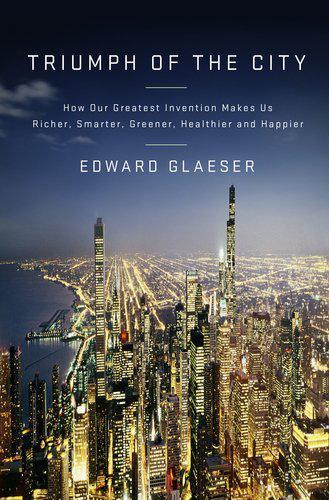
Triumph of the City: How Our Greatest Invention Makes Us Richer, Smarter, Greener, Healthier, and Happier
by
Edward L. Glaeser
Published 1 Jan 2011
Government Printing Office, Congressional Research Service, A Chronology of Housing Legislation and Selected Executive Actions, 1892-2003, Mar. 2004, www.gpo.gov/fdsys/pkg/CPRT-108HPRT92629/html/CPRT-108HPRT92629.htm. 176 the McMansions of their day: Hayden, “Building the American Way,” 276. 176 disproportionately to middle-class enclaves: U.S. General Accounting Office, Resources, Community, and Economic Development Division, House of Representatives, Community Development: The Extent of Federal Influence on “Urban Sprawl” Is Unclear, Apr. 30, 1999, GAO/RCED-99-87 Research on “Urban Sprawl,” www.gao.gov/archive/1999/rc99087.pdf. 176 overwhelmingly single-family houses: U.S. Census Bureau, U.S. Census 2000, Data Profile for the United States, Summary File 3, generated using American FactFinder. 177 half of the jobs . . . away from the city center: Kneebone, “Job Sprawl.” 177 inverse connection between density and car usage: Glaeser and Kahn, “Sprawl,” 2499-2500. 177 Accord... a hundred square feet on its own: According to Honda’s Web site, a 2010 Honda Accord has a length of 194.1 inches and a width of 72.7 inches, for an area of 98 square feet: http://automobiles.honda.com/accordsedan/specifications.aspx?
…
Cities built around the car, like much of Los Angeles and Phoenix and Houston, have enormous, gently curving roads and often lack sidewalks. In those places, shops and pedestrians retreat from the streets into malls. While older cities usually have an obvious center, dictated by an erstwhile port or a rail station, car cities do not. They just stretch toward the horizon in undifferentiated urban sprawl. Places like Atlanta and Houston remind us that there are places that lie between hyperdense Hong Kong and rural Saskatchewan. Living and working in car-oriented Silicon Valley offers plenty of proximity, at least to people in the computer industry. The threat that these places pose to traditional cities reflects the fact that they offer some of the old advantages of urban access along with plenty of land and the ability to drive everywhere.
…
group=dimensions. 178 typical parking space: Parking regulations in Massachusetts, for instance, require parking spaces to measure at least 9 feet by 18 feet, or 162 square feet: www.mass.gov/Cago/docs/Municipal/sb_parking.rtf. 178 structured parking, which can cost more than $50,000: Marshall and Emblidge, Beneath the Metropolis, 181. 178 average gas tax in France: Glaeser and Kahn, “Sprawl,” 2499-2500. 178 Comparing seventy cities ... 40 percent: Glaeser and Kahn, “Sprawl.” 178 Today, 84 percent of passenger transport: European Road Federation, European Road Statistics 2009, table 6.3: “Inland Transport Modal Split by Country in EU-27,” p. 43. 178 In Italy ... 5 and 5.66: European Automobile Manufacturing Association, Automobile Industry Pocket Guide, “Trends in Motorisation,” p. 4, www.acea.be/images/uploads/files/20090529_motorisation.pdf. 178 there are 7.76 cars for every 10 Americans: Ibid. 178 European Environment Agency . . . “low density residential areas”: European Environment Agency, Urban Sprawl in Europe, fig. 2, p. 12. 179 in the United States . . . forty-eight minutes: Glaeser and Kahn, “Sprawl,” 2499-2500. 179 That time cost . . . for buses and subways: Glaeser et al., “Why Do the Poor Live in Cities?” 12. 180 The Woodlands: General history of The Woodlands from Galatas and Barlow, The Woodlands. 180 on twenty-eight thousand sylvan acres: The Woodlands. http://www.thewoodlands.com/masterplan.htm. 180 over ninety-two thousand people live in The Woodlands: The Woodlands Development Company.
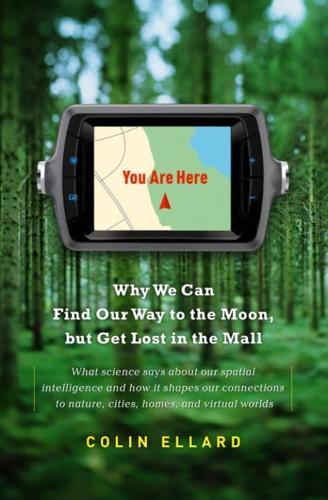
You Are Here: Why We Can Find Our Way to the Moon, but Get Lost in the Mall
by
Colin Ellard
Published 6 Jul 2009
When we suggested that those so affected could simply walk to one another’s houses, the traffic engineer curtly replied, “They won’t.” The issue was closed. We put our house on the market a few days later. In the second half of the twentieth century, urban sprawl accelerated dramatically. The urban area of Atlanta ballooned to over 160 kilometers when measured from north to south. Detroit’s population actually decreased by 2 percent while its land area increased by 45 percent. And urban sprawl is not just a North American phenomenon. Brussels, Frankfurt, Munich, and Zurich all showed decreases in population density in the late twentieth century. Even Copenhagen, a showpiece city for improving pedestrian access to the urban core, had a net decrease in population density.23 There is much to enjoy in the suburbs.
…
A fascinating repository of facts and figures related to the worldwide problem of urban sprawl can be found in the book by Jeffrey Kenworthy and Felix Laube entitled An International Sourcebook of Automobile Dependence in Cities, 1960-1990 (University Press of Colorado: Boulder, CO, 1999). 24. One of the most widely cited (and frightening) views of the coming changes related to peak oil is Howard Kunstler’s The Long Emergency: Surviving the End of Oil, Climate Change, and Other Converging Catastrophes of the Twenty-first Century (Grove Press: New York, 2006). 25. The history of Portland’s experiences with Oregon’s groundbreaking 1973 restrictions on urban sprawl, as well as many other positive examples of smart growth approaches, can be found in the book by F.
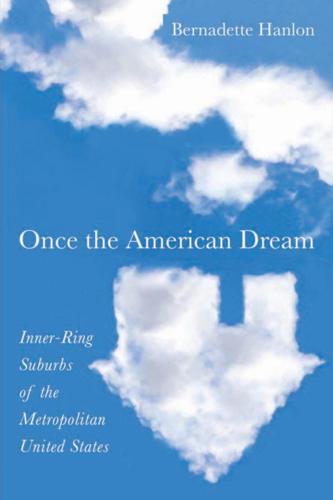
Once the American Dream: Inner-Ring Suburbs of the Metropolitan United States
by
Bernadette Hanlon
Published 18 Dec 2009
Growth Management Policies addressing decline among inner-ring suburbs often exist in the framework of “smart growth.” Definitions of smart growth are varied (e.g., see Smart Growth America 2003; Vermont Forum on Sprawl 2003), but, in their broadest sense, smart-growth policies are characterized as strategies aimed at curbing another ill-defined concept, urban sprawl. In the process of combating sprawl, smart-growth policies encourage the redevelopment of inner-ring core areas and the development of infill sites closer to the urban core area rather on the outer fringe (Downs 2001). The 2002 American Planning Association report, Planning for Smart Growth: 2002 State of the States, surveys various growth-management policies across different states.
…
Participation in American politics: The dynamics of agenda-building. Boston: Allyn and Bacon. Cobb, Roger W., Jennie-Keith Ross, and Marc Howard Ross. 1976. Agenda building as a comparative political process. American Political Science Review 70 (1): 126–138. Cohen, James. 2001. Maryland’s smart growth: Using incentives to combat sprawl. In Urban sprawl: Causes, consequences and policy responses. Ed. Gregory Squires, 293–324. Washington, DC: Urban Institute Press. Cooke, Thomas, and Sarah Marchant. 2006. The changing intrametropolitan location of high poverty neighbourhoods in the US, 1990–2000. Urban Studies 43 (11): 1971–1989. Cooper, Donald R., and Pamela S.
…
The new urban frontier: Gentrification and the revanchist city. London: Routledge. Smith, Neil, Patrick Caris, and Elvin Wyly. 2001. The “Camden syndrome” and the menace of suburban decline: Residential disinvestment and its discontents in Camden County, New Jersey. Urban Affairs Review 36 (4): 497–531. Squires, Gregory D. 2002. Urban sprawl: Causes, consequences, and policy responses. Washington, DC: Urban Institute Press. Stahura, John M. 1979. Suburban status evolution/persistence: A structural model. American Sociological Review 44 (6): 937–947. Sternlieb, George, and Robert W. Lake. 1975. Aging suburbs and black homeownership.
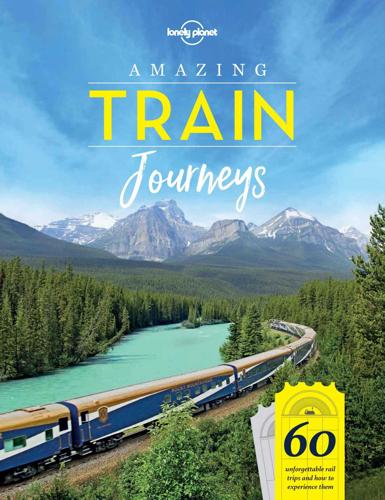
Amazing Train Journeys
by
Lonely Planet
Published 30 Sep 2018
Keep an eye out as the train crosses the famous Ham Rong bridge soon after at Thanh Hoa – perhaps the most strategically important bridge on the railway during the Vietnam War, it was the target of hundreds of unsuccessful American bombing raids, % contested by countless dogfights in the skies above. The Reunification Express saves the best for last on its final approach to Hanoi – slicing straight through the chaotic urban sprawl of Asia’s most beautiful capital. Rather alarmingly, the tracks form an ad hoc market-turned-pedestrian-walkway when trains aren’t running, with stalls and houses standing inches from the rails. Connecting Vietnam’s greatest attractions makes the railway immensely popular with tourists – reliably whisking visitors from the serene pools of Hue to the hectic markets of Ho Chi Minh City, and from the lazy resorts of Nha Trang to the scooter- clogged Old Town of Hanoi.
…
A Japan Rail Pass offers unlimited travel on this train, meaning you can spend all day, or a couple of days, hopping on and off and exploring this route. Combine it with hiking part of the signposted Nakasendō Way to really get a feel for how travellers and traders plied this route in bygone times. ❶ RIDING THE RAILS Winding. You feel the mountains rise up next to you almost immediately as the train works its way out of Nagoya’s urban sprawl. Tin-topped houses and telephone poles give way to a river, which you follow most of your way to Matsumoto. The river changes course and names several times but feels a constant companion. You have to relax, because this railway is not your stereotypical Japanese bullet train. Make no mistake: you’ll depart and arrive on time, exactly – Japanese efficiency extends to the farthest reaches of its railway network – but that is not the point here.
…
The train doesn’t run from mid-December to mid-January. OB RIGHT: The Outback, as seen from the comfortable carriages of the Ghan. © MATT MUNRO | LONELY PLANET Explore the northern city of Darwin and nearby Kakadu National Park. Darwin South Coast Line AUSTRALIA Escape Sydney’s urban sprawl with this relaxing day-ride on the prettiest of commuter lines. Pass remnants of Gondwanaland rainforest and verdant bush resplendent with fascinating birdlife, delve through tunnels and deep ravines fringing one of the world’s oldest national parks and be dazzled by stunning ocean vistas of rocky headlands, beckoning golden beaches and migrating whales.
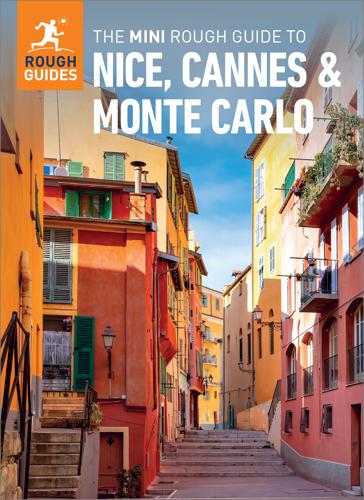
The Mini Rough Guide to Nice, Cannes & Monte Carlo (Travel Guide eBook)
by
Rough Guides
Published 1 Apr 2023
The 9,500 Monégasque citizens may elect the Conseil National which consists of 24 parliamentarians every five years, but the real sense of power stays with the Sovereign Prince, who signs all ordinances and nominates (and these are subject to approval by France) the Minister of State and also five other members of government. Image Makeover Not everything is rosy when everyone wants to live in the sun. Urban sprawl has disfigured much of the coast. Pressure for land and flats bought by often absent tax exiles makes Monaco far too expensive for most of its employees to live there. There’s a shortage of housing, too, in Cannes, where people prefer to let flats at high prices to festival-goers, congress clientele and tourists than to the local population; while the contrasts between rich and poor are striking in Nice’s housing estates and the villas of Mont Boron.
…
I consider it, despite all its imperfections, as my masterpiece.’ The Musée Renoir Down the hill, east of the modern centre of Cagnes-sur-Mer, the Domaine Les Collettes, now the Musée Renoir (Wed–Mon June–Sept 10am–1pm, 2–6pm, Oct–Mar 10am–noon, 2–5pm, Apr–May until 6pm), was bought by the elderly Renoir in 1908. Although now surrounded by urban sprawl and apartment blocks that have partly obscured the view, the house and gardens have changed little since Renoir lived here, receiving visitors such as Pierre Bonnard and Matisse, who painted the garden, as well as photographer Willy Maywald, whose photos hang on the stairs. Shutterstock Chapelle du Rosaire Henri-Matisse Paintings around the house include a study for the large Late Bathers, its heightened, almost garish, palette no doubt something to do with the Riviera’s bright sunshine, which Renoir described as ‘maddening’; and a charming small portrait of his youngest son Claude, Coco Reading, dressed in a sailor suit that can still be seen hanging in the studio.
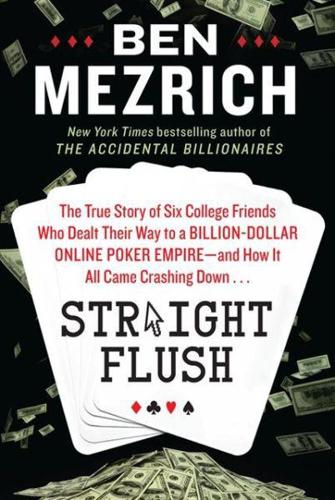
Straight Flush: The True Story of Six College Friends Who Dealt Their Way to a Billion-Dollar Online Poker Empire--And How It All Came Crashing Down . . .
by
Ben Mezrich
Published 27 May 2013
By the third and fourth book they’d visited, the seediness was reaching almost cartoonish proportions. Around 4 P.M., at the last stop before they were to break for dinner—and start a night of festivities that Eric had assured them would rival anything they had experienced at the fraternity house—they pulled up in front of a warehouse at the edge of an urban sprawl of similar rectangular buildings. Eric parked the car and led them through the front door, past a security desk, then a pair of secretaries who didn’t even bother looking up from the Spanish newspapers they were reading. Then through an unmarked wooden door and into a corner office. And there, the man behind the desk was right out of a Martin Scorsese movie.
…
It was midafternoon, just like the last time he’d arrived in San José, but the roads seemed even more congested, traffic going in every direction. As before, he was amazed at how alive the place felt, how it seemed to throb with energy. So many cars, people, noise—even above the insanely loud music pumping through the van’s speakers, the sounds of the urban sprawl felt like a hand, reaching right through those trembling windows, grabbing at Scott’s skin. This was it. He was really here; this was actually happening. It was goddamn exhilarating. Nearly an hour later they were still engulfed by the thrill of it all when Shane shot a finger toward the window by his head.
…
The building itself was massive, an old Spanish-style mansion with at least six bedrooms, a living room that could have doubled as a ballroom, and multiple decks overlooking downtown San José—a vista of sparkling lights, bolstered by the pulsing flare of the constant traffic that threaded between the buildings, like a radiated circulatory system feeding that ravenous urban sprawl. The party was mostly confined to the house’s massive pool deck. A DJ had set up shop on an elevated stage, the music from his spinning CDs blasting out of massive twin speakers that had been built right into one of the house’s exterior brick walls. At five minutes to midnight, Scott strolled through the party, pulling everyone he could find out of whatever trouble they had gotten into to lead them to the farthest railing that looked out over the city.
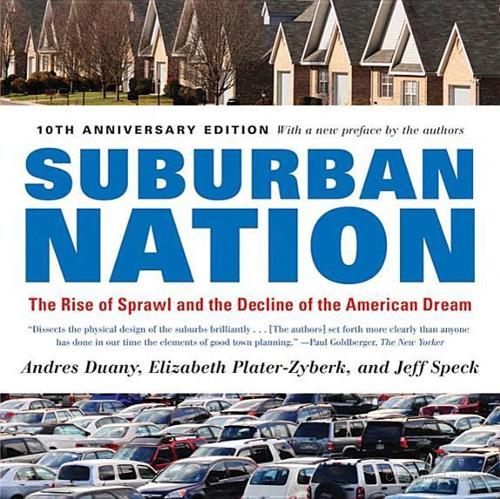
Suburban Nation
by
Andres Duany
,
Elizabeth Plater-Zyberk
and
Jeff Speck
Published 14 Sep 2010
—Witold Rybczynski, author of City Life and The Most Beautiful House in the World “Suburban Nation provides a marvelously detailed critique of suburbia as it exists, a landscape most of us are intimately familiar with but few of us have thought much about … Duany, Plater-Zyberk and Speck write surprisingly pithy, elegant prose, and Suburban Nation is full of juicy insider observations drawn from the Orwellian world of suburban planning.” —Andrew O’Hehir, Salon “[A] bold and damning critique … [This] visionary book holds out hope that we can create ‘places that are as valuable as the nature they displaced.’” —Publishers Weekly “I am convinced that the explosion of urban sprawl over the last fifty years has played a part in the breakdown of America’s civic engagement. Suburban Nation calls on all of us to revolutionize how we use politics and public policy to shape our built environment—our local homes, towns, and cities—and ultimately the public life of our own communities.”
…
Arnold, Henry. Trees in Urban Design. New York: Van Nostrand Reinhold, 1993. Aschauer, David. “Transportation, Spending, and Economic Growth.” Report by the American Public Transit Association, September 1991. Benefield, F. Kaid; Matthew D. Raimi; and Donald D.T. Chen. Once There Were Greenfields: How Urban Sprawl Is Undermining America’s Environment, Economy, and Social Fabric. New York: National Resources Defense Council, 1999. Beyond Sprawl: New Patterns of Growth to Fit the New California. Report by the Bank of America, the Resources Agency of California, the Greenbelt Alliance, and the Low Income Housing Fund, 1995.
…
Louis, Pruitt Igoe housing project San Antonio San Bernardino (California) San Diego San Francisco; Embarcadero Freeway Santa Barbara Santa Fe Savannah schools; consolidated districts; federal mandate on; in new towns and villages; state policies on; urban Schuster, Bud Seagrove (Florida) Seaside (Florida); architectural style of; civic buildings in; live-work units in Seattle security; private segregation, income-based Sennett, Richard sense of place septic-tank sprawl Sert, Jose Luis setbacks sewage facilities Shaker Heights (Ohio) shipping methods shootings, high school shopping centers; adjacency versus accessibility to; along highways; versus main streets; neighborhood-scale; see also malls sidewalks; width of Sierra Club Silvetti, Jorge single-family houses; architectural style of; builders of; design of, value and; facades of; federal loan programs for; in new towns and villages; taxes on; urban single-use zoning; adjacency versus accessibility in; investor security and; in regional planning site plans; of five-minute walk neighborhoods site-value taxation Sitte, Camillo smart growth, government policies on “smart streets,” Snyder, Mary Gail soccer moms social decline, environmental causes of social equity: greenfield development and; regional planning and Southern California Association of Governments South Florida Water Management District Soviet Union sparse hierarchy spatial definition special-needs populations, facilities for speeding Spivak, Alvin sports events, urban sprawl; aesthetics of; architectural style and; components of; design to combat; developers and; environmentalist attack on; government policies to combat; history of; homebuilders and; housing as largest component of; increased automobile use and; municipalities bankrupted by; parking requirements and; plans for; poverty and; principles for reshaping, see new towns and villages; proactive approach to fighting; regional planning and; road rage and; successes in fight against; traffic congestion created by; victims of squares, town Stalin, Joseph Stanford Research Institute, state policies stores, corner, see corner stores; see also retail streets: in new towns and villages; pedestrian-friendly, see pedestrian-friendly design; in subdivisions; termination of vistas on; traditional neighborhood; width of strip centers, see shopping centers Stuart (Florida) style, architectural subdivisions; adjacency versus accessibility of shopping to; anticipated costs of servicing; boring; connectivity of new neighborhoods and; construction costs for; “cookie cutter,” 48; crime in; and federal loan programs; homebuilders and; landscaping of; marketing of; open space in; permitting process for; public realm and; street design in subsidies, retail suicide, teenage Supreme Court, U.S.
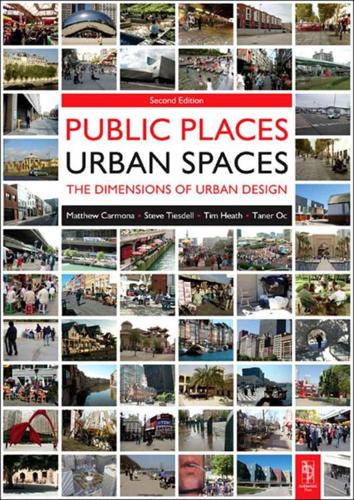
Public Places, Urban Spaces: The Dimensions of Urban Design
by
Matthew Carmona
,
Tim Heath
,
Steve Tiesdell
and
Taner Oc
Published 15 Feb 2010
Laura Jackson, for example, cites evidence that pedestrian fatalities are most common in those parts of the USA where urban sprawl is the dominant form – despite walking being less prevalent in such locations, with consequential increases in obesity and hypertension (Ewing et al 2008). More profoundly, while a higher quality and quantity of social relationships are associated with health benefits, social stratification and income inequality is associated with increased mortality. Because urban sprawl is strongly associated with an absence of social capital, and with higher stratification in society, it is also increasingly seen as a main contributing factor to a range of negative health impacts culminating in the potential for higher mortality (Frumkin 2001: 209).
…
As discussed below, it is likely that diminishing supplies of oil and climate change, rather than cultural preference, will result in a return to greater urbanity and greater concentration of population (though not necessarily in big cities). BOX 2.5 Smart Growth Growing concern about contemporary development patterns in the USA has led to the emergence of ‘smart growth’ (see www.smartgrowth.org). Smart growth advocates unify around the aim of changing what they regard as the undesirable impacts of (sub)urban sprawl, typically questioning the economic costs of abandoning infrastructure; the social costs of the mismatch between new employment located in the suburbs and the available workforce in the city; and the environmental costs of abandoning ‘brownfield’ sites, building on open space and prime agricultural lands at the suburban fringe, and increasing pollution by driving further (EPA 2001).
…
Associated with a range of environmental, economic and social problems, automobile or car dependence exists where urban form and transport options are such that choices are limited to car use, with an associated range of environmental, economic and social problems (see Table 2.3). TABLE 2.3 Problems of Car Dependency Source: Newman & Kenworthy (2000: 109).EnvironmentalEconomicSocial • Oil vulnerability • Petro-chemical smog • Toxic emissions such as lead and butane • High greenhouse gas contributions • Urban sprawl • Greater storm-water problems from extra hard surfaces • Traffic problems such as noise and severance • External costs from accidents and pollution • Congestion costs, despite road building • High infrastructure costs in new sprawling suburbs • Loss of productive rural land • Loss of urban land to bitumen • Loss of street life • Loss of community • Loss of public safety • Isolation in remote suburbs • Access problems for those without cars and those with disabilities Peak Oil It is not merely car dependence that is a problem, but also the dependence of the global economy, contemporary society and the accustomed quality of life on the diminishing reserves of ready available and relatively cheap oil.

Pocket Rough Guide Istanbul
by
Rough Guides
Published 26 Nov 2023
Also worth seeking out is the Çadır Köşkü, another charming pavilion downhill from the Malta Köşkü, beyond the small artificial lake. Ortaköy MAP Buses #22, #22/RE, #25/E from Kabataş, #40, #40/T, #42/T from Taksim. Despite being dominated by the towering Bosphorus suspension bridge, built in 1973, and surrounded by urban sprawl, Ortaköy has not entirely lost its former fishing village charm. The waterfront area, the so-called boardwalk, is today all cool cafés frequented by well-heeled Istanbulites, who come to see and be seen – and perhaps browse the artsy-craftsy Sunday morning market. The waterfront mosque, the Büyük Mecidiye Camii, is a Baroque gem built in 1854, while in the streets behind are reminders of the village’s cosmopolitan past, the (invariably locked) Ezt Ahayim synagogue and the attractive, nineteenth-century Greek Orthodox church of Aya Fokas (St Phocas), the door to the walled compound of which is occasionally open.
…
On the east of the island the Museum of the Princes’ Islands (adalarmuzesi.org, charge) has an exhibition about the island’s writers and poets and nearby is the charming boutique Ayanikola Butik hotel. There are several places to swim; by far the most peaceful is the Halik Köyü Plajı (charge), reached by steep steps from the road running around the island some 3km south of the town. Many views from the islands inevitably at least partially include the urban sprawl of the metropolis, but here you have lovely views across the Sea of Marmara to its distant, wooded south shore. Phaeton Lydia Evans/Rough Guides < Back to The Bosphorus and Princes’ Islands Pool at the Four Seasons Bosphorus Four Seasons Hotels and Resorts ACCOMMODATION Sultanahmet Topkapı Palace to the Golden Horn Grand Bazaar and around The Northwest quarter Galata Beyoğlu Beşiktaş and Ortaköy Bosphorus and Princes’ Islands Letting agencies Most visitors choose to stay around Sultanahmet, the heart of the old city, where there is a high concentration of hotels, pensions and hostels, as well as the major sights.
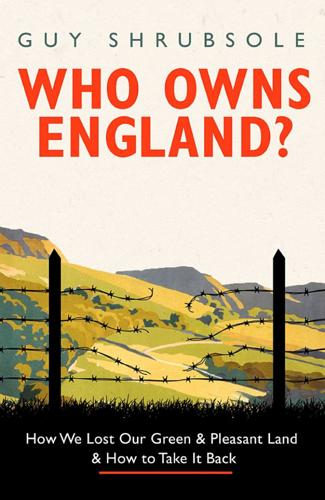
Who Owns England?: How We Lost Our Green and Pleasant Land, and How to Take It Back
by
Guy Shrubsole
Published 1 May 2019
The destruction nowadays may be less blatant, but the rot is more insidious: decades of pesticide overuse and intensified agriculture has damaged soil structures and decimated our wildlife. Scientists are clear that agriculture is the main driver of species loss in Britain today. We have a mechanism for deciding how to constrain urban sprawl; it’s called the planning system. But ever since the Town and Country Planning Act was introduced in 1947, landowners have vociferously resisted extending its remit to cover farming and forestry operations. In the 1980s, amid mounting evidence that intensive agriculture had displaced urban sprawl as the driver of environmental destruction, campaigner Marion Shoard proposed applying planning ‘to the task of rescuing our landscape’. Today, it’s time to reopen that debate.
…
Lodge Hill in north Kent, for example, is an old disused MOD base, which over the decades has reverted to wilderness and become the number one nesting site in the UK for nightingales. I’ve walked through part of it, a glorious tangle of hawthorn and oak, and a breath of fresh air for local residents looking to escape the urban sprawl along the Medway. Yet for years the MOD, under pressure from ministers to sell off land for housing, proposed bulldozing Lodge Hill to build 5,000 new homes. We need to build more homes, no question. Yet rather than fix the real stranglehold on house-building – the hoarding of land by private landowners in pursuit of higher land values – Whitehall has become obsessed with flogging off the remnants of its own estate, regardless of how the land has altered since it first acquired it.
…
We need to make London’s Green Belt better serve the city’s inhabitants, by using more of it for community food growing and for nature. Currently, too much of the Green Belt is a welter of golf courses and land banks owned by shadowy firms. Free marketeers argue that we simply need to tear up the Green Belt and build housing on it. But quite apart from the massive urban sprawl and congestion this would generate, it would do little on its own to address the housing crisis – since landowners in the Green Belt would simply pocket huge windfall gains from the spike in land values, and the new housing would end up being sold at unaffordable prices. What we need instead is to rejuvenate the Green Belt so that it better fulfils its original purpose of providing green space and recreation for the public.
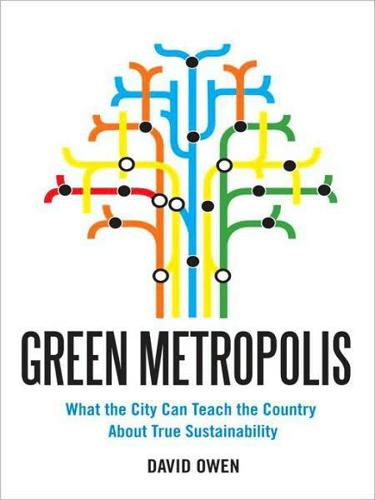
Green Metropolis: Why Living Smaller, Living Closer, and Driving Less Are Thekeys to Sustainability
by
David Owen
Published 16 Sep 2009
This is a reprint edition of the book, which was published originally in 1995. 29 Richard Register, Ecocities: Rebuilding Cities in Balance with Nature (Gabriola Island, B.C., Canada: New Society Publishers, 2006), pp. 316-17. 30 Newman and Kenworthy, Sustainability and Cities, pp. 30-31. 31 Sharon Feigon and David Hoyt, “Land Use and Greenhouse Gas Emissions from Transportation,” Center for Neighborhood Technology, 2003. 32 Ignacio San Martín, “The Character of Urban Sprawl and Its Indicators,” First Policy Forum on Urban Sprawl, Center for Environmental Studies, Budapest, Hungary, 2000. 33 The sprawling development of Phoenix is aptly described by the caption below a photograph on a NASA website: “Phoenix is actually surrounded by 22 towns and cities that have grown so closely together in recent decades it is almost impossible to distinguish one from another in this 30-meter-resolution satellite image.”
…
See also anti-urbanism; suburbs and nonurban areas automobile’s role in consumer cost of power corporate campus public transit and Sierra Club campaign against traffic pattern improvement and in Washington D.C. zoning ordinances and Sprint Nextel Corporation building Standard Oil Strong, Gordon Strong, Steven J. suburbs and nonurban areas. See also anti-urbanism; sprawl acquisition and storage of possessions appeal of downsized automobiles environmental profile of home, automobile in grass cultivation inefficient use of resources necessity of automobiles outdoor activity population-dispersion concept sedentary lifestyle and obesity zoning sustainability.
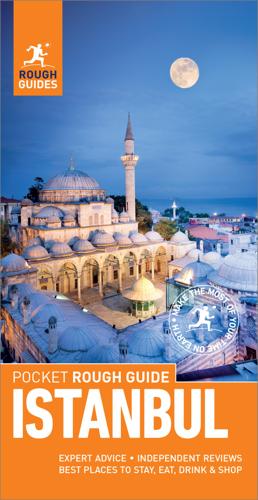
Pocket Rough Guide Istanbul (Travel Guide eBook)
by
Rough Guides
Published 24 May 2019
Numerous stalls line the waterfront and side-streets selling red-hot varieties stuffed with virtually everything imaginable, from pungent Turkish cheeses and olives to spicy sausages and tuna. Ortaköy MAP Buses #22, #22/RE, #25/E from Kabataş, #40, #40/T, #42/T from Taksim. Despite being dominated by the towering Bosphorus suspension bridge, built in 1973, and surrounded by urban sprawl, Ortaköy has not entirely lost its former fishing village charm. The waterfront area, the so-called boardwalk, is today all cool cafés frequented by well-heeled Istanbulites, who come to see and be seen – and perhaps browse the artsy-craftsy Sunday morning market. The waterfront mosque, the Büyük Mecidiye Camii, is a Baroque gem built in 1854, while in the streets behind are reminders of the village’s cosmopolitan past, the (invariably locked) Ezt Ahayim synagogue and the attractive, nineteenth-century Greek Orthodox church of Aya Fokas (St Phocas), the door to the walled compound of which is occasionally open.
…
On the east of the island the Museum of the Princes’ Islands (March–Nov Tues–Sun 9am–6pm; Dec–Feb 10am–5pm; ŧ5) has an exhibition about the island’s writers and poets and nearby is the charming boutique Ayanikola Butik hotel. There are several places to swim; by far the most peaceful is the Halik Köyü Plajı (8am–dusk; ŧ15), reached by steep steps from the road running around the island some 3km south of the town. Many views from the islands inevitably at least partially include the urban sprawl of the metropolis, but here you have lovely views across the Sea of Marmara to its distant, wooded south shore. Getting to the Princes’ Islands In Byzantine times home to monasteries and banished royalty, and at the turn of the nineteenth century to the city’s wealthy Christian minorities, the islands today (Adalar in Turkish) are a popular escape.
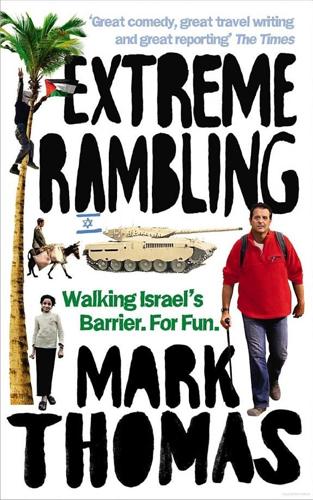
Extreme Rambling: Walking Israel's Separation Barrier. For Fun.
by
Mark Thomas
Published 13 Apr 2011
The Israeli city was started in 1982 but it feels like the builders were paid before they finished. Roads occasionally run out of pavement, piles of rubble appear in the street and roundabouts wait to be landscaped. I don’t know the correct architectural term for this place but I suspect it might be ‘urban sprawl’ or ‘urban sprawl … with a very long snagging list’. Palm trees sporadically line the roads or sit by bus shelters, but it is tower blocks that dominate the city, stacked side by side in pale brown and grey brick, block after block after block. Essentially, the settlement is a nice religious council estate.
…
‘That’s Ma’ale Adumim, over in the hills.’ He points to the map once more, and an area called E1, a controversial development plan to extend from the northeast of Jerusalem, deep into the West Bank to the settlement of Ma’ale Adumim. Once completed, it will connect the two cities into one large urban sprawl extending across the West Bank. Not only will it ensure there is no room for natural growth for Palestinian areas of East Jerusalem; it will also irrevocably cut off East Jerusalem from the rest of the West Bank, and break the West Bank in two. Richard Makepeace, the British Consul General, had explained one of the hazards of this type of expansion when we had walked with him earlier: ‘Every additional settlement that is built, every settlement unit – whether it is in Jerusalem or elsewhere in the Occupied Territories – that is a problem that has to be overcome in reaching a final status deal.’
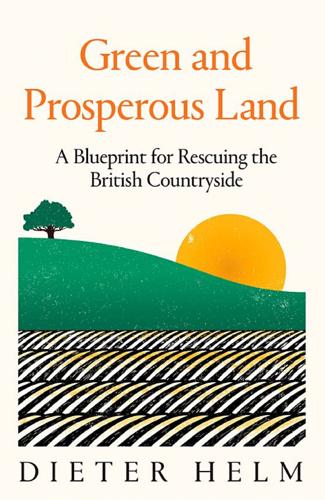
Green and Prosperous Land: A Blueprint for Rescuing the British Countryside
by
Dieter Helm
Published 7 Mar 2019
The threats to our urban environment out to 2050 are about both its size and its content. There can be little doubt there is going to be a lot more ‘urban’ in 25 years’ time. More greenfield and brownfield sites12 will be built on, new villages and towns will be built, and the built land area will absorb more and more of the Green Belt. There will be quite a lot of semi-urban sprawl for the ‘executive homes’ so beloved and profitable to the building companies. It is not inevitable that all of these developments will have less biodiversity than the land they concrete over. But concrete they will, and without strong net environmental gain compensations, the aggregate impacts are probably going to be worse.
…
The Hobhouse Report16 led to the National Parks Act in 1949. It was part of the new planning framework that emerged in the late 1940s after World War II, largely within the ambit of local authorities. Green Belts would be the lungs of the cities; the planning framework would limit ribbon development and urban sprawl; and the National Parks would protect the uplands for the wider public’s enjoyment. Britain’s land has different purposes and should be divided up accordingly. It was a highly managed model. That was the theory. In practice, landowning interests watered down the National Park plans in two ways.
…
Green infrastructure needs to be infrastructure for nature, designed with this purpose in mind, not an add-on afterwards. The outer rings – the Green Belt and what it could be The central urban areas abut the countryside, and they can do this in a variety of ways. Left to normal market forces, ribbon development and urban sprawl would result. Every builder loves a greenfield site. That is what happened in the 1930s and still happens across the USA. The problems with sprawl are not just the ugliness that John Betjeman wrote poems about.16 It is also that by stretching out the city, the access to the countryside is made much weaker for the people in the middle.
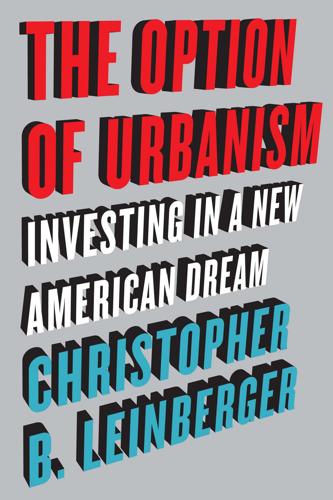
The Option of Urbanism: Investing in a New American Dream
by
Christopher B. Leinberger
Published 15 Nov 2008
Census at http://www .census.gov/prod/2005pubs/06statab/pop.pdf. 27. Our Built Environment, EPA, January, 2001, 231-R-01-002. 28. R. Ewing and R. Cervero, “Travel and the Built Environment: A Synthesis,” Transportation Research Board Record no. 1780 (2001): 87–114. 29. Howard Frumkin, Lawrence Frank, and Richard Jackson, Urban Sprawl and Public Health: Designing, Planning, and Building for Healthy Communities (Washington, D.C.: Island Press, 2004). 30. Intergovernmental Panel on Climate Change, “Climate Change 2007: The Physical Science Basis,” http://www.ipcc.ch/SPM2feb07.pdf. 31. U.S. Environmental Protection Agency, “2007 Draft U.S.
…
Lawrence Frank et al., “New Data for a New Era: A Summary of the SMARTRAQ Findings,” Smart Growth America, January 2007, http:// www.smartgrowthamerica.org/documents/SMARTRAQSummary_000 .pdf. 34. Dr. William Rees, interview by Dr. Michael Gismondi, 2000, Aurora Online, http://aurora.icaap.org/index.php/aurora/article/view/18/29. 35. Frumkin, Frank, and Jackson, Urban Sprawl and Public Health. 36. Lawrence D. Frank, Peter O. Engelke, and Thomas L. Schmid, Health and Community Design: The Impact of the Built Environment on Physical Activity (Washington, D.C.: Island Press, 2003). 37. Lawrence Frank and Barbara McCann, “Driving, Walking, and Where You Live: Links to Obesity,” http://www.choices4health.org/resource Files/82.pdf. 38.
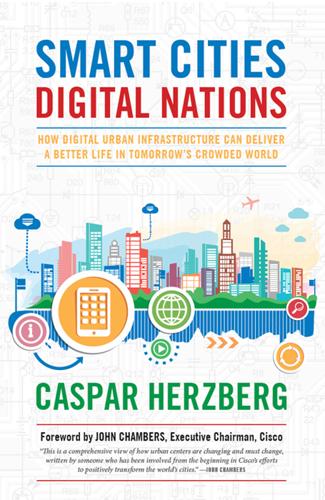
Smart Cities, Digital Nations
by
Caspar Herzberg
Published 13 Apr 2017
Other environmental engineering feats, such as the pneumatic system that literally sucked household garbage down to a subterranean processing and recycling center, storm water capture, and grey water recycling for agriculture, could deliver residual benefits such as reduced traffic noise (there are no garbage trucks) and potable water saved for drinking rather than irrigation. Plus, the city was literally green: 40 percent of the IBD was open space, and its Central Park, located almost dead center of the district, may not have been the busy travel hub that defines an aerotropolis, but to Seoul residents, it was a welcome respite from relentless urban sprawl. Additionally, 40 percent of rooftops would become green space. In all, 75 percent of Songdo’s waste was to be recycled in some shape or form—it was a city that put pedestrians and cyclists before drivers and electric and high-occupancy cars in better parking spaces than standard gas-powered transport.
…
Sensor networks could aid parking and downtown congestion (as in Barcelona). There is no denying that Chongqing wanted surveillance, and a great deal of it. Its infrastructure lacking, the municipality was working with Hangzhou-based Hikvision Digital Technology, the world’s largest supplier of video surveillance, to install and connect 500,000 cameras throughout its urban sprawl. This is many times the number of cameras employed by similarly sized cities (New York City, in 2013, doubled the number of surveillance cameras, bringing the city total to 6,000).16 In the United States, debate and indignation raged after the Wall Street Journal, working off interviews with Hikvision executives, reported that Cisco was close to finalizing a deal to help build the camera network.
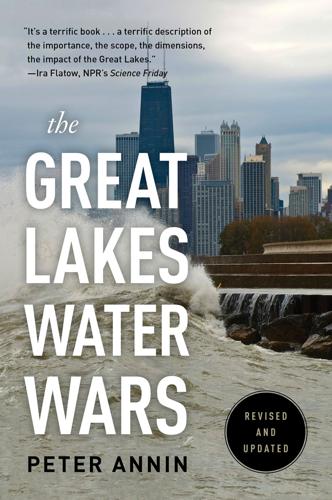
The Great Lakes Water Wars
by
Peter Annin
Published 15 Jun 2018
Every community that had diverted water from the Great Lakes since 1986 has had to return the water to the Basin—a principle that was strongly reiterated in the 2005 Compact. Advocates were particularly adamant that exceptions shouldn’t be made for sprawling suburban communities that have grown beyond their ecological means. The Great Lakes, they said, shouldn’t be used as a water subsidy for urban sprawl outside the Basin. If Waukesha residents want Great Lakes water, they should move to the water, rather than moving the water to them. The main point, environmentalists said, is that it’s time for people to think about water before they decide where to live—something that, they argued, people moving to Waukesha had failed to do.
…
Environmental advocates argued that if a community has a water problem, people shouldn’t just continue moving there and assume the government will bail them out. “We’re concerned that Waukesha is the shape of things to come,” complained Susan Howatt, national water campaigner for the Council of Canadians. “We can’t get into these situations where we make it okay for urban sprawl to [receive] water diversions that aren’t sustainable.” But under WRDA and the Great Lakes Compact, environmentalists don’t have a vote. That responsibility is reserved for the Great Lakes governors. Back in 2005, how did the governors in other parts of the Basin feel about Waukesha’s claim to a return-flow exemption?
…
They were just being included in the application so the sewer service area mirrored the water service area. Milwaukee officials remained interested in selling water to Waukesha, but they were adamantly opposed to selling water to the neighboring communities. They felt such a move violated the Compact and would contribute to urban sprawl. Milwaukee’s Common Council voted 14–0 to forbid Milwaukee to sell water to the expanded water-supply service area.9 That vote effectively took Milwaukee out of the running as a water supplier, because neither Waukesha nor the DNR would accept those limiting conditions. With its one-time water-supply front runner now out of the race, Waukesha inked a water-supply deal with Oak Creek.
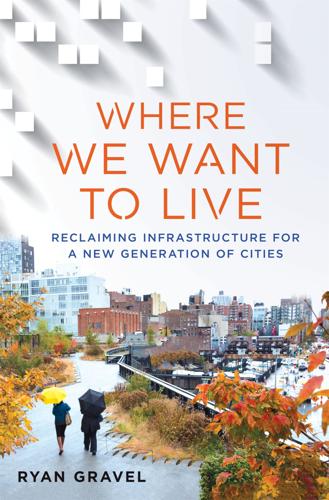
Where We Want to Live
by
Ryan Gravel
Published 2 Feb 2016
Federal Highway Administration Office of Highway Policy Information, Most Traveled Highway Sections, Table, July 27, 2010, accessed June 27, 2015, http://www.fhwa.dot.gov/policyinformation/tables/02.cfm. 3. Howard Frumkin, Lawrence Frank, and Richard Jackson, Urban Sprawl and Public Health: Designing, Planning, and Building for Healthy Communities (Washington, DC: Island Press, 2004), 146. Chapter 5: Tough Love 1. Nick Paumgarten, “There and Back Again,” The New Yorker, April 16, 2007, accessed June 26, 2015, http://www.newyorker.com/magazine/2007/04/16/there-and-back-again. 2. Howard Frumkin, Lawrence Frank, and Richard Jackson, Urban Sprawl and Public Health: Designing, Planning, and Building for Healthy Communities (Washington, DC: Island Press, 2004), 142. 3.
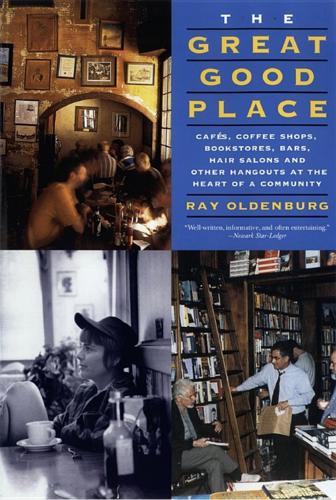
The Great Good Place: Cafes, Coffee Shops, Bookstores, Bars, Hair Salons, and Other Hangouts at the Heart of a Community
by
Ray Oldenburg
Published 17 Aug 1999
In their kind and number, there has been a marked decline in gathering places near enough to people’s homes to afford the easy access and familiar faces necessary to a vital informal public life. The course of urban development in America is pushing the individual toward that line separating proud independence from pitiable isolation, for it affords insufficient opportunity and encouragement to voluntary human contact. Daily life amid the new urban sprawl is like a grammar school without its recess periods, like incurring the aches and pains of a softball game without the fun of getting together for a few beers afterward. Both the joys of relaxing with people and the social solidarity that results from it are disappearing for want of settings that make them possible.
…
The simplicity of its requirements has made the third place a hardy perennial, capable of sprouting in a variety of forms in most urban cultures. It does not thrive universally, however. The third place is seldom found in America’s newer urban environments. Whether one looks where urban renewal has changed the older city or in the wake of the new urban sprawl, the Great Good Gathering Places are not to be found. That the third place so rarely and feebly takes root in the new “built environment” gives cause to wonder about the suitability of this habitat for healthful human habitation. We are, after all, social animals. We are an associating species whose nature is to share space just as we share experiences; few hermits are produced in any human culture.
…
Community is a collective reality that does not depend upon the inclusion or exclusion of any given individual; to define it as a personal phenomenon is to pervert the concept. The concept of the personal community is catching on, however, and for at least two reasons. First, it permits us to retain the myth of a viable community form amid the atomization of life attending our chaotic urban sprawl. Second, networking is a useful aspect of careerism—individuals, as centers and overlords of their own communities, can tailor them to maximize their success in the career. It has personal appeal. Networks, as presently conceived and promoted, are anti-child. That danger, coupled with the popularity of the concept, demand that it be examined on its own terms.

The Rent Is Too Damn High: What to Do About It, and Why It Matters More Than You Think
by
Matthew Yglesias
Published 6 Mar 2012
For the most impoverished, that often means putting up with squalid conditions in urban slums beset by high crime, bad schools, and generally substandard public services. For the middle class, and for most office and retail buildings, it simply means going someplace else. This phenomenon is the much-discussed urban sprawl. In Los Angeles, land near the coast or convenient to major employment centers is more expensive than land further inland. But restrictive zoning policies make it difficult for these desirable areas to house all of Southern California’s huge, growing population. Consequently, while the city of Los Angeles saw its population grow by just 2.6 percent between the 2000 and 2010 censuses, the surrounding L.A.
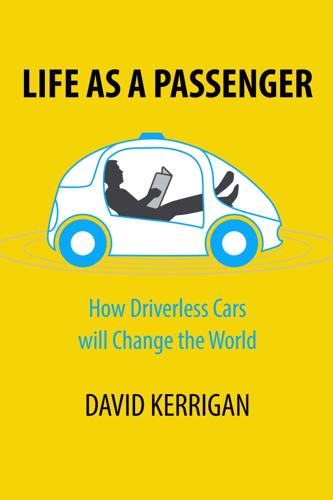
Life as a Passenger: How Driverless Cars Will Change the World
by
David Kerrigan
Published 18 Jun 2017
So far it seems that many planners are choosing to ignore developments - despite its notorious traffic congestion issues, Los Angeles’ 2015 ten-year vision, “Mobility Plan 2025”, doesn’t even mention driverless cars. Less than 3% of the transportation plans for the 50 most populous cities in the US even mention the transit impacts of ride-sharing services Uber and Lyft, let alone driverless cars. Expert opinion on the impact of driverless cars on urban sprawl is divided. On one side, the argument goes that if driverless cars free up parking and garage space, there will be plentiful affordable new residential capacity negating the need for people to move further from city centres for affordable housing. On the other side, the argument goes that if people can be otherwise occupied during even a long commute, they will still be willing to move further from the city centre or their place of employment to have the residence they wish, perhaps with larger gardens than typical closer to the city.
…
reload=true&tp=&arnumber=5409622&url=http:%2F%2Fieeexplore.ieee.org%2Fiel5%2F4149681%2F5409610%2F05409622.pdf%3Farnumber%3D5409622 [38] http://360.here.com/2014/04/30/jams-game-theory-equations-science-of-traffic/ [39] http://engineering.illinois.edu/news/article/21938 [40] http://en.wikipedia.org/wiki/Braess%27s_paradox [41] http://chester.faculty.asu.edu/library/access39_parking.pdf [42] http://www.transportationlca.org/losangelesparking/ [43] Rethinking a Lot (2012), Eran Ben-Joseph [44] http://shoup.bol.ucla.edu/CruisingForParkingAccess.pdf [45] http://www.telegraph.co.uk/motoring/news/10082461/Motorists-spend-106-days-looking-for-parking-spots.html [46] http://www.telegraph.co.uk/cars/news/london-parking-space-goes-on-sale-for-350000/ [47] http://www.nytimes.com/2007/07/12/us/12parking.html [48] Edge City: Life on the New Frontier, Joel Garreau, 2011 [49] http://www.economist.com/news/briefing/21720269-dont-let-people-park-free-how-not-create-traffic-jams-pollution-and-urban-sprawl [50] https://www.whitehouse.gov/sites/whitehouse.gov/files/images/Housing_Development_Toolkit%20f.2.pdf [51] Bending the Cost Curve – Solutions to Expand the Supply of Affordable Rentals.” Urban Land Institute Terwilliger Center for Housing: 19. 2014 [52] https://twitter.com/NelsonNygaard/status/684042745216798720 [53] http://www.uspirg.org/news/usp/new-report-shows-mounting-evidence-millennials%E2%80%99-shift-away-driving [54] https://www.jtlu.org/index.php/jtlu/article/view/751 [55] http://www.cnet.com/uk/news/a-future-of-self-driving-cars-were-ready-now/ [56] http://www.bbc.com/news/business-35242514 [57] https://www.gov.uk/government/statistics/national-travel-survey-2014 [58] http://www.people-press.org/2014/06/12/political-polarization-in-the-american-public/ [59] http://www.morganstanley.com/ideas/car-of-future-is-autonomous-electric-shared-mobility [60] https://en.wikipedia.org/wiki/Peak_car [61] https://www.gov.uk/government/uploads/system/uploads/attachment_data/file/411471/road-traffic-forecasts-2015.pdf [62] https://en.wikipedia.org/wiki/Marchetti%27s_constant [63] https://www.washingtonpost.com/news/in-theory/wp/2016/02/29/are-americans-leaving-cars-behind/ [64] Door to Door: The Magnificent, Maddening, Mysterious World of Transportation, Edward Humes, 2016 [65] http://la.curbed.com/2016/9/9/12824240/self-driving-cars-plan-los-angeles [66] http://sustainablemobility.ei.columbia.edu/files/2012/12/Transforming-Personal-Mobility-Jan-27-20132.pdf [67] https://en.wikipedia.org/wiki/Sinclair_C5 [68] http://www.segway.com/ [69] https://www.wired.com/2016/10/teslas-self-driving-car-plan-seems-insane-just-might-work/ [70] Alphabet is Google’s parent company and owner of Waymo, formerly known as Google Self Driving Car project
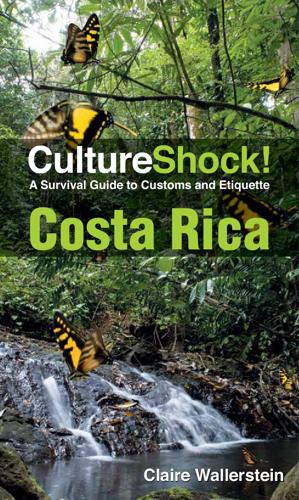
Culture Shock! Costa Rica 30th Anniversary Edition
by
Claire Wallerstein
Published 1 Mar 2011
The remaining natural forest is deciduous, the trees losing their leaves in the unbearable summer heat. Cattle on the Guanacaste plains—the archetypal scene of the north. Overview of the Land and History 39 In between the two extremes lies the Meseta Central, the central highland plateau which is now home to well over half the country’s population in the urban sprawl of San José and its surrounding towns. This is the traditional coffee-growing area, and the climate is mild thanks to the altitude—San José stands 1,150 m (3,773 ft) above sea level—and temperatures rarely exceed 25°C (77°F). Both coasts are hot, and are home to steamy banana and African palm plantations (excluding the Guanacaste part of the Pacific coast).
…
The population is very young, with 26.7 per cent of Ticos under the age of 14, and only 6.2 per cent over 65. Ticos have also become, in recent decades, a very urban people (even though they retain many rural habits). Around half of the population lives in the greater San José area alone, and more than two-thirds in the urban sprawl of the Meseta Central. ‘White Ticos’ and Ideas of Colour It has only been a few decades since Costa Rican tourist literature trumpeted the ‘whiteness’ of the people as an attraction. In his 1943 Nueva Geografía de Costa Rica, author Jorge León said the country was ‘effectively the white state of the Caribbean... in Heredia, 96.6 per cent of the population are direct descendants from Europe—a little more than in New York’.

Supertall: How the World's Tallest Buildings Are Reshaping Our Cities and Our Lives
by
Stefan Al
Published 11 Apr 2022
However, while social connectivity is good for exchanging ideas and making financial transactions, it also speeds up more dubious activities and virus transmissions. When the pandemic and social distancing called into question dense urban life, skyscrapers took on a new meaning. While compact cities may have contributed to the rapid spread of the COVID-19 pandemic, its opposite, urban sprawl, may have been a cause. Zoonotic diseases, which spring from animals to humans, are a result of our increasing wildlife-human interface. They are partially a consequence of the destruction of nature through deforestation and unbridled suburbanization. If we can limit our human footprint by creating compact cities, we may be able to better protect our forests and wildlife.
…
Even our greenest cities waste energy on shipping food from thousands of miles away. We can minimize these “food miles” by incorporating agriculture into our buildings. This way, cities can be agriculturally productive instead of being consuming islands relying on a vast periphery of greenhouses and watersheds. Urban sprawl erases more farmland every year—we are losing an area as large as Denmark annually, with much of it in Asia.42 Already, restaurateurs and homeowners are pruning herbs, greens, and small fruits on the sides of buildings. Vertical gardens may even be coming to your high-rise apartment soon. Next time you need a clump of basil, you may be able to extend your hand from your apartment window, and pick from trellises or revolving trays.
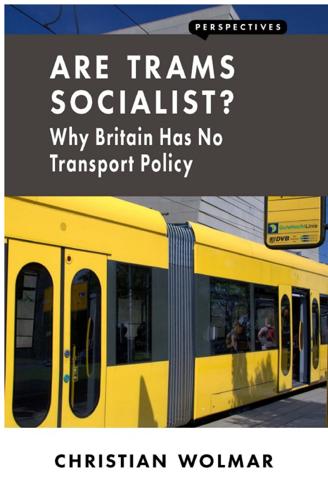
Are Trams Socialist?: Why Britain Has No Transport Policy
by
Christian Wolmar
Published 19 May 2016
The fundamental error of transport policy based on the spread of the automobile is precisely that it was designed to increase mobility rather than accessibility, and it resulted in planning policies that then actually reduced accessibility for many people. The negative aspects of decades of car-based policy, such as the crowding out of other road users and the encouragement of urban sprawl, which, in turn, entrenched the car’s primacy, were all too easily ignored. The car provided fantastic extra mobility for those who could afford to own one, but by destroying alternatives the options available to those who did not were greatly restricted. And, even more ironically, as cars increased in number, their advantages began to be outweighed by their disadvantages.
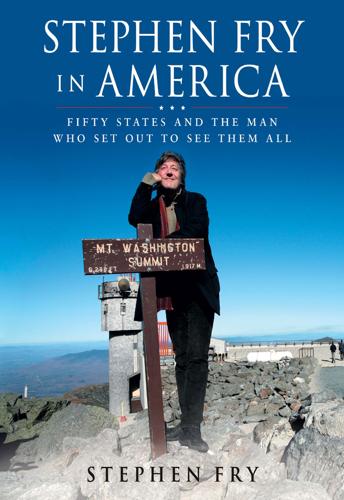
Stephen Fry in America
by
Stephen Fry
Published 1 Jan 2008
It’s deep in the American psyche isn’t it? Man and nature. The great paradox of a nation that invades and degrades the wilderness and yet treasures it above all else.’ ‘Guess so.’ ‘New York State contains this, the great outdoors, the American dream of the woods and wilderness but also the industry, the suburbs, the great urban sprawl and of course Manhattan. Maybe New York State is symbolic of all America, embodying both the call of the wild and the call of the street.’ ‘Maybe.’ ‘You’re right. I’m talking drivel. I’ll shut up now.’ I am happy to say that no deer were killed in the making of our scene. In fact we didn’t even see a deer, which suited me.
…
It is clear that her apprehension of what spooks, stresses and alarms an animal is extremely accurate: I wonder however if someone will come close one day to understanding what thrills, delights and pleases an animal? Do they respond to beauty in nature, for example? Can they detect, appreciate and value the difference between a dull urban sprawl and a mighty mountain landscape? * * * COLORADO KEY FACTS Abbreviation: CO Nickname: The Centennial State Capital: Denver Flower: Rocky Mountain columbine Tree: Colorado blue spruce Bird: Lark bunting Mineral: Rhodochrosite Motto: Nil Sine Numine (‘Nothing Without Providence’) Well-known residents and natives: John Kerry, Horace ‘Go West Young Man’ Greeley, James Michener, Allen Ginsberg, Clive Cussler, Antoinette ‘Tony Award’ Perry, Ken Kesey, Douglas Fairbanks, Lon Chaney, Bill Murray, Roseanne Barr, Tim Allen, Don Cheadle, Trey Parker, Matt Stone, Paul Whiteman, Glenn Miller, John Denver

I, Warbot: The Dawn of Artificially Intelligent Conflict
by
Kenneth Payne
Published 16 Jun 2021
DARPA and the CIA were originally motivated to fund AI precisely because of the promise it held for detecting enemy signatures—the tank hiding in woodland, the coded radio message passed between commanders. It’s ever harder to hide from modern AI, with its increasingly sophisticated sensors and real-time analysis. Cluttered environments, like densely populated urban sprawl will continue to offer some advantage to the defenders seeking cover-from-view. But a look at state-of-the-art surveillance in China demonstrates the changing intelligence landscape. A range of AI-enabled technologies, including biometrics and facial recognition, allows watchers to cut through the clutter.
…
Later, the analysts can spool footage backwards from the crime scene to follow the perpetrator back to their home, or their associates. Or they can spool forward to see where they go next. This technology, now used by city police forces in America, was originally designed for the military, seeking out insurgents in the urban sprawl of Baghdad. The next step, already underway, involves automating that process. Doing so would help overcome some big bottlenecks in tasking and analysis. With rapidly expanding fleets of drones, the American Air Force, and its ally the UK’s Royal Air Force, are struggling to recruit enough operators.5 The work is an unusual combination of tedium and stress.

Istanbul Travel Guide
by
Lonely Planet
The building was originally known as the Church of the Holy Saviour Outside the Walls (Chora literally means 'country' and Kariye is the Turkish version of the ancient Greek word Khora, which means the same thing), reflecting the fact that when it was first built it was located outside the original city walls built by Constantine the Great. Within a century the church and the monastery complex in which it was located were engulfed by Byzantine urban sprawl and enclosed within a new set of walls built by Emperor Theodosius II. Around AD 500, the Emperor Anastasius and his court moved from the Great Palace of Byzantium in Sultanahmet to the Palace of Blachernae, a new complex built close to the point where Theodosius' land walls met the old sea walls on the Golden Horn.
…
İstanbul Today As the 21st century gets into gear, this meeting point of Europe and Asia is revelling in the unprecedented growth and prosperity it has achieved over the past decade. It's also getting larger – the official population is 14 million, but most locals think that 20 million is a more accurate estimate, leading to huge problems with urban sprawl and inadequate infrastructure. Best in Music Mercan Dede A major name on the international World Music scene, Dede's distinctive Sufi-electronic techno-fusion is showcased in his albums Sufi Dreams (1996), Journeys of a Dervish (1999), Sayahatname (2001), Nar (Fire; 2002), Sufi Traveller (2003), Su (Water; 2004), Nefes (Breath; 2006), 800 (2007) and Dünya (Earth; 2013).
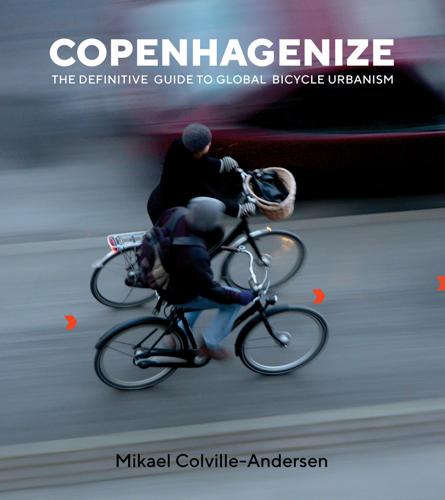
Copenhagenize: The Definitive Guide to Global Bicycle Urbanism
by
Mikael Colville-Andersen
Published 28 Mar 2018
It’s important to connect public transport with bicycles, whether it is combining bikes and trains or providing safe infrastructure to and from stations outside of city centers. In Copenhagen, roughly 50 percent of the bicycle infrastructure had been removed in the two decades of redesigning the streets for cars. Copenhagen has sprawl. The third-largest urban sprawl in Europe, actually. People can commute for a hour and a half or more by car to get to the city, as in many other places. Intermodality is the key. Riding your bicycle to the local train station and combining travel modes helps increase bicycle share. The main point here is that few people are going to ride long distances.
…
In Denmark, Danish State Railways (DSB) has been transporting passengers with bikes almost since the bicycle was invented. Greater Copenhagen is served by the S-Train network—S-tog in Danish—and for many years passengers had to buy a reasonably priced bike ticket. In 2010, DSB decided to make bikes free on all their red S-Trains that transport people to and from the city from the far reaches of our urban sprawl. It was a bold move, but far from being an example of corporate social responsibility, it was simply a clever business model. They assumed correctly and rationally that bikes don’t travel alone, so by making it free, there were good odds of increasing the number of paying passengers. Boy, did they nail it.
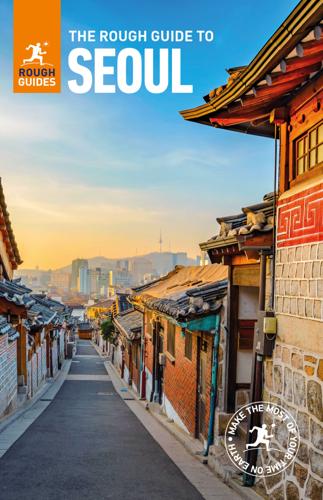
The Rough Guide to Seoul
by
Rough Guides
Published 26 Sep 2018
< Back to Myeongdong and Dongdaemun Shutterstock Bukhansan National Park Northern Seoul North of Gyeongbokgung, Seoul appears to come to a rather abrupt end, with lofty mountains rearing up immediately behind the palace. The city did, indeed, once peter out here, but the “Economic Miracle” of the 1970s saw its population mushroom, and consequently Seoul’s urban sprawl pushed around the mountainsides. Development was, however, not as rampant as in other parts of the city, and Seoul’s northern quarters maintain a relatively secluded air, with some excellent walking paths stringing together many of the district’s temples, cafés, mountainsides and other sights.
…
Around the ferry berth are a few shops, restaurants and guesthouses, while a bus meets the ferries and makes its way round to Seopori Beach (서포리 해수욕장) on the other, quieter, side of the island – also home to a few guesthouses. Suwon and around 수원 Heading south from Seoul by train, the capital’s dense urban sprawl barely thins before you arrive in SUWON, a million-strong city with an impressive history of its own, best embodied by the gigantic fortress at its centre. Suwon, in fact, came close to usurping Seoul as Korea’s seat of power following the murder of prince Sado, but though it failed to overtake the capital, the city grew in importance in a way that remains visible to this day.
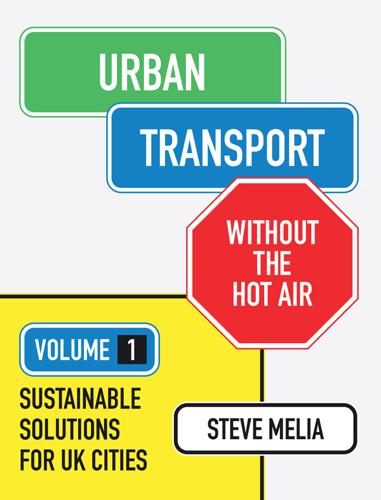
Urban Transport Without the Hot Air, Volume 1
by
Steve Melia
Although some riverside residents complain of late-night revellers and young people on skateboards, even they would not want to go back to a car park along the banks.296 Figure 12.33 Banks of the Rhône in Lyon Figure 12.34 A municipal poster reminds voters how it used to be National planning policy in France has, for many years, sought to rein in urban sprawl. Complex layers of regional and city-region authorities have been set up and charged with powers to put these national policies (which most of them agree with) into practice. But although French cities have succeeded in regenerating and intensifying their city centres, sprawl in the surrounding areas has continued unabated.
…
On: lyon.citycrunch.fr 297 D’Huissel, Sylvain (2013) ‘Étalement urbain: le SNAL veut lutter contre les idées recues’. 19 March. On: www.lyonpoleimmo.com In this article, the regional developers’ association presents a report claiming that new detached houses are not contributing (very much) to urban sprawl around Lyon, and attempts to restrain them are hitting the middle classes with higher house prices. 298 Axel, Gilbert (2011) ‘Unités urbaines 2010 : accélération de l’étalement urbain’. Insee Rhône-Alpes - La Lettre Résultats. 147. June. On: www.insee.fr/rhone-alpes 299 483 per 1000 people in 2006 according to: epp.eurostat.ec.europa.eu 300 Sytral (2007) ‘Enquête ménages déplacements’.
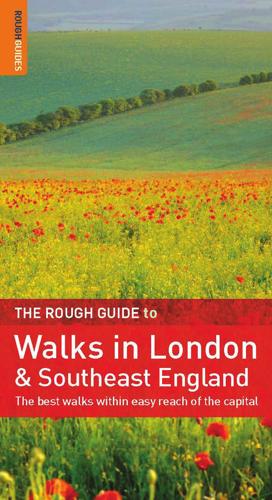
The rough guide to walks in London and southeast England
by
Helena Smith
and
Judith Bamber
Published 29 Dec 2008
Originally a royal hunting ground, Epping Forest was opened to the public in 1878, since when it has been managed by the Corporation of London. Covering some six thousand acres, the forest is London’s largest public open space, and its sheer scale comes as a surprise to the first-time visitor, not least because of its proximity to the urban sprawl. It remains a popular spot, and at any time of year you can expect to share the forest with plenty of horse-riders and cyclists, as well as many fellow walkers. This circular walk heads from Chingford station up to Queen Elizabeth’s Hunting Lodge before heading north into the heart of the forest.
…
This route starts from Goring-by-Sea, at the far edge of the sprawling seaside town of Worthing, west of Brighton. It runs via a small hillfort and the village of Clapham, through woodland to attractive Findon, where the Gun Inn is a reliable pub lunch stop. From here you climb up to Cissbury Ring, a vast hillfort with sweeping sea views. The path then descends to Worthing, with some urban sprawl to get through before you reach the station. The route doesn’t give you the feeling of unspoilt isolation common to the other South Downs walks in this chapter – aside from Cissbury Ring the downland here has been cultivated and its long contours divided into strips of field. But there are plenty of attractions: the thirteenth-century church at Clapham; the venerable boozer with its World War II associations; and the majesty of Cissbury Ring itself.
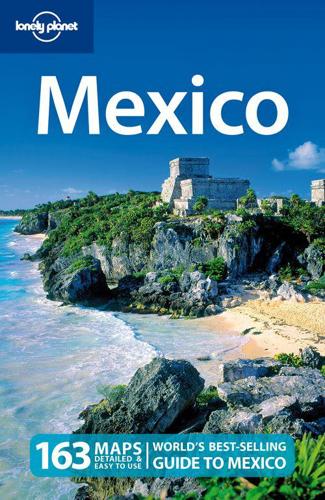
Lonely Planet Mexico
by
John Noble
,
Kate Armstrong
,
Greg Benchwick
,
Nate Cavalieri
,
Gregor Clark
,
John Hecht
,
Beth Kohn
,
Emily Matchar
,
Freda Moon
and
Ellee Thalheimer
Published 2 Jan 1992
And the Chilangos, or defeños, or capitalinos, or whatever you name the locals, are a remarkably patient and helpful bunch. Yet it’s impossible to overlook the city’s very real problems. Kidnappings and taxi holdups, often dangerous levels of ozone and airborne particulates, intolerable traffic jams, overcrowded public transportation, practically unlimited urban sprawl: name your poison, it’s here. But the polluted air improved considerably after the introduction of strict emission controls, and downtown streets have been made unquestionably safer than in previous decades. Remember that Mexico City is, and has ever been, the sun in the Mexican solar system.
…
Several on-campus routes also operate outside metro Universidad with limited service on weekends and during vacation periods. Coyoacán Coyoacán (‘Place of Coyotes’ in the Náhuatl language), 10km south of downtown, was Cortés’ base after the fall of Tenochtitlán. Only in recent decades has urban sprawl overtaken the outlying village. Coyoacán retains its restful identity, with narrow colonial-era streets, cafés and a lively atmosphere. Once home to Leon Trotsky and Frida Kahlo (whose houses are now fascinating museums), it has a decidedly countercultural vibe, most evident on weekends, when assorted musicians, mimes and crafts markets draw large but relaxed crowds to Coyoacán’s central plazas.
…
Radio Maxi Seguridad ( 5768-8557, 5552-1376) Sitio Parque México ( 5286-7129, 5286-7164) Taxi-Mex ( 9171-8888, 5634-9912) Taxis Radio Unión ( 5514-8124) Return to beginning of chapter Around Mexico City * * * NORTH OF MEXICO CITY TEPOTZOTLÁN TULA TEOTIHUACÁN PACHUCA AROUND PACHUCA EAST OF MEXICO CITY PUEBLA CHOLULA POPOCATÉPETL & IZTACCÍHUATL TLAXCALA CACAXTLA & XOCHITÉCATL LA MALINCHE HUAMANTLA CANTONA CUETZALAN YOHUALICHÁN TEHUACÁN RESERVA DE LA BIOSFERA DE TEHUACÁN-CUICATLÁN SOUTH OF MEXICO CITY TEPOZTLÁN CUERNAVACA XOCHICALCO TAXCO PARQUE NACIONAL GRUTAS DE CACAHUAMILPA WEST OF MEXICO CITY TOLUCA NEVADO DE TOLUCA MALINALCO IXTAPAN DE LA SAL * * * With its daunting size and seemingly endless urban sprawl, the megalopolis of Mexico City may seem a challenging place to escape from, yet thousands of Chilangos (Mexico City residents) do so every weekend. Fast toll roads fan out in all directions to the cities, towns and the so-called pueblos mágicos (magical villages) that surround the Distrito Federal, taking you surprisingly easily into a world of ancient ruins, well-preserved colonial towns and beautiful mountain scenery.

The Trouble With Brunch: Work, Class and the Pursuit of Leisure
by
Shawn Micallef
Published 10 Jun 2014
In 2010, the Canadian Index of Wellbeing at the University of Waterloo released a report called ‘Caught in the Time Crunch: Time Use, Leisure and Culture in Canada.’ Its findings were not surprising. For one thing, it reported that Canadians ‘perceive and spend time much differently than they once did,’ and that leisure and cultural activities were changing as a result. Urban sprawl and longer commutes had shrunk free time while laptops and smartphones created a workforce that was perpetually on call. Longer working hours, providing care to an aging population and working non-standard shifts have also devoured more time and reduced leisure. Further, time constraints were worse for people ‘marginalized by race, ethnicity, religion, socioeconomic status, dis/ability, gender, sexual orientation and language proficiency, [and who] experience systemic barriers to social and economic opportunity.’
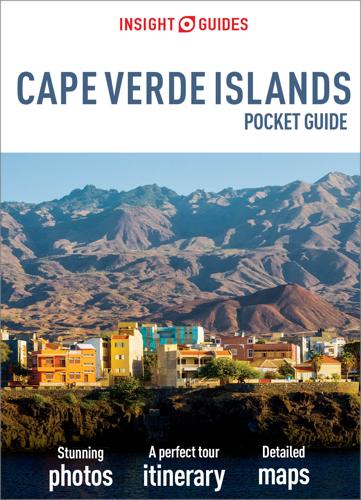
Insight Guides Pocket Cape Verde
by
Insight Guides
Published 1 May 2018
Since they’re not usually planning to live here permanently until they retire, they’re in no hurry to finish the construction, let alone render and paint the walls. Paradoxically, however, Cape Verdeans are keen decorators. Once their houses are finally complete, they often top them off with a jaunty paint job in contrasting shades of yellow, blue, pink and green. Almost a half of the population of Santiago live in the urban sprawl of Praia, the capital, which hugs the island’s southernmost bay. Outside the city, there’s a remarkable variety of scenery, from sandy beaches to hidden villages and craggy mountainsides draped in lush greenery. Praia, Cape Verde’s capital city Emma Gregg/Apa Publications Praia While the city of Praia ( [map] doesn’t have enough conventional sights to detain visitors for more than a day or two, it is a purposeful city which offers an interesting snapshot of a side of Cape Verde that many tourists miss.
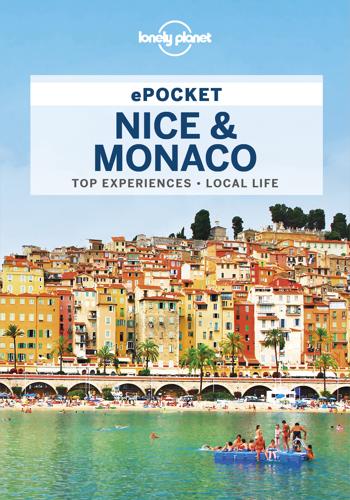
Lonely Planet Pocket Nice and Monaco 3 3rd Ed
by
Lonely Planet
Published 15 Apr 2024
3Jardin Albert 1er Steps from the beach, this centrally located green space is one of Nice’s favourite places to celebrate, especially in July – when the Nice Jazz Festival ushers in six days of nonstop live music on two stages – and December, when the whole park is immersed in family-friendly activities such as Ferris wheel rides, ice skating and visits with Père Noël (Father Christmas). 4Promenade du Paillon Once, the Paillon River ran through Nice, but it was slowly covered over by urban sprawl, including an eyesore of a bus station and parking lot. In 2013 the city replaced the concrete with this beautiful kilometre-long park, where kids now go wild playing in water jets and clambering on whimsical octopus and whale play structures. 5Théâtre National de Nice A community theatre in the best sense of the word, TNN makes the performing arts accessible to all.
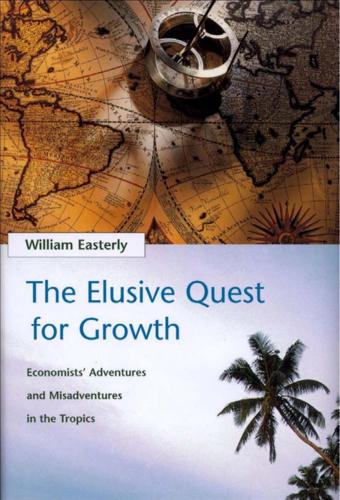
The Elusive Quest for Growth: Economists' Adventures and Misadventures in the Tropics
by
William R. Easterly
Published 1 Aug 2002
And because growth involves losers as well as winners, it’s easy to see why there has always been a vocal antigrowth faction, even aside from the concern for the environment. On the web is a site for the Preservation Institute, a group that calls for ”the end of economic growth.”18 1999 study warns, ”Urban sprawl is undermining America’s environment, economy, and social fabric.”19 The historian Paul Kennedy notes that economic change ”like wars and sporting tournaments” is ”usually not beneficial to all.” Progress benefits some ”just as it damages others.”20Browsing the library, I find titles like Sustainable Development Is Possible Only If We Forgo Growth,EconomicGrowthandDecliningSocialWelfare, DevelopedtoDeath,ThePoverty of Afluence,TheCosts of Economic Growth, andthemorerestrained GrowthIllusion:HowEconomic Growth Has Enriched the Few, Impoverished the Many, and Endangered the Planet?
…
Journal of Political Economy 98, no. 5 (October): S12-37. Bell-Fialkoff, Andrew. 1996. Ethnic Cleansing. New York St. Martin’s Press. Belser, Patrick. 2000. “Vietnam: On the Road to Labor-intensive Growth.” World Bank Policy Research Paper 2389. July. Benfield, F.Kaid, Matthew D. Raimi, and Donald D. T.Chen. 1999. Once There Were Greenfields: How Urban Sprawl Is UnderminingAmericas’sEnvironment,Economy,and Social Fabric. New York: Natural Resources Defense Council. 315 References and Further Reading Benhabib, Jess, and Mark Spiegel. 1994. ”Role of Human Capital in Economic Development: Evidence from Aggregate Cross-country Data.” Journal of Monetary Economics 34 (October): 143-173.
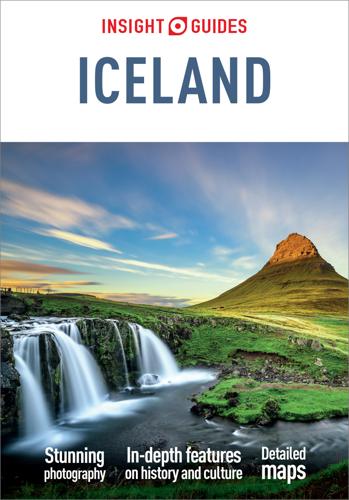
Insight Guides Iceland
by
Insight Guides
Published 6 Dec 2024
Shutterstock Hub of the east Whether arriving by ferry, car or bus, travellers use as an orientation point the East’s most important urban crossroad, Egilsstaðir 1 [map] (population 2,522). The town grew very quickly in the 2000s when it serviced construction workers on Kárahnjúkar dam and Reyðarfjörður aluminium smelter, and consequently is something of an urban sprawl. However, it makes a convenient base for half-day or day trips around Lake Lögurinn or over the mountains to pretty Seyðisfjörður. In town, the East Iceland Heritage Museum (Laufskógar 1; www.minjasafn.is) is worth a visit, with interesting information about daily life on the isolated highland farms, and on the herds of wild reindeer that roam the eastern hills.
…
Iceland is a popular destination for cruise ships, which call into ports at Akureyri, Heimaey, Ísafjörður, Reykjavík and Seydisfjörður, depending on the cruise company and cruising schedule. Getting Around Navigating your way around Iceland is a fairly straightforward affair. Only one major road – Route 1 – encircles the country, so once you’ve escaped Reykjavík and its associated urban sprawl, it’s quite hard to get lost. Since much of the country is uninhabited, public transport outside Reykjavík is relatively sparse. The country has no railways, so long-distance travel is all by (comfortable) buses that do run regularly and reliably, but perhaps not as often as one might wish. Car hire is relatively expensive – four-wheel drive is even more costly but a necessity for highland routes.

Lonely Planet Colombia (Travel Guide)
by
Lonely Planet
,
Alex Egerton
,
Tom Masters
and
Kevin Raub
Published 30 Jun 2015
Much like the carnival in Rio de Janeiro, there are street bands, masquerade and fancy dress, live performances, and a riotous, slightly unhinged atmosphere as the town drinks and dances itself into the ground. It can be rough and ready, and you need to keep an eye on your possessions and your companions, but let your hair down and it could be a highlight of your trip. Barranquilla is a huge urban sprawl, with its fair share of unsafe barrios. Most of the cheap accommodations can be found around Paseo Bolívar (Calle 34), but this area is seedy – just check the number of army personnel present even during the day. If you'd like to stay in a more pleasant environment, try El Prado. However, if you're coming for carnaval, be sure to secure your hotel reservations months in advance, or you'll have no chance at all.
…
At any other time of the year, you'll likely only visit the bus station on your way to much more agreeable Santa Marta or Minca, and your experience of Barranquilla will simply be of its bad traffic. Santa Marta %5 / Pop 448,000 / Elev 2m Santa Marta is South America's oldest surviving city and the second most important colonial city on Colombia's Caribbean coast. But despite its long history and charming center, it gets a bad rap from many travelers, who rightly cite its unsightly urban sprawl and terrible traffic as reasons not to hang about here. The secret to Santa Marta is to use it for what it does well: hotels, restaurants and bars, and then get out to the slew of superb destinations nearby during the daytime. It's as a base that Santa Marta excels: come here for a destination in itself and you can easily be disappointed.
…
Finca Barlovento features open-air beds that jut out on a deck over the sea, so the waves crash right under your mattress. The food is simply sensational. Palomino %5 / Pop 4000 Palomino doesn't look like much as you pass through it on the main Santa Marta–Riohacha highway, but lurking on one side of its urban sprawl is one of Colombia's most perfect beaches, while on the other are the dramatic Sierra Nevada Mountains, a place the Wayuu people still guard carefully from outsiders. Palomino makes a great base from which to explore both, with a number of great places to stay and a backpacker vibe you'll not find in many other places along the coast.
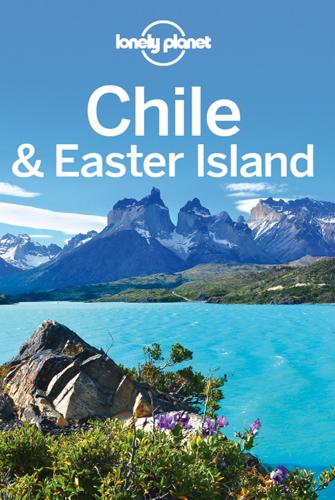
Lonely Planet Chile & Easter Island (Travel Guide)
by
Lonely Planet
,
Carolyn McCarthy
and
Kevin Raub
Published 19 Oct 2015
Aquitania is 150m south. Note that Viña Cousiño Macul is located only 2km away. Viña Cousiño Macul WINERY ( 351-4135; www.cousinomacul.cl; Av Quilín 7100, Peñalolén; tours incl 1 varietal & 1 reserva CH$8000; tours 11am, noon, 3pm & 4pm Mon-Fri in English, 11am & noon Sat; Quilín) A pretty winery set in Santiago’s urban sprawl. Most of the vineyards are now at Buin, but tours take in the production process and underground bodega, built in 1872. It’s a 2.25km walk or a quick taxi ride from the metro. Viña Almaviva WINERY ( 470-0225; www.almavivawinery.com; Av Santa Rosa 821, Paradero 45, Puente Alto; tours incl 1 pour US$80; by appointment only 9am-5pm Mon-Fri) This boutique vineyard runs in partnership with Baron Philippe de Rothschild.
…
Chileans consider Concepción a socialist hotbed – mainly because of the intellectual influences of its dozen or so universities. Concepción sits on the north bank of the Río Biobío, Chile’s only significant navigable waterway, about 10km from the river’s mouth. Hills block the city’s expansion to the south and east, so Concepción’s urban sprawl is moving rapidly in the opposite direction, toward Talcahuano, 15km to the northwest. History In 1551 Pedro de Valdivia founded the original city of Concepción north of where it is today, near Penco (indeed, Conce’s inhabitants are still known as Penquistas). Over the next few centuries the city was repeatedly besieged during the Spanish-Mapuche war, attacked by British and Dutch pirates and devastated by earthquakes in 1730 and 1751.
…
Punta Arenas 061 / POP 130,136 A sprawling metropolis on the edge of the Strait of Magellan, Punta Arenas defies easy definition. It’s a strange combination of the ruddy and the grand, witnessed in the elaborate wool-boom mansions and port renovations contrasted with windblown streams of litter and urban sprawl. Set at the bottom of the Americas, it is downright stingy with good weather – the sun shines through sidelong rain. Magellanic hospitality still pervades local culture, undeterred (or perhaps nurtured by) nature’s inhospitality. The city is remarkably relaxed and friendly. Recent prosperity, fed by a petrochemical industry boom and growing population, has sanded down the city’s former roughneck reputation.
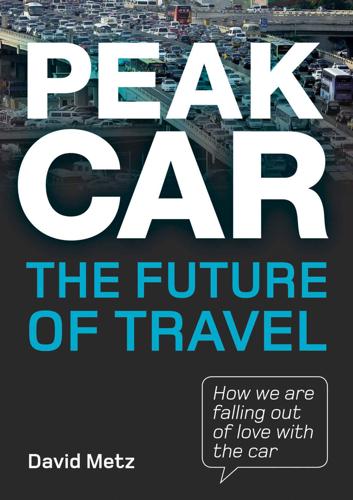
Peak Car: The Future of Travel
by
David Metz
Published 21 Jan 2014
Given that both travel generally and car use per person are no longer increasing, what now drives the growth of total travel are demographic factors—population growth, urbanisation and increasing longevity. Planning policy There has been much debate amongst planners and policy makers about the merits of city versus suburban living. In Britain, a general concern to protect the countryside has led to the adoption of ‘green belts’ around many cities—areas of countryside where urban sprawl will be resisted. One result has been the movement of people, housing and employment into towns and villages beyond the green belts. This in turn has prompted calls for an urban renaissance, aimed at both protecting the countryside from house building on greenfield sites and preserving the vitality of the central core of cities.
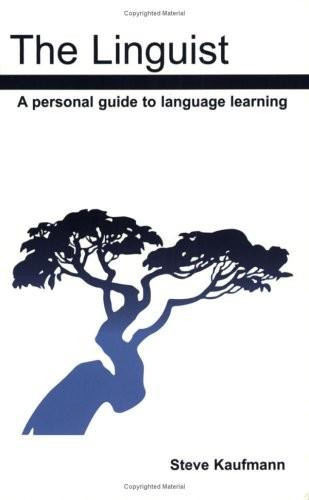
The Linguist: A Personal Guide to Language Learning
by
Steve Kaufmann
Published 15 Jan 2003
From the waiting room of the train station I could just make out the rows of low traditional peasant houses behind the posters with 46 A Personal Guide to Language Learning slogans exhorting the people to greater revolutionary efforts. Today, this quiet village has become one of the largest cities in China, a vast urban sprawl of modern skyscrapers and thriving capitalism, and a leader in high tech, fashion and more. As a foreigner, I was automatically seated in the soft seat section on the train to Canton (today’s Guangzhou). This entitled me to a cup of flower tea, which was regularly refreshed with more hot water by an attendant as the train rode through Southern Guangdong Province with its hills of red earth and green rice fields.

City on the Verge
by
Mark Pendergrast
Published 5 May 2017
“We drive up and down the gruesome, tragic suburban boulevards of commerce, and we’re overwhelmed at the fantastic, awesome, stupefying ugliness of absolutely everything in sight… as though the whole thing had been designed by some diabolical force bent on making human beings miserable.” Atlanta is an extreme case in point. Just a few years after Kunstler wrote, Time magazine featured it as the classic exemplar of American urban sprawl: “Once wilderness, [metro Atlanta is] now a 13-county eruption, one that has been called the fastest-spreading human settlement in history. What it leaves behind is tract houses, access roads, strip malls, off ramps, industrial parks and billboards advertising more tract houses where the peach trees used to be.”
…
.* Today, Grant Park has turned back into a safe, desirable community, as I discovered when I stayed overnight with Sarah Toton and Micah Wedemeyer in their classic three-bedroom bungalow, built in 1907, with hardwood floors, high ceilings, and a huge oak in the backyard on Park Avenue, adjacent to the park’s northeastern section. They bought it for $363,000 in 2013, which seemed a bargain to me. The young Iowa couple came reluctantly to Atlanta for Toton to attend grad school at Emory University in 2003. “I never wanted to move to Atlanta. I heard it was a cancer on America with its urban sprawl.” Now they love it. In Grant Park there are frequent festivals, bike and running races, and other events, and they are close to everything, including the BeltLine Eastside Trail, where Wedemeyer, a computer programmer, rides his bike. It’s a great place to live, with the park and zoo (the Cyclorama is moving to Buckhead to the Atlanta History Center), the Grant Park Coffeehouse, and many nearby restaurants.

Cities Are Good for You: The Genius of the Metropolis
by
Leo Hollis
Published 31 Mar 2013
In 2008 Clean Up The World started to use it to highlight places of particular crisis as well as show the impact of the International Clean Up Weekend. It is also being used to track the loss of the Antarctica ice cap, the depletion of the rainforest in Amazonia, measuring the largest oil spills in the world’s oceans13 as well as the extent of urban sprawl in cities like Houston and Phoenix. Google Earth is already having an unexpected impact on urbanism. In Dubai, islands are being designed to be seen from the air. Palm Jumeirah is a man-made island that spans out into the Gulf in the shape of a palm leaf that can be seen by satellite or aeroplane.
…
I have followed a well-worn rite of passage that comes to many comfortably secure people living in the city in the western world at the beginning of the twenty-first century. We have moved to what many people call the ‘inner suburbs’ of London, the ring of development that encircled the city during the first decades of the twentieth century. Here, we are no longer within easy distance of the centre, but looking down our perfectly regular street northwards I see urban sprawl all the way to the horizon. Our house was built in 1907 when pasture was turned over to tarmacadam and respectable housing, built with a hint of Elizabethan historicism, aimed at middle-ranking professionals who could get into St Pancras Station within fifteen minutes on the commuter train. Home in north London When we bought it, the house had been kept in its original state, but like many others in the street we have adapted it to our modern tastes.

American Foundations: An Investigative History
by
Mark Dowie
Published 3 Oct 2009
In fact, the largest single environmental grant made since Rockefeller family money created national parks in the Tetons, Maine, and the Virgin Islands was a David and Lucille Packard Foundation pledge of $175 million to protect California's rapidly shrinking open space from development. This sum will be leveraged through The Nature Conservancy (TNC) and the Trust for Public Land (TPL). To be sure, urban sprawl, which threatens the habitats of an increasing number of vital plant and animal species, is a serious problem, though few activists see it as central to the cause of environmental protection. The Nature Conservancy, TPL, and the American Farmland Trust have protected millions of acres nationwide; yet their beneficial effect on the environment does little to avert the assaults on land, air, and water wrought by industrial and technological culture.
…
This "proletarianization" of the peasantry was particularly hard on women, who were even less likely than their male peers to own land. Those unable to find jobs in the countryside moved reluctantly into crowded cities, where many resorted to prostitution. Meanwhile the cities were expanding outward, expropriating some of the best agricultural land. Urban sprawl also increased the energy requirements for food and fiber as crops had to be shipped that much farther to markets. Twenty-five years into the Green Revolution, the downside of a supply-driven Cold War strategy had become all too clear. As the revolution progressed it became increasingly evident that even technologies that improved the lot of small farmers benefited large farmers even more.
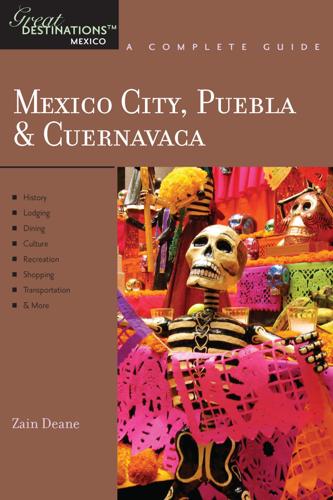
Explorer's Guide Mexico City, Puebla & Cuernavaca: A Great Destination
by
Zain Deane
Published 8 Sep 2011
INTRODUCTION Mexico City gets a bad rap: while tourists flood Mexico’s well-known, footloose-and-fancy-free resort centers in Cancún, Acapulco, and the Mayan Riviera, many visitors avoid Mexico City because its reputation has preceded it. Rumors of pollution, overpopulation, high crime, and a bustling, dangerous, angry urban sprawl keep travelers away. This is unfortunate, because by skirting Mexico City, tourists who love this country are missing out on its most exciting urban center and one of the most fascinating cities in the world. There’s no doubt that this can be a daunting destination; as you fly into Benito Juárez International Airport and look out over the unending expanse of the metropolis, you can’t help but notice how overwhelming Mexico City is.
…
And it is one of the world’s oldest cities, which has its faults, but also many advantages. Over time, it has come to celebrate its diverse roots. INTRODUCING THE LARGEST CITY IN THE AMERICAS The D.F. is not a single city so much as it is a vast network of towns and suburbs that have been gradually incorporated into a massive urban sprawl. It is a place of continuous discovery: you could travel here half a dozen times and never see the same thing twice. Because the D.F. is so diverse, and so immense, it would be highly confusing to try to tackle the city’s many attractions and points of interest as a whole—there’s just too much ground to cover.
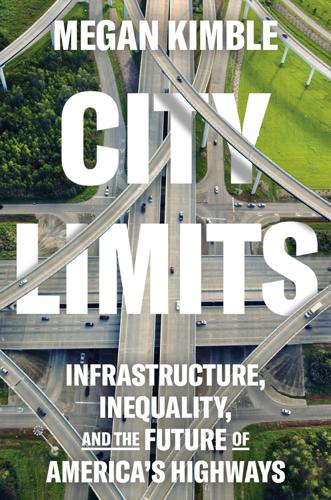
City Limits: Infrastructure, Inequality, and the Future of America's Highways
by
Megan Kimble
Published 2 Apr 2024
By the time he started buying up land along I-45, Mitchell had grown Mitchell Energy & Development Corporation into one of the country’s largest producers of oil and natural gas. Back then, you could extract oil from deep within the earth and still consider yourself an environmentalist, as Mitchell did. He loved trees. He hated Houston’s urban sprawl, how its bayous had been paved over and forests replaced by strip malls and suburbs. “We’re stuffing up the highways back and forth,” Mitchell told The Houston Post in 1972. “We’ve got to urbanize, but how?” Mitchell’s answer was the anti-suburb—a self-contained community, integrated with its natural environment, where families could access everything they needed for daily life, including jobs and schools.
…
By 2019, The Woodlands had become yet another suburb, “the same sort of exclusive retreat that whites chose in the 1960s as they fled the decaying inner cities—albeit better planned and with more appealing amenities,” writes the journalist Loren Steffy in his book George P. Mitchell: Fracking, Sustainability, and an Unorthodox Quest to Save the Planet. “Designed as a remedy to urban sprawl, The Woodlands now accelerates it.” Molly Cook spent most of her adolescence riding her bike around the dendritic streets of The Woodlands. The neighborhood was full of kids and they pedaled along the quiet suburban streets that branched into dead-end circles. They walked to the shopping center down the street, McDonald’s and Blockbuster hidden behind a curtain of pine trees.
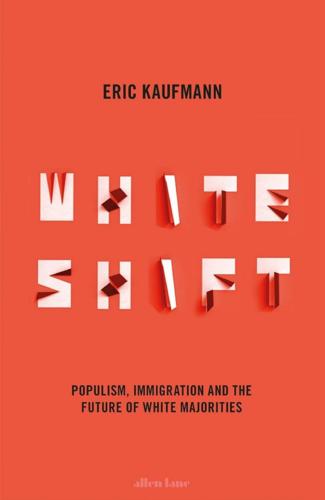
Whiteshift: Populism, Immigration and the Future of White Majorities
by
Eric Kaufmann
Published 24 Oct 2018
For instance, in small opt-in samples on Prolific Academic, one group of white Republican voters scored the problem of ‘unchecked urban sprawl’ a 51 out of 100, but another group of white Republicans who saw the question as ‘unchecked urban sprawl caused by immigration’ scored it 74/100 (italics added for emphasis). Likewise, among a sample of white British Brexit voters, the problem of ‘pressure on council housing’ scored a 47/100 but ‘immigrants putting pressure on council housing’ was rated 68/100. In both cases, it logically cannot be the case that the immigration-driven portion of the problem of urban sprawl or pressure on council housing is more important than the problem itself.
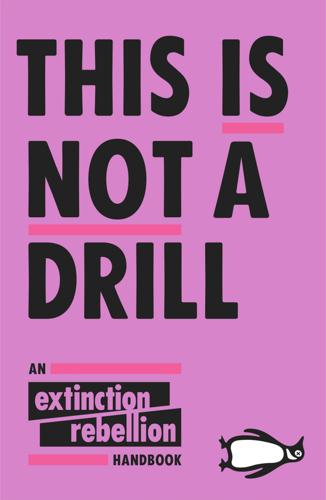
This Is Not a Drill: An Extinction Rebellion Handbook
by
Extinction Rebellion
Published 12 Jun 2019
The third area is the Bio City. An urgent lock-down of the destructive ecological tendencies of urban life is required. The air, water and land ecosystems that cities depend upon are being intensely degraded, and resources are being depleted and commodified. There are vast deadzones of alienated urban sprawl and dereliction, retail areas, highways and industry where residents have little connection with the natural systems that underpin human flourishing. Worse, there’s a binary division between us humans and the nature out there. This leads to us treating nature as something external rather than as a life-support system we depend upon.
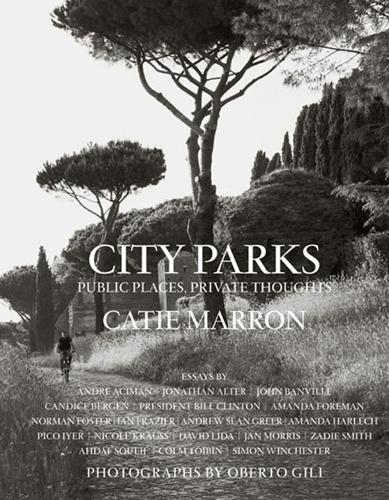
City Parks
by
Catie Marron
XOCHIMILCO IS ONE OF SIXTEEN delegations (the equivalent of arrondissements in Paris, or boroughs in London or New York) that make up the Federal District, the enormous, palpitating heart of Mexico City. Xochimilco used to be a separate town, but it was one of the many localities enveloped by the urban sprawl that turned Mexico City into a monster of about 22 million souls in the last fifty years. In Xochimilco alone, there are close to half a million residents and about fifty neighborhoods. But when people talk about Xochimilco, they’re usually referring to a network of canals—extending more than a hundred miles—that snake through certain parts of the district.

Literary Theory for Robots: How Computers Learned to Write
by
Dennis Yi Tenen
Published 6 Feb 2024
On a less apocalyptic scale, history allows for extrapolation. It helps anticipate changes in the direction of travel. Without history, our ideals and our policies lack sufficient foresight to prepare adequately and to alter course if needed. Without history, society is doomed to struggle with long-term effects of technology, such as pollution and urban sprawl, and soon, if not already, AI. History ultimately makes for better engineers and users of technology. Any complicated gadget contains within it a number of contingencies that appear senseless today because they were attained through a compromise with past limitations. QWERTY, the layout of modern English keyboards, for example, was famously arranged in that order to slow down typing on typewriters that jammed otherwise.
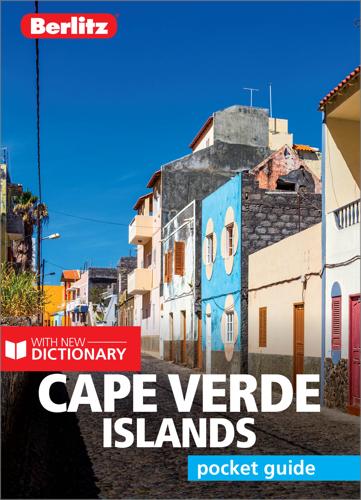
Berlitz Pocket Guide Cape Verde
by
Berlitz Publishing
Published 1 May 2018
Since they’re not usually planning to live here permanently until they retire, they’re in no hurry to finish the construction, let alone render and paint the walls. Paradoxically, however, Cape Verdeans are keen decorators. Once their houses are finally complete, they often top them off with a jaunty paint job in contrasting shades of yellow, blue, pink and green. Almost a half of the population of Santiago live in the urban sprawl of Praia, the capital, which hugs the island’s southernmost bay. Outside the city, there’s a remarkable variety of scenery, from sandy beaches to hidden villages and craggy mountainsides draped in lush greenery. Praia, Cape Verde’s capital city Emma Gregg/Apa Publications Praia While the city of Praia ( [map] doesn’t have enough conventional sights to detain visitors for more than a day or two, it is a purposeful city which offers an interesting snapshot of a side of Cape Verde that many tourists miss.
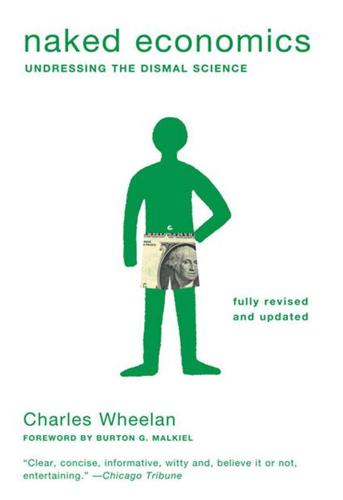
Naked Economics: Undressing the Dismal Science (Fully Revised and Updated)
by
Charles Wheelan
Published 18 Apr 2010
The effect is a bit like a night on the town with Dad’s credit card: We do a lot of things that we wouldn’t do if we had to pay the whole bill. We drive huge cars, we avoid public transportation, we move to far-flung suburbs and then commute long distances. Individuals don’t get the bill for this behavior, but society does—in the form of air pollution, global warming, and urban sprawl. The best way to deal with this growing problem is not the stuff that laissez-faire conservatives usually talk about. It is higher taxes on gasoline and cars. Only with those kinds of measures, as we shall explore in Chapter 3, will the cost of climbing behind the wheel of a car (or a hulking SUV) reflect the real social cost of that activity.
…
We talk about how important education is, but we make it difficult and time-consuming for smart people to become teachers (despite evidence that this training has little impact). We don’t pay good teachers more than bad ones. We make it artificially cheap to travel by car, implicitly subsidizing everything from urban sprawl to global warming. We assess most of our taxes on productive activity, like work, savings, and investment, when we might raise revenue and conserve resources with more “green taxes.” If we get the incentives right, we can use markets to do all kinds of things. Consider the case of rare diseases.

World Cities and Nation States
by
Greg Clark
and
Tim Moonen
Published 19 Dec 2016
Their ability to manage and control migration into, and often across, their territories affects the talent strategies and population management planning of world cities. Their choices about where to locate national military, trade, research or scientific facilities can have big impacts on agglomeration. Their planning policies and regimes can enable or constrain the local governments in world cities as they try to adapt to infrastructure demand, reverse urban sprawl and make developments more attractive to international capital. The way they lobby for intergovernmental rules, treaties and regulations has big implications for their leading cities’ reach and competitiveness. Their response to key industries during economic downturns, whether through economic stimulus, grants or tax, tariff and regulatory adjustments, can inject momentum for a new cycle of growth in a sector, or can stop it in its tracks.
…
Bessis, H. (2016). Is the new ‘Greater Paris’ authority too weak to get things done?. City Metric. Available at http://www.citymetric.com/politics/new‐greater‐paris‐authority‐too‐weak‐get‐ things‐done‐1894. Accessed 2016 Mar 14. Blais, P. (2010). Perverse Cities: Hidden Subsidies, Wonky Policy, and Urban Sprawl. Vancouver: UBC Press. Bremner, C. (2010). Euromonitor International’s Top City Destination Ranking. Euromonitor. Available at http://blog.euromonitor.com/2010/01/euromonitor‐internationals‐top‐city‐ destination‐ranking.html. Accessed 2016 Jan 21. Bremner, C. (2015). Top 100 City Destinations Ranking.

The Architecture of Happiness
by
Alain de Botton
Published 10 Dec 2008
In order to alleviate overcrowding, the ancient low-rise buildings would have to be replaced by a new kind of structure only recently made possible by advances in reinforced concrete technology: the skyscraper. ‘2,700 people will use one front door,’ marvelled Le Corbusier, who went on to imagine ever taller towers, some housing as many as 40,000 people. When he visited New York for the first time, he came away disappointed by the scale of the buildings. ‘Your skyscrapers are too small,’ he told a surprised journalist from the Herald Tribune. By building upwards, two problems would be resolved at a stroke: overcrowding and urban sprawl. With room enough for everyone in towers, there would be no need for cities to spread outwards and devour the countryside in the process. ‘We must eliminate the suburbs,’ recommended Le Corbusier, whose objection was as much based on his hatred of what he took to be the narrow mental outlook of suburbanites as on the aesthetics of their picket-fenced villas.
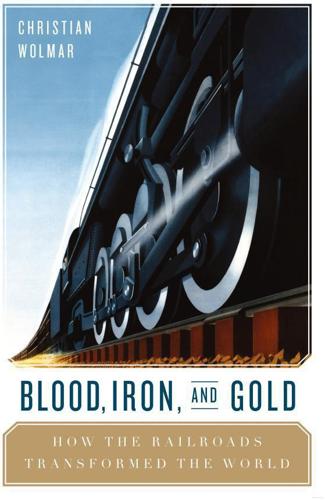
Blood, Iron, and Gold: How the Railways Transformed the World
by
Christian Wolmar
Published 1 Mar 2010
The Illinois Central deliberately set out to attract suburban dwellers and the railways, therefore, were responsible for urban sprawl a couple of generations before the motor car made it possible for every town, rather than only those blessed with a suburban railway network, to expand in that way. Commuting railways were transforming life in big cities all around the world, greatly extending the area in which workers could live. This changed the nature of cities, stimulating the creation of what are now called central business districts that can be served by train with high office blocks densely concentrated in an area of expensive land, while allowing urban sprawl to outer areas where land is cheaper.
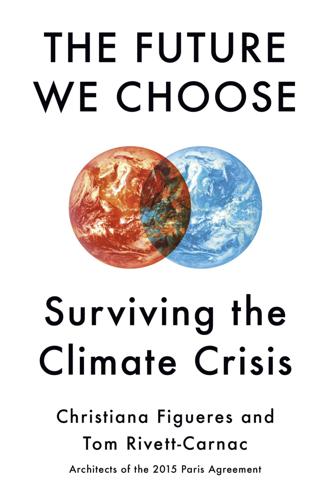
The Future We Choose: Surviving the Climate Crisis
by
Christiana Figueres
and
Tom Rivett-Carnac
Published 25 Feb 2020
It took Emmeline Pankhurst and the suffragette movement slightly more than a decade to force the British government to give women the right to vote.14 The Soviet Union seemed so solid as to be eternal, but once cracks started to appear, the edifice crumbled in just a few months.15 In 1939 General Motors presented visitors to the World’s Fair in New York City with an imaginative vision of what the future could look like. It was called Futurama and consisted of an enormous model of multiple high-rise buildings, vast suburbs, and large motorways for travel between them, necessitating the use of cars.16 Imagination is going to be critical as we work to transform today’s urban sprawl to make it fit for the future. Some futurists have predicted that in the course of a decade, the rise of the autonomous, shared, on-demand electric car means we will need 80 percent fewer cars on the roads than we do now.17 This will free up huge areas of urban space that are currently used as parking lots.
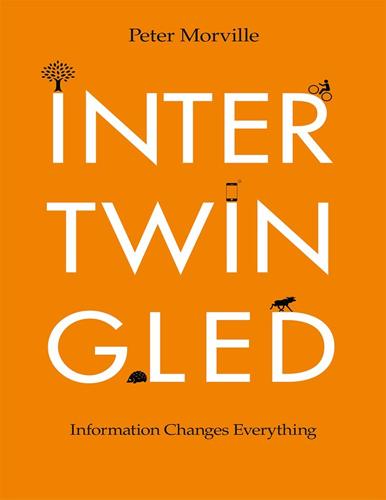
Intertwingled: Information Changes Everything
by
Peter Morville
Published 14 May 2014
Jane’s vision was hopeful, and she made an impact. Her text is required reading in urban studies. Her ideas have become conventional wisdom. Our world is more livable because of her. Sadly, not all cities got the message. As my black Uber car cruises the freeways of San José, I’m besieged by the image of urban sprawl. It’s hard to feel at home in a place like this. But it’s not just the office parks and strip malls that are making me uncomfortable. I’m worried about meeting Sophie. Part of the reason I don’t participate in the sharing economy is I’m an introvert, and a shy one too. Hotels are easy. Staff rarely say more than hello.
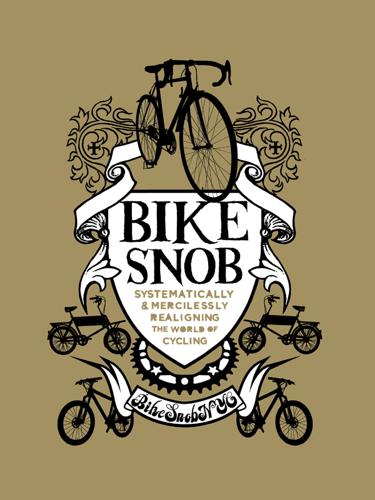
Bike Snob
by
BikeSnobNYC
Published 5 May 2010
However, unless you count rivulets of dog urine, there were no streams on or near Merrick Road, rippling or otherwise. There also weren’t any cyclists, apart from the odd delivery person riding a department store bike on the sidewalk. There were, however, many used car lots, as well as an abundance of fast-food chicken restaurants. Still, despite the urban sprawl, it wasn’t impossible to imagine a time when this was a country road teeming with cyclists. While more or less straight, Merrick Boulevard isn’t dead straight, like newer roads. Instead, it follows the mild grade and contour of the land like an older road does. And as any cyclist knows, the difference between a plumb-straight road and an “organic” one is huge.
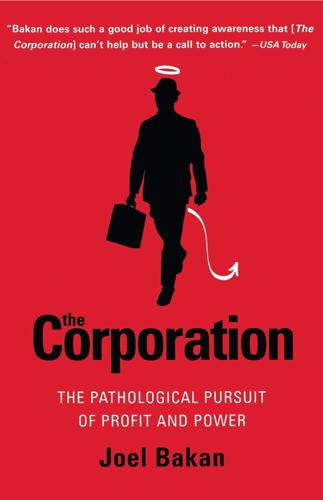
The Corporation: The Pathological Pursuit of Profit and Power
by
Joel Bakan
Published 1 Jan 2003
Local governmental bodies, such as city councils and school and park boards, should play greater roles in the regulatory system, as they are often more accessible to citizens than federal and state agencies and more willing and able to forge alliances with citizen groups around particular issues (as they have done effectively in relation to, among other things, restrictions on advertising in schools, urban sprawl, "box" retailers, and environmentally damaging practices ). The roles of trade unions and other workers' associations in monitoring and regulating the behavior of corporations should be protected and enhanced, as should those of environmental , consumer, human rights, and other organizations that represent interests and constituencies affected by what corporations do.
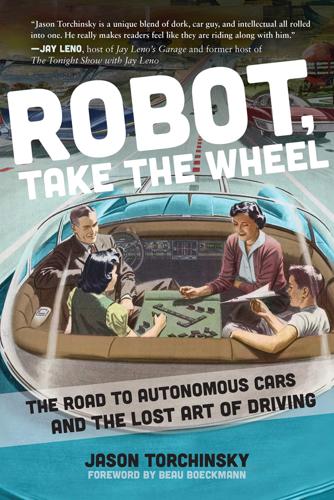
Robot, Take the Wheel: The Road to Autonomous Cars and the Lost Art of Driving
by
Jason Torchinsky
Published 6 May 2019
And sure, you can take the subway or bus almost anywhere in New York City, but if you want to leave the city, you’re going to have to use a car—either by driving one yourself or getting someone else (taxi, Uber, easily manipulated friend, or unusually well-trained and capable dog) to take you there. No matter how good a city’s public transportation system is, it’s still not the same as having your own, independent car. Now, I know many people consider private cars to be horrible environmental disasters that have created urban sprawl and soulless suburbs, and are awful, violent things that are destroying everything. While, sure, some of these things are no doubt true, that’s a miserable and pretty limited way to look at cars and driving. A personal car also offers one of the most powerful and fulfilling modes of mobility that human beings have ever enjoyed.
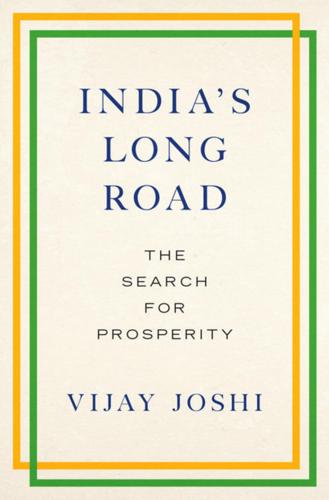
India's Long Road
by
Vijay Joshi
Published 21 Feb 2017
Space precludes discussion of problems in urban land markets, other than government land acquisition policies. The urban land ceiling acts which froze up land markets in cities for many years36 have now thankfully gone. But various distortions remain. To take just one example, the rigid ‘floor space index’ (FSI) requirements in cities encourage urban sprawl and hugely increase transport costs for residents. India’s cities are far less dense compared with international good practice. It would make good sense to relax FSI requirements by charging those who wish to exceed them a price [ 96 ] The Growth Challenge 97 that reflects the extra burden they will impose on urban infrastructure (after allowing for the saving on transport costs).37 The Capital Market and Bankruptcy Arrangements A competitive modern economy needs swift and efficient procedures to deal with company distress, insolvency, and exit.
…
Rationalizing government spending in the agricultural sector (see Chapter 6) and charging economic prices for farm inputs would help to fight water scarcity as well as save energy. Changing the balance of domestic transport from road to rail would increase productivity and also reduce GHG emissions. More efficient urbanization policies, including energy-efficient public transport, would reduce urban sprawl and congestion while furthering climate mitigation. Fears that climate mitigation policies would entail a major growth sacrifice are overblown. Consider, for example, the report of the Expert Group appointed by the Planning Commission on low-carbon strategies, chaired by Kirit Parikh.46 This concluded on the basis of an economy-wide optimizing model that the growth-rate decline from 2007 to 2030 as a result of low-carbon strategies would be small (a decline of only 0.15 percentage points compared with the base case), while India’s annual per capita carbon emissions would fall from a 2030 baseline of 3.6 tonnes to 2.6 tonnes.

Cities Under Siege: The New Military Urbanism
by
Stephen Graham
Published 30 Oct 2009
Like the rest of the world, then, military training sites are rapidly being urbanized. Colonel Thomas Hammes, writing in the US Marine Corps Gazette in 1999, was one of many defence planners then asserting the need to build new mock cities because US military training sites were out of phase with ‘the urban sprawl that dominates critical areas of the world today. Continuing in that vein, he wrote, ‘We know we will fight mostly in urban areas. Yet, we conduct the vast majority of our training in rural areas – the hills of Camp Pendleton, the deserts of Twenty Nine Palms, the woods of Camp Lejeune, the jungles of Okinawa, Japan’.4 The US military’s response has been dramatic.
…
For such vehicles merely promote increased oil consumption and dependence, which will only deepen current and future crises and insecurities.38 With suburbanization and sprawl – a project so critical to the mass adoption of SUVs – now threatened by oil depletion, the paradox is pronounced indeed. One influential critic of urban sprawl, Jim Kunstler, is convinced that ‘the grand meta-cycle of the suburban project as a whole’, within which SUVs now play such a major role, is ‘at the end of the cycle’. To him, ‘the remaining things under construction are the last twitchings of a dying organism’ – a process accelerated by the US recession, brought on by a credit crunch generated largely by criminally lax lending of largely fictitious capital to fuel yet another massive round of sprawl and exurbanization.39 Kunstler argues that US suburban history, climaxing in mass SUV ownership and hypersprawl, must be interpreted through the lens of oil geopolitics: The suburban expansion has been based entirely on cheap-and-abundant supplies of oil.
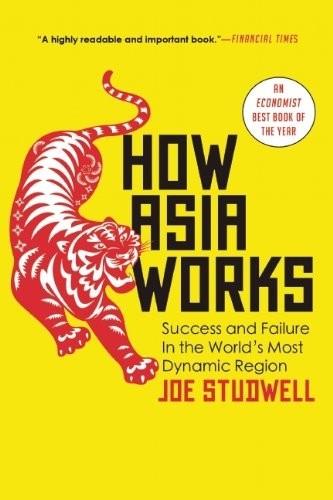
How Asia Works
by
Joe Studwell
Published 1 Jul 2013
Journey 1: Tokyo to Niigata You can begin to understand much about Japan’s agricultural history simply by driving around, because that history is so heavily dependent on topography. A journey from Tokyo north-west across the main island of Honshu to Niigata prefecture, producer of the country’s finest rice, highlights the basic challenges. First, however, you must exit from Tokyo’s urban sprawl. The capital, with its silent, strange residential suburbs, its little lanes and its religiously maintained road markings, ends only in theory. In practice it merges into a series of other, less prosperous towns in a seamless continuum of low-rise clapboard houses, malls, discount stores, fast-food restaurants and car showrooms.
…
Not only has Japan developed with an impossibly small supply of cultivable land per capita, but large swathes of that land have been relentlessly gobbled up by its urban and industrial development. This trend has long been exacerbated by a cultural aversion to high-rise building. The insistence on low-rise, sadly, has done nothing to make modern Japanese construction more attractive. Avoiding expressways, it is a 40-kilometre, two- to three-hour grind through spirit-sapping urban sprawl, past the vast American Yokota air base, before you see anything remotely rural to the north-west of Tokyo. What happens is that eventually the hills become too steep to build on or, indeed, to farm. And that is the reason why Japan has so little cultivable land – the country is covered in hills and mountains, which in turn are covered in forests.
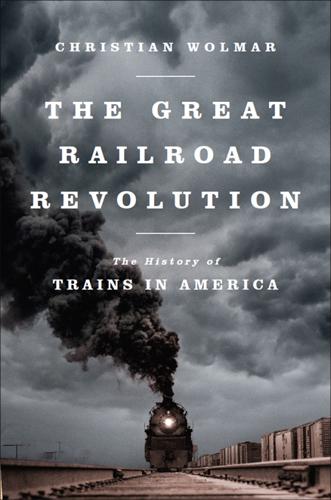
The Great Railroad Revolution
by
Christian Wolmar
Published 9 Jun 2014
These lines were run informally, and rarely for profit: “The engineer might well be the president of the company, the brakeman his brother.”34 One kind of local line did prosper, however. This was the period when the number of commuting services began to spread, notably in Boston, New York, Philadelphia, and Chicago, stimulating the growth of the urban sprawl that would later be served so much better by the automobile. In fact, as early as the 1840s, a few railroads had begun offering “commuted” tickets—reduced fares for regular use—to stimulate travel, but demand was limited, as there were few businesses needing such workers or, indeed, suburbs from which they could commute.
…
He saw that good transportation was as essential as ensuring the houses had water and electricity and therefore was not concerned that he lost money on providing it: “The result was the characteristic low-rise form of the region, with mile upon mile of ‘California bungalows’ spreading along the tentacles of the Pacific Electric Network. This extensive urban spread gave Los Angeles a reputation, which has lasted to this day, as the very model of urban sprawl.”19 Lots that were a half-dozen blocks away from the streetcar were simply left undeveloped, but once the car became commonplace, they were built upon and their residents’ automobiles soon displaced the streetcars on the highway. Development of these interurban streetcars was so intensive in parts of the Midwest that it was possible in 1910 to travel continuously by interurban from Elkhart Lake, Wisconsin, to Oneonta, New York, a distance of nearly eleven hundred miles.
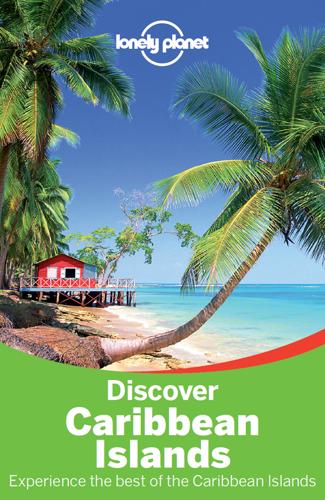
Discover Caribbean Islands
by
Lonely Planet
The entire place is no secret though, and you won’t be alone, but it’s easy to escape the crowds by walking down the bay. There are a number of beachside restaurants. Detour: Les Saintes These tiny islands to the south of Basse-Terre are many people’s highlight of Guadeloupe, as they allow visitors to enjoy a slice of the old Caribbean, far from the development and urban sprawl that has affected much of the region. These tiny charmers are a real secret – many day-trippers come over from Basse-Terre, but very few people spend any real time here exploring these gems. Don’t miss your chance. Lying 10km off Guadeloupe is Terre-de-Haut, the largest of the eight small islands that make up Les Saintes.
…
Martinique POP 400,000 Volcanic in origin, Martinique is a mountainous stunner crowned by the still-smoldering Mont Pelée, which wiped out Martinique’s former capital of St-Pierre in 1902. Martinique offers a striking diversity of landscapes and atmospheres. While it suffers from uncontrolled urban sprawl in some places, particularly in and around the busy capital, Fort-de-France, life – and travel – becomes more sedate as one heads north or south through some of the island’s delicious scenery. The rainforested, mountainous northern part is the most spectacular, but the south has its fair share of natural wonders, including lovely bays and miles of luscious beaches.
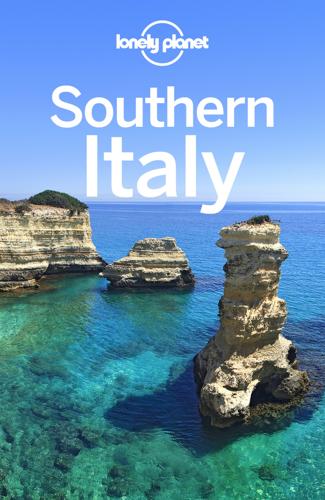
Lonely Planet Southern Italy
by
Lonely Planet
Mt Vesuvius Rising formidably beside the Bay of Naples, Mt Vesuvius forms part of the Campanian volcanic arch, a string of active, dormant and extinct volcanoes that include the Campi Flegrei’s Solfatara and Monte Nuovo, and Ischia’s Monte Epomeo. Infamous for its explosive Plinian eruptions and surrounding urban sprawl, it’s also one of the world’s most carefully monitored volcanoes. Another full-scale eruption would be catastrophic. More than half a million people live in the so-called ‘red zone’, the area most vulnerable to pyroclastic flows and crushing pyroclastic deposits in a major eruption. Yet, despite government incentives to relocate, few residents are willing to leave. 1 Sights Mt VesuviusVOLCANO (%081 239 56 53; www.parconazionaledelvesuvio.it; crater adult/reduced €10/8; hcrater 9am-6pm Jul & Aug, to 5pm Apr-Jun & Sep, to 4pm Mar & Oct, to 3pm Nov-Feb, ticket office closes 1hr before crater) Since exploding into history in AD 79, Vesuvius has blown its top more than 30 times.
…
The rolling green valley is criss-crossed by drystone walls, vineyards, almond and olive groves, and winding country lanes. This is the part of Puglia most visited by foreign tourists and is the best served by hotels and luxury masserias (working farms) or manor farms. Alberobello %080 / Pop 10,750 Unesco World Heritage Site Alberobello resembles an urban sprawl – for gnomes. The zona dei trulli on the westernmost of the town’s two hills is a dense mass of 1500 beehive-shaped houses, white-tipped as if dusted by snow. These drystone buildings are made from local limestone; none are older than the 14th century. The town is named after the primitive oak forest Arboris Belli (beautiful trees) that once covered this area.

Italy
by
Damien Simonis
Published 31 Jul 2010
A ticket valid for 90 minutes costs €1.20 (single ride €0.70) and an all-day ticket costs €3.50. Tickets can be used on main-line trains within the city limits, as well as on the new wheelchair-accessible metro (www.genovametro.com), which has numerous stations across the city. Return to beginning of chapter AROUND GENOA Nervi A former fishing village engulfed by Genoa’s urban sprawl, modern Nervi classifies itself as a ‘resort’. Though, with plenty of ritzier Riviera competition, it’s rarely top of anyone’s vacation list. Its saving graces are its bounty of museums – four in total – and its 2km cliffside promenade, the Passeggiata Anita Garibaldi. The most celebrated museum is the Galleria d’Arte Moderna ( 010 372 60 25; Via Capolungo 3; adult/child €6/5; 10am-7pm Tue-Sun), displaying works by 19th- and 20th-century artists such as Filippo De Pisis, Arturo Martini and Rubaldo Merello.
…
For information on the Alpine ski resort of Bormio, in Valtellina’s far eastern reaches, see Parco Nazionale dello Stelvio, Click here. Trains link Milan with Sondrio (€7.80, two hours, every two hours) and terminate further east at Tirano. From Sondrio, buses connect the Valtellina’s resorts and towns. Return to beginning of chapter BRESCIA pop 189,700 Urban sprawl, a seedy bus and train station area, and the odd skyscraper don’t hint at Brescia’s fascinating old town, which serves as a reminder of its substantial history. Brescia already had centuries of (now- obscure) history behind it when the Romans conquered the Gallic town in 225 BC. The Carolingians took over in the 9th century, and were followed by a millennium’s worth of outside rulers, including the Venetians.
…
Desenzano del Garda pop 26,610 The lake’s main transport hub, Desenzano del Garda, is more residential than its lakeside counterparts, and many tourists pass straight through with barely a backward glance. But while Desenzano is not as quaint as some other spots, it’s also not as touristy and buzzes with activity year-round. Hidden amid its urban sprawl is an attractive old port and historic centre. You can get information on the town here from the tourist office ( 030 374 99 90; Via Porto Vecchio 34; 10am-12.30pm & 3-6pm Mon-Fri, 10am-12.30pm Sat). Right on the lakefront by Desenzano’s main beach, Hotel Europa ( 030 914 23 33; www.desenzano.com; Lungolago Battisti 71; s/d €62/104; ) is a breezy modern place with a good restaurant.

Makeshift Metropolis: Ideas About Cities
by
Witold Rybczynski
Published 9 Nov 2010
The Utrillo-like drawings, by Orfeo Tamburi, a Paris-based artist, reminded readers that American cities, no less than their European counterparts, have a tradition of urban living. Subsequent articles in the series, written by Fortune editors Francis Bello, Seymour Freedgood, and Daniel Seligman, as well as Whyte, covered transportation, city administration, slums, and urban sprawl. The reports are striking for their intelligence, detail, length—and sense of urgency. The common message was that American cities had a unique opportunity to renew themselves, but they had to get it right. Jacobs’s article was the last in the six-part series, though not by design. Fortune’s publisher, C.
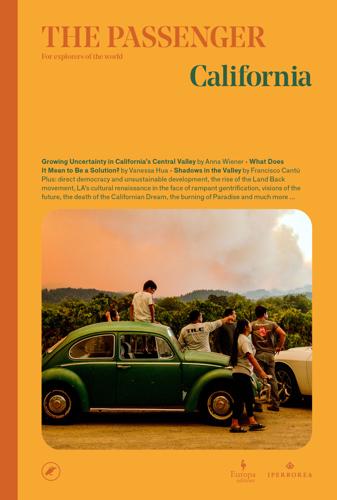
The Passenger
by
AA.VV.
Published 23 May 2022
A demonstration in Sunnyvale outside the building where the annual general meeting of Google’s parent company, Alphabet, was taking place. Workers and activists were protesting over a series of issues, including contractors’ rights and the tech giant’s activities in China. A HOME OF ONE’S OWN At the root of many of California’s problems – from the housing crisis to growing urban sprawl in fire-risk areas – lies the American Dream of the detached family home, a dream fiercely defended by those who have made it a reality by means of development plans that are often discriminatory. “Single-family zoning”, which sets aside an area exclusively for detached family homes (and therefore rules out terraces, duplexes or apartments), is a Californian invention – with clear segregationist origins.
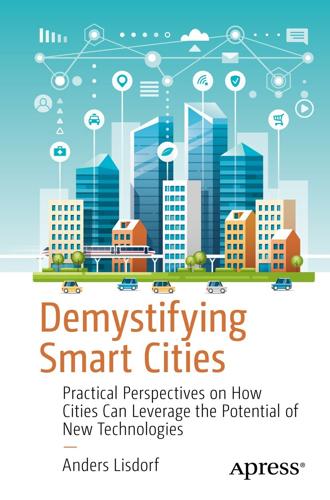
Demystifying Smart Cities
by
Anders Lisdorf
The famous French modernist architect and city planner, Le Corbusier, wrote an interesting book, The City of To-Morrow and Its Planning, in the start of the previous century in which he summed up two basic approaches to developing the city: “Man walks in a straight line because he has a goal and knows where he is going (..) the pack-donkey meanders along, meditates a little in his scatter brained and distracted fashion, he zigzags in order to avoid larger stones, or to ease the climb, or to gain shade; he takes the line of least resistance.” The pack donkey becomes the image of the irrational unreflected way of city planning known from the medieval towns, urban sprawl, and slums all over the world. If you have ever admired the winding roads of city centers of Paris, Rome, Zurich, or Copenhagen, you would have experienced the particular charm of a city planned by the way of the pack donkey. Conversely, the way of man with his straight lines and right angles can be seen in the rational Roman grid–based cities that formed the inspiration for many American cities like New York, Minneapolis, and Lima.
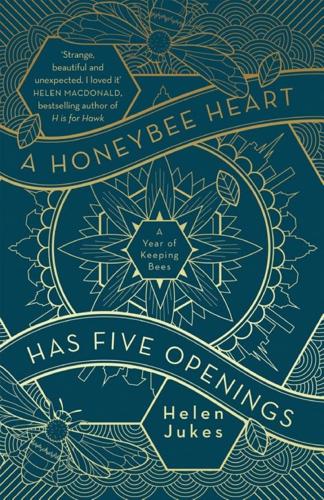
A Honeybee Heart Has Five Openings
by
Helen Jukes
Published 25 Jul 2018
But getting a hive won’t save the bees, who don’t and never have needed our keeping. If we want to do something to help them we’d do better to turn our attention to flowering habitats beyond the hive, on which they do depend. Wetland, woodland, wildflower pasture – all have been diminished over the last century in a hot wave of intensive agriculture and urban sprawl. I scoop the sticky crumbs from the books and floorboards, return them to my plate. So what is attracting us to beekeeping, if it’s not directly about saving the bees – and how do we become better custodians of their future? Perhaps it’s unfair to see the resurgence only as another form of avoidance of what’s really happening outside, to our climate and landscapes.

Lonely Planet Malta & Gozo
by
Lonely Planet
In Game of Thrones, the palace was the location of the Red Keep. The Three VillagesTIME FROM RABAT: 10 mins A trio of churches Just west of Birkirkara and centred on the medieval settlements of Attard, Balzan and Lija is the upmarket residential area known as the Three Villages. Although modern development has fused the three into a continuous urban sprawl, the old village centres still retain their parish churches and narrow streets. Birkirkara’s Church of St Helen is probably the most ornate of Malta’s churches, a late flowering of baroque exuberance built in the mid-18th century, while Attard’s Church of St Mary was designed and built by Tommaso Dingli between 1613 and 1616.
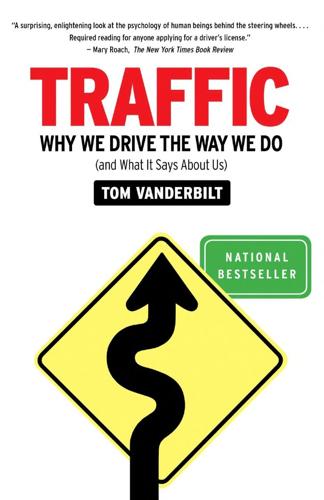
Traffic: Why We Drive the Way We Do (And What It Says About Us)
by
Tom Vanderbilt
Published 28 Jul 2008
Not surprisingly, the authors report that PAHs seem to be on the rise: “USGS findings show that concentrations of total PAHs in the majority of lakes and reservoirs in urban and suburban areas across the nation increased significantly from 1970 to 2001. The increases were greatest in lakes with rapidly urbanizing watersheds (urban sprawl); for example, over the last 10 years, the concentrations of PAHs in Lake in the Hills (suburban Chicago, Illinois) increased tenfold as the watershed was rapidly developed.” three to one: Douglas M. Main, “Parking Spaces Outnumber Drivers 3-to-1, Drive Pollution and Warming,” Purdue University News Service, September 11, 2007.
…
slightly higher in Belgium): Pocket World in Figures 2007 (London: Economist, 2007). risk of traffic fatalities: See Theodore E. Keeler, “Highway Safety, Economic Behavior, and Driving Environment,” American Economic Review, vol. 84, no. 3 (1994), pp. 684–93, and Reid Ewing, Richard A. Schieber, and Charles V. Zegeer, “Urban Sprawl as a Risk Factor in Motor Vehicle Occupant and Pedestrian Fatalities,” American Journal of Public Health, vol. 93, no. 9 (2003), pp. 1541–45. Belgium had 522: World Report on Road Traffic Injury Prevention, op. cit., p. 198. fairness of the process: Tom R. Tyler, Why People Obey the Law (Princeton, N.J.: Princeton University Press, 2006).

Fodor's Barcelona
by
Fodor's
Published 5 Apr 2011
Cons: Barceloneta offers few hotel opportunities, while the Port Olímpic’s principal offering, the monolithic Hotel Arts, can feel like a tourist colony away from the rest of town. Pedralbes, Sarrià & Upper Barcelona Neighborhood Vibe: Upper Barcelona is leafy and residential, and the air is always a few degrees cooler. Pedralbes holds Barcelona’s finest mansions; Sarrià is a rustic village suspended in the urban sprawl. Pros: Getting above the madding fray and into better air has distinct advantages, and the upper reaches of Barcelona offers them. A 15-minute train ride connects Sarrià with the Rambla. Cons: The only drawback to staying in upper Barcelona is the 15-minute commute to the most important monuments and attractions.
…
The right end of the beach is the home of the Club Natació de Barcelona and there is a semi-private feel that the beaches farther east seem to lack. Platja de Gavà-Castelldefels A 15-minute train ride south of Barcelona near the Gavà stop is a wider and wilder beach, with better water quality and a windswept strand that feels light years removed from the urban sprawl and somewhat dusty beaches of Barcelona. Alighting at Gavà and returning from Castelldefels allows a hike down the beach to Can Patricio or any of the other beach restaurants dishing out delicacies like calçots or paella. Previous Chapter | Beginning of Chapter | Next Chapter | Contents Previous Chapter | Next Chapter | Contents Bicycles and In-line Skates | Golf | Gyms and Spas | Hiking | Scuba Diving | Sailing and Windsurfing | Swimming | Tennis Bicycles and In-line Skates Cruising Barcelona on wheels, whether by bike or skate, is a good way to see a lot, and save on transport.
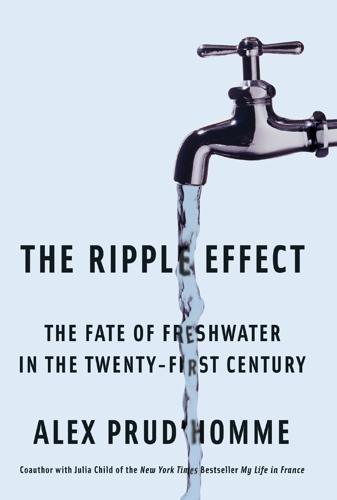
The Ripple Effect: The Fate of Fresh Water in the Twenty-First Century
by
Alex Prud'Homme
Published 6 Jun 2011
Bush to label it a major disaster area, and cut public utilities’ water withdrawals by 10 percent. Then Perdue joined hands with supporters on the statehouse steps to pray for rain. To some, the calamity was no surprise. Years of pro-growth policies and lax zoning had led to poor water management and urban sprawl; hydrologists had warned Georgia for nearly two decades that such a drought was possible, but legislators had never developed a coherent response. In the 1990s, plans to build a network of state reservoirs were defeated, largely by developers who were angered that they would not be allowed to build homes around the new lakes.
…
Paul, Minn., 108 Salazar, Ken, 148, 323, 360 salmon, 350 Atlantic, 318 copper as neurotoxin for, 310 farm-raised, 319 salmon, Pacific, 318–19 in Bristol Bay fishery, 306, 308, 309, 313–14, 317–18, 323 in Sacramento–San Joaquin Delta, 241, 246, 247, 248, 249 Salmon Trout River, 85 Salt Lake City, Utah, 303 Salton Sea, 154 Salt River Project, 326 Salt River Valley, 133 salt water, aquifers infiltrated by, 11–12, 22, 109, 126, 210, 240, 258 San Antonio, Tex., 262, 279 sandhogs, 118, 121, 122–24, 211 Sandia National Laboratories, 278, 279 San Diego, Calif., 71, 111–12, 113, 154, 165, 180 San Diego Coastkeeper, 112 San Diego County, Calif., 335 San Diego County Water Authority, 337 San Diego Regional Water Quality Board, 336, 337 San Diego Tribune, 111 San Fernando Valley, 152–54 San Francisco, Calif., 60, 181, 241, 242, 303 municipal water quality in, 301 1989 earthquake in, 128 San Francisco Bay, 60, 243 San Francisco Chronicle, 193 Sangre de Cristo Mountains, 146, 150 sanitation, 127, 349 San Joaquin River, 189, 248–49 see also Sacramento–San Joaquin Delta San Joaquin Valley, 249 San Juan Mountains, 146 San Lorenzo Valley Water District, 273 San Luis Valley, 145–46 aquifers of, 143–44, 146, 256, 258 farmers in, 146 pipeline projects for, 146–50 San Luis Valley Ecosystem Council, 150 San Pellegrino, 301–2 Santa Barbara, Calif., 331, 356 Saratoga, Battle of, 217 Satterfield, Bill, 82 Saudi Arabia, 288, 329, 332 Saur, 266 Savannah River, 75–76 Sawtooth Valley, 319 Schaefer, Vincent, 328 Schuylkill River, 62 Schwarzenegger, Arnold, 179, 185–86, 188, 192–93, 242, 246, 249, 252, 253, 337, 345 Science, 357, 359 Science Daily, 209 ScienceNow, 67 Scientific American, 259 Scripps Institution of Oceanography, 162–63 Seagar, Richard, 134, 206 sea grasses, 88 sea levels, rising, 203, 210, 211, 212, 231 Seattle, Wash., 128 Seed, Raymond, 224–25, 253 Segerfeldt, Fredrik, 277 Seggos, Basil, 25–26 SEMAPA, 274–76 Semenya, Caster, 77–78 Senate, US, 138, 177 September 11, 2001 terrorist attacks, 4, 26 Serageldin, Ismail, 12, 198 sewage, 54, 56, 82, 208, 357 cholera and, 107 population growth and, 110 sewage treatment, sewage treatment plants, 51, 52–54, 76, 205 activated sludge process in, 59 biosolids from, 67 CSOs and, 54–56, 59–61 digesters in, 58–59, 62 energy use by, 279 flooding of, 205, 207–8 outfalls of, 53, 54, 59, 60 privatization of, 266, 269 recycled water from, see recycled wastewater three stages in, 57–58, 111 sewer systems, 9–10, 51, 60, 212, 357 combined, 52–57, 61 separate-pipe, 55 sexual differentiation, 78 Seychelles, 210 shale, 279, 282–83, 284, 287, 350 oil extraction from, 287–89 Shanghai, China, 273 sharp-tooth catfish, 75 Sheffield, Bill, 313 Sheldon, Karin, 289 Shenandoah River, 79, 84–86 fish kills in, 85–86 intersex fish in, 75, 85 Shenandoah Riverkeeper, 85–86 Shenandoah Valley, 79 poultry industry in, 80–81 Shimshack, Jay, 101 Shively, John, 305, 312–17, 320, 322, 323, 324 Shoaiba Desalination Plant, 332 shovelnose sturgeon, 75 shrimp, 95 Sierra Club, 181, 209, 264 Sierra Nevada Mountains, 151, 162, 167, 244 as early-warning system for climate change, 191–92 snowpack of, 130, 189–92, 241, 244, 249 Silent Spring (Carson), 184 Silt, Colo., 284–85 Silva, Peter, 101 Silver Bow Creek, 41 silver iodide, 328–29 Silver Lake, PCBs in, 34, 39 Singapore, 110 water management in, 353–54 Sites Reservoir, 186, 193 sludge, from sewage, 59 slurry, 102 smallmouth bass, 74–75, 76, 85–86 smelt, 241, 245, 247, 248, 350 Smith, Adam, 13, 343 Smith, Jim, 285 Smith, Roxanne, 68 Snake Valley, 161–62, 169–70, 171, 173 Snow, John, 107 Snow, Lester, 179, 186, 187–88, 192, 193 snow geese, 41 snowmelt, 144, 162, 169, 191, 198, 218, 241, 244, 249 snowpack: extreme fluctuations in, 190 shrinking of, 129, 130, 174, 189–92, 290 snow water equivalent (SWE), 190–91 Sny levee, 214 soft engineering, 233–35 Soft Path water management, 348–49 solar power, 348 water use by, 278, 279 Solomon, Steven, 353 Somalia, 128 Sonoran Desert, 131–32, 167, 325, 339 Sorensen, Kathryn, 327 South Africa, 75, 124, 274, 309 South America, 93 South Carolina, 128 South Dakota, 258, 357 Southeast, US: drought in, 205–7, 235 flooding in, 207–8 Southeast Asia, 197, 198 Southern Nevada Water Authority (SNWA), 68, 161, 163 “third straw” outtake pipe of, 175 water-conservation programs of, 163–65 Southern Nevada Water Authority (SNWA), pipeline proposal of, 159, 161–74 environmental impact of, 169–70 legal challenges to, 173–74 Utah and, 171, 173 South Florida Water Management District, 47 South Korea, 42, 197 Southwest, US: climate change and, 134 droughts in, 133–34, 160–61 population growth in, 278 see also West, US soybean production, 95 Spain, 267 droughts in, 10, 124 Sparks, Nev., 141, 159 Spath, David, 112 Special Assistant for Natural Resources, 320 Spitzer, Eliot, 26 spottail shiners, 75 Spring Valley, 169, 172 springwater, 296 Spruce No. 1 Mine, 104 Stagg, Tom, 17 Stahl, Glen, 44–45, 46, 48, 50 Standard Oil Company, 21, 26 Stanley Electric Company, 34 Staples, Todd, 262 State Water Project (SWP), 241, 244–46 Statue of Liberty, 217 Steamboat Slough, Calif., 234 Steinbeck, John, 117 Stewart, Jon, 247 Stockman’s Water Company, 147–48 stomach cancer, 17 Stone and Webster, 332 Stony Brook Storm Surge Research Group, 212 storm surges, 210 storm-water runoff, 43–44, 51, 64, 126, 207 in combined sewer systems, 52–57 “green street” programs and, 212, 348 see also agricultural runoff streamgages, 207 striped bass (rockfish), 88, 89 Strong, Hanne, 143, 145–46, 147 Strong, Maurice, 143–47, 256 Stupak, Bart, 196 suburban sprawl, 153–54 Sudan, 197, 198 Suez Canal, 270 Suez Lyonnaise des Eaux, 2, 265, 266, 270–72, 273, 274, 276 sugar pines, 192 Suisun Bay, 243 sulfur hexafluoride, 93–94 Sunday Telegraph (UK), 71 Superfund National Priorities List, 38 Superfund sites, 20, 28–29, 39, 103, 338, 339 Superior, Lake, 196 Supreme Court, US, 40, 147, 280 Kensington mine decision of, 316–17 Rapanos decision of, 100–101, 216, 344 water competition and, 195–96 surface storage, see reservoirs surface water, 17–18, 125, 257, 359 Surfrider Foundation, 336 Susquehanna River, 73 sustainability, 325–26 Sweden, 286 Sweetwater Creek, 207 synthetic crude oil, 288, 289 Syria, 130, 196–97 tailings, 307, 315 Taiwan, 33 Taliban, 198 Tampa, Fla., 332–34 Tampa Bay Water (TBW), 332–34 Tappening, 303 tar sands, oil extraction from, 289–90 Taylor, Tracy, 172, 173–74 Teck Alaska Inc., 313 Teck Cominco, 311 Temperance Flat dam project, 186, 193, 249, 250, 252 temperature, water quality and, 18 Tennessee, 219 Tennessee Valley Authority (TVA), 102 Ternes, Thomas, 69 testicular oocytes (TO), 75, 85 Teton Dam, 184 Texans for Public Justice, 263 Texas, 12, 196, 240, 280 droughts in, 128, 208, 256, 257, 261–62, 264–65, 279 floods in, 208, 219 Ogallala Aquifer in, 258, 260 population growth in, 256, 257 water rights in, 257, 298 water use in, 125, 257 Texas City, Tex., 227, 231 Texas Panhandle, 255, 260 Texoma, Lake, 261 Thames River, 71, 212 There Will Be Blood (film), 255 “Think Outside the Bottle” campaign, 301 Thompson, Doug, 245 Three Gorges Dam, 307, 354 Threemile Canyon Farms, 48 Three Mile Island nuclear plant, 184 three-spine stickleback, 75 Tibet, 198 tidal surges, 208 Tigris-Euphrates basin, 199 Tigris River, 130, 196, 197 Time, 19, 256 Tinajas Altas, 131 Tocqueville, Alexis de, 325 Tolba, Mostafa, 12 toluene, 287 Tosco, 143 total maximum daily loads (TMDLs), 96–97 Totowa, N.J., 1 toxins, toxic waste, 20, 86 bioaccumulation of, 33 from hydrofracking, 284, 286–87 from mining, 307, 308, 310, 313–14 Tracy, Calif., 244–45 Tracy Pumping Plant, 245 “Tragedy of the Commons, The” (Hardin), 357–58 trans-Alaska oil pipeline, 313 Transocean, 228–29 Treasure Island (casino), 164–65 trees, climate change and, 130 Treml, Judy, 44–46, 48, 50 Treml, Samantha, 44–46, 48 Treml, Scott, 44–46, 48 Tribe, Laurence, 39 trichlorobenzene, 32–33 trichloroethylene (TCE), 16, 339 triclocarban, 5, 67, 351 Trinity Dam, 183 Trinity River, 261 Trout Unlimited, 319 Truckee Canal, 216 tsunamis, 208, 354 Tucson, Ariz., 67 Tucson Citizen, 133 tule elk, 244 Tule Queen II, 233 tules, 234–35 tunnel-boring machines (moles), 123 Tuolumne River, 181 Turkey, 130, 196–97 Twain, Mark, 198 Tyonek, Alaska, 322 typhoid fever, 18 Tyson Foods Inc., 81 Uganda, 197 ultrapure water, 113, 339 ultraviolet (UV) disinfection, 111 Umma, 199 Unconfined Aquifer, 144 United Kingdom (UK), 75, 76, 267 floods in, 200, 204, 212 United Nations (UN), 93, 124, 145, 268, 276, 352 Development Goals of, 199 Food and Agriculture Organization of, 352n water crisis warnings of, 12, 127, 194, 196, 199 United States: annual wastage of water in, 120 assumptions about drinking water in, 9–10, 126 desalination plants in, 331 droughts in, 12, 128, 133, 361–62 energy demand in, 280 flood control in, 210–13 floods in, 12, 95–96, 128, 204, 207–8, 209–10, 326, 354–55 natural gas use in, 286 need for national water policy in, 354 population growth in, 280 water use in, 125–26, 186–87 see also specific regions and states United Water, 2, 271–72 United Water Resources, 2 Unquenchable (Glennon), 341–42 Upper Clark Fork River, 41 Upper Talarik Creek, 305 Upper Yellowstone River, 85 uranium, 20 urban heat-island effect, 132–33 urbanization: global, 124, 204 see also cities urban sprawl, 154, 206 usufructuary rights, 137 Utah, 169–70, 171, 174, 288 Vaca Partners, 147, 149 Valencia, Pablo, 131–32 value: paradox of (diamond-water paradox), 13, 343 of water, 13, 166, 167, 176–77, 240, 250, 266–67, 343–45, 355–56 Van Cortlandt Park Valve Chamber, 121–22, 124 Vanity Fair, 276, 286 Venice, Italy, 212 Veolia, 265, 266, 268, 269–70, 272, 273, 276 Vermont, 299 Verrado, Ariz., 327 Vibrio cholerae, 107 Vidler Water Company, 159 Vietnam War, 220 Villaraigosa, Antonio, 157, 158 vintners, viniculture, 137 Virginia, 83 water-quality standards of, 79 Virginia Institute of Marine Science, 90 Virginia Poultry Federation, 86 Virgin River, 160, 175 “virtual water,” 137 VISTA, 312 Vivendi, 270, 274 Volta River, 130, 196 Vonnegut, Bernard, 328 Wade, Michael, 193, 251–52 Waldrop, Bob, 320 Wall Street Journal, 101, 265, 273, 320, 333, 337 Wanger, Oliver, 246 Warm Springs Dam, 185 War of 1812, 217 Wasatch Mountains, 167 Washington, 318, 319, 357 Washington, DC, 55, 67, 71, 83 Washington Post, 91, 99 Waste Management Healthcare Solutions, 68 wastewater treatment, see recycled wastewater; sewage treatment, sewage treatment plants water: as axis resource, 4–5, 13, 14, 239, 265, 343, 355 bottled, see bottled water commodification of, 260–66, 268, 277 as defining resource of twenty-first century, 343 energy used by treatment, conveyance, and heating of, 278, 279 fixed supply of, 12, 129, 166, 235, 239, 343–44 global distribution of, 129 as human right, 266, 267–68, 277 power generation use of, 125–26, 278–91 rationing of, 240 as renewable resource, 343–44 valuation of, 13, 166, 167, 176–77, 240, 250, 266–67, 343–45, 355–56 “wet” vs.
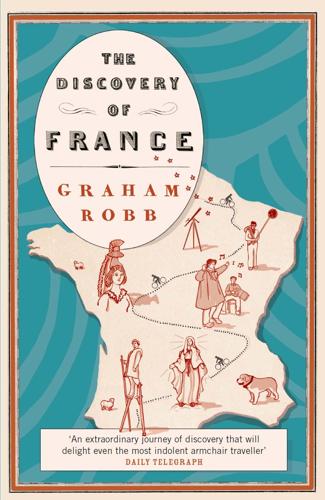
The Discovery of France
by
Graham Robb
Published 1 Jan 2007
Even at the end of the nineteenth century, some hunters believed that marmots pulled each other along like carts and that chamois and bouquetins (ibex) swung themselves headlong down sheer cliffs by stabbing their horns into the earth. Many of the wild inhabitants of France were no better known than the human inhabitants of the French colonies. * ROADKILL AND URBAN SPRAWL are modern innovations, but even two centuries ago there were signs that the discovery and colonization of France would bring devastation and death to animals. Domestic animals in towns were protected by the Grammont Law, but the only protection for animals in the wild was provided by occasional hunting restrictions, and most hunters found that these only enhanced the thrill of the chase.
…
In Lou Pouèmo dóu Rose (The Poem of the Rhône, 1896), the poet Mistral looked back a generation as though to ancient times and compared the grooves cut by the barges’ cables on the stone embankments to the ruts of chariot wheels on Roman roads. The fairgrounds of Beaucaire are now a long, flat riverbank of weeds and rubbish haunted by dog-walkers and bored teenagers. Fortunately, economic development is not the only measure of urban health. Now that many large cities are surrounded by Stygian fields of concrete tedium, urban sprawl looks like an obnoxious side effect of prosperity and decline. The oceanic awfulness of northern Paris and the disheartening suburbs of Marseille exact a heavy toll from travellers who come in search of aesthetic pleasure. Yet until the mid-nineteenth century, the suburbs of Marseille were one of the great sights of southern France.
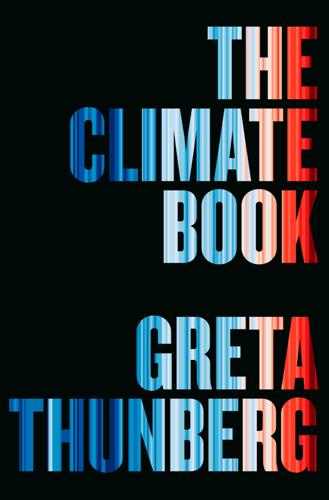
The Climate Book: The Facts and the Solutions
by
Greta Thunberg
Published 14 Feb 2023
EVs do not address social inequality within and between countries, especially in the Global South, where e-cars may well be an option only for the powerful and wealthy. And even if they could be made widely available, EVs do not ‘solve’ the problems of road traffic congestion, parking pressures, safety or transport poverty. Car dependence gives rise to urban sprawl and sets in motion a vicious cycle whereby places and jobs become less and less accessible by other means, which leads to subsequent falls in the use of public transport and, in turn, reduced revenue and cuts in service levels, resulting in an even greater dependence on cars, and so on. The flipside of the freedom afforded by widespread individual car ownership is that an increasing number of people are being forced to own a car which they struggle to afford and which they maintain at the cost of sacrificing other things in their lives.
…
My neighbour and I have different definitions of wealth. The land is a sharp reflection of the worldview of the peoples who care for it, or don’t. My orioles fly over hundreds of miles of land degraded by the outcomes of the western worldview, miles of pavements, mines, oil rigs, frack wells flaring methane, industrial sacrifice zones, urban sprawl. Many of the green places are monocrop agriculture – fields or forest plantations toxic with herbicides and nothing to eat. This, the worldview of human exceptionalism, understands land primarily as natural resources, property, capital and ecosystem services; this worldview is not One Bowl, One Spoon, but the land as a warehouse of commodities where the spoon is the property of just a few members of a single species.

Lonely Planet Wales
by
Anna Kaminski;Hugh McNaughtan
The staff at Island Leisure (on the Promenade) are used to fans of the show converging on the booth where Nessa worked, and other pilgrimage sites include nearby Marco’s Cafe, where Stacey worked, and Trinity St, where Stacey’s mum and Uncle Bryn lived. The other big attraction here is the beach at Barry Island (CF62 5AJ), signposted at the south end of town. To spy it from afar, look over the urban sprawl to the big wheel marking the amusement park and the lovely sandy beach beyond. 1Sights Porthkerry Country ParkPARK (Park Rd, CF62 3BY; pc) Spanning 90 hectares, this large expanse follows a lush wooded valley terminating at a pebbly beach, overshot by an impressive Victorian railway viaduct.
…
The park/beach begin a 2.5-mile walk west from Pembrey & Burry Port railway station, served by Kidwelly–Llanelli trains. DON’T MISS LLANELLI WETLAND CENTRE Llanelli Wetland Centre (%01554-741087; www.wwt.org.uk/llanelli; Llwynhendy; adult/child £9/7.68; h9.30am-5pm; pc) Llanelli might be an unsightly urban sprawl, but do not let this dissuade you from visiting this 97-hectare reserve sharing nothing in common save the name. On the north shore of the River Loughor across from the Gower Peninsula, this is one of Wales’ most important habitats for waders and waterfowl. Up to 60,000 birds converge on the salt marsh and mudflats here in winter.
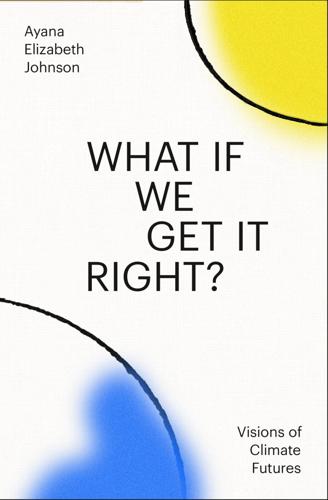
What If We Get It Right?: Visions of Climate Futures
by
Ayana Elizabeth Johnson
Published 17 Sep 2024
Franklin: You can put all these futures into the backdrop and make the movies entertaining. When I think about climate storytelling, a lot of the work that I admire is in the Black Panther franchise. Ayana: Yes, vibranium and maglev trains and green buildings and trolleys and that whole world they created is such a compelling vision of climate futurism without urban sprawl.[*113] Franklin: Exactly. Marvel Studios did not say, okay, we’re going to make a climate movie, let’s kick off Black Panther. No, they decided: We want to make Black Panther, we think there’s a ton of money to be made doing it, but implicit in making that movie is all of these other things.
…
And still today… in the twisting swirl of a million butterflies, the schools of fish fast twitching in the surf, and the delicate reaching up of vines; in the shared mind of a stampede pounding, or beneath ground, in the sound of mycelial nerves extending …this resounding language of connection is observed. But at some point the harmony was broken— a dissonance occurred… and slowly the new song of humankind was heard with words like: “manifest destiny”…“industrial revolution”…“dominion over all” …“survival of the fittest”…“urban sprawl”… And as the song of life became a solo a new thought began “Perhaps the world was not alive after all— but we were simply alive on it” And with that thought— the world became a fixed thing— it simply was; as the sun or space or rocks; as if it could never be diminished; as if our actions could never cause it harm; …but we were wrong.
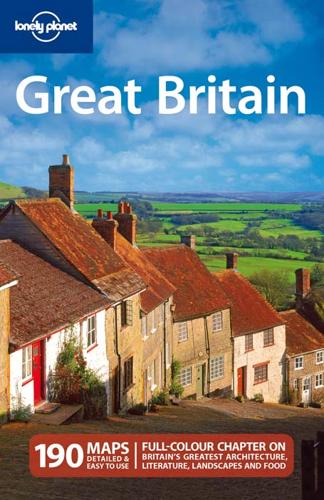
Great Britain
by
David Else
and
Fionn Davenport
Published 2 Jan 2007
BOAT Punts, canoes and rowing boats are available for hire from Avon Boating by Clopton Bridge – it’s under the Thai Boathouse restaurant. Return to beginning of chapter STAFFORDSHIRE Stoke-born novelist Arnold Bennett once wrote that Staffordshire was ‘unsung by searchers after the extreme’, but that doesn’t mean that it’s boring. Wedged between the urban sprawls of Birmingham and Manchester, the county is surprisingly beautiful, from rolling Cannock Chase, a magnet for walkers and cyclists, to the jagged backbone of the Peak District known as the Roaches. The stern might of Lichfield’s cathedral, the wild rides at Alton Towers, and the neoclassical mansion of Shugborough are among the county’s other charms.
…
Then in medieval times the town grew fat on the wool trade. It is also the birthplace of Charles Darwin (1809–82), who rocked the world with his theory of evolution. Orientation Shrewsbury’s near-island status helps preserve the Tudor and Jacobean streetscapes of its centre and protects it from unattractive urban sprawl. The train station is a five-minute walk northeast of the centre and is as far as you’ll need to venture. Information Library ( 01743-255300; Castle Gates; 9.30am-5pm Mon, Wed, Fri & Sat, 9.30am-8pm Tue & Thu, 1-4pm Sun) Free internet access. Royal Shrewsbury Hospital ( 01743-261000; Mytton Oak Rd) Tourist office ( 01743-281200; www.visitshrewsbury.com; Music Hall, The Square; 9.30am-5.30pm Mon-Sat, 10am-4pm Sun May-Sep, 10am-5pm Mon-Sat Oct-Apr) Guided 1½-hour walking tours (adult/child £3.50/1.50) leave the tourist office at 2.30pm Monday to Saturday, and 11am Sunday from May to September and at 2.30pm Saturday only from November to April.
…
The communities had to then rely on their own resources, gradually becoming reabsorbed into the war-band culture of the native Britons – for some generations soldiers had been recruited locally in any case. Orientation Hadrian’s Wall crosses beautiful, varied landscape. Starting in the lowlands of the Solway coast, it crosses the lush hills east of Carlisle to the bleak, windy ridge of basalt rock known as Whin Sill overlooking Northumberland National Park, and ends in the urban sprawl of Newcastle. The most spectacular section lies between Brampton and Corbridge. Carlisle, in the west, and Newcastle, in the east, are good starting points, but Brampton, Haltwhistle, Hexham and Corbridge all make good bases. The B6318 follows the course of the wall from the outskirts of Newcastle to Birdoswald; from Birdoswald to Carlisle it pays to have a detailed map.
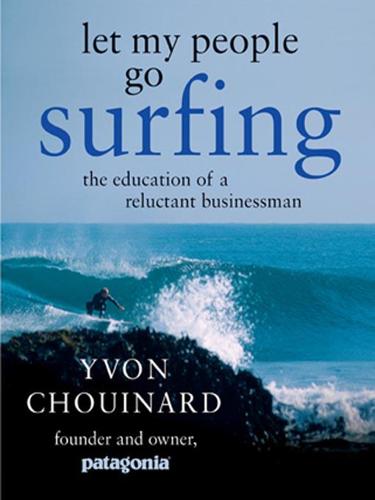
Let My People Go Surfing
by
Yvon Chouinard
Published 20 Jun 2006
People may be afraid of the term activist because they associate it with ecosabotage and violent protests, but I’m talking about normal citizens who want the government to live up to its obligation to protect our air, water, and all other natural resources. Activists have infectious passion about the issues they support, whether they are mothers fighting to clean up toxic landfills that are killing their children or farmers losing their fourth-generation family businesses to urban sprawl. These are the people on the front lines, trying either to make the government obey its own laws or to recognize the need for a new law. That’s why our earth tax, 1 percent of our net sales, goes primarily to them. I’ve learned from a lifetime of being outdoors that nature loves diversity. It hates monoculture and centralization.
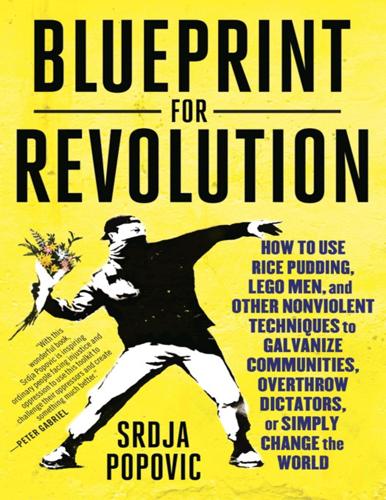
Blueprint for Revolution: How to Use Rice Pudding, Lego Men, and Other Nonviolent Techniques to Galvanize Communities, Overthrow Dictators, or Simply Change the World
by
Srdja Popovic
and
Matthew Miller
Published 3 Feb 2015
Between the temperature and the stress, it’s hard not to get headaches. Still, there’s one place in the city that’s relatively relaxing. It’s an arti cial beach on the eastern side of the island. While this beach is not much by the Maldives’ standards—it’s really just a thin strip of sand in the middle of the urban sprawl—the beach is your best option if you nd yourself in Malé and want to escape the city. Here, at least, there are a few open-air cafés facing the ocean that attract hip young Maldivians, and you can always see a few middle-aged men smoking hashish in the nearby bushes. Women dressed in burkas will bring their children to frolic in the surf, and depending on the season whole sections of the beachfront are taken over by either young surfers or skateboarders.

Protecting Pollinators
by
Jodi Helmer
Published 15 Nov 2019
This was despite the fact that most (73 percent) of the abstracts in individual studies used terms like accurate, reliable, and statistically similar to describe the data collected from citizen scientists; just 8 percent of researchers used terms like overestimated, contradictions, or no significant correlations to describe data from laypeople. Box 7-3 Pollinators Seek Out Urban Addresses How do pollinators fare among skyscrapers, freeways, and urban sprawl? Quite well, it turns out. One study showed that there were as many bees in urban landscapes as in farmland and nature reserves—and bee diversity was actually higher in cities than on farms. A separate study found that native bees provided adequate pollination services in San Francisco despite the urban setting.
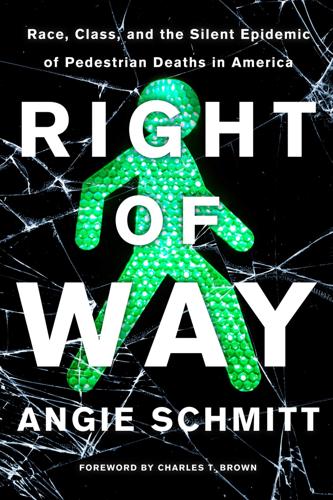
Right of Way: Race, Class, and the Silent Epidemic of Pedestrian Deaths in America
by
Angie Schmitt
Published 26 Aug 2020
(Photo: New York City DOT) Since New York City added a bike lane and a bus lane on Queens Boulevard, pedestrian deaths and injuries there have plummeted dramatically. (Photo: New York City DOT) Only eleven thousand people lived in Clayton County in 1940.22 Today’s population is more than two hundred times as large. Atlanta’s notorious urban sprawl has long since leap-frogged past Clayton County altogether, toward Henry and Fayette Counties to the south. Clayton County is now a suburban county. But the face of the suburbs is changing, and in many ways, the old infrastructure is ill-suited to this new era. Clayton County saw its first big boom in the mid-1970s, as blue-collar white workers flooded into the county, fleeing desegregation orders in the Atlanta public schools.
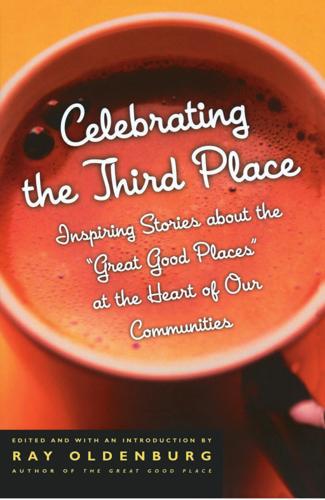
Celebrating the Third Place: Inspiring Stories About the Great Good Places at the Heart of Our Communities
by
Ray Oldenburg
Published 30 Nov 2001
Unlike European autobahns, our interstate highways were routed right through our cities such that local travelers found the roads congested by people who didn’t even want to be in town. Street systems were designed in such a way that most roads carry too little traffic while others carry too much. Unifunctional zoning encouraged urban sprawl such that not only do Americans have to drive everywhere they go but, their necessary destinations are farther away from home than are those of peoples in other countries are from their homes. Finally, the auto industry managed to kill the trolley systems and put forty vehicles on the road in place of the one vehicle that carried the same number of passengers.
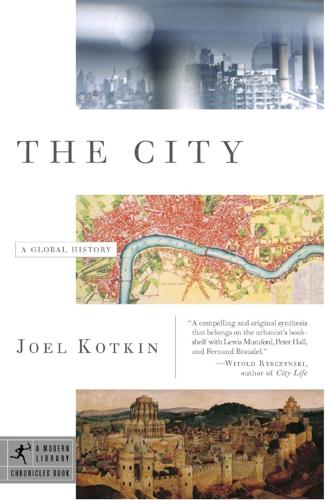
The City: A Global History
by
Joel Kotkin
Published 1 Jan 2005
Research provided by Eduourd Bomhoff, Nyber, Netherlands; Jennifer Ehrlich, “Liberal Netherlands Becomes Less So on Immigration,” Christian Science Monitor, December 19, 2003; Phillip Rees, Evert van Imhoff, Helen Durham, Marek Kupiszewski, and Darren Smith, “Internal Migration and Regional Population Dynamics in Europe: Netherlands Case Study,” Council of Europe, August 1998. 41. Jane Holtz Kay, “In Holland, the Pressures of American Style Urban Sprawl,” Christian Science Monitor, October 3, 2002. 42. Christian Kestletoot, “Brussels: Post Fordist Polarization in a Fordist Spatial Canvas,” in Globalizing Cities, op. cit., 186–210. 43. Martine Berger, “Trajectories in Living Space, Employment and Housing Stock: The Example of the Parisian Metropolis in the 1980s and 1990s” International Journal for Urban and Regional Research 20.2 (1996), 240–54; Fierro, op. cit., 19; Jean Robert, “Paris and the Ile de France: National Capital, World City,” in Europe’s Cities in the Late 20th Century, 17–22. 44.

The Rise and Fall of American Growth: The U.S. Standard of Living Since the Civil War (The Princeton Economic History of the Western World)
by
Robert J. Gordon
Published 12 Jan 2016
By maintaining the perspective of changes in the standard of living as viewed by the consumer, we omit most topics related to urban planning, urban politics, and the regulation of electric utilities. The spread of the city is treated in chapter 5, in which the development of the city is viewed as a corollary of a succession of transportation innovations that steadily increased the distance that was feasible to travel between the home and the workplace. Decisions that encouraged urban sprawl after World War II are reserved for chapter 10, on housing after 1940. Another deliberate omission from this chapter is the effect of the business cycle. The ease or difficulty of finding jobs varied across recession intervals and across decades, and the decline in the standard of living during the Great Depression stands out.
…
Howard Johnson’s 1925 drug-store soda fountain in Quincy, Massachusetts, began a chain of roadside restaurants that by 1939 had 132 franchised outlets and in the 1950s and 1960s had a dominant market position, with about 1,000 outlets.137 Harland Sanders developed his famous chicken recipe in 1930 at “Sanders’ Servistation” in Corbin, Kentucky; J. F. McCullough founded what became Dairy Queen in Kankakee, Illinois, in 1938.138 The victory of the motor vehicle was not without controversy. Government policies encouraged urban sprawl and undermined the financial viability of urban transit and passenger railways. Even before World War II, public policy was skewed in favor of the automobile by building streets and highways with public funds while leaving urban transit and the interurban electric railways to operate as self-sufficient private companies.
…
“Is a Cambrian Explosion Coming for Robotics?” Journal of Economic Perspectives 29, no. 3 (summer): 51–60. Prieto, Luis, and Sacristan, Jose A. (2003). “Problems and Solutions in Calculating Quality-Adjusted Life Years (QALYs),” Health Qual Life Outcomes, December 19. www.ricbi.nim.nih.gov/pmc/articles/PMC317370/. Puga, Diego. (2008). “Urban Sprawl: Causes and Consequences,” Eis Opuscles del CREI, no. 18 (January). Pursell, Carroll. (2007). The Machine in America: A Social History of Technology, 2nd ed. Baltimore, MD: The Johns Hopkins Press. Radde, Bruce. (1993). The Merritt Parkway. New Haven, CT/London: Yale University Press. Radford, Gail. (1992).
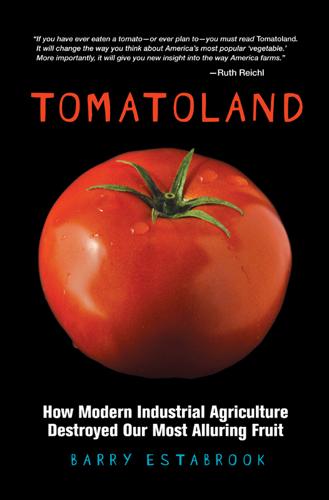
Tomatoland: How Modern Industrial Agriculture Destroyed Our Most Alluring Fruit
by
Barry Estabrook
Published 6 Jun 2011
Better methods will allow scientists to routinely address more complex traits, such as the elusive matter of taste, which is controlled by multiple genes. Chetelat said he viewed it as a time of opportunity. But, unfortunately, time could be running out for the wild populations upon which future discoveries may depend. Modern agricultural practices and urban sprawl eliminate habitat for wild tomatoes. Herds of goats, llamas, alpacas, and other domestic animals eat and trample them. Even though the Rick Center can produce seed from previously gathered wild specimens, thereby maintaining genetic lines, Chetelat insisted that collections preserved by humans, however carefully, are no substitute for what he calls “in situ” plants, meaning ones that grow in their native environments without human interference.
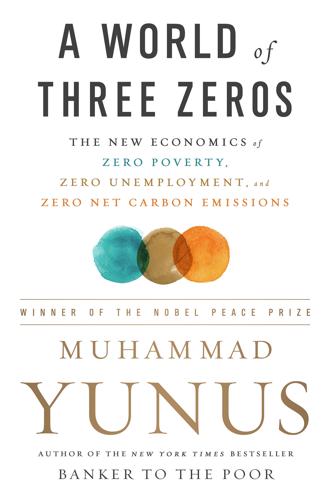
A World of Three Zeros: The New Economics of Zero Poverty, Zero Unemployment, and Zero Carbon Emissions
by
Muhammad Yunus
Published 25 Sep 2017
Of course, higher oil prices also drive up the cost of any activity that requires energy, including irrigation, running farm equipment, delivering goods to market, and shipping foods to and from processing plants. All of these economic and social problems are growing worse just as global environmental trends are threatening the future of agriculture around the world. Climate change and drought are turning vast areas that were once fertile farmlands into deserts. The need for new farmland and continuing urban sprawl are driving deforestation, which further accelerates global warming. Scientific simulations suggest that while climate change will slightly increase the total amount of land available for farming, the overall quality of croplands will decline. What’s more, the regions most vulnerable to loss of farmland are already some of the most economically troubled areas of the world, including sub-Saharan Africa, the Middle East, and North Africa.6 One of the countries that is most immediately impacted is my homeland of Bangladesh, the world’s most densely populated country, which is a flat country with 20 percent of its land less than 1 meter above sea level.

Everything Under the Sun: Toward a Brighter Future on a Small Blue Planet
by
Ian Hanington
Published 13 May 2012
Although it is encouraging to see more people take greater responsibility for the food they eat by choosing to buy local, we can’t let governments off the hook. Politicians need to support local agriculture by implementing policies and laws that protect farmland, ensure that farmers receive a fair price for the food they grow, and remove regulatory barriers that hinder farm-gate sales. The protection of rich agricultural soil from urban sprawl, roads, industrial development, and other land use must be central to any government local food strategy. Study after study has shown that valuable agricultural land around the world is being chewed up and paved over because of poor urban-planning decisions that value parking lots, new highways, and larger strip malls over keeping our precious bank of fertile soil for current and future generations of farmers to steward—for our benefit.
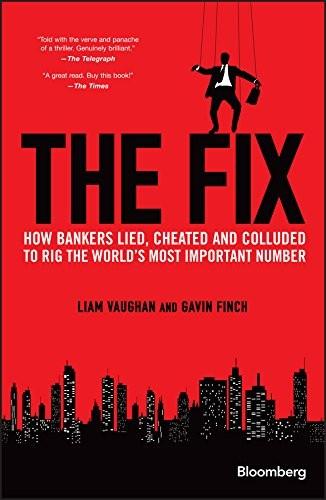
The Fix: How Bankers Lied, Cheated and Colluded to Rig the World's Most Important Number (Bloomberg)
by
Liam Vaughan
and
Gavin Finch
Published 22 Nov 2016
He’d only recently upgraded from the superhero duvet he’d slept under since he was eight years old. The Fix: How Bankers Lied, Cheated and Colluded to Rig the World’s Most Important Number By Liam Vaughan and Gavin Finch © 2017 Liam Vaughan and Gavin Finch Chapter 2 Tommy Chocolate T homas Alexander William Hayes had always been an outsider. Born in 1979 and raised in the urban sprawl of Hammersmith, West London, Hayes was bright but found it hard to connect with other kids. His parents divorced when he was in primary school. When his mother Sandra remarried, she took Hayes and his younger brother Robin to live with her new husband, a management consultant, and his two children in the leafy, affluent commuter town of Winchester, bordering a stretch of bucolic countryside in the south of England.

Radical Cities: Across Latin America in Search of a New Architecture
by
Justin McGuirk
Published 15 Feb 2014
Contractors don’t even need an architect on board to get funding from Caixa, the National Housing Bank – an engineer’s signature will do. And you can tell. These flimsy towers and rudimentary housing blocks have no architectural aspirations at all. For the poorest, MCMV is providing worse housing than was built at City of God in the late 1960s. History is repeating itself, and the result is yet more urban sprawl. The lessons of John Turner, PREVI and even Favela-Bairro appear not to have been learnt. The notion of conveniently located, self-built, adaptable housing has been rejected in favour of the construction industry’s profits. I spoke to a veteran of Brazilian social housing strategies, Ephim Shluger, who spent thirty years working as an architect for UNICEF and the World Bank, and he painted a very clear picture.
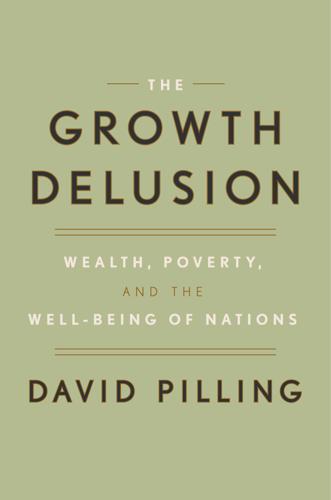
The Growth Delusion: Wealth, Poverty, and the Well-Being of Nations
by
David Pilling
Published 30 Jan 2018
You could increase GDP, say by building on greenfield sites or getting people to work longer hours, but in GPI terms the positive of higher economic output was offset by the negatives of natural destruction or the loss of leisure time. In explaining the GPI’s rationale, the department’s website gives the example of economic expansion resulting from the “explosive growth of urban sprawl.” All that activity in construction, new sewerage systems, new roads, and new cars counts toward growth, but sprawl is also associated with several costs such as longer commutes, loss of community, destruction of natural land, as well as water and air pollution. “Just because we are exchanging money within an economy does not necessarily mean that we are sustainable or prosperous.”
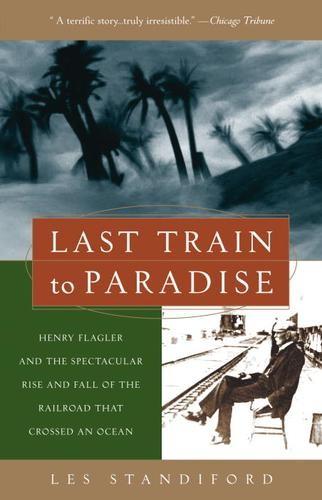
Last Train to Paradise: Henry Flagler and the Spectacular Rise and Fall of the Railroad That Crossed an Ocean
by
Les Standiford
Published 4 Aug 2003
It’s a thought that won’t go away, despite another interlude of landlocked driving through Grassy Key, a spot so isolated that big-city aquaria and water theme parks regularly send their overstressed dolphins to the marine research center here for a little R and R. After Grassy Key comes Crawl Key, and next Key Vaca, and the sudden quasi-urban sprawl of Marathon, where actual airplanes are tethered along the narrow runway at highwayside. There is a plethora of motels and restaurants in Marathon, most of them there to service the moneyed sport fishermen who have come to pursue the more than four hundred varieties of fish that are said to live in the waters surrounding the Keys.

Uprooting: From the Caribbean to the Countryside - Finding Home in an English Country Garden
by
Marchelle Farrell
Published 2 Aug 2023
A few years later, and we were finally in our own garden, my parents having proudly managed to buy our family a home in one of the city’s most beautiful suburbs. They had achieved the holy grail of the model we were all taught to aspire to by our colonial betters, where every man’s home was his castle: they had arrived at home ownership. In the concrete urban sprawl of Port of Spain, the St Ann’s and Cascade Valley gleamed a green oasis. It was home to the President’s House, former abode of the British governor generals who claimed the island in colonial times, and tried to establish profitable plantations and keep the diverse and unruly population in check.
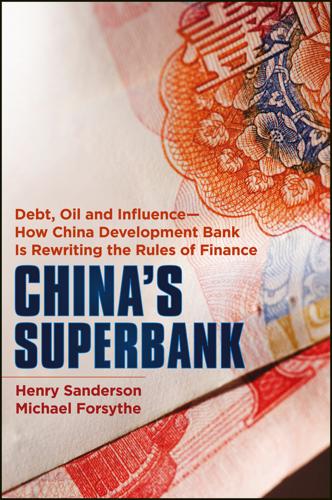
China's Superbank
by
Henry Sanderson
and
Michael Forsythe
Published 26 Sep 2012
An Austrian reporter on the bus hurtling southwest from the capital toward the city of Baoding was alarmed. In Vienna, these pollution levels—over 200 on the US Environmental Protection Agency particulate scale and classified as “very unhealthy”—would have sparked a national emergency, he remarked. Beijing’s urban sprawl soon gave way to farmland, with the contrast between the flawless and underused six-lane expressway and poor workers tending the land by hand a reminder of the China Development Bank (CDB)–led infrastructure boom and the imbalances it helped exacerbate. The bus was on its way to a place that offered a solution to China’s pollution woes—the global headquarters of Yingli Green Energy Holding Co.

Age of the City: Why Our Future Will Be Won or Lost Together
by
Ian Goldin
and
Tom Lee-Devlin
Published 21 Jun 2023
Back in 2000, long before Facebook, Twitter or Reddit came into existence, the sociologist Robert Putnam released his ground-breaking book Bowling Alone, in which he traced the declining participation in the voluntary associations that had historically played such an important role in building trust among citizens from all walks of life.4 Too much time in front of the television, and to a lesser extent growing commute times as a result of urban sprawl, were the main culprits in that decline, not the internet.5 And political partisanship in the US has been deepening since at least the mid-1990s when Newt Gingrich took over as House Speaker and shifted the tone of political debate.6 What the internet has done is pour fuel on the flame. By allowing people to filter what they see and with whom they interact, social media has increasingly broken down the bridges of shared experience and mutual comprehension on which the healthy functioning of society relies.
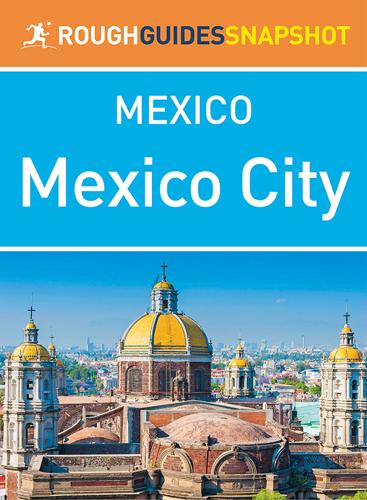
Mexico - Mexico City
by
Rough Guides
It formerly hosted a number of weekend amusement park-type attractions, but those are all now closed, and the space is now used mainly by joggers who live in the surrounding neighbourhoods. < Back to Bosque de Chapultepec SOUTH OF THE CENTRE Getting to the southern suburbs Insurgentes San Ángel Coyoacán El Pedregal Calzada de Tlalpan Xochimilco Mexico City spreads itself furthest to the south, where a series of old villages has been swallowed up by the urban sprawl. These harbour some of the most enticing destinations outside the centre, including the colonial suburbs of Coyoacán and San Ángel, the archeological site of Cuicuilco and the canals of Xochimilco. GETTING TO THE SOUTHERN SUBURBS It’s not at all difficult to get out to any of the sights outside the city centre on public transport, but getting from one to the other can be tricky if you’re cutting across the main north–south routes.
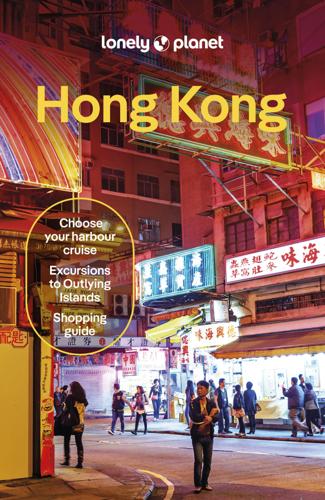
Lonely Planet Hong Kong
by
Lonely Planet
Eating in Wan Chai: Delectable Dessert Shops Ching Ching Desserts: Serving some of the city’s best black-sesame sweet soup and ginger syrup dumplings. 1-11pm $ Tsui Yuen Dessert: One for traditional dessert fans who love hot walnut-and-sesame paste and steamed milk desserts. noon-11.30pm $ C Dessert: Hot and cold treats like coconut milk grass jelly with mochi, mango pudding and durian desserts. 1-11pm Mon-Fri; to midnight Sat & Sun $ La Creperie: A charming creperie serving delicious savoury galettes and light crepes topped with ice cream, fruit and chocolate. hours vary $$ Aberdeen & South Hong Kong Island BOATS, BEACHES AND SEAVIEW BEERS Once a refuge for pirates and smugglers, the craggy southern reaches of Hong Kong Island are an easy-going, outdoorsy counterpoint to the north’s urban sprawl. Giant panda, Ocean Park | Lee Yiu Tung/Shutterstock © As Hong Kong Island’s backyard, the south swaps board meetings and quarterly targets for beach barbecues, golf greens and yacht marinas. The vibe changes from place to place as you traverse miles of precipitous coast: yuppie Repulse Bay is a different world to the surf shacks of Big Wave Bay, while out on the wave-lashed Shek O Peninsula, Central’s skyscrapers might as well belong to another universe.
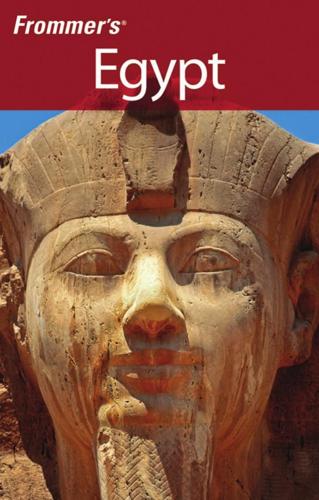
Frommer's Egypt
by
Matthew Carrington
Published 8 Sep 2008
Kids The Pyramids It’s a cliché, but there’s really no sight like them. For sheer, dominating bulk, the pyramids on Giza have got pretty well everywhere else in the world beat. It used to be that you came upon them slowly, riding on horseback across the green fields that separated the plateau from the city. Nowadays, urban sprawl laps at the very feet of the Sphinx himself, and by the time you see the pyramids, they’re right on top of you. It’s a moment that you’ll never forget. The Great Pyramid of Khufu is the first one you come to. The entrance is on the north face, and once inside, you face a long and uncomfortable scramble to the Great Gallery, which is some 47m (154 ft.) long and 8.5m (28 ft.) high.
…
On the north coast, as with much of Egypt, you have to develop the trick of 09_259290-ch06.qxp 7/22/08 12:31 AM Page 128 Northern Egypt 0 50 mi N 0 50 km M e d i t e r r a n e a n Sidi Barrani Salum Marsa Matruh N O R T H Area of detail EGYPT Sidi abd al Rahmen 3 200 mi Q Siwa Oasis 2 El-Alamein War Cemet C Red Sea Hixj el-Qatar 0 1 Nile Cairo Zawyat Sidi Musa A T T A R A N SIO ES PR E D Qara Oasis seeing through a thick layer of urban sprawl that has taken place in the last 30 or 40 years, as well as past the decay that has accompanied it. Many miles of once pristine beach both east and west of Alexandria have been obscured by swathes of cheap concrete “holiday village” development, and the city itself has swelled from a population of 1 million in the 1960s to almost 4 times that today, with some of the growth going into new, unplanned neighborhoods and the rest being absorbed into the neglected housing of Alexandria’s old quarters.
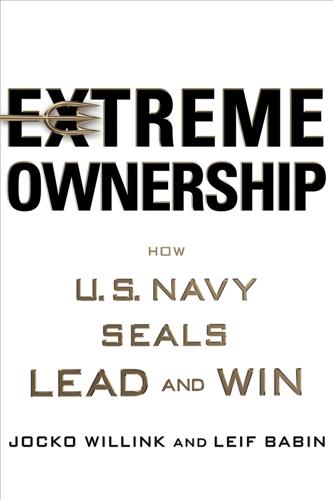
Extreme Ownership: How U.S. Navy SEALs Lead and Win
by
Jocko Willink
and
Leif Babin
Published 19 Oct 2015
Army and Marine Corps battalions and thousands of Soldiers and Marines on the ground, were operating on the same battle map, which was crucial. But matching the numbers and street names on the map to what we were seeing in front of us on the ground could be quite a challenge. Here there were no streets signs or address numbers. This was Ramadi. Amid the urban sprawl of trash-covered streets and alleyways were huge bomb craters and walls pockmarked by bullets and spray-painted with Arabic jihadist graffiti, which our interpreters translated for us, such as: “We will fight until we reach either of the two heavens: victory or martyrdom.” We were here to ensure it was the latter.
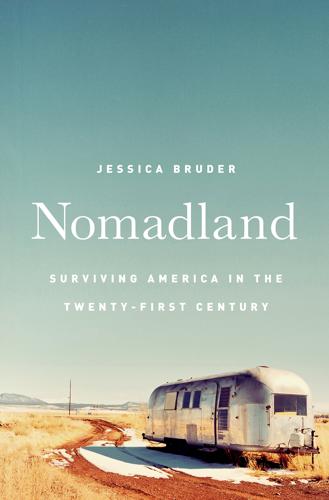
Nomadland: Surviving America in the Twenty-First Century
by
Jessica Bruder
Published 18 Sep 2017
The Squeeze Inn was waiting in storage on the outskirts of Perris, a town on the far side of the Santa Ana Mountains, one of the peninsular ranges that separate California’s coastal region from its harsher desert interior. Getting there meant traveling the Ortega Highway. This is one of the most dangerous roads in the state, “a place where urban sprawl, bad driving and obsolete road-building techniques collide head-on,” in the words of one Los Angeles Times reporter. The winding thoroughfare is often clogged with commuters shuttling between Orange County and the Inland Empire, but at midday, traffic was mercifully light. Before long, Linda was on the other side, driving past some of the half-dozen trailer parks that cling like barnacle colonies to the western edge of Lake Elsinore.
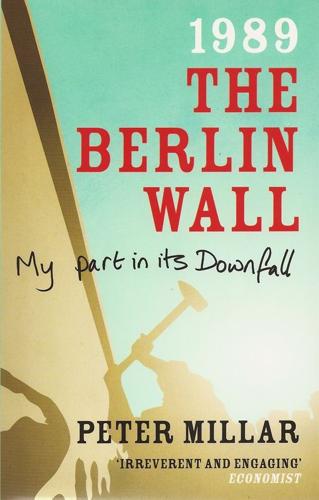
1989 The Berlin Wall: My Part in Its Downfall
by
Peter Millar
Published 1 Oct 2009
To the inhabitants of such fringe suburbs the sudden severing of their lifelines to the city they thought they belonged to was unbelievable. Teltow was little more than a straggle of streets where the Greater Berlin that had grown up in the nineteenth century sprawled out into the countryside. On its own it was nothing, yet now, literally overnight, this little overflow of urban sprawl had been designated a rural village. It was an anomaly on a par with the ‘walled garden’ allotments I had seen from my helicopter tour when I first arrived. It was true that Pieps and his neighbours could still drive into ‘Berlin’ – at least the eastern half of it – but now it was a journey of some forty kilometres just to reach the edge of the city and when they did it was a part they were completely unfamiliar with.
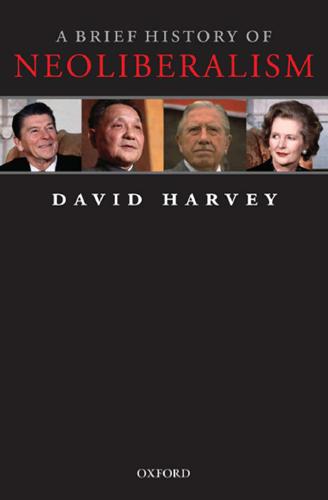
A Brief History of Neoliberalism
by
David Harvey
Published 2 Jan 1995
The Pentagon also argues that global warming might well in the long run be a more serious threat to the security of the US than terrorism.28 Interestingly, the two main culprits in the growth of carbon dioxide emissions these last few years have been the powerhouses of the global economy, the US and China (which increased its emissions by 45 per cent over the past decade). In the US, substantial progress has been made in increasing energy efficiency in industry and residential construction. The profligacy in this case largely derives from the kind of consumerism that continues to encourage high-energy-consuming suburban and ex-urban sprawl and a culture that opts to purchase gas-guzzling SUVs rather than the more energy-efficient cars that are available. Increasing US dependency on imported oil has obvious geopolitical ramifications. In the case of China, the rapidity of industrialization and of the growth of car ownership doubles the pressure on energy consumption.
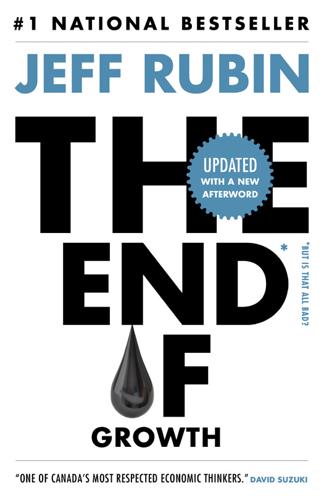
The End of Growth
by
Jeff Rubin
Published 2 Sep 2013
CHAPTER 6: THE DANISH RESPONSE this page: Information about Denmark’s environmental track record, including its level of carbon dioxide emissions since 1990, comes from figures available through the State of Green, a government-backed initiative to raise international awareness of the country’s green credentials (www.stateofgreen.com). this page: The argument for the relationship between urban population density and vibrant cities is well documented. Jane Jacobs, for one, argued convincingly against urban sprawl in her seminal work The Death and Life of Great American Cities, which has influenced thoughts on urban planning since its publication in 1961. CHAPTER 7: ZERO-SUM WORLD this page: The figures for Venezuela’s oil exports to the United States come from the EIA. US oil imports from Venezuela reached a high of 1.77 million barrels a day in 1997.
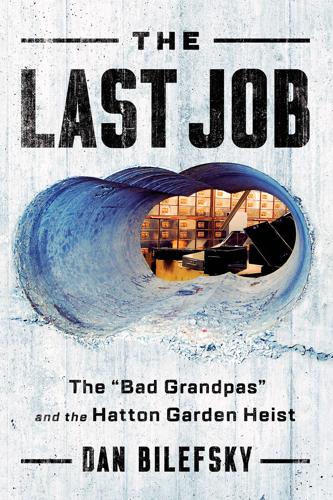
The Last Job: The Bad Grandpas and the Hatton Garden Heist
by
Dan Bilefsky
Published 22 Apr 2019
As the two security guards were preparing to leave for the night, Reader paid his bus fare with a special travel pass for senior citizens—registered to his longtime alias, Mr. T. McCarthy—and then began an eighty-minute journey to Hatton Garden. As the 96 bus edged its way through the city, the tree-lined streets of Kent soon gave way to the capital’s urban sprawl. If Reader and the gang could pull off the caper, his children and grandchildren would never have to work again. And he would go down among the London criminal fraternity as “the Master” his contemporaries grudgingly revered. The enormity of what he and the others were about to attempt must have been flashing through his mind as the streets of London rushed by the bus’s windows.
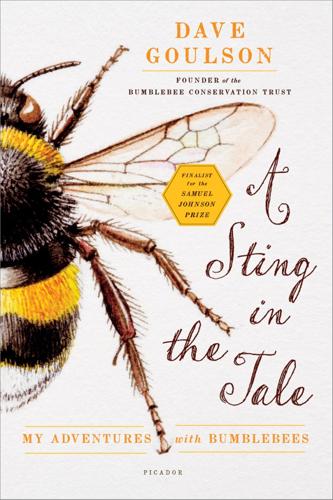
A Sting in the Tale
by
Dave Goulson
Published 24 Apr 2013
If the biota, in the course of aeons, has built something we like but do not understand, then who but a fool would discard seemingly useless parts? To keep every cog and wheel is the first precaution of intelligent tinkering. Aldo Leopold Prologue My interest in bumblebees and other insects dates back to the age of seven, when my family and I moved from a small semi-detached house on the edge of Birmingham’s urban sprawl to a little village called Edgmond in Shropshire. My father had been brought up close by in the market town of Newport and, being a schoolteacher, he was keen that his two sons should get a good education. Newport had, and still has, a fine grammar school, the school which my father had attended and to which he hoped my brother and I would go, provided we could pass the entrance exam.

The New Class Conflict
by
Joel Kotkin
Published 31 Aug 2014
,” CNN, June 21, 2008; Richard Morrill, “The Geography of Class in Greater Seattle,” New Geography, June 16, 2009, http://www.newgeography.com/content/00857-the-geography-class-greater-seattle; interview with author. 89. Pew Research Social & Demographic Trends, “Suburbs Not Most Popular, But Suburbanites Most Content,” February 26, 2009, http://www.pewsocialtrends.org/2009/02/26/suburbs-not-most-popular-but-suburbanites-most-content; Jan K. Bruekner and Ann G. Largey, “Social Interaction and Urban Sprawl,” October 2006; Ed Braddy, “Smart Growth and the New Newspeak,” New Geography, April 4, 2012, http://www.newgeography.com/content/002740-smart-growth-and-the-new-newspeak; Brookings Institution Metropolitan Policy Program, “State of Metropolitan America: On the Front Lines of Demographic Transformation,” report, 2010, http://www.brookings.edu/~/media/Files/Programs/Metro/state_of_metro_america/metro_america_report.pdf; Elizabeth Kneebone and Jane Williams, “New Census Data Underscore Metro Poverty’s Persistence in 2012,” Brookings, September 19, 2013, http://www.brookings.edu/research/reports/2013/09/19-census-data-poverty-kneebone-williams. 90.
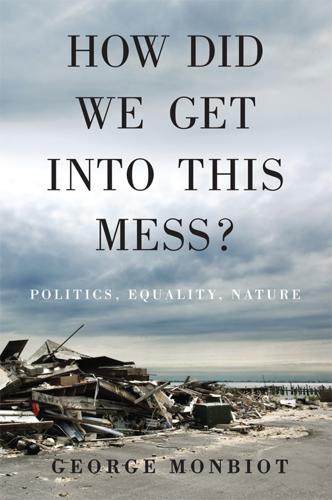
How Did We Get Into This Mess?: Politics, Equality, Nature
by
George Monbiot
Published 14 Apr 2016
They ‘levy a toll upon all other forms of wealth and every form of industry’.14 Land value tax recoups this toll. It has a number of other benefits.15 It stops the speculative land hoarding that prevents homes from being built. It ensures that the most valuable real estate – in city centres – is developed first, discouraging urban sprawl. It prevents speculative property bubbles, of the kind that have recently trashed the economies of Ireland, Spain and other nations and which make rents and first homes so hard to afford. Because it does not affect the supply of land (they stopped making it some time ago), it cannot cause the rents that people must pay to the landlords to be raised.

DarkMarket: Cyberthieves, Cybercops and You
by
Misha Glenny
Published 3 Oct 2011
His successful work in South Africa was noticed further up the Anglican Church’s hierarchy and, after eight years, the Bishop of Bradford in the English county of West Yorkshire urged him to consider an equally challenging post in Manningham, a residential district on the edge of Bradford city centre. The Reverend John was reluctant – England had always struck him as a rather gloomy place, with its miserable weather and urban sprawl. Equally, he knew that Manningham was no bed of roses. Many Britons regarded Bradford, and Manningham in particular, as a symbol of their country’s failing attempts to integrate its many ethnic and confessional groups. More malignant types saw in Manningham an opportunity to ratchet up the mistrust between those communities.
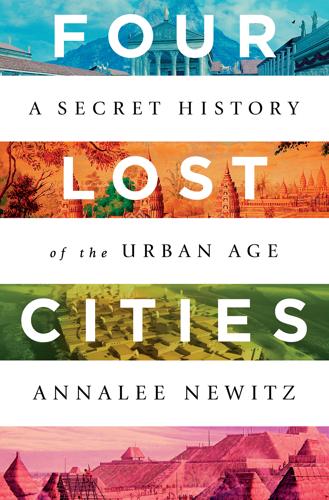
Four Lost Cities: A Secret History of the Urban Age
by
Annalee Newitz
Published 2 Feb 2021
When European archaeologists first visited Angkor, they were conditioned to look for Western modes of urban development, and thus the vast majority of homes in the city remained invisible to them. They made a beeline for the stone towers of Angkor Wat and Angkor Thom, mistaking these temple complexes for small walled cities, instead of walled compounds within a massive urban sprawl. They completely missed the once-packed neighborhoods, reservoirs, and farms that had left their marks on the land for acres around. Everything is better with lasers It became very obvious to me how archaeologists could make that mistake when I visited Sambor Prei Kuk, once the crowded capital city of the seventh-century Chenla Empire in Cambodia.
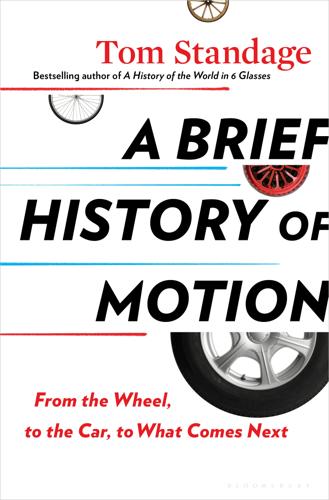
A Brief History of Motion: From the Wheel, to the Car, to What Comes Next
by
Tom Standage
Published 16 Aug 2021
In 1970, when the 1954 tax loophole started to be closed, America had more than thirteen thousand shopping centers (including enclosed malls), nearly all of which had been constructed in the previous fifteen years in suburban areas, accelerating the decline of traditional downtowns. “Downtown Has Fled to the Suburbs,” noted Fortune magazine in 1972. By the 1970s Gruen had come to regret his creation, and in particular what he called “the land-wasting seas of parking” at malls, and their contribution to urban sprawl. He decided to move back to his beloved Vienna. But even there he was horrified to find, just south of the city, a “gigantic shopping machine”—a Southdale-style mall. In 1978, two years before his death, he gave a speech in London entitled “The Sad Story of Shopping Centers,” in which he formally renounced shopping malls as a perversion of his original vision: “I am often called the father of the shopping mall.
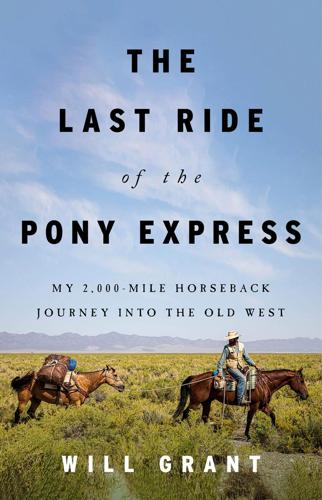
The Last Ride of the Pony Express: My 2,000-Mile Horseback Journey Into the Old West
by
Will Grant
Published 14 Oct 2023
It was also a trailhead, and a dozen cars were parked in the parking lot. People in tight-fitting, brightly colored clothes were gearing up for a hike. Two people with mountain bikes were making adjustments to one of their bikes, which stood upside down on the gravel lot. To the west, the Salt Lake Valley sat under a thick haze. The urban sprawl stretched out like a ragged, multicolored canvas spread over the valley floor. I unloaded Chicken Fry and unsaddled Badger in the shade of an aspen grove and took a nap leaning against my saddle and holding their lead ropes. A few hours later, Trever Carpenter rolled into the parking lot with his horse trailer and drove me around the city
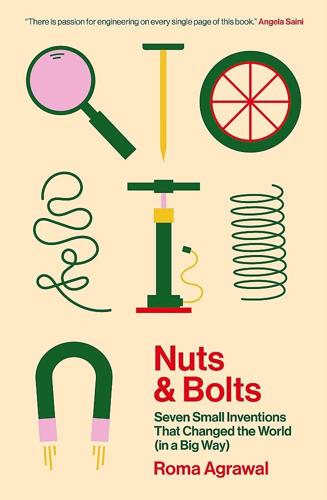
Nuts and Bolts: Seven Small Inventions That Changed the World (In a Big Way)
by
Roma Agrawal
Published 2 Mar 2023
Or, a city of compromise, with homes away from infrastructure, leading to long commutes, and venues that have to separate plant and usable rooms, meaning expensive pumps and a lack of space, and limits on the height and depth of what we can build. But, thanks to springs, we can shape silence. We can build dense cities to reduce urban sprawl. We can build new things underground without severely impacting what’s already there. Although hidden, springs have had a lasting impact, not only on a huge range of the small stuff that we use every day, as well as on our larger machines and factories, but also on the very shape of our urban landscape.

Learning to Think: A Memoir
by
Tracy King
Published 12 Mar 2025
The only safe places were home with Jackie and Emily, or the solitude of my wanderings. I had a whole new territory to explore. Birmingham airport was not far away and surrounded by fields. The bluebell woods of Jackie’s courting days were now another council estate, but I was as happy to explore urban sprawl as nature. Little cut-throughs and gullies, dead ends leading to unattended blocks of garages, unexpected corner shops in residential enclaves. I never went back to school. A truancy officer knocked on our door one afternoon and was surprised to find me at home with Jackie. From there, a child psychologist came round to the house, and I was given a bunch of psychometric tests to figure out what sort of disobedience they could diagnose me with (I still have the tests; they’re not supposed to be used on children).
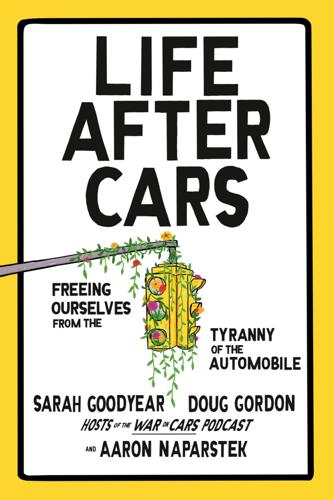
Life After Cars: Freeing Ourselves From the Tyranny of the Automobile
by
Sarah Goodyear
,
Doug Gordon
and
Aaron Naparstek
Published 21 Oct 2025
After the driver loads the garbage he’s collected into the back of the vehicle, he sits and watches with benevolent self-satisfaction as baby turtles emerge from the sand and crawl over the beach. Kia called the spot “Beachcomber.” On Reddit, the savior dude came to be known as Sea Turtle Jesus, and he was roundly ridiculed. As one commenter said there, “Nothing says ‘save our planet!!!!’ like driving a 3-ton, microplastic and COx-noxious-emitting urban sprawl tank immediately next to a rapidly acidifying ocean.” While advocacy groups might struggle to break through the cluttered media landscape and communicate the gravity of the climate crisis, carmakers don’t have that problem. They are the clutter. The auto industry, in fact, has made the ability to access nature a core part of its own lavishly funded messaging campaigns.
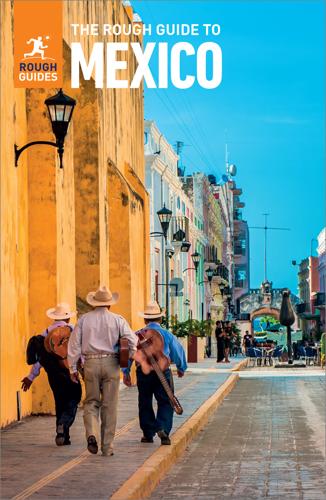
The Rough Guide to Mexico
by
Rough Guides
Published 15 Jan 2022
Bugs have been culinary delicacies in Mexico since Aztec times, with some of the most popular cocopaches (a type of cockroach), chicatanas (flying ants) and escamoles (ant larvae and pupae). Some 66 million years ago the Chicxulub asteroid crashed into the Yucatán Peninsula, dramatically disrupting the climate around the world and triggering the extinction of the dinosaurs. Where to go Mexico City, though a nightmare of urban sprawl, is totally fascinating, and in every way – artistic, political, cultural – the capital of the nation. Around the city lie the chief relics of the pre-Hispanic cultures of central Mexico: the massive pyramids of Teotihuacán and the main Toltec site at Tula. Guadalajara, to the west, is a city on a more human scale, capital of the state of Jalisco and in easy reach of Michoacán: between them, these states share some of the most gently scenic country in Mexico, where the thickly forested hills are studded with lakes and ancient villages.
…
It formerly hosted a number of weekend amusement park-type attractions, but those are all now closed, and the space is now a climate-change PR project, with supposedly the most ambitious inner-city forest-planting plan on the planet, if you believe the hype (very few specific details have actually been released, such as the number of saplings planted or how extensive the project will be). It is, however, a top spot for sunset pictures, among leafy green surrounds. South of the centre Mexico City spreads itself furthest to the south, where a series of old villages has been swallowed up by the urban sprawl. These harbour some of the most enticing destinations outside the centre, including the colonial suburbs of Coyoacán and San Ángel, the archeological site of Cuicuilco and the canals of Xochimilco. Getting to the southern suburbs It’s not at all difficult to get out to any of the sights outside the city centre on public transport, but getting from one to the other can be tricky if you’re cutting across the main north–south routes.
…
San Pedro Tlaquepaque 5km southeast of the centre • #275 or TUR bus from the centre (16 de Septiembre) to Niños Héroes with Independencia (just after a brick pedestrian bridge and traffic circle), then walk down Independencia to El Parian TLAQUEPAQUE (officially San Pedro Tlaquepaque) is famous for its artesanías and its mariachi bands. Once a separate town, it has long since been absorbed by urban sprawl, and most of its traditional crafts taken over by chichi designer-furniture and jewellery stores, but you can still find crafts such as ceramics, glass, jewellery and textiles. Prices are high, but so are standards, and there are usually some moderately priced ceramics and glassware. Tlaquepaque centres around a pleasantly laid-back main square complete with bandstand, on whose north side is the blockish church of San Pedro.
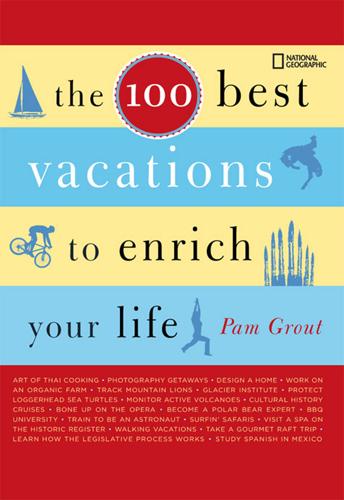
The 100 Best Vacations to Enrich Your Life
by
Pam Grout
Published 14 May 2007
“America is based on pilgrims coming over here and knocking together log cabins,” says Patrice Hennin, founder of the Shelter Institute. “Everyone, deep down in his heart, knows he can build a house. It’s not as if we’re sending rockets to the moon here; we’re just building houses.” Arcosanti. This experimental town in the high desert of Arizona offers workshops in building throughout the year that focus on eliminating urban sprawl and lessening our impact on Mother Earth. A one-week workshop, including meals and dorm- or apartment-style accommodations, is $475 and includes seminars explaining the concept of “arcology” (architecture with an eye toward ecology), tours around the alternative urban site, and a silt-casting workshop.
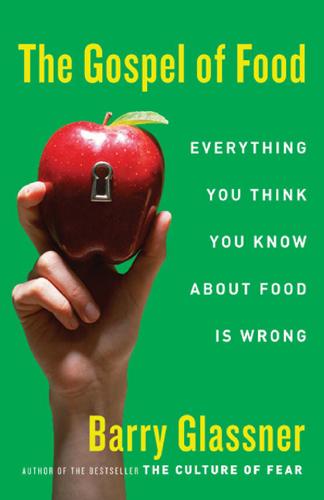
The Gospel of Food: Everything You Think You Know About Food Is Wrong
by
Barry Glassner
Published 15 Feb 2007
Failing to acknowledge how valuable these are for tens of thousands of families who don’t have access to safe and well-equipped playgrounds, Schlosser sees them only in a 158 The Gospel of Food marketing context, as lures to incite children to beg their parents to bring them in.30 Critics blame fast food for every modern-day ill from heart disease and cancer to crime and urban sprawl. According to an article in the Ecologist, “no corner of the Earth is safe from its presence and no aspect of life is unaffected.” Joe Kincheloe, a professor of education at Brooklyn College, actually suggests that McDonald’s is responsible for Japanese children’s losing their facility with chopsticks.31 McDonald’s engages in a “cultural pedagogy” that produces “disciplined subjects” with “colonized desires” and a “commodified identity,” Kincheloe explains in a book published by Temple University Press that is part of a large body of writing by academics who use rarefied language from social and literary theory to discuss “the McDonaldization of society,” as the title of a much discussed book put it.
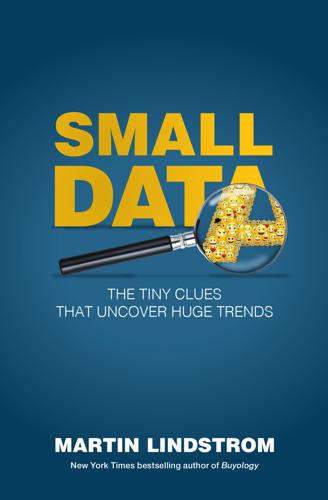
Small Data: The Tiny Clues That Uncover Huge Trends
by
Martin Lindstrom
Published 23 Feb 2016
The sameness of everything has a numbing effect, just as it did for the Norwegian writer Karl Ove Knausgaard who, assigned to take a road trip across North America for the New York Times Magazine last year, wrote, “Ever since I landed in Cleveland the previous day, the landscape had been the same, a sort of centerless, semi-urban sprawl of highways, subdivisions, shopping malls, warehouses, gas stations and factories.”1 Nothing in the landscape, he wrote, felt surprising or natural. Concluded Knausgaard, “I was supposed to write something about this trip, and not only that, I was supposed to use this trip to grasp something essential about the United States, perceive something with my foreign gaze that Americans couldn’t see for themselves.
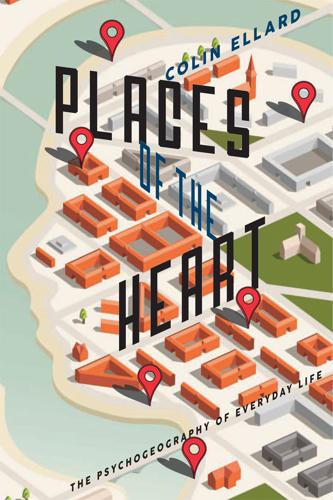
Places of the Heart: The Psychogeography of Everyday Life
by
Colin Ellard
Published 14 May 2015
Mark Rosenzweig described the effects of experience on brain chemistry in anatomy in a book written with Michael Renner titled Enriched and Impoverished Environments: Effects on Brain and Behavior (Springer, New York, 1987). 9Stuart Grassian has written a lengthy report on the psychiatric effects of solitary confinement for the Washington University Journal of Law and Policy (2006, Volume 22), available at: http://openscholarship.wustl.edu/law_journal_law_policy/vol22/iss1/24. 10Aisling Mulligan and colleagues described the influence of the home environment on the development of ADHD in an article titled “Home Environment: Association with Hyperactivity/Impulsivity in Children with ADHD and their Non-ADHD Siblings,” in the journal Child: Care, Health and Development (2013, Volume 39, pages 202–212). 11Robert Venturi and colleagues Denise Brown and Steven Izenour described the iconography of urban sprawl in Las Vegas in their controversial book Learning From Las Vegas (MIT Press, Cambridge, 1972). 12Sarah Goldhagen laments the multiple failures of architectural education in an article titled “Our Degraded Public Realm: Multiple Failures of Architecture Education,” in the January 10, 2003 issue of the Chronicle Review, available on her website (along with many other interesting articles): http://www.sarahwilliamsgoldhagen.com/articles/multiple_failures_of_architecture_education.pdf 13Janette Sadik-Khan, New York City’s Department of Transportation Commissioner, has made numerous improvements to pedestrian life in the city.
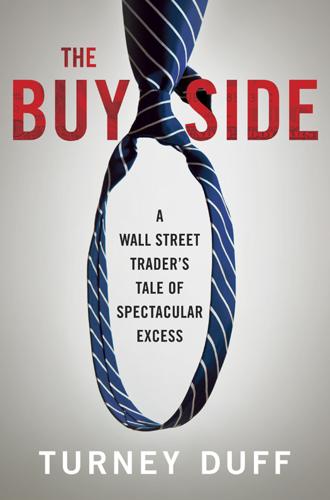
The Buy Side: A Wall Street Trader's Tale of Spectacular Excess
by
Turney Duff
Published 3 Jun 2013
“Bill’s mine,” he says as he reaches for my bags. “I got ’em,” I say. I must look weaker than I thought. Bill and I walk across the airport parking lot to a maroon van. It’s about a thirty-minute drive to the facility. I spend the first part just looking out the window at the sights, the usual just-outside-the-airport urban sprawl of highway cloverleafs and chain stores. I can’t believe I’m going to rehab. “What’s your drug of choice?” Bill asks, breaking the silence. “Cocaine and alcohol, I guess. Do you work for the rehab?” “I’m retired but I work for the center a few days a week doing whatever they need. I like to be around it.

No Ordinary Disruption: The Four Global Forces Breaking All the Trends
by
Richard Dobbs
and
James Manyika
Published 12 May 2015
Emerging-market megacities such as Shanghai and Mumbai are already home to some of the priciest commercial real estate in the world. In built-up areas, infrastructure can get congested easily, further raising the cost and unpredictability of doing business. Some Latin American and Asian cities are beginning to lose their power as engines of prosperity because they are clogged with traffic, scarred by urban sprawl, polluted, and crime ridden. Any visitor to Jakarta is familiar with the traffic gridlock that results from 1.5 million vehicles using roads designed for 1 million. Traffic congestion alone costs Indonesia’s capital city an estimated $1 billion a year in lost productivity.33 In Mercer’s Annual Cost of Living survey, the most expensive city for business isn’t San Francisco or Tokyo.
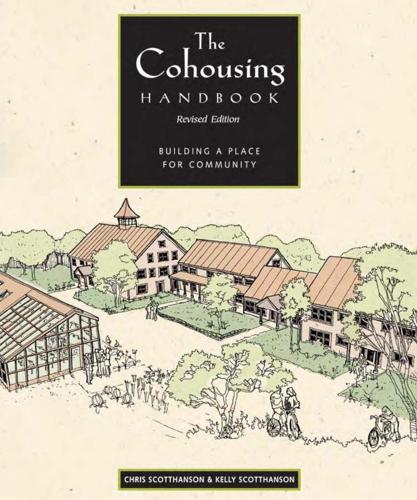
The Cohousing Handbook: Building a Place for Community
by
Chris Scotthanson
and
Kelly Scotthanson
Published 1 Nov 2004
. • Many alternative materials and systems cost more. Do now what you can’t do later • Detail your foundation for radon pre-mitigation. ☞ ENVIRONMENT The decision between a rural or urban location is a difficult one. If everyone chose to move out into the country and build new, what we would have would be more urban sprawl. With the sprawl we have suburbia, and the complete destruction of the natural environment. It seems to me that true environmentalists would choose to live in the high density of the city, doing their part to protect the natural environment from further development. It is possible for your community to choose an urban location, even a tiny site, or a few of fioors in a high-rise, and then buy some rural agricultural land to be owned and managed by the community.
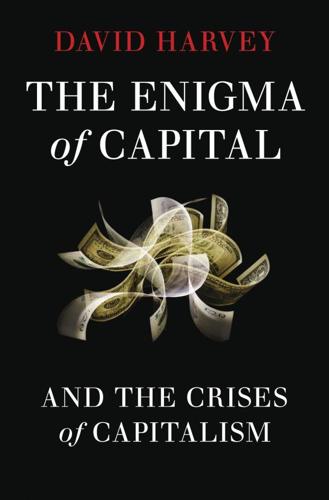
The Enigma of Capital: And the Crises of Capitalism
by
David Harvey
Published 1 Jan 2010
But on the other hand the politics of cheap oil have posed problems of excessive depletion, as well as global warming and a host of other air quality issues (ground level ozone, smog, particulate matter in the atmosphere, and the like) that pose increasing risks to human populations. High-energy-consuming urban sprawl has produced chronic land use degradation conducive to flooding, the siting of waterways and the production of urban ‘heat islands’. These environmental impacts complement the depletion of the natural resources required to support an automobile industry which played such a pivotal role in capital surplus absorption from the 1930s onwards.
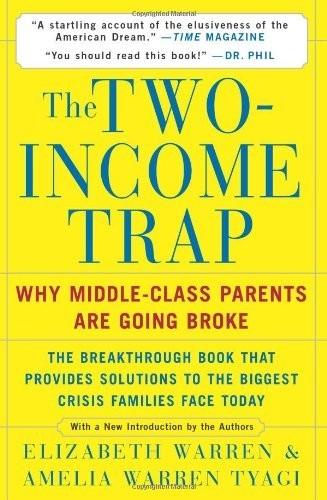
The Two-Income Trap: Why Middle-Class Parents Are Going Broke
by
Elizabeth Warren
and
Amelia Warren Tyagi
Published 17 Aug 2004
If a meaningful public school voucher system were instituted, the U.S. housing market would change forever. These changes might dampen, and perhaps even depress, housing prices in some of today’s most competitive neighborhoods. But these losses would be offset by other gains. Owners of older homes in urban centers might find more willing buyers, and the urge to flee the cities might abate. Urban sprawl might slow down as families recalculate the costs of living so far from work. At any rate, the change would cause a one-time readjustment. The housing market would normalize, with supply and demand more balanced and families freed from ruinous mortgages. The Price of Education Even with that perfect house in a swanky school district, parents still are not covered when it comes to educating their kids—not by a long shot.

Insane Mode: How Elon Musk's Tesla Sparked an Electric Revolution to End the Age of Oil
by
Hamish McKenzie
Published 30 Sep 2017
Or, knowing that it’s cheaper for their cars to simply drive themselves around the city than to pay for parking, car owners could let their empty vehicles roam while not in use, creating a nightmarish scenario of what Robin Chase calls “zombie cars” crowding the streets uselessly. Perhaps the suburbs will become so attractive as commutes become easier that instead of resource-efficient, high-density cities, we’ll have endless urban sprawl. But it doesn’t have to be that way. Almost everything I know about the Renaissance, the period in European history from the fourteenth to the seventeenth century, comes from an eighteen-minute YouTube video produced by the author and philosophy guru Alain de Botton’s School of Life. De Botton dedicates a few minutes of the video to educating viewers about the Renaissance leaders’ zeal for building beautiful cities.
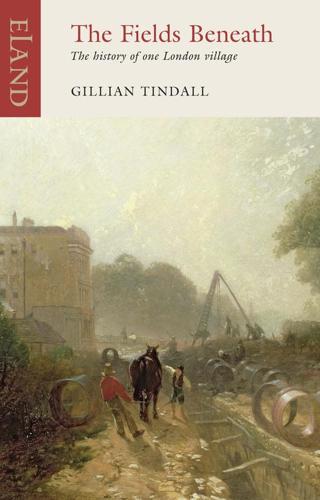
The Fields Beneath: The History of One London Village
by
Gillian Tindall
Published 1 Oct 2002
Temperate, sunny eras have deposited elaborate fanlights, stucco mouldings, cornices and parapets; colder eras have peeled stucco and rotted trimmings, making facings porous. Successive ice ages have left piles of masonry like great rocks standing out above the more delicate roofscape of slates – piano factories, engine sheds, model dwellings, greyly serviceable blocks with stone dressings, post-War follies in roughcast concrete. In the ‘urban sprawl’ the petrified tide-marks of earlier building waves are still clearly visible: here the airy stuccoed facades give way to heavier, mid-Victorian ones with porticoes, here these in turn lie alongside late-Victorian debased Scottish baronial style. Here is an untouched segment of Edwardian red-brick and hung tile, here a slice is missing and in its place (brought hither by a glacier from a distant suburb?)
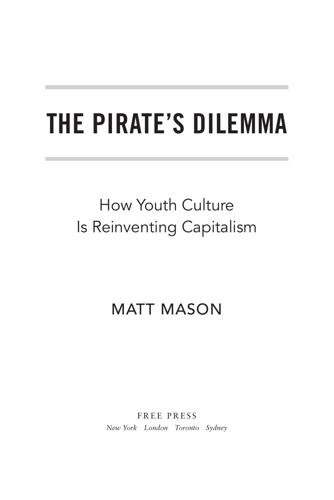
The Pirate's Dilemma: How Youth Culture Is Reinventing Capitalism
by
Matt Mason
Former Radio London and Caroline DJs such as Jimmy Savile, John Peel, and Tony Blackburn were hired by BBC Radio 1, and went on to become household names in the United Kingdom. And as the first generation crossed over and went legit, a new underground was forming in cities across the Continent. Instead of exposing themselves on the open seas, this new breed of pirates began to operate cloaked in the anonymity of urban sprawl. Switching over to the FM band, pirates in the 1980s and '90s serviced a new generation of radio listeners in London, Paris, and beyond, listeners more interested in sounds such as soul, hip-hop, house, garage, and techno drifting over from the United States. The powers that be can detect a pirate's homemade antenna, usually tacked to the top of a tower block, but the studio connected to this antenna by a less powerful (and undetectable) microwave signal, hidden in the concrete labyrinth of a city grid, is difficult to track down.
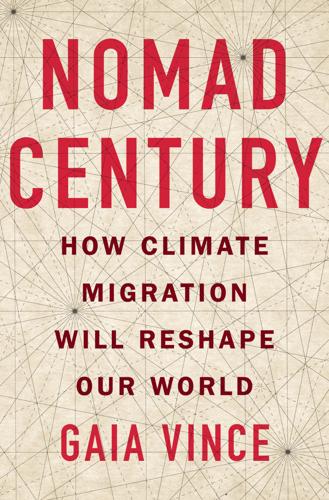
Nomad Century: How Climate Migration Will Reshape Our World
by
Gaia Vince
Published 22 Aug 2022
However, getting permission to build within cities is difficult, because existing residents are often resistant and they pressure planners. This means housing gets built in more remote areas where opposition is weaker, instead of on well-connected sites where the need is greatest, which leads to car-reliant urban sprawl, reducing the productivity and other benefits of dense cities. In England, for instance, in every region, more land is now devoted to roads than housing.5 Other restrictions, such as municipal codes across the United States that limit the number of ‘unrelated occupants’ who can live in a home,6 also need to be removed, as they can prevent low-income people from sharing homes, splitting expenses and paying lower rents.

Costa Rica
by
Matthew Firestone
,
Carolina Miranda
and
César G. Soriano
Published 2 Jan 2008
An unremarkable-looking hotel may have been the place where presidents once slept. It is a place rife with history. San José, after all, is where forward-thinking leaders once gathered to decide that this would be a country without an army. Over the last century, the transformation from prewar agrarian coffee town to 21st-century urban sprawl has been unkind to the city’s physical form. But regardless of what it may look like, San José is the beating heart of Costa Rica – home to its most influential thinkers, its finest museums and its most sophisticated restaurants. In a country that has been culturally transformed by vast amounts of tourism, there’s nowhere better to begin to understand what it means to be Tico.
…
You can hire a taxi and a driver for half a day or longer if you want to do some touring around the area, but rates vary greatly depending on the destination and the condition of the roads. For these trips, it is best to negotiate a flat fee in advance. Return to beginning of chapter AROUND SAN JOSÉ * * * Over the years, as San José’s urban sprawl has crawled up the hillsides of the Central Valley, the boundary lines have blurred between the heart of the city and the villages that encircle it. Here you will find a little bit of everything: from crowded slums filled with immigrant workers to stylish residential neighborhoods where modernist houses hide behind 3m-high walls.
…
The loop road starts 8km southeast of Cartago in Paraíso, and then heads south to Orosi. At this point you can either continue south into Parque Nacional Tapantí-Macizo Cerro de la Muerte or loop back to Paraíso via Ujarrás. Return to beginning of chapter Paraíso Area This busy town has been engulfed by the urban sprawl of Cartago, only 8km away. The village itself is not terribly picturesque (rows of concrete houses generally aren’t), but the wonderful Orosi Valley emerges just outside of it. A few kilometers along the road to Orosi is the Mirador Orosi, which is the official scenic overlook, complete with toilets, a parking lot and plenty of great photo opportunities.
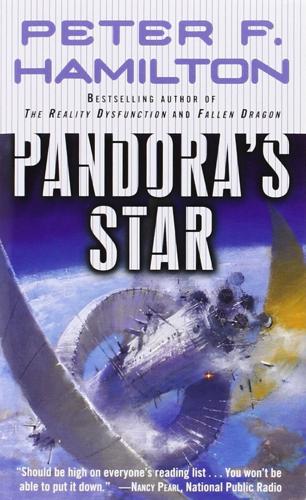
Pandora's Star
by
Peter F. Hamilton
Published 2 Mar 2004
There was also a trend toward architecture with a more elaborate or artistic profile. Sometimes it worked splendidly, as with the contemporary crystal Gothic of the Stoet Building; or else it looked downright mundane like the twisting Illeva. He didn’t actually mind the failures too much; they added to the personality of the place, so different from most of the flat urban sprawls on most of the settled worlds. Rafael Columbia was the second committee member to arrive, the chief of the Intersolar Serious Crimes Directorate. Nigel knew of him, of course, although the two had never met in the flesh. “Pleasure to meet you at last,” Nigel said as they shook hands. “Your name keeps cropping up on reports from our security division.”
…
There was no culture to speak of on Augusta, no nationalist identity. It was devoted solely to commerce, the manufacture of products, large or small, which were shipped out across the Commonwealth. New Costa sprang up along the subtropical coast of the Sineba continent, the only city on the planet. In 2380 it was home to just over a billion people, a centerless urban sprawl of factories and residential districts stretching for more than six hundred kilometers along the shore and up to three hundred inland. For all its crass existence, the megacity had a sense of purpose upon which all its inhabitants thrived. They were here for one thing: to work. There were no native citizens, everyone was technically a transient, earning money as they passed through.
…
There were no churches of any kind, but then they didn’t have any religion here, this was a world where everyone knew they had been created by man, not God. Even when the train moved through the center of the city, the buildings were all the same uniform size; neat houses interspaced by the commercial buildings, and plenty of large parks to break up the urban sprawl. It was unlike other cities in the Commonwealth, where money and political power collected at the center, and the architecture reflected that concentration. Here, equality reigned supreme. Alphaway, the main station, was probably the biggest single structure in the city after the original Foundation clinic, with three long arched roofs of iron and glass, tall enough that the clouds of smoke from the steam engines dissipated upward through the ridge vents.
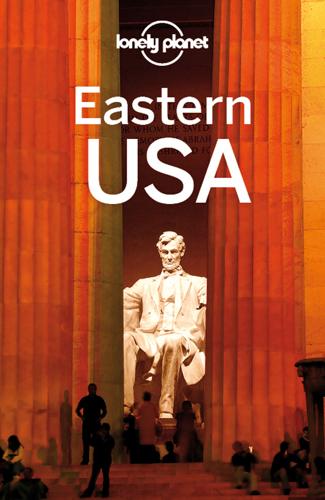
Eastern USA
by
Lonely Planet
Why Go You’ll be awed by the sweeping scenery as you meander alongside America’s longest river, from the rolling plains of the north down to the sun-baked cotton fields of the Mississippi Delta. Wind-hewn bluffs, dense forests, flower-filled meadows and steamy swamps are all part of the backdrop – along with smokestacks, riverboat casinos and urban sprawl: this is the good, the bad and the ugly of life on the Mississippi. The portrait though isn’t complete without mentioning the great music, lip-smacking food and down-home welcome at towns well off the beaten path along this waterfront itinerary. Small towns provide a glimpse into varying facets of American culture: there’s Brainerd, MN, as seen in the Coen Brothers’ film Fargo; La Crosse, WI, where the world’s largest six-pack pops its top; and Nauvoo, IL, a pilgrimage site for Mormons, complete with gleaming white temple.
…
Dillon’s Bus (www.dillonbus.com; tickets $5) has 26 weekday-only commuter buses between Annapolis and Washington, DC, connecting with various DC Metro lines. Annapolis Transit ( 410-263-7964) provides local transport. Inexpensive bikes (per day $5; 9am-8pm) are available for hire from the Harbormaster’s office at the City Dock. Eastern Shore Just across the Chesapeake Bay Bridge, a short drive from the urban sprawl of the Baltimore–Washington corridor, Maryland’s landscape makes a dramatic about-face. Nondescript suburbs and jammed highways give way to unbroken miles of bird-dotted wetlands, serene waterscapes, endless cornfields, sandy beaches and friendly little villages. The coastal flat plains are ideal for cycling.
…
Kayaking and hiking are popular activities, especially the 7-mile trek to the Valley of the Giants, a mystical stand of cedar trees on South Manitou. Ferries (round-trip adult/child $32/18, 1½hr) sail from Leland two to seven times per week from May to mid-October. TRAVERSE CITY Michigan’s ‘cherry capital’ is the largest city in the northern half of the Lower Peninsula. It’s got a bit of urban sprawl, but it’s still a happenin’ base from which to see the Sleeping Bear Dunes, Mission Peninsula wineries, U-pick orchards and other area attractions. Stop at the downtown visitor center ( 231-947-1120; www.traversecity.com; 101 W Grandview Pkwy; 9am-5pm Mon-Fri, 9am-3pm Sat) for maps and the do-it-yourself foodie tour brochure (also available online; click ‘Things to Do’ on the website).

This Changes Everything: Capitalism vs. The Climate
by
Naomi Klein
Published 15 Sep 2014
Meanwhile, Sam Rawlings Walton, grandson of Walmart founder Sam Walton, sits on the EDF’s board of trustees (identified merely as “Boatman, Philanthropist, Entrepreneur” on the organization’s website).40 The EDF claims that it “holds Walmart to the same standards we would any other company.” Which, judging by Walmart’s rather dismal environmental record since this partnership began—from its central role in fueling urban sprawl to its steadily increasing emissions—is not a very high standard at all.41 Nor is the Environmental Defense Fund the only environmental organization to have benefited from the Walton family’s largesse. Their foundation is one of the top green funders, handing out more than $71 million in grants for environmental causes in 2011, with about half of the money going to the EDF, Conservation International, and the Marine Stewardship Council.
…
F., 153, 201 storm barriers, 108, 109 Strahl, Chuck, 362 stranded assets, 146 StratoShield, 262, 268n, 271 stratosphere, sulfur dioxide in: from volcanic eruptions, 258–59, 273–74 see also Pinatubo Option strontium-90, 203 structural inequity, 40 Stuffed and Starved (Patel), 135 Stutz, John, 94 Suckling, Kierán, 206 Sudan, 270 sulfur dioxide emissions, 208 Suncor Energy, 234, 246 sunlight, reflection of, see Solar Radiation Management SuperFreakonomics (Levitt and Dubner), 262–63, 271–72 Superfund Act of 1980, 202 super-rich, 19 supply lines, length of, 76 Supreme Court, Canada: Haida Nation case in, 369 Indigenous land rights affirmed by, 368, 371–72 sustainability, 55, 77, 447 Sustainable Energy Blueprint, 213 Swarthmore College, 355 Swearengin, Paula, 310 Sweden, 179 Swift Boat Veterans for Truth, 34 Swiss Re Americas, 49 SWN Resources, 299 Sydney, Australia, 446 Syngenta, 9 Syriza party (Greek), 181–82, 297 Take, The, 123 Tambococha oil field, 410 tarmac, melting of, 1–2 Tar Sands Blockade, 302 tar sands oil (bitumen), 2, 94, 139, 140, 144, 145, 234, 237, 252–53, 254, 310, 349, 352, 358, 446 call for global moratorium on, 353 diluted (dilbit), 325, 331 grassroots opposition to, 321–22 high risk in, 324 Indigenous opposition to, 322, 375 open-pit extraction of, 329 opposition to, 234 water use in mining of, 346 see also Alberta tar sands; pipelines tax cuts, 39, 72 for consumers, 112 taxes, 19, 39, 42, 117, 119 airline, 250–51 carbon, 112, 114, 125, 157, 218, 250, 400, 461 corporate, 19, 115 financial transaction, 114 luxury, 93 pollution-based, 284 on the rich, 113–14, 118, 153 transition, 418 tax havens, closure of, 114 Tax Justice Network, 114 tax refunds, 118 Tea Party, 3, 38, 227 technology, 16, 24, 76, 142, 186, 236 and domination of nature, 56–57 extreme extraction and, 310 see also geoengineering TED Talks, 211, 236 Tellus Institute, 94 temperatures, extreme, 2 Temple, William, 183 Tercek, Mark, 208n TerraPower, 264 Texaco, 309 Texas: drought of 2011 in, 47, 440 fracking in, 347 Keystone XL and, 361 water pollution in, 329 Texas, University of, 329 Texas City Prairie Preserve, oil and gas drilling on, 192–95, 196, 215 Thames River, 446 Thatcher, Margaret, 39, 42, 60 Thie, Hans, 131 think tanks, conservative, 38, 203 Third World Network, 77 Thomas-Flurer, Geraldine, 367 Thompson, Lonnie G., 15 Thoreau, Henry David, 184, 286 350.org, 140, 156, 233n, 353, 356 tidal power, 127 Tiger Management, 208 tight-rock formations, 311; see also shale, fracking of Tillerson, Rex, 111, 314 Time magazine, Planet Earth on cover of, 74, 204 Tiputini oil field, 410 Tjelmeland, Aaron, 192, 195 Tongue River, 389, 390 Tongue River Railroad (proposed), 389 tornados, 406 Toronto, 55, 65, 67, 73, 126 Total, 246 Totnes, England, 364 Toyota, 196 trade, see free trade agreements; international trade trade unions, 81, 83, 177, 204, 454 job creation and, 126–27 job protection by, 126, 178 NAFTA opposed by, 84 transaction tax, 418 TransCanada, 149, 346, 359, 361, 362 see also Keystone XL pipeline Transition Town movement, 364 Transocean, 330 Trans-Pacific Partnership, 78 transportation infrastructure, 85, 90, 127 travel, wealth and, 113 Treaty 6, 372 tree farms, 222 Trenberth, Kevin, 272, 275 Trent River, 300 trickle-down economics, 19 Trinity nuclear test, 277 triumphalism, 205, 465 Tropic of Chaos (Parenti), 49 tropics, techno-fixes and risk to, 49 Trump, Donald, 3 Tschakert, Petra, 269 Tsilhqot’in First Nation, 345 Tsipras, Alexis, 181–82, 466 Tsleil-Waututh First Nation, 323 Tutu, Desmond, 464 Tuvalu, 13 2 degrees Celsius boundary, 87–88, 89, 150, 354, 456 Tyndall Centre for Climate Change Research, 13, 21, 56, 86–87, 214, 283 typhoons, 107, 175, 406, 465 Uganda, 222 ultra-deepwater “subsalt” drilling, 145 Undesirables (Isaacs), 167 unemployment, 180 unemployment insurance, 454 Unified Campesino Movement of Aguán, 222 Union of Concerned Scientists, 201 Clean Vehicles Program at, 237 United Kingdom, 13, 149, 170, 224, 225 compensation of slave-owners in, 415–16, 457 “dash for cash” in, 299 divestment movement in, 354 flooding in, 7, 54, 106–7 fracking in, 299–300, 313 Industrial Revolution in, 172–73, 410 negatives of privatization in, 128 politics of climate change in, 36, 150 supports for renewable energy cut in, 110 Thatcher government of, 39 World War II rationing in, 115–16 United Nations, 7, 18, 64, 87, 114 Bloomberg as special envoy for cities and climate change of, 236 Clean Development Mechanism (CDM), 219–20, 224, 226 climate governance and, 280 climate summits of, 5, 11, 65, 150, 165, 200; see also specific summits Department of Economic and Social Affairs, 110 Intergovernmental Panel on Climate Change, see Intergovernmental Panel on Climate Change (IPCC) international agreements and, 17 Special Rapporteur on the Right to Food, 135 United Nations Conference on the Human Environment of 1972, 202 United Nations Declaration on the Rights of Indigenous Peoples, 377, 383 United Nations Economic Commission for Latin America and the Caribbean, 180 United Nations Environmental Modification Convention, 278 United Nations Environment Programme (UNEP), 272 United Nations Framework on Climate Change, 200, 410 United Nations Framework Convention on Climate Change (UNFCCC), 76, 77, 78–79 United Nations High Commissioner for Refugees, 167 United Nations Rio Declaration on Environment and Development (1992), 55, 293 United Policyholders, 109 United States, 19, 67, 68, 143 carbon emissions from, 409 coal exports from, 320, 322, 346, 349, 374, 376 Copenhagen agreement signed by, 12, 150 energy privatization reversals in, 98 environmental legislation in, 201–2 failure of climate legislation in, 226–27 Kyoto Protocol and, 218–19, 225–26 oil and gas export restrictions in, 71 opposition movement in, 9 solar energy market in, 72 WTO challenges brought against, 65 WTO challenges brought by, 64–65, 68 United States Climate Action Partnership (USCAP), 226–28 University College London, 415–16 uranium, 176 urban planning, green, 16 urban sprawl, 90, 91 US Airways, 1–2 U.S. Chamber of Commerce, 227 utilities, alternative models for, 130–33 U’wa, 376–77 Vagt, Robert F., 217 van Beurden, Ben, 358, 376 Vancouver, Canada, 13 Var, France, 317–18 Vassiliou, Anni, 347 vegetation, carbon and, 14 Venezuela, 179–80 Venkataraman, R., 75 venture capitalists, 252 Vermont: anti-fracking movement in, 348 local agriculture in, 404–5 Vernon, Caitlyn, 365 victory gardens, 16, 17 Vidal, John, 244 Vietnam War, 261 Virgin Earth Challenge, 257, 284–85 Virgin Green Fund, 238, 239, 253 Virgin Group, 230, 237 Virgin Airlines, 231, 238, 241–44, 249–52 Virgin Fuels, 238 Virgin Racing, 243 Virgin Trains, 231, 238, 252–53 Viteri, Franco, 388 volcanic eruptions: droughts and, 272–73 global impact of, 274 weather patterns and, 259, 270, 271–74 Volney, Constantin-François, 273 Vonnegut, Kurt, 286, 287 Vowel, Chelsea, 371 Voynet, Dominique, 218 wage controls, 125 Wallach, Lori, 359–60 Wall Street, 206, 208 in financial crisis of 2008, 9, 44 Wall Street Journal, 207, 312 Walmart, 196, 208–10 Walton, Sam, 209 Walton, Sam Rawlings, 209 Walton Family Foundation, 209 Wang Wenlin, 300 Wania, Frank, 328n Ward, Barbara, 286 Warsaw climate change summit (2013), 200–201, 276 Washington, D.C.: Keystone XL protest in, 139, 301–2 record temperatures in, 73 Washington Consensus, 81 Washington State, 319 Indigenous land rights in, 323, 374–75, 380–81 proposed coal export terminals in, 320, 322, 346, 349, 374, 380–81 Washington, Tracie, 419 water: disruption to supplies of, 14, 165 First Nations and, 384 privatization of, 133 as public utility, 7 water pollution: extractive industry and, 83, 94, 295, 296, 332, 344–47 from fracking, 328–29, 332, 344, 346 water power, 16, 101, 215 of factories, 171 steam engine vs., 171–72 Waters, Donny, 431, 432 Watt, James, 171–75, 204, 266, 394, 410 Waxman-Markey, 227 wealth: concentration of, 154, 155 decentralization of, 131 greenhouse gas emissions and, 113–14 inequality of, 123, 454–55 redistribution of, 40, 42, 453 transfers of, 5 Wealth of Nations (Smith), 173, 462 weapons, climate change and, 9 weather, extreme, 35, 102–10 weather futures, 8–9 weatherization, 93 weather patterns: global warming and, 269 historical record of, 271–76 Pinatubo eruption and, 259, 270, 271–72, 274 variations in, 269 weather patterns, intentional modification of: as weapon, 261, 278 see also Pinatubo Option; Solar Radiation Management Weintrobe, Sally, 12 Werner, Brad, 449–50, 451, 460 West Antarctic ice sheet, 13, 14, 15 West Burton, England, 300 Western Australia, 376 West, Thomas, 365 West Virginia, 332, 357n, 367 wetlands, extractive industry damage to, 425–26 Weyerhaeuser, 369 Where Do We Go from Here (King), 453 Whitehead, Andrew, 432 Whitehorn, Will, 230–31 Whitehouse, Mark, 428 Whiteman, Phillip, Jr., 386 Whole Earth Catalogue, 288 WikiLeaks, 78, 165 wilderness system, federal, 203 wildfires, 14, 52, 108, 446 Wildlife Conservation Society, 221–22 Wildlife Society, 192 Willemse, Oom Johannes, 347 Willett Advisors, 216, 235 Williams, Eric, 415 Willis, Rebecca, 90 wind farms, 110, 223, 287 “Window for Thermal Coal Investment Is Closing” (Goldman Sachs), 352 wind power, 16, 67, 70, 97, 102, 118, 122, 124, 127, 131–32, 147, 215, 237 in combined-cycle plant, 129 fracking’s negative impact on, 129, 144n large offshore, 131 manufacturers in, 68 private sector and, 100–101 Wood, Lowell, 268n, 271, 280, 288 Woolsey, R.
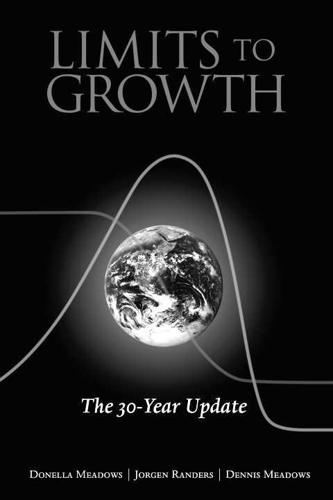
The Limits to Growth: The 30-Year Update
by
Donella H. Meadows
,
Jørgen Randers
and
Dennis L. Meadows
Published 15 Apr 2004
But for several decades the output of the industry and service sectors remains sufficiently high to maintain acceptable living standards, despite the need for capital investment in agriculture and, later, for pollution control. In the last third of the twenty-first century, the pollution level has fallen so much that land fertility recovers. But the population pressure is large, and the amount of arable land declines due to urban sprawl and erosion. Furthermore, after the middle of the century industrial output falls rapidly, because so much capital has been pulled into the agricultural and pollution sectors that there is no longer enough investment to offset depreciation. The economy declines, and a collapse sets in, exacerbated late in the century by an increasing scarcity of nonrenewable resources.
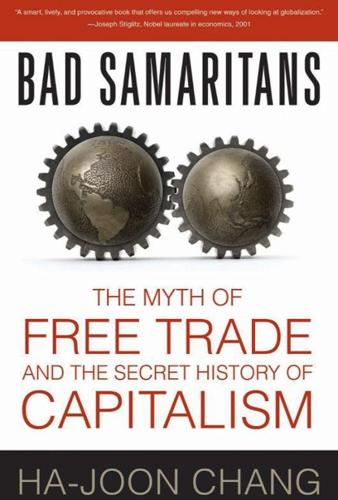
Bad Samaritans: The Myth of Free Trade and the Secret History of Capitalism
by
Ha-Joon Chang
Published 26 Dec 2007
Many of these slums would ultimately be cleared forcefully by the police and the residents dumped in far-flung neighbourhoods, with even worse sanitation and poorer road access, to make way for new apartment blocks for the ever-growing middle class. If the poor could not get out of the new slums fast enough (though getting out of the slums was at least possible, given the rapid growth of the economy and the creation of new jobs), the urban sprawl would catch up with them and see them rounded up once again and dumped in an even more remote place. Some people ended up scavenging in the city’s main rubbish dump, Nanji Island. Few people outside Korea were aware that the beautiful public parks surrounding the impressive Seoul Football Stadium they saw during the 2002 World Cup were built literally on top of the old rubbish dump on the island (which nowadays has an ultra-modern eco-friendly methane-burning power station, which taps into the organic material dumped there).
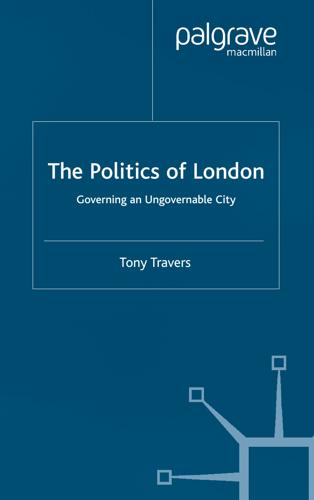
The politics of London: governing an ungovernable city
by
Tony Travers
Published 15 Dec 2004
About a third of workplaces have their main market elsewhere in the UK, and a small but sizeable proportion of workplaces rely mainly on international markets (London TEC Council, 1998). Three quarters of workplaces in London employ ten people or fewer, but a third of all jobs are provided by large workplaces (more than 200 employees). Within Britain, and particularly in southern England, concern has developed about the problems of urban sprawl. Although London has been hemmed in since 1939 by a highly effective Green Belt, the prosperity of the southern part of the country has led to major and continuous development in virtually all of the counties surrounding London. Towns such as Reading, Bracknell, Crawley and Watford have been subjected to enormous planning pressure for many years.

Oryx and Crake
by
Margaret Atwood
Published 5 May 2003
He pauses, wipes the sweat off his face, drinks half of his bottle of water. He hopes there will be more somewhere, soon. Up ahead, the houses thin out and vanish. There’s an interval of parking lots and warehouses, then barbed wire strung between cement posts, an elaborate gate off its hinges. End of urban sprawl and pleeb city limits, beginning of Compound turfdom. Here’s the last station of the sealed-tunnel bullet train, with its plastic jungle-gym colours. No risks here, the colours are saying. Just kiddie fun. But this is the dangerous part. Up to here he’s always had something he could climb or scramble up or dodge around in case of a flank attack, but now comes an open space with no shelter and few verticals.
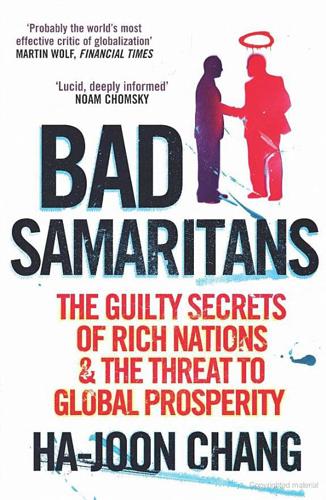
Bad Samaritans: The Guilty Secrets of Rich Nations and the Threat to Global Prosperity
by
Ha-Joon Chang
Published 4 Jul 2007
Many of these slums would ultimately be cleared forcefully by the police and the residents dumped in far-flung neighbourhoods, with even worse sanitation and poorer road access, to make way for new apartment blocks for the ever-growing middle class. If the poor could not get out of the new slums fast enough (but getting out of the slums was at least possible, given the rapid growth of the economy and the creation of new jobs), the urban sprawl would catch up with them and see them rounded up once again and dumped in an even more remote place. Some people ended up scavenging in the city’s main rubbish dump, Nanji Island. Few people outside Korea were aware that the beautiful public parks surrounding the impressive Seoul Football Stadium they saw during the 2002 World Cup were built literally on top of the old rubbish dump on the island (which nowadays has an ultra-modern eco-friendly methane-burning power station, which taps into the organic material dumped there).
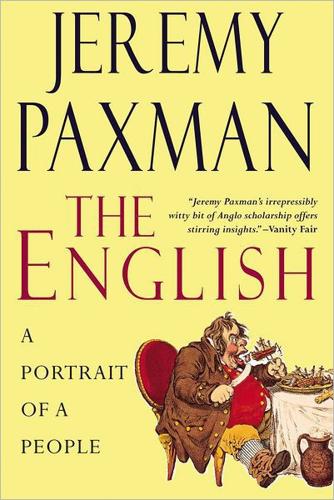
The English
by
Jeremy Paxman
Published 29 Jan 2013
Batsford’s Face of Britain series was phenomenally successful. Arthur Mee, inventor of the Children’s Encyclopaedia and the Children’s Newspaper, produced forty-one volumes describing The King’s England. The Shell Oil company invited John Betjeman to edit its series of Shell Guides to the counties of England. Recognizing the way that urban sprawl was gorging upon the countryside, the Council for the Preservation of Rural England was founded in 1926 to protest against the spread of tar. Putting footwear upon this interest, the Ramblers Association was established in 1935, a crusade to allow urban walkers to stroll where they pleased across the countryside.
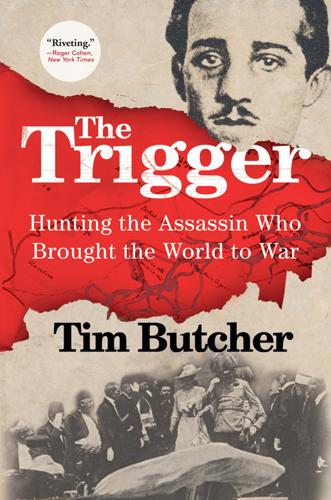
The Trigger: Hunting the Assassin Who Brought the World to War
by
Tim Butcher
Published 2 Jun 2013
Travellers in the early twentieth century knew from afar when they were approaching the city from the sight of the great fortress built on the high rocky promontory that towers over the junction of the Sava and Danube Rivers. It would have been visible from miles away, dominating unchallenged what was otherwise a classic central-European flatland of forest, field and marsh. The urban sprawl of modern Belgrade, with its ranks of electricity pylons, tower blocks and red-and-white-chequered factory chimneys, rather diffused the sense of drama when my last lift dropped me in the city. But soon enough I was back on the trail of my quarry, as the road I found myself walking up near Belgrade’s railway station was named Gavrilo Princip Street.

Streetfight: Handbook for an Urban Revolution
by
Janette Sadik-Khan
Published 8 Mar 2016
$69 billion in highway spending: Ibid., 17. only about half: Ibid., 6. 10 percent from municipal bonds: Ibid., 8. pays more than $1,100: Ibid., 2. transit, walking, and biking combined: Ibid. $1 trillion a year drag: Todd Litman, An Analysis of Public Policies That Unintentionally Encourage and Subsidize Urban Sprawl (Victoria, BC, Canada: Victoria Transport Policy Institute, LSE Cities, 2015), 40, accessed August 5, 2014, http://static.newclimateeconomy.report/wp-content/uploads/2015/03/public-policies-encourage-sprawl-nce-report.pdf. nearly 33,000 people can lose their lives: National Highway Traffic Safety Administration, “U.S.
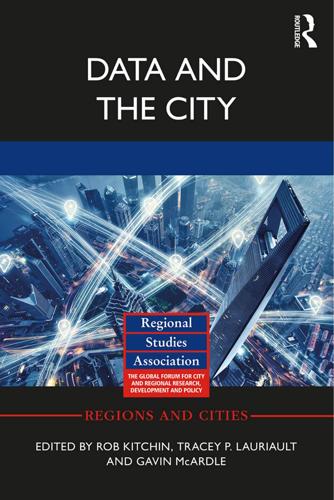
Data and the City
by
Rob Kitchin,Tracey P. Lauriault,Gavin McArdle
Published 2 Aug 2017
Available from: http://earthobservatory.nasa.gov/blogs/elegantfigures/2011/10/06/ crafting-the-blue-marble/ [accessed 10 February 2017]. Sutton, P. (1997) ‘Modeling population density with night-time satellite imagery and GIS’, Computers, Environment and Urban Systems 21(3): 227–244. Sutton, P. (2003) ‘A scale-adjusted measure of “urban sprawl” using night-time satellite imagery’, Remote Sensing of Environment 86(3): 353–369. Wakamiya, S., Lee, R. and Sumiya, K. (2013) ‘Social-urban neighborhood search based on crowd footprints network’, in International Conference on Social Informatics, pp. 429–442. Wang, Q. and Taylor, J.E. (2016) ‘Patterns and limitations of urban human mobility resilience under the influence of multiple types of natural disaster’, PloS One 11(1): e0147299.

Falter: Has the Human Game Begun to Play Itself Out?
by
Bill McKibben
Published 15 Apr 2019
It may not be quite game-ending, but it seems set, at the very least, to utterly change the board on which the game is played, and in more profound ways than almost anyone now imagines. The habitable planet has literally begun to shrink, a novel development that will be the great story of our century. * * * Climate change has become such a familiar term that we tend to read past it—it’s part of our mental furniture, like urban sprawl or gun violence. So, let’s remember exactly what we’ve been up to, because it should fill us with awe; it’s by far the biggest thing humans have ever done. Those of us in the fossil fuel–consuming classes have, over the last two hundred years, dug up immense quantities of coal and gas and oil, and burned them: in car motors, basement furnaces, power plants, steel mills.
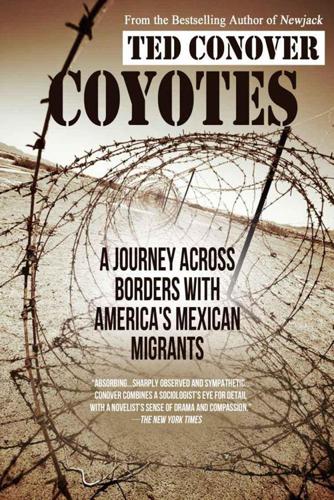
Coyotes: A Journey Across Borders With America's Mexican Migrants
by
Ted Conover
Published 10 Jan 2013
And a funny feeling lodged itself in my stomach as I wondered: What else had I forgotten to tell them? It was like crossing the border again, though my friends were even more nervous. We were leaving one world, the sleepy, isolated barrio of El Mirage, with its orchards, dirt roads, and dusty cantinas, and heading to another—fast, urban, sprawling Los Angeles. The change itself, for these country boys, would be hard to get used to ... but at least it would be from one mainly Hispanic environment to another. What had them really worried was the journey itself: to get to Los Angeles, we would have to pass through a place even more foreign, a terra incognita of video displays and moving sidewalks, a world with a different language and set of rules for behavior: the world of air travel.
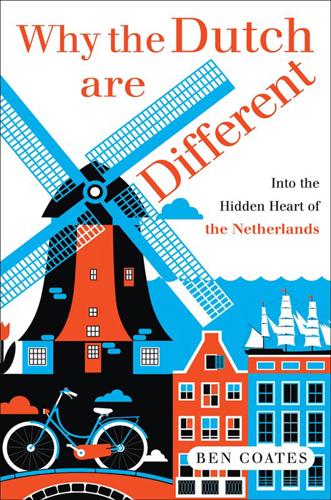
Why the Dutch Are Different: A Journey Into the Hidden Heart of the Netherlands: From Amsterdam to Zwarte Piet, the Acclaimed Guide to Travel in Holland
by
Ben Coates
Published 23 Sep 2015
The urban area of the Randstad – first identified by the co-founder of the airline KLM as he looked down on it from a plane – grew steadily until it formed one of the largest urban conurbations in Europe. For a time the Netherlands was viewed as a model for sustainable growth, with Pete Hall’s 1966 book The World Cities heralding the Dutch for preventing the Randstad from becoming ‘another formless urban sprawl’. To me, though, it seemed that some of Hall’s worst fears had been realised. Although the historic centres of Dutch cities were often achingly pretty, outside them much of the country was a New Jerseyesque sprawl of motorways, drive-through restaurants, backlit billboards and monolithic superstores.

Ghost Road: Beyond the Driverless Car
by
Anthony M. Townsend
Published 15 Jun 2020
Then I Tried One,” Opinion, New York Times, October 22, 2017, https://www.nytimes.com/2017/10/22/opinion/driverless-cars-test-drive.html. 960 million people were killed: Death: A Self-Portrait, 2012, Richard Harris Collection, London, UK: Wellcome Collection, exhibition. 9time wasted in traffic: “INRIX Global Traffic Scorecard,” INRIX, accessed February 15, 2018, http://inrix.com/scorecard. 1025 million people have disabilities that limit travel: Stephen Brumbaugh, Travel Patterns of Americans with Disabilities (Washington, DC: Bureau of Transportation Statistics, 2018), https://www.bts.gov/sites/bts.dot.gov/files/docs/explore-topics-and-geography/topics/passenger-travel/222466/travel-patterns-american-adults-disabilities-9-6-2018_1.pdf. 10By 2030 . . . tens of millions: BlackRock Investment Group, Future of the Vehicle: Winners and Losers: From Cars and Cameras to Chips (BlackRock Investment Institute, 2017), 8. 10two billion human-driven cars and trucks: Daniel Sperling and Deborah Gordon, Two Billion Cars: Driving toward Sustainability (New York: Oxford University Press, 2009). 10“The future is already here”: Marianne Trench, Cyberpunk (New York: Intercon Production, 1990), YouTube video. 11a mix of both worlds: Bern Grush and John Niles, The End of Driving: Transportation Systems and Public Policy Planning for Autonomous Vehicles (Cambridge, MA: Elsevier, 2018). 11Half will end up in China: “Autonomous Vehicle Sales to Surpass 33 Million Annually in 2040, Enabling New Autonomous Mobility in More Than 26 Percent of New Car Sales, IHS Markit Says,” IHS Markit, January 2, 2018, https://technology.ihs.com/599099/autonomous-vehicle-sales-to-surpass-33-million-annually-in-2040-enabling-new-autonomous-mobility-in-more-than-26-percent-of-new-car-sales-ihs-markit-says. 11$2 trillion global auto-manufacturing industry: Roger Lanctot, Accelerating the Future: The Economic Impact of the Emerging Passenger Economy (Strategy Analytics, June 2017), https://newsroom. intel. com/newsroom/wp-content/uploads/sites/11/2017/05/passenger-economy.pdf; roughly the size of the entire EU economy: “The Economy,” European Union (website), accessed April 11, 2019, https://europa.eu/european-union/about-eu/figures/economy_en. 11capture a $1.7 trillion annual share by 2030: Author’s calculation based on Peter Campbell, “Waymo Forecast to Capture 60% of Driverless Market,” Financial Times, May 10, 2018, https://www.ft.com/content/3355f5b0-539d-11e8-b24e-cad6aa67e23e. 11of many shapes and sizes will have replaced them: Scott Corwin et al., “The Future of Mobility: What’s Next?” Insights, Deloitte, September 14, 2016, https://www2.deloitte.com/insights/us/en/focus/future-of-mobility/roadmap-for-future-of-urban-mobility.html. 12cost of traffic congestion grew tenfold: Bruce Schaller, “What Urban Sprawl Is Really Doing to Your Commute,” CityLab, September 4, 2019, https://www.citylab.com/perspective/2019/09/worst-cities-traffic-congestion-commuting-time-transit-data/597262/. 12car was cheap, rugged, and simple to repair: Joshua B. Freeman, Behemoth: A History of the Factory and the Making of the Modern World (New York: W.
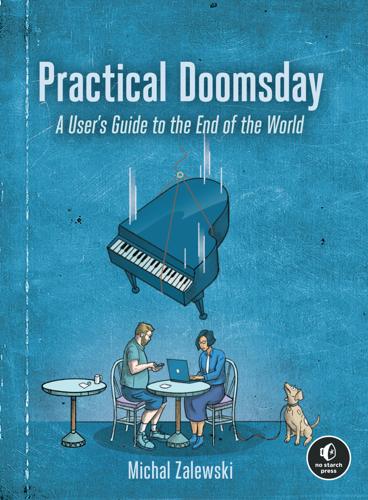
Practical Doomsday: A User's Guide to the End of the World
by
Michal Zalewski
Published 11 Jan 2022
After all, nobody is thinking about the possibility of substantial snow in Los Angeles or a blistering heatwave in Alaska, even though there’s fairly recent precedent for both. As a real-world example that will be familiar to many techies, in earthquake-obsessed California, decades of poor forest management, urban sprawl, and years of drought have conspired to unleash a series of unprecedented and deadly fires since 2015, destroying tens of thousands of homes and displacing hundreds of thousands of people. One particularly infamous cluster of fires in Butte County burned down 18,000 structures in under three weeks.1 And in Europe, generally reputed to have a mild and uninteresting climate, a freak heatwave in 2003 killed more than 30,000 people,2 mostly in highly developed and wealthy countries such as France and Spain.

A New History of the Future in 100 Objects: A Fiction
by
Adrian Hon
Published 5 Oct 2020
It wasn’t China’s billion-plus people that caused food prices to rise; it was their appetites. As China grew richer, it followed a well-trodden path that saw the country’s demand for meat, fish, and specialty produce increase dramatically. While crop yields also increased thanks to genetic modification and new technology, the pressures on farmland from urban sprawl, topsoil degradation, and water scarcity made it impossible for domestic growers to keep up with demand. But if there was no space left at home, one option was to look abroad. Like other nations in the Middle East and North America, many Chinese companies secured millions of acres of comparatively cheap farmland in countries such as Ethiopia, Kenya, Nigeria, and Sudan.
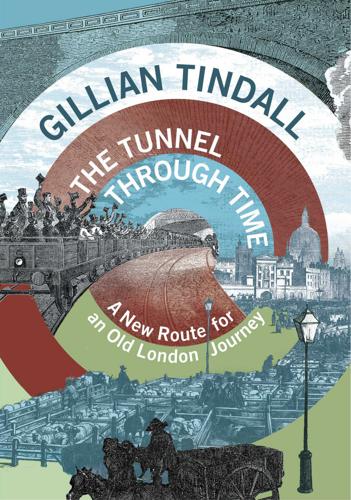
The Tunnel Through Time: A New Route for an Old London Journey
by
Gillian Tindall
Published 14 Sep 2016
He lies there to this day, somewhere far down beneath the Barbican Centre paving. Stow also had things to say about the developments on the other side of the City, east of Aldgate and the Tower, where other fields that he had played on as a child, and where he had fetched milk from cow-keepers in his boyhood, were now becoming urban sprawl related to London’s river traffic: this common field, I say, being sometime the beauty of this City on that part, is . . . encroached upon by the building of filthy cottages, and with other purprestures, inclosures and Lay-Stalles. This expansion was the downside of the relative peace and consequent prosperity of Elizabeth’s reign, which attracted many foreigners, as well as people from all parts of Britain, to London’s booming trade.
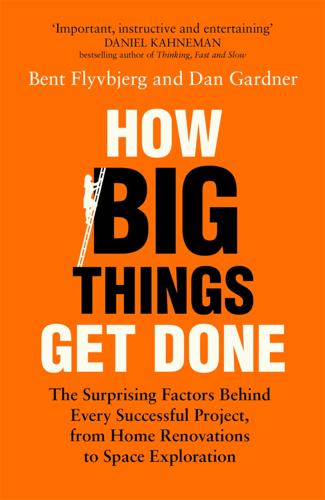
How Big Things Get Done: The Surprising Factors Behind Every Successful Project, From Home Renovations to Space Exploration
by
Bent Flyvbjerg
and
Dan Gardner
Published 16 Feb 2023
You may have heard about it, particularly if you live in California. If you do, you’re paying for it. In 2008, Golden State voters were asked to imagine themselves at Union Station in downtown Los Angeles, on board a sleek silver train. Departing the station, the train slips quietly through the urban sprawl and endless traffic jams and accelerates as it enters the open spaces of the Central Valley, until the countryside is racing by in a blur. Breakfast is served. By the time attendants clear coffee cups and plates, the train slows and glides into another station. This is downtown San Francisco. The whole trip took two and a half hours, not much more than the time it would take the average Los Angeleno to drive to the airport, clear security, and get on a plane to queue on the tarmac, waiting for departure.

USA Travel Guide
by
Lonely, Planet
You’ll be awed by the sweeping scenery as you meander alongside North America’s second-longest river, from the rolling plains of Iowa down to the sunbaked cotton fields of the Mississippi Delta. Limestone cliffs, dense forests, flower-filled meadows and steamy swamps are all part of the backdrop – along with smokestacks, riverboat casinos and urban sprawl: this is the good, the bad and the ugly of life on the Mississippi. The portrait though isn’t complete without mentioning the great music, lip-smacking food and down-home welcome at towns well off the beaten path on this waterfront itinerary. Small towns provide a glimpse into American culture: there’s Hibbing, MN, where folk rocker Bob Dylan grew up; Brainerd, MN, as seen in the Coen Brothers’ film Fargo; Spring Green, WI, where architect Frank Lloyd Wright cut his teeth; pastoral Hannibal, MO, boyhood home of Mark Twain; and Metropolis, IL, where you’ll find Superman’s quick-change phone booth.
…
Dillon’s Bus (www.dillonbus.com; tickets $5) has 26 weekday-only commuter buses between Annapolis and Washington, DC, connecting with various DC Metro lines. Annapolis Transit ( 410-263-7964) provides local transport. Inexpensive bikes (per day $5; 9am-8pm) are available for hire from the Harbormaster’s office at the City Dock. Eastern Shore Just across the Chesapeake Bay Bridge, a short drive from the urban sprawl of the Baltimore–Washington corridor, Maryland’s landscape makes a dramatic about-face. Nondescript suburbs and jammed highways give way to unbroken miles of bird-dotted wetlands, serene waterscapes, endless cornfields, sandy beaches and friendly little villages. The coastal flat plains are ideal for cycling.
…
Kayaking and hiking are popular activities, especially the 7-mile trek to the Valley of the Giants, a mystical stand of cedar trees on South Manitou. Ferries (round-trip adult/child $32/18, 1½hr) sail from Leland two to seven times per week from May to mid-October. TRAVERSE CITY Michigan’s ‘cherry capital’ is the largest city in the northern half of the Lower Peninsula. It’s got a bit of urban sprawl, but it’s still a happenin’ base from which to see the Sleeping Bear Dunes, Mission Peninsula wineries, U-pick orchards and other area attractions. Stop at the downtown visitor center ( 231-947-1120; www.traversecity.com; 101 W Grandview Pkwy; 9am-5pm Mon-Fri, 9am-3pm Sat) for maps and the do-it-yourself foodie tour brochure (also available online; click ‘Things to Do’ on the website).

Growth: From Microorganisms to Megacities
by
Vaclav Smil
Published 23 Sep 2019
China, due to its delayed urbanization, has seen the most intensive wave of this new construction and, rather than quoting statistics about the number of newly completed houses or about annual additions of living area, the intensity of that urbanization effort is perhaps best illustrated by the astonishing fact that China has been recently emplacing every three years more concrete than the United States used in construction of its infrastructure, housing, and transportation during the entire 20th century (Smil 2014b). Inevitably, urbanization demanding concentrated higher levels of per capita resource consumption creates commensurate environmental burdens. Urban growth has resulted in the inevitable urban sprawl, a universal phenomenon whose progress can be profitably studied (now virtually in real time) from satellite imagery (Bhatta 2010) and whose impact takes places mostly in ecosystems that we can least afford to lose. The very beginnings of settled human existence aside, a disproportional share of large cities has been always in coastal areas, and the advantages of such locations have been only strengthened with the rise of modern inexpensive mass-scale marine transportation.
…
In 2017, 14 of the 20 largest megacities were in coastal lowlands, and McGranahan et al. (2005) calculated that at the beginning of the 21st century cities in coastal ecosystems housed nearly 15% of all urban dwellers even though such ecosystems accounted for only about 3% of the continental area. The highest share of the urban population (more than a third) is living in cities surrounded by cultivated ecosystems where their expansion reduces the area of arable land. Urban sprawl causes extensive loss of natural plant cover, erases biodiversity, fragments habitats, reduces the area of high-quality arable land, and disrupts streams (as they are forced into concrete troughs or even disappear), and in arid areas results in overuse of groundwater. Beijing’s growth has been a particularly worrisome example of a city that had an inadequate water supply even a generation ago but whose population more than doubled between 1990 and 2015, further straining its groundwater resources (Zhou et al. 2012).
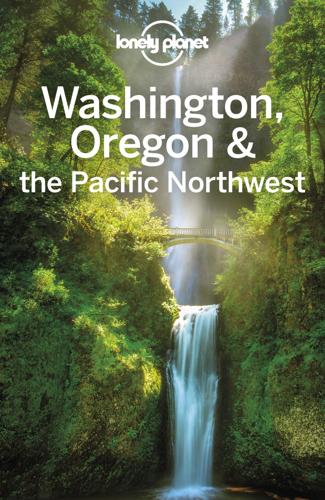
Lonely Planet Washington, Oregon & the Pacific Northwest
by
Lonely Planet
Portland’s unofficial motto is ‘Keep Portland Weird,’ while Seattle’s popular Fremont neighborhood proclaims the ‘freedom to be peculiar.’ And let’s not forget LGBTIQ+ folks, who are widely accepted and especially attracted to the Northwest’s liberal cities. However, not everything is perfect in paradise; in big cities, urban sprawl and rising real-estate prices are a problem. And despite the large percentage of bicycle commuters, as well as great public-transportation systems, freeways get jammed during rush hour. Unemployment continues to be a big problem, as more and more people continue to be attracted to the region. Northwesterners are an adaptable lot, however.
…
The ‘New Urbanism’ or ‘Urban Village’ concepts are also popular in the Pacific Northwest, emphasizing compact, walkable communities that cut down the need to drive everywhere for work, schools and shopping. These inner-city neighborhoods also facilitate a strong community feel to bring people together, a trait that can seem lost in this era of modernism and urban sprawl. Seattle, Portland and Vancouver are some of the top cities embracing the Leadership in Energy and Environmental Design (LEED) certification system for ‘green’ buildings. These buildings use safe, sustainable building materials and incorporate water- and energy-efficient systems. Local examples include Seattle’s Justice Center and Hyatt Hotel at Olive 8, Portland’s Ecotrust building and Avalon Hotel & Spa, and Vancouver’s Port Authority.
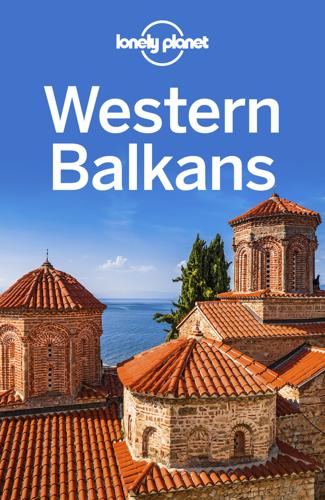
Lonely Planet Western Balkans
by
Lonely Planet
,
Peter Dragicevich
,
Mark Baker
,
Stuart Butler
,
Anthony Ham
,
Jessica Lee
,
Vesna Maric
,
Kevin Raub
and
Brana Vladisavljevic
Published 1 Oct 2019
Tirana 1Top Sights 1National Gallery of ArtsC3 2National History MuseumB2 1Sights 3Bunk’Art 2C3 4Clock TowerC2 5Equestrian Statue of SkanderbegB2 6Et’hem Bey MosqueC2 7House of LeavesB3 8National Archaeological MuseumC5 9Palace of CultureC2 10Sheshi SkënderbejB2 2Activities, Courses & Tours 11Albania HolidaysA4 12Outdoor AlbaniaA4 13Tirana Free TourC2 4Sleeping 14B&B Tirana SmileA2 15Green HouseC4 16Hotel GloriaC2 17Milingona HostelD2 18Rogner Hotel TiranaC4 19Sar’OtelC2 20Tirana Backpacker HostelA2 21Trip’n’HostelD1 5Eating 22Boutique de l’ArtisteC4 23EraB4 Green House(see 15) 24JuveniljaA4 25King HouseB5 26Met KodraD2 27OtiumA4 Sambal(see 26) 6Drinking & Nightlife 28BUFEB3 29Bunker 1944A4 30Komiteti Kafe MuzeumC4 31RadioB4 32The Tea RoomB3 3Entertainment 33Kinema Millennium 2C3 34Metropol TheatreB2 7Shopping 35Adrion International BookshopC2 36New MarketD2 1Sights The centre of Tirana is Sheshi Skënderbej (Skanderbeg Sq), a large traffic island with an equestrian statue of the eponymous Albanian national hero at its centre. Running through the square is Tirana’s main avenue, Blvd Zogu I, which south of the square becomes Blvd Dëshmorët e Kombit (Martyrs of the Nation Blvd). Most of the city’s sights are within walking distance of the square, though Tirana itself is now one huge urban sprawl. oBunk’ArtMUSEUM (%067 207 2905; www.bunkart.al; Rr Fadil Deliu; 500 lekë; h9am-4pm Wed-Sun) This fantastic conversion – from a massive Cold War bunker on the outskirts of Tirana into a history and contemporary art museum – is Albania’s most exciting new sight and easily a Tirana highlight.
…
In the first week in August, daredevils leap from the waterfall in an annual competition featuring around 30 professional divers. Jajce FortressFORTRESS (Tvrđava u Jajcu; adult/child 2/1KM; h8am-8pm May-Oct, to 4pm Nov-Apr) Jajce’s fortress ruins have a powerful aspect when seen from afar, but inside is mostly bald grass. The ramparts offer sweeping views of the valleys and crags that surround Jajce’s urban sprawl, though views of the fortress are generally more memorable than views from it. The castle’s most photographed feature is the partially conserved Kotromani⋅ stone crest beside the entrance portal, and you don’t have to enter to see that. Pliva LakesLAKE (Plivsko Jezero) These two idyllic lakes, west of Jajce, reflect the surrounding wooded mountains in their clear waters, and are popular for boating and simply strolling or cycling around.

Greece
by
Korina Miller
Published 1 Mar 2010
Illegal development of mainly coastal areas and building in forested or protected areas has gained momentum in Greece since the 1970s. Despite attempts at introducing laws to stop the land-grab and protests by locals and environmental groups, corruption and the lack of an infrastructure to enforce the laws means little is done to abate the problem. The issue is complicated by population growth and increased urban sprawl, as upwardly mobile residents from inner Athens head to the outskirts. The developments often put a severe strain on the environment, including water supplies and endangered wildlife. A few spectacularly outrageous, purely-for-profit developments have been torn down in recent years, however in more cases, the illegal buildings have been legalised.
…
Return to beginning of chapter PIRAEUS ΠΕΙΡΑΙΑΣ pop 175,697 Piraeus is Greece’s main port and the biggest in the Mediterranean, with more than 20 million passengers annually. It is the hub of the Aegean ferry network, the centre of Greece’s maritime trade and the base for its large merchant navy. While Piraeus was once a separate city, nowadays it virtually melds imperceptibly into the expanded urban sprawl of Athens. Piraeus can be as bustling and traffic-congested as Athens. Its waterfront was tarted up before the Olympics, creating a tree-lined promenade along the ancient walls surrounding the harbour. Central Piraeus is not a place where many visitors linger; most come only to catch a ferry from the intimidating expanse of terminals.
…
Buses also run between Matala and Phaestos (€1.80, 30 minutes). Return to beginning of chapter RETHYMNO ΡΕΘΥΜΝΟ pop 27,870 Delightful Rethymno (reth-im-no) is Crete’s third largest town, noted for its picturesque old town running down to a lively harbour overlooked by a massive Venetian fortress. Although Rethymno is showing signs of urban sprawl, travellers seem to miss it (except when looking for parking), such is the attraction of the lovely old Venetian-Turkish quarter, with its maze of narrow streets, graceful wood-balconied houses and ornate Venetian monuments; minarets add an Ottoman flourish. Rethymno has a softer, more feminine feel than Iraklio, partly due to architecture, but also because Rethymno’s University of Crete campus specialises in the humanities, which attracts more female students here than males.

Augmented: Life in the Smart Lane
by
Brett King
Published 5 May 2016
Rome provided benefits such as clean water from aqueducts, large-scale public entertainment in open forums and shopping malls (one was four storeys tall and had 150 shops). The largest pre-industrial city is actually thought to have been Angkor, Cambodia,2 with an elaborate system of infrastructure connecting an urban sprawl of at least 1,000 square kilometres (390 square miles) to the well-known temples at its core. Angkor served as the seat of the Khmer Empire, which flourished from the 9th to 15th centuries, but even at the height of its popularity the city is thought to have only supported around 0.1 per cent of the globe’s population.

The Driver: My Dangerous Pursuit of Speed and Truth in the Outlaw Racing World
by
Alexander Roy
Published 13 Oct 2008
“Laser and radar jammers remain unproven,” Yates wrote, calling the CB network “raggedly unpredictable.” But Maher and I had had a 99 percent success rate in mapping, spotting, and avoiding police, and our two traffic stops occurred only because we’d failed to heed our V1. “The time for Cannonball-style races is over,” Yates wrote, citing increased law enforcement, liability, traffic, and urban sprawl. But I was among several Gumballers, all in stickered cars far more conspicuous than the stealthy Cannonballers’, who finished with but two tickets—par with several top-five Cannonball finishers. As for traffic and sprawl, in 1999 Yates drove cross-country—through a snowstorm, with his son, in a stock Chrysler 300M—in 38 hours, then said 36 hours remained “within the realm of possibility.”

B Is for Bauhaus, Y Is for YouTube: Designing the Modern World From a to Z
by
Deyan Sudjic
Published 17 Feb 2015
A year later, Koolhaas, very sensibly as it turned out, refused to take part in the Ground Zero competition, fulminating against America’s attempt to create a massive monument to self-pity on a Stalinist scale. The subtext to all his words is that Koolhaas, once more following in the unsentimental austerity of Le Corbusier, is the toughest kid on the block. While most of his fellow professionals wring their hands in horror about theme parks and urban sprawl, he suggests that he looks the world in the eye and deals with it on its own terms. Talking of the chaos of Lagos, Koolhaas says: ‘What I thought would be depressing was powerful, inspiring and brutal.’ ‘Brutal’, in Koolhaas’s vocabulary, is a term of enthusiasm. Koolhaas is trying to prove that the well-intentioned architects who tried to tame the contemporary city with pedestrian precincts and conservation got it all disastrously wrong.
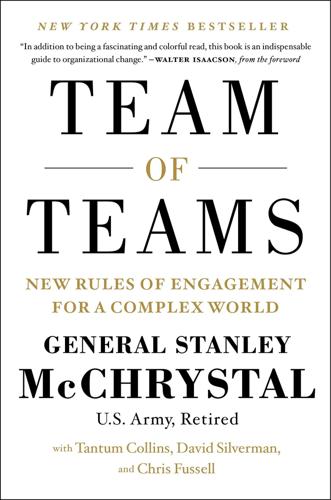
Team of Teams: New Rules of Engagement for a Complex World
by
General Stanley McChrystal
,
Tantum Collins
,
David Silverman
and
Chris Fussell
Published 11 May 2015
A true story, 860 miles to the east of Pharos, three thousand years later . . . CHAPTER 1 SONS OF PROTEUS Five muscled silhouettes, midnight blue against the sand-colored sunrise, moved down an otherwise empty street on the outskirts of the El Amel neighborhood in Baghdad. The morning call to prayer had just ricocheted through the urban sprawl and faded into the thick heat. A few blinds opened, then quickly closed; residents knew when to stay hidden. The door of a small house on the corner swung open and the men shuffled inside. It was September 30, 2004, and one of the biggest operations they would ever conduct was about to begin. The building appeared unremarkable—another ripple in the pixelated waves of tan cinder block that extended to the horizon.

Hell's Angels: A Strange and Terrible Saga
by
Hunter S. Thompson
Published 1 Jan 1966
The club dates back to the days of the Booze Fighters. “The Rattlers had a lot of class in the old days,” one of the Oakland Angels lamented. “But all they do now is sit around their bar and play dominoes.” ‡ Oakland’s official population is nearly four hundred thousand, but it is the center of a vastly urban sprawl called the East Bay, with a population of about two million—more than twice the size of San Francisco ‡ Eisenhower ‡ At one press conference in Oakland, held at the downtown office of the Angels’ bondswoman, I counted forty-two reporters on hand and thirteen microphones massed in front of Barger while he spoke—and five TV cameras. 22 He who makes a beast of himself gets rid of the pain of being a man.
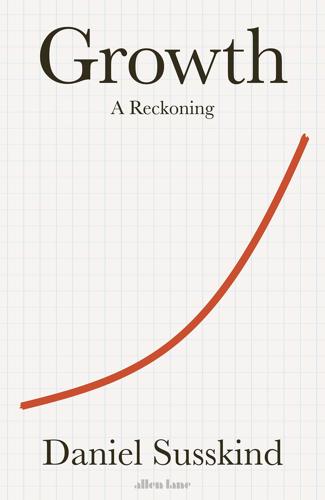
Growth: A Reckoning
by
Daniel Susskind
Published 16 Apr 2024
This might come as a surprise in a place like the UK, where the debate is particularly heated: many people are furious about the fact that some of our most successful cities are confined within ‘Green Belts’, surrounding rings of land where building is prohibited. (This is done not, as the name implies, for environmental reasons, but to encourage high-density development within the Belt and stop urban sprawl.) Again, it is entirely plausible that the growth of cities is important for the discovery and spread of new ideas, Paul Romer, for instance, holds cities in the highest regard for this very reason, praising them as ‘places where millions of people can meet and share ideas’.90 But in the post-pandemic world, this traditional reverence for physical places is far less compelling.
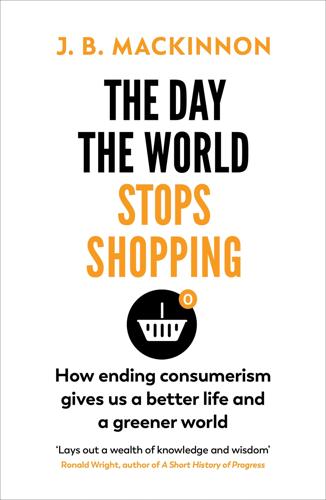
The Day the World Stops Shopping
by
J. B. MacKinnon
Published 14 May 2021
Noting that material poverty in the US was matched by an even greater “poverty of satisfaction, purpose, and dignity,” Kennedy decried GDP as a poor measure of the state of the nation. “Too much and for too long, we seemed to have surrendered personal excellence and community values in the mere accumulation of material things,” he said. The GDP was buoyed, he noted, by cigarette advertising, ambulances, home security, jails, the destruction of redwood forests, urban sprawl, napalm, nuclear warheads and the armoured vehicles used by police against riots in American cities. “It does not include the beauty of our poetry or the strength of our marriages, the intelligence of our public debate or the integrity of our public officials. It measures neither our wit nor our courage, neither our wisdom nor our learning, neither our compassion nor our devotion to our country.
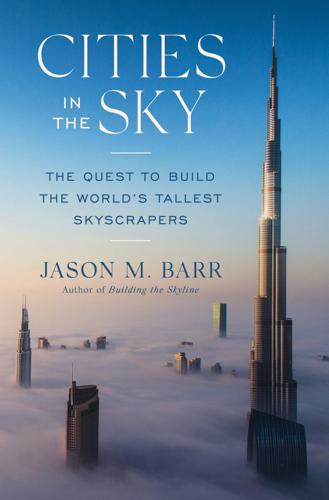
Cities in the Sky: The Quest to Build the World's Tallest Skyscrapers
by
Jason M. Barr
Published 13 May 2024
Despite its large wealth—its economy is larger than that of Mexico and India, respectively—it has implemented stringent building height regulations in the name of reducing congestion and improving the quality of urban life. Just as importantly, we find that higher gaps correlate with more expensive housing prices, greater urban sprawl, more traffic congestion, and more air pollution, including carbon monoxide and nitrogen oxide. In short, overly restrictive nations are hurting themselves. For most people who see the trees, the skyscrapers, it’s harder to see the forest, the skyline, but the health of the entire economic ecosystem is what matters.
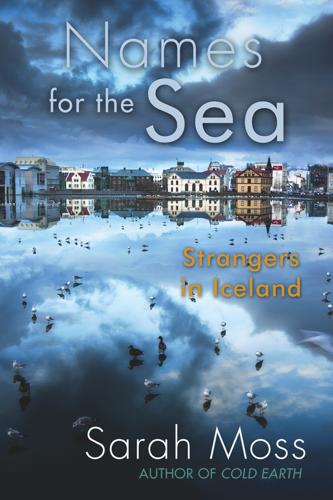
Names for the Sea
by
Sarah Moss
Published 27 Apr 2018
Red and blue clapboard houses crowd the harbour, and there’s a pedestrianised main street lined with shops and cafés. Cruise ships call; Max identifies one that visited Falmouth just before we left. I remember that when I discussed a possible trip with some of my students last year, they were ambivalent about Akureyri’s colonial architecture, seeing the newer, mall-centred urban sprawl as the face of modern Iceland and refusing to be nostalgic for an era of cold, hunger and social inequality. Middle age looms; I like the painted shop-fronts. We go to the pool I remember from Kathy’s birthday. It’s been developed into a complex of pools, built to recognise that babies need to bobble in peace while toddlers splash, that children old enough to want to dive are not old enough to see the point of lane-swimming.
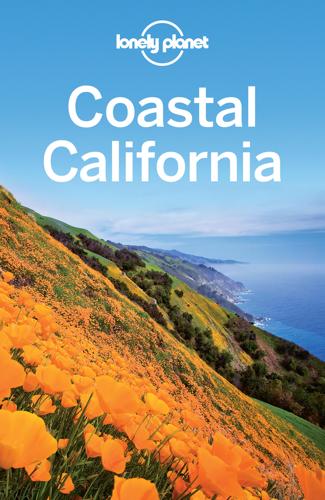
Coastal California
by
Lonely Planet
A cluster of isolated and supremely scenic HI hostels, at Point Montara (22 miles south of San Francisco) and Pigeon Point (36 miles), make this an interesting route for cyclists, though narrow Hwy 1 itself can be stressful, if not downright dangerous, for the inexperienced. PACIFICA & DEVIL’S SLIDE Pacifica and Point San Pedro, 15 miles from downtown San Francisco, signal the end of the urban sprawl. South of Pacifica is Devil’s Slide, an unstable cliff area through which Hwy 1 winds and curves. Drive carefully, especially at night and when it is raining, as rock and mud slides are frequent. Heavy winter storms often lead to the road’s temporary closure. A tunnel will soon bypass this dramatic stretch of the highway.
…
This cauldron of counter-culture is the place to get your hair braided or a qi gong back massage, or pick up cheap sunglasses or a woven bracelet. Encounters with bodybuilders, hoop dreamers, a Speedo-clad snake charmer or an in-line-skating Sikh minstrel are pretty much guaranteed, especially on hot summer afternoons. Alas, the vibe gets a bit creepy after dark. Horseback Riding Leave the urban sprawl behind on the forested bridle trails of Griffith Park or Topanga Canyon. All rides are accompanied by an experienced equestrian wrangler. Rates vary, and a 20% tip is customary. Los Angeles Horseback Riding HORSEBACK RIDING ( 818-591-2032; www.losangeleshorsebackriding.com; 2661 Old Topanga Canyon Rd, Topanga Canyon) Sunset, day and full-moon rides in the Santa Monica Mountains with fabulous views all around.

The Rough Guide to Peru
by
Rough Guides
Published 27 Apr 2024
A typical family-owned seafood restaurant, known throughout the region for making a killer ceviche and for grilled grouper freshly caught nearby. $ Chiclayo The commercial centre of northern Peru, CHICLAYO is better famed for its banks than its heritage. Nevertheless, it has its own attractions, even if most of the city is an urban sprawl modernizing and growing rapidly. The city has an incredibly busy feel to it, with people and traffic moving fast and noisily everywhere during daylight hours. Parque Principal and around The city’s heart is the Parque Principal, where there is a futuristic fountain that’s elegantly lit at night.
…
Congenial Mario Ojanama (961 571 880) – owner of the Los 3 Hermanos boat and founder member of the Asociación de Botes Turístico “Los Yacarunas” – and his son run such trips (very little English spoken); it’s a bare-bones adventure (around S/200 per day all-inclusive, usually for three days, two nights); a number of other operators offer something similar. Puerto Callao The former lakeside village, Puerto Callao, has virtually been swallowed up by the urban sprawl of Pucallpa, save for the delightful topiary-filled Plaza de Armas, with trees pruned into the shapes of wild beasts. While in the plaza, it’s worth dropping into the Moroti-Shobo Crafts Cooperative (daily 8am–5pm), staffed primarily by Shipibo women selling traditional textiles, but also some ceramics and jewellery.
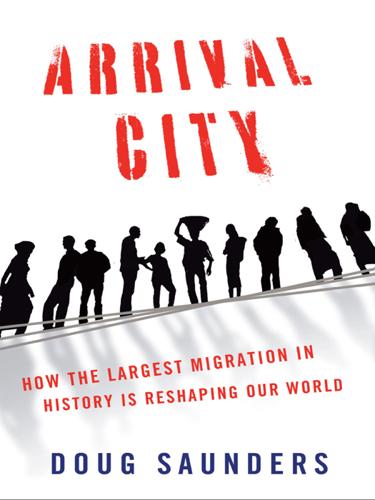
Arrival City
by
Doug Saunders
Published 22 Mar 2011
The Poles and eastern Europeans of the 2000s have made what scholars call a “J-turn”: They used migration to urbanize themselves in the cities of the Atlantic, then returned not to the village but to the major cities of their own countries, bringing savings and entrepreneurial knowledge with them. Their arrival ended the drought of skilled labor in Poland, and these arrival-city returnees contributed to economic revivals in Gdansk, Warsaw, and the “Polish silicon valley” of Wrocław, Cracow, and Upper Silesia. The Polish capital was by now experiencing genuine urban sprawl, and former rural areas around Warsaw’s perimeter were turning into new enclaves for ex-villagers who had arrived by way of the West. In large part as a result of this, Poland was the one of the few places in Europe that escaped the worst of the global economic downturn, experiencing economic growth (albeit at reduced levels) and maintaining exports.
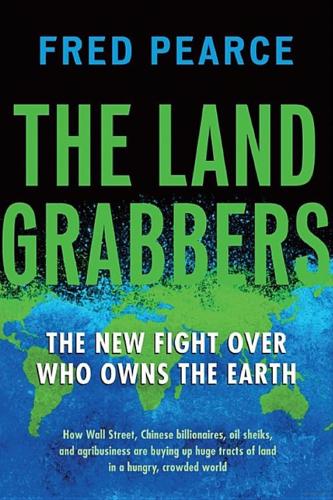
The Land Grabbers: The New Fight Over Who Owns the Earth
by
Fred Pearce
Published 28 May 2012
Ziegler’s account, “The Rubber Juggernaut,” is available at http://www.sciencemag.org (2009). Also see “China Rubber Demand Stretches Laos,” http://www.atimes.com (2007), and “Rubber: Costs or Benefits to the Lao PDR,” http://www.sumernet.org (2009). Doan Nguyen Duc is profiled in “Condo Boss,” at http://www.forbes.com (2009). “Farmland Grabs by Urban Sprawl and Their Impacts on Peasants’ Livelihood in China” is from the Brighton conference. Complant’s Jamaica deal is described in “Gov’t Seals Sugar Deal with Complant,” http://www.jamaicaobserver.com (2011). Beidahuang’s grabs are detailed in “China Ups Argentine Farmland Purchases,” http://www.lab.org.uk (2011) and “China Land Deal Causes Unease in Argentina,” http://www.guardian.co.uk (2011).
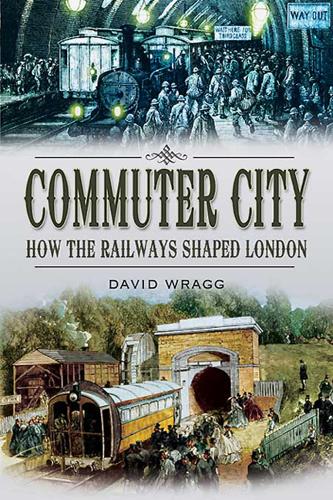
Commuter City: How the Railways Shaped London
by
David Wragg
Published 14 Apr 2010
The track consisted of cast-iron plates of L-section fixed to stone blocks, with a gauge of 4ft 2in. Traction was provided by horses, which, because of the lack of any substantial gradient, could move five or six wagons, each weighing 3½ tons fully loaded, at around 2½ mph. The line was supported by the many mills and factories spread along its route, showing that some, at least, of London’s urban sprawl pre-dated the arrival of the railways. Not realising its shortcomings, so obvious to us today with the benefit of hindsight (always 20:20 vision, of course) the promoters of the line had ambitions and were keen to see it extended to Portsmouth, but only succeeded in extending the tracks as far as the quarry at Merstham, a further 8½ miles.
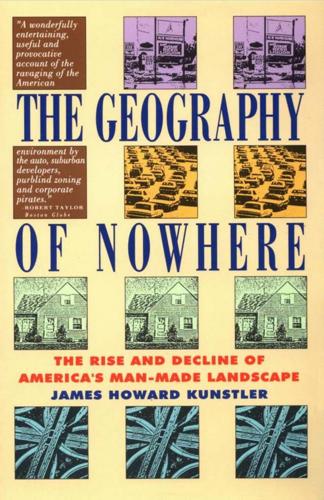
The Geography of Nowhere: The Rise and Decline of America's Man-Made Landscape
by
James Howard Kunstler
Published 31 May 1993
In symbolic shorthand it says, "We sell traditional real estate here ! We sell the coherence and stability, the enduring community, of traditional New England town life !" Saratoga is not a traditional New England town and never was. At the present time, Saratoga is the remnant of a Victorian gambling resort overlayed by an urban sprawl scape, with all the disconnectedness and loss of traditional values that implies. Why should this matter? Why not just accept the little fake church as a playful, harmless, adorable architectural oddity, as the lovers of kitsch do ? Because it's a bad building, cheaply cute, out-of-scale, symbolically false, and stuck in the middle of a parking lot, a little noplace that contributes to the greater noplace.
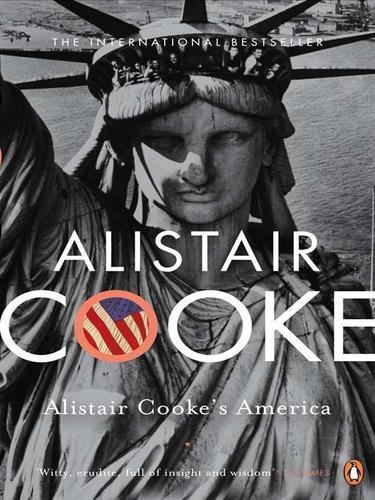
Alistair Cooke's America
by
Alistair Cooke
Published 1 Oct 2008
But the people of Honolulu are in the same stew as the rest of us, Eighty percent of the islanders have chosen to jam into this city. Planters burn sugar cane for real estate and fill the air with smoke and ash. Surf riders, noticing the signs – ‘Warning: Polluted Water’ – pick out the clean waves. There is choking traffic and urban sprawl and suburban density, and towering skyscrapers, and – ‘Stop For Guard Check’ – the new fear of one’s neighbor. Hawaiians had a strong original culture and now preserve a microcosm of it on the east coast of Oahu as a poor Hawaiian’s Williamsburg. The more entertaining elements – the music, the flower festivals, the hula, the native drinks – have been diluted and bottled for the tourists who invade the islands in order to feel carefree and safe in the last of the states.
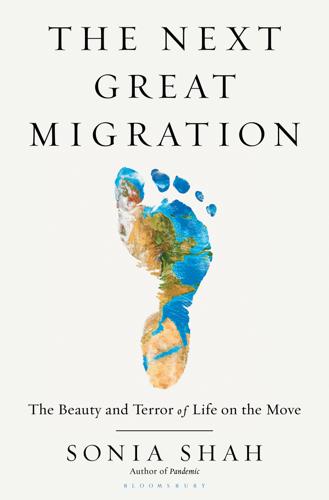
The Next Great Migration: The Beauty and Terror of Life on the Move
by
Sonia Shah
They were widely known, in the field, as “sedentary,” the entomological equivalent of homebodies. Meanwhile they were getting squeezed. The dwarf plantagos they preferred were drying out in the southern part of their range, as the carbon-torched climate in northern Mexico grew hotter and drier. The urban sprawl of growing cities such as Los Angeles and San Francisco, meanwhile, swallowed up the gentle, sun-drenched slopes of the northern end of their range. Trapped between climate change on one end and urban expansion on the other, the checkerspot, most butterfly experts believed, was doomed. It was a pretty simple story, being told in a range of variations across the globe.
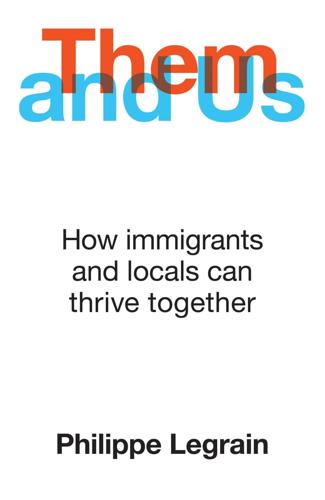
Them and Us: How Immigrants and Locals Can Thrive Together
by
Philippe Legrain
Published 14 Oct 2020
Attracting more migrants to support the working-age population would provide a demographic dividend. Yet some object that their country is already full up. Far from alleviating demographic pressures, they argue that immigration exacerbates the problems of a rising population, such as higher house prices, more congested roads and urban sprawl. Infamously, Nigel Farage once blamed immigration for traffic on the motorway that delayed his arrival at an event.46 For nativists, banging on about population pressures provides a veneer of respectability for their xenophobia, although they object to rising populations only when the extra people come from abroad.
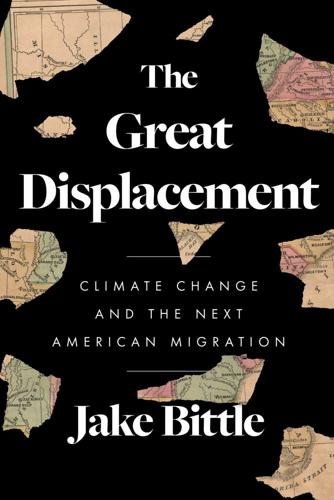
The Great Displacement: Climate Change and the Next American Migration
by
Jake Bittle
Published 21 Feb 2023
The local economy was sluggish, and most residents were far from wealthy, but the community was close-knit; as one resident later recalled, “We’d go to the local grocery store and sometimes it would take over an hour to get out, just to run in and get a gallon of milk or something, because we knew everybody.” Some residents had moved to Greenville from the Bay Area in search of cheap housing, while others relished the town’s distance from urban sprawl—a writer from Greenville would later recall a social tapestry made up of “retirees, hippies, bikers, rednecks, ranchers, [and] cowboys.” Inside the valley, insulated from the mountains by a screen of trees, it was easy to forget the rest of the world. On the evening of August 4, 2021, one of the largest wildfires in US history breached the valley surrounding Greenville.
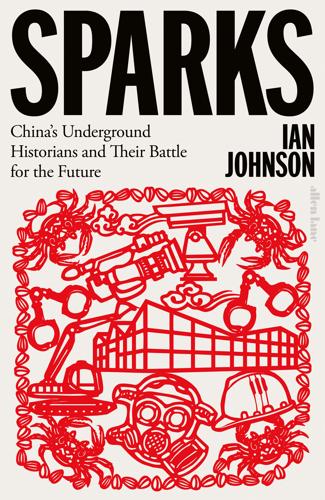
Sparks: China's Underground Historians and Their Battle for the Future
by
Ian Johnson
Published 26 Sep 2023
Memory: Videoing China’s Villages The Communication University of China in Beijing is the country’s version of the Columbia Journalism School—an elite training ground for future journalists. The sprawling campus in eastern Beijing used to be miles out of town (all the better to keep pesky writers at bay) but has now been swallowed up by Beijing’s urban sprawl and is easily reached by subway or highway. One of its schools is the Cui Yongyuan Center for Oral History, named after a famous China Central Television host who joined the faculty in 2012. Cui Yongyuan was one of the best-loved personalities on CCTV, a humorous, self-deprecating host of several shows, especially a talk show “Tell It Like It Is” that he ran from 1996 to 2002.

Stuck: How the Privileged and the Propertied Broke the Engine of American Opportunity
by
Yoni Appelbaum
Published 17 Feb 2025
But as effective as it was at creating opportunity and fostering equality, the boom in development worried many Californians. The Nader group’s finished report on land use stretched more than twelve hundred pages, later abridged into a somewhat more digestible form and published as a book. In its introduction, Nader recited a litany of problems facing California, including “urban sprawl, mindless development spawned and exploited by speculators, the near certainty of catastrophic earthquakes, bumper-to-bumper mobility, pollution, private seizure of public wealth, and the complicity of government and land interests.” As before, the problems Nader’s Raiders had identified were very real.
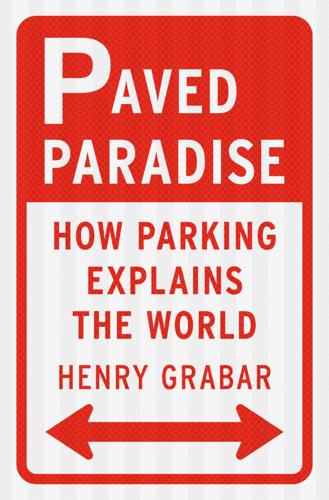
Paved Paradise: How Parking Explains the World
by
Henry Grabar
Published 8 May 2023
Go to note reference in text This transition is associated: Benoît Geslin et al., “The Proportion of Impervious Surfaces at the Landscape Scale Structures Wild Bee Assemblages in a Densely Populated Region,” Ecology and Evolution 6, no. 18 (September 2016): 6599–615, doi.org/10.1002/ece3.2374. Go to note reference in text prior to 1950: Oliver Gillham, The Limitless City: A Primer on the Urban Sprawl Debate (Washington, DC: Island Press, 2002), 85. Go to note reference in text Various studies have estimated: Annalise G. Blum et al., “Causal Effect of Impervious Cover on Annual Flood Magnitude for the United States,” Geophysical Research Letters 47, no. 5 (March 2020): e2019GL086480, doi.org/10.1029/2019GL086480.

The Everything Blueprint: The Microchip Design That Changed the World
by
James Ashton
Published 11 May 2023
Thomas left a note for colleagues to say he was sorry. The funeral was held in Cambridge, followed by a wake in Harvey’s Barn. Chapter 5 NOKIA’S MAD PHONE SETS THE STANDARD A Japanese Puzzle Just an hour north of Tokyo, the prefecture of Nagano was the perfect antidote to Japan’s always-on, neon-lit urban sprawl. Among its mountains, farmland and abundant wildlife, visitors could tour the historic five-tower Matsumoto Castle, watch snow monkeys at play and relax in hot springs. One of Arm’s engineers, Dave Jaggar, was on his way there in January 1994 for another reason. Together with his bosses, Robin Saxby and Mike Muller, they had tacked a few days’ skiing on to their latest business trip to sell Arm’s technology around the world.

Radical Technologies: The Design of Everyday Life
by
Adam Greenfield
Published 29 May 2017
The more audacious observers of technical advancement dare to speculate that the point is not far off at which molecular nanotechnology and the “effectively complete control over the structure of matter” it affords finally bring the age of material scarcity to its close.25 In places where Green Plenty has broken out, most large-scale interventions in the built environment are intended to democratize access to the last major resource truly subject to conditions of scarcity: the land itself. Placeless urban sprawl is overwritten by high-density megastructures woven of recovered garbage by fleets of swarming robots.26 Equal parts habitat and ecosystem, they bear the signature aesthetic of computationally generated forms no human architect or engineer would ever spontaneously devise, and are threaded into the existing built fabric in peculiar and counterintuitive ways.
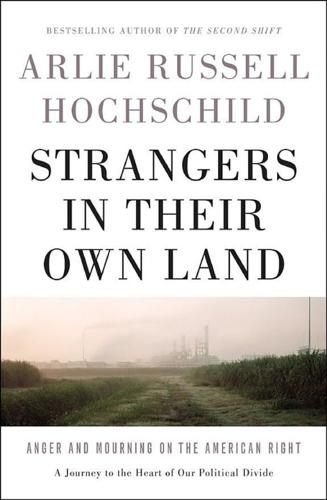
Strangers in Their Own Land: Anger and Mourning on the American Right
by
Arlie Russell Hochschild
Published 5 Sep 2016
Many members we met had grown up in small towns in the Midwest and felt deeply disoriented in California’s anomic suburbs, an unease they transformed into a belief that American society was at risk of being taken over by communists. Looking around, we could well understand why they felt “taken over”—in a few years, entire orange groves had disappeared into parking lots and shopping malls, a case of wildly unplanned urban sprawl. We too felt taken over by something, but it wasn’t communism. I have lived most of my life in the progressive camp but in recent years I began to want to better understand those on the right. How did they come to hold their views? Could we make common cause on some issues? These questions led me to drive, one day, from plant to plant in the bleak industrial outskirts of Lake Charles, Louisiana, with Sharon Galicia, a warm, petite, white single mother, a blond beauty, on her rounds selling medical insurance.

Confronting Gun Violence in America
by
Thomas Gabor
Published 12 Sep 2016
In his book Bowling Alone: The Collapse and Revival of American Community, Putnam painstakingly demonstrates how social networks have declined over the last few decades in so many areas of community life.179 Putnam shows that there has been a decline in • political participation (e.g., voter turnout, volunteering for a political party); 334 Confronting Gun Violence in America • civic participation (e.g., fraternal organizations, Parent–Teacher Associations); • religious participation (e.g., church membership, Bible study groups); • workplace connections (e.g., union membership, ties with coworkers); • informal social connections (e.g., meals involving the entire family, visits with friends); • philanthropy; and • honesty and trust of fellow citizens. Putnam attributes the disengagement of Americans from community life to television and electronic communications, generational change (the replacement of the civic-minded generation born before 1946 by their less involved offspring and grandchildren), urban sprawl, and, to a lesser extent, time and money pressures. He states that electronic communications and entertainment have rendered our leisure activities more passive and private. We spend more time watching things and less time doing things with others. Bowling Alone was published in 2000. One can only imagine the level of community disengagement and impersonality of communications Putnam would find today with the advent of smart phones and the emergence of social media.
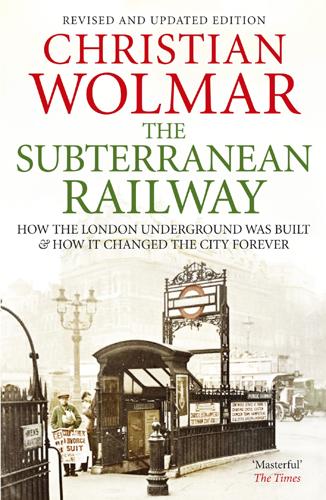
The Subterranean Railway: How the London Underground Was Built and How It Changed the City Forever
by
Christian Wolmar
Published 30 Sep 2009
The LT’s dominance also allowed it to set fares which were not as expensive, per mile, as stations which were further away from central London, and this increased the competitive advantage of the more distant suburbs in relation to the ones closer to town. Given that land prices were somewhat cheaper in those areas, LT’s policy meant that these suburbs grew much more quickly than would otherwise have been the case. How much, ultimately, that benefited London and Londoners is debatable. It could be argued that this policy ensured even more urban sprawl and, moreover, the faster dispersal of the tightly knit communities characteristic of crowded inner-city life. Nevertheless, Charles Pearson would have been pleased. The gradual climb out of the Depression also provided the ideal economic conditions for the rapid growth of the suburbs. The stock market crash, and the low returns on government securities, meant the building societies were awash with cash and eager to lend to house purchasers.
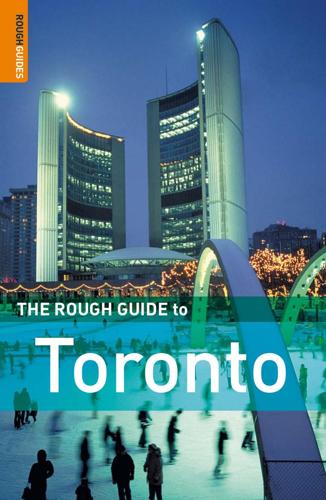
The Rough Guide to Toronto
by
Helen Lovekin
and
Phil Lee
Published 29 Apr 2006
THE WATE RF RON T AN D THE TORONTO I S L A N D S Hanlan’s Point 97 THE S UBURBS The suburbs | V enturing outside the city centre is certainly worth your while, especially since many major attractions – like the Toronto Zoo, the Ontario Science Centre and Black Creek Pioneer Village – are found in the suburbs, notably Scarborough and North York. Large swaths of undeveloped, natural parkland ring the suburbs and provide opportunities for outdoor sporting activities usually associated with the hinterlands rather than major cities. Additionally, far from being monochromatic stretches of urban sprawl, Toronto’s suburbs echo the cultural diversity so prevalent downtown. In particular, they are great places to experience ethnic cuisines, such as regional classics from China as well as Persian dishes served during long, multi-coursed feasts. Toronto’s extensive transit system takes passengers to the city’s perimeters for the single (adult) flat rate of $2.50.
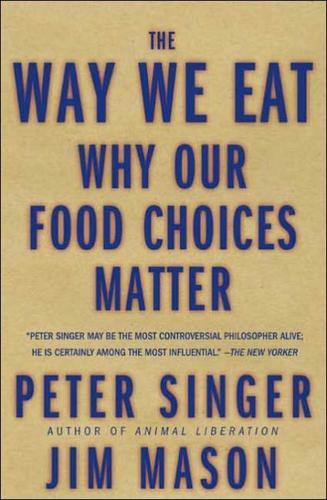
The Way We Eat: Why Our Food Choices Matter
by
Peter Singer
and
Jim Mason
Published 1 May 2006
EATING THE STANDARD AMERICAN DIET JAKE AND LEE here is no downtown, no bustling public square, no quaint historic district in Mabelvale, Arkansas. The "main drag" is Baseline Roadfour lanes of traffic running through a corridor of gas stations, convenience stores, and strip malls in the urban sprawl southwest of Little Rock, to which it was annexed in 1980. Sixty percent of Mabelvale's 5,000 inhabitants are white, 25 percent are African-American, and 10 percent are Latino; they live in homes worth around $75,000 and earn about $30,000 annually. Among the residents of Mabelvale is the family of Jake Hillard, 36, and Lee Nierstheimer, 26.
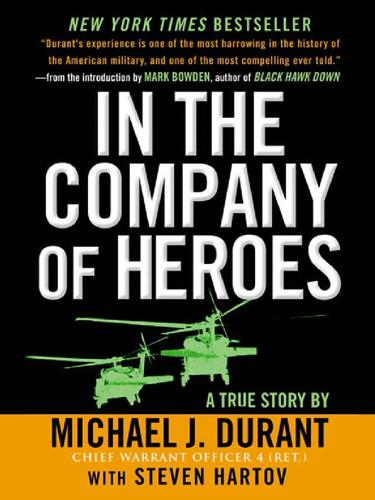
In the Company of Heroes
by
Michael J. Durant
and
Steven Hartov
Published 1 Dec 2006
Ray and I were flying by rote, heads alternating inside and outside the cockpit, tuning radios, reviewing maps, doing our pre-assault checks, miniguns armed, shoulder harnesses locked, and all the while orienting ourselves on the city below and keeping our spot in the flight. It wasn’t even a five-minute hop and we were over the thick of the city, if you could call it that. It was more like an urban sprawl of concrete and plaster huts, corrugated roofs, frameless windows, jagged holes punched into everything. I remembered how when I’d first come into Mogadishu a month earlier aboard a C-5A, from a distance the pastel Indian Ocean and sugar cube town looked like the French Riviera. And then you got up close and the Mog’s bad haircut and acne scars came into focus.
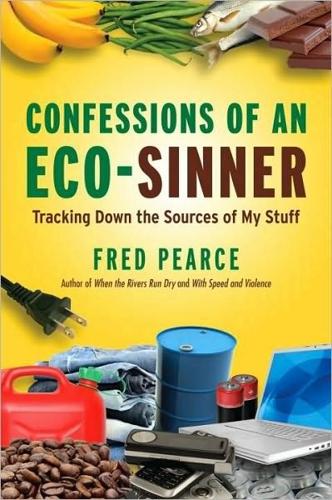
Confessions of an Eco-Sinner: Tracking Down the Sources of My Stuff
by
Fred Pearce
Published 30 Sep 2009
The Shenzhen plant feeds off dozens of local component manufacturers, like Delta, which employs 20,000 young workers in nearby Dongguan and is the world’s largest manufacturer of adaptors and capacitors for computers and mobile phones. And Hua Tong in nearby Huizhou, which makes Nokia’s circuit boards. Like Foxconn, both are Taiwanese companies. Shenzhen is a city literally made by mobile phones. Twenty-five years ago it was a fishing village surrounded by rice paddy. Today it is an urban sprawl of 12 million people – twice the size of Hong Kong – and stretches for 100 kilometres along the east bank of the Pearl River to Dongguan. I met a man who had been resident for eighteen years in Shenzhen. He claimed he knew nobody who had been there longer. I certainly felt, and quite possibly was, the oldest person in the city.
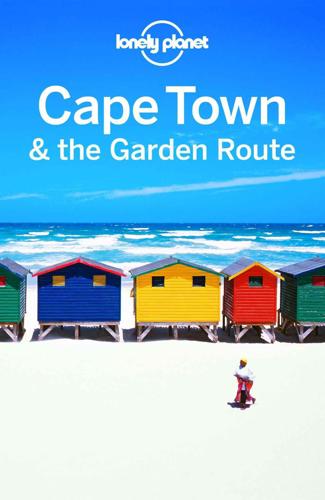
Lonely Planet Cape Town & the Garden Route (Travel Guide)
by
Lucy Corne
Published 1 Sep 2015
You’ll find some 3000 of the friendly penguins at Boulders Beach. Scoring Cape Town's Environment In 2014, Cape Town scored highly on Siemens' African Green Cities Index (www.siemens.co.za/sustainable-development), and was praised for its comprehensive Energy and Climate Change Action Plan and policies to contain urban sprawl and protect green space. Areas for improvement include having the highest carbon-dioxide emissions per capita from electricity consumption in the index (which covers 15 major African cities), and the second highest generation of waste. That said, the report notes city initiatives to tackle waste generation, including schemes to separate recyclables before collection and an Integrated Waste Exchange program to facilitate the exchange of potentially useful materials.
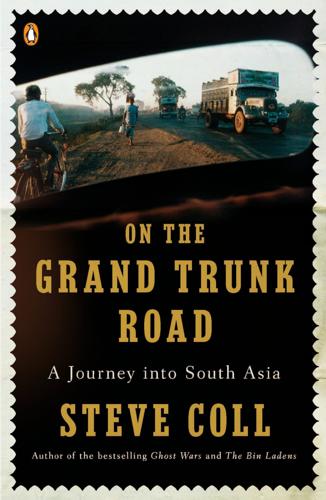
On the Grand Trunk Road: A Journey Into South Asia
by
Steve Coll
Published 29 Mar 2009
On polling day the question was whether or not the vote would be stolen by the government, so those foreigners who were around fanned out to the cities and the countryside looking for malfeasance. As it turned out, what malfeasance occurred was generally difficult to see, so mostly we scurried from polling place to polling place and watched large numbers of Pakistanis stand in line. Late in the day, in Rawalpindi, a gray-brown urban sprawl just south of the capital of Islamabad, I wound up in an elementary school that was being used as a polling booth. The lone classroom was dim and bare. A single naked lightbulb glared above concrete floors and chipped green walls. Anatomy posters of human skeletons and organs loomed over rows of old wooden desks, the kind with holes for ink pots.
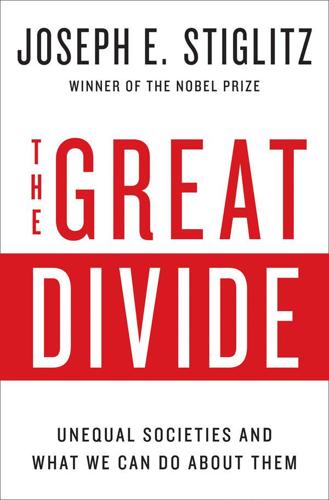
The Great Divide: Unequal Societies and What We Can Do About Them
by
Joseph E. Stiglitz
Published 15 Mar 2015
Schools in poorer districts get worse, parents with means move out to richer districts, and the divisions between the haves and have-nots—not only in this generation, but also in the next—grow ever larger. Residential segregation along economic lines amplifies inequality for adults, too. The poor have to somehow manage to get from their neighborhoods to part-time, low-paying, and increasingly scarce jobs at distant work sites. Combine this urban sprawl with inadequate public transportation systems and you have a blueprint for transforming working-class communities into depopulated ghettos. Adding to the problems that would inevitably arise from such poorly designed urban agglomerations is the fact that the Detroit metropolitan area is divided into separate political jurisdictions.
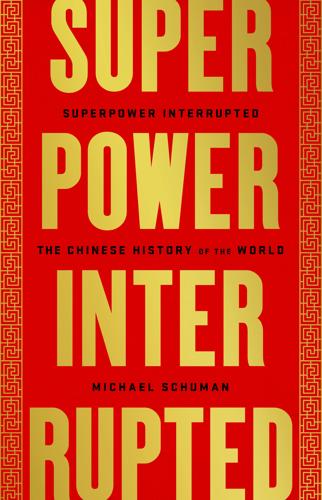
Superpower Interrupted: The Chinese History of the World
by
Michael Schuman
Published 8 Jun 2020
Voilà! Myth became history. Still, the oracle bones only provide the bare bones of Shang history. Sometime in the mid-sixteenth century BC, Erlitou collapsed and the Shang rose, with the dynasty’s founding dated at 1554 BC. Anyang was probably the last of several capital cities. It was a gargantuan urban sprawl for its age: perched majestically on the Huan River, the royal compound had fifty-three large buildings, one possibly as long as a football field. The economic might and technical skill of the Shang loomed just as large. A bone factory is estimated to have churned out four million tools in the 150 years it operated.
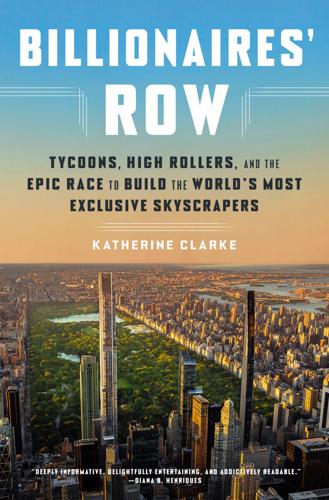
Billionaires' Row: Tycoons, High Rollers, and the Epic Race to Build the World's Most Exclusive Skyscrapers
by
Katherine Clarke
Published 13 Jun 2023
Developers in New York also had less interest in building megatalls. For the most part, the demand for the space simply hadn’t been great enough to justify the enormous cost of construction. By contrast, in Asia and the Middle East, the push to build tall emerged from less of a practical concern—to facilitate population growth and avoid urban sprawl—and more of a mission of symbolism and status. “Vanity height” took precedence over usability. Some supertalls were even paid for by governments rather than private developers. We can see this play out in the shifting global supertall ranking. The United States held the record for the world’s tallest building until 1998, when the Sears Tower in Chicago was eclipsed by the Petronas Towers in Kuala Lumpur.

England
by
David Else
Published 14 Oct 2010
Ragley is 2 miles southwest of Alcester off the A435/A46, or about 10 miles west of Stratford-upon-Avon. STAFFORDSHIRE Stoke-born novelist Arnold Bennett once wrote that Staffordshire was ‘unsung by searchers after the extreme’, but that doesn’t mean that it’s boring. Wedged between the urban sprawls of Birmingham and Manchester, the county is surprisingly beautiful, from rolling Cannock Chase, a magnet for walkers and cyclists, to the jagged backbone of the Peak District known as the Roaches. The stern might of Lichfield’s cathedral, the wild rides at Alton Towers, and the neoclassical mansion of Shugborough are among the county’s other charms.
…
Then in medieval times the town grew fat on the wool trade. It is also the birthplace of Charles Darwin (1809–82), who rocked the world with his theory of evolution. Orientation Shrewsbury’s near-island status helps preserve the Tudor and Jacobean streetscapes of its centre and protects it from unattractive urban sprawl. The train station is a five-minute walk northeast of the centre and is as far as you’ll need to venture. Information Library ( 01743-255300; Castle Gates; 9.30am-5pm Mon, Wed, Fri & Sat, 9.30am-8pm Tue & Thu, 1-4pm Sun) Free internet access. Royal Shrewsbury Hospital ( 01743-261000; Mytton Oak Rd) Tourist office ( 01743-281200; www.visitshrewsbury.com; Music Hall, The Square; 9.30am-5.30pm Mon-Sat, 10am-4pm Sun May-Sep; 10am-5pm Mon-Sat Oct-Apr) Guided walking tours (adult/child £3.50/1.50 1½hr) leave the tourist office at 2.30pm Monday to Saturday, and 11am Sunday from May to September and at 2.30pm Saturday only from November to April.
…
The communities had to then rely on their own resources, gradually becoming reabsorbed into the war-band culture of the native Britons – for some generations soldiers had been recruited locally in any case. Orientation Hadrian’s Wall crosses beautiful, varied landscape. Starting in the lowlands of the Solway coast, it crosses the lush hills east of Carlisle to the bleak, windy ridge of basalt rock known as Whin Sill overlooking Northumberland National Park, and ends in the urban sprawl of Newcastle. The most spectacular section lies between Brampton and Corbridge. Carlisle, in the west, and Newcastle, in the east, are good starting points, but Brampton, Haltwhistle, Hexham and Corbridge all make good bases. The B6318 follows the course of the wall from the outskirts of Newcastle to Birdoswald; from Birdoswald to Carlisle it pays to have a detailed map.
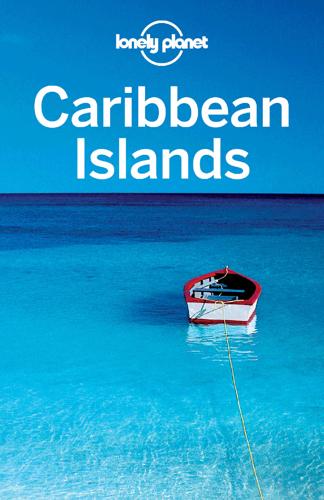
Caribbean Islands
by
Lonely Planet
For supermarkets, you’ll find a Leader Price and a Match on the southern outskirts of Plage de Malendure. LES SAINTES These tiny islands to the south of Basse-Terre are many people’s highlight of Guadeloupe, as they allow visitors to enjoy a slice of the old Caribbean, far from the development and urban sprawl that has affected much of the region. These tiny charmers are a real secret – many day-trippers come over from Basse-Terre, but very few people spend any real time here exploring these gems. Don’t miss your chance. Terre-de-Haut POP 1800 Lying 10km off Guadeloupe is Terre-de-Haut, the largest of the eight small islands that make up Les Saintes.
…
Volcanic in origin, the island is a mountainous stunner crowned by the still-smoldering Mont Pelée, which wiped out Martinique’s former capital of St-Pierre in 1902. Long luscious beaches, great diving and giant mountains covered in tropical forests are the main attractions here. Far more developed than much of the Caribbean, Martinique suffers from uncontrolled urban sprawl in some places, particularly in and around the busy capital, Fort-de-France. Those wanting to avoid the modern world’s encroachment should head to the beautiful beaches of the south or to the mountains of the island’s remote north. When to Go Martinique enjoys a year-round tropical climate, but it is most popular during the dry season, from December to May.
…
The two routes can be combined to make a fine loop drive; if doing the whole loop, give yourself a full day. Fort-de-France to St-Pierre The mountainous and in parts spectacular coastal road from Fort-de-France to the old capital of St-Pierre runs through a succession of small towns, fishing villages and the odd bit of urban sprawl. The 21km trip takes around 45 minutes. It’s worth swinging off the highway at Case-Pilote to take a peek at the old village center. Turn west off the N2 at the Total gas station and you’ll come to a quaint stone church, one of Martinique’s oldest. Just 75m south of that is a charming town square with a water fountain, historic town hall, tourist office and moderately priced cafe.

Egypt
by
Matthew Firestone
Published 13 Oct 2010
Return to beginning of chapter Around Cairo * * * MEMPHIS & THE EARLY PYRAMIDS MEMPHIS PYRAMIDS OF ABU SIR SAQQARA DAHSHUR AL-FAYOUM OASIS MEDINAT AL-FAYOUM KARANIS PYRAMID OF MEIDUM PYRAMID OF HAWARA PYRAMID OF AL-LAHUN LAKE QARUN WADI RAYYAN & WADI AL-HITTAN THE ROAD TO ALEXANDRIA BIRQASH CAMEL MARKET WADI NATRUN THE NILE DELTA NILE BARRAGES ZAGAZIG & BUBASTIS TANIS TANTA AREA * * * Held hostage by Cairo’s endless charms (or perhaps desperate to flee in search of more relaxed locales), too few travellers explore the capital’s surrounding countryside. However, those who manage to escape from the urban sprawl discover a serene landscape of luscious green fields and palm groves that end abruptly at the edges of the vast desert. And importantly, the outskirts of Cairo are home to some of the oldest and most impressive ancient sites in Egypt. On the southern edge of the city limits lies the city of Memphis, which was once the mighty capital of the Old Kingdom.
…
Easier still, take a taxi from central Cairo all the way to the old site (about E£10); Imbaba airport (matar Imbaba) is the closest landmark. Once at Imbaba, ask a local to show you where to get the microbus (E£1) to Birqash. From Imbaba, the road winds through fields dotted with date palms, dusty villages, orange orchards and patches of encroaching urban sprawl before climbing the desert escarpment to the market. Microbuses from Birqash back to Imbaba leave when full: depending on the time of the day, you could wait up to two hours or so. The easiest way to get to and from the market is to hire a private taxi for the morning. The market is an easy half-day trip (one to 1½ hours) from Cairo, and one hour in the hot and dusty market is usually enough for most people.
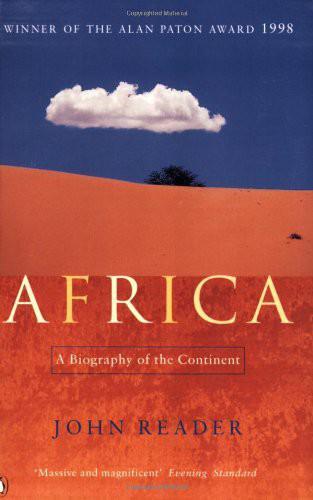
Africa: A Biography of the Continent
by
John Reader
Published 5 Nov 1998
Furthermore, ‘cakes of copper’ and other items bearing strong affinities with artefacts characteristic of Zambia, the Congo basin, and West Africa, invite the conclusion28 that Great Zimbabwe was on the eastern edge of a widespread and complex internal trading network which substantially pre-dated the external trade that was founded primarily on gold. At the time of its pre-eminence in the fifteenth century, at least 11,000 and possibly as many as 18,000 people are said to have lived at Great Zimbabwe.29 The massive stone-built enclosures were in fact only the central feature of an extensive urban sprawl of huts and living space30 that covered an area of about seven kilometres in circumference.31 Great Zimbabwe was large enough to be called a town, or even a city, but this was urban living at its most basic and unhealthy. The huts were so close together that their eaves nearly touched.32 Such a dense concentration of human activity imposed tremendous demands on the natural resources of the surrounding regions.
…
As the site grew larger, people were obliged to travel ever further to tend fields and gather firewood. Ultimately the system became unsustainable; the centre could not hold and political authority gravitated to the periphery. Great Zimbabwe flourished for little more than one hundred years. When the stone enclosures and surrounding urban sprawl were abandoned in the late fifteenth century, the ecological damage that just three or four generations of human inhabitants had inflicted upon the landscape was such that certain tree species will not grow in the area to this day.33 With the collapse of Great Zimbabwe two other Shona states rose to prominence on the plateau: Torwa, centred on Khami, about 250 km west of Great Zimbabwe; and Mutapa, 400 km north.
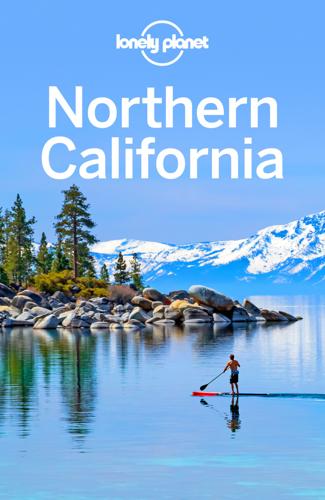
Northern California Travel Guide
by
Lonely Planet
Check www.sjdowntownparking.com for details. Pacifica & Devil’s Slide One of the real surprises of the Bay Area is how fast the cityscape disappears along the rugged and largely undeveloped coast. The lazy beach town of Pacifica, just 15 miles from downtown San Francisco, signals the end of the urban sprawl. Most beaches along Hwy 1 are buffeted by wild and unpredictable surf, making them better suited to sunbathing (weather permitting) than swimming. Immediately south of Pacifica is the Devil’s Slide, a gorgeous coastal cliff area now bypassed by a car tunnel. Pacifica State BeachBEACH (Linda Mar Beach; GOOGLE MAP ; %650-738-7381; www.parks.ca.gov; 5000 Pacific Coast Hwy; per car $5-9; h5am-dusk; pc) In Pacifica, collecting a suntan or catching a wave are the main attractions at popular Pacifica State Beach, as well as Rockaway Beach just north.
…
Though the north is more sparsely populated than the south, together they comprise the largest population of any US state, and have the nation’s highest projected growth rate. This puts tremendous strain on the natural environment, which is under constant threat from logging, drought, water diversion and urban sprawl. Lay of the Land The third-largest state after Alaska and Texas, California covers more than 155,000 sq miles, making it larger than 85 of the world’s smallest nations. California is bordered to the north by Oregon, the east by Nevada and Arizona, the south by Mexico, and the west by 3427 miles of Pacific coastline.
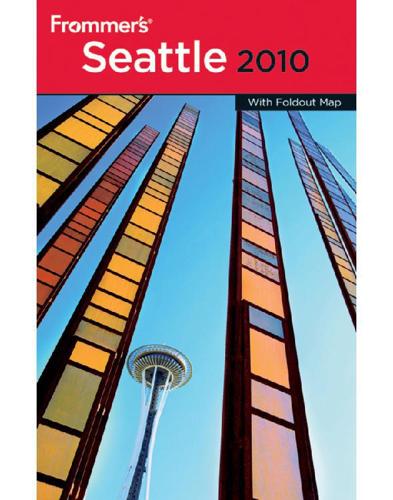
Frommer's Seattle 2010
by
Karl Samson
Published 10 Mar 2010
Bremerton isn’t just about naval history; it’s also home to the Aurora Valentinetti Puppet Museum, 257 Fourth St. ( 36 0/373-2992;www.ectandpuppets.com), which has a large collection of puppets and marionettes and is sure to be a hit with your younger children. The museum is open Wednesday through Saturday from 11am to 4pm. Admission is by donation. 7 Snoqualmie Falls & the Snoqualmie Valley One of the reasons so many people put up with Seattle’s drawbacks—urban sprawl, congested highways, and high housing prices—is that less than an hour east lie mountains so vast and rugged you can hike for a week without crossing a road. Between the city and this wilderness lie the farmlands of the Snoqualmie Valley, the Seattle region’s last bit of bucolic countryside. Here you’ll find small towns, pastures full of spotted cows, “U-pick” farms, and a few unexpected attractions, including an impressive waterfall and a reproduction of a medieval village.
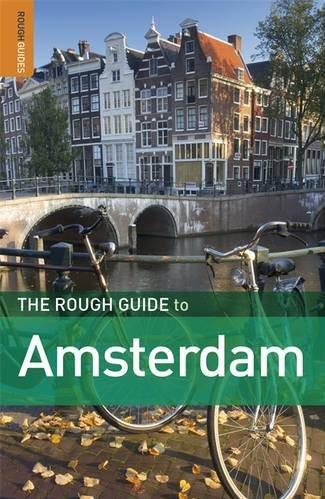
The Rough Guide to Amsterdam
by
Martin Dunford
,
Phil Lee
and
Karoline Thomas
Published 4 Jan 2010
The fast and efficient Dutch railway network puts a whole swathe of the Netherlands within easy reach, including all of the Randstad (literally “Ring City”), a sprawling conurbation that stretches south of Amsterdam to encompass the country’s other big cities, primarily The Hague, Utrecht and Rotterdam. Amid the urban sprawl, and very close to Amsterdam, is one especially appealing medium-sized town, Haarlem, whose attractive centre is home to the outstanding Frans Hals Museum. Further south – about 40km from Amsterdam and 15km from Haarlem – is another enticing attraction, the world–famous Keukenhof Gardens, the springtime showcase for the country’s flower growers, the land striped by long lines of brilliant blooms.
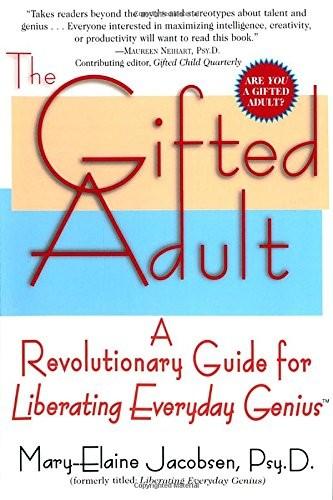
The Gifted Adult: A Revolutionary Guide for Liberating Everyday Genius(tm)
by
Mary-Elaine Jacobsen
Published 2 Nov 1999
When Jordan finally realized that neither the “meet until there’s consensus” nor the “do it all yourself” approach offered the right solution, he brought an “in-and-out” procedure to his team. Each member would retain ownership, credit, and accountability for his or her element of the research, while all were committed to the same goal and underlying principle: Save the venerable oaks of the Midwest’s Big Woods from extinction by oak wilt and urban sprawl. Even though at first the others were skeptical, thinking Jordan’s time- and ego-saving approach was too simple to be effective, they eventually found tremendous value in it. In large part this was because, just as in sports, Jordan had learned that timing was everything. Earlier in his career his sagacity had backfired because others distrusted and dismissed his ideas either when he revealed them too early in the process or if they required too great a leap of faith.
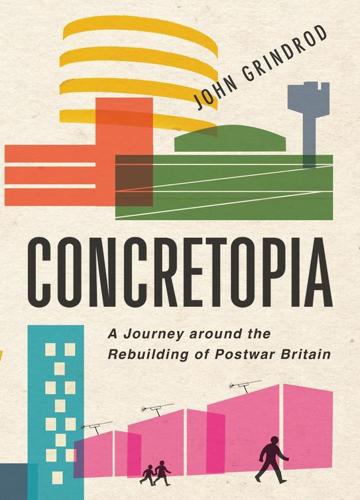
Concretopia: A Journey Around the Rebuilding of Postwar Britain
by
John Grindrod
Published 2 Nov 2013
The tree gives some idea of the high winds experienced in ‘Little Siberia’. This vast estate was built seven miles outside Croydon town centre, on top of a hill so chilly, windswept and isolated it has earned the nickname Little Siberia. In 1935, just as ‘green belt’ legislation was being introduced to protect the area around London from urban sprawl, the land was bought by developer Charles Boot, whose company had been responsible for building more interwar houses than any other. Not everyone was thrilled at the prospect of a new estate being built on this wooded hill. ‘We know people have got to live somewhere, but there are so many other spaces more suitable for building,’ opined the vicar of Addington Village, which sat at the foot of the hill.1 Relations between the two settlements, ancient village and new estate, have not improved over time. 1,000 red-brick semis were built by Charles Boot in the late thirties. © Croydon Local Studies Library and Archives Service Yet 1,000 red-brick semis and maisonettes were built before the war and a further 1,000 prefabricated council houses and flats joined them in the fifties and sixties.

City: A Guidebook for the Urban Age
by
P. D. Smith
Published 19 Jun 2012
In recent years, although the population of the city has been falling, that of the Distrito Federal has risen: 1.8 million by 1996 and growing. 94. The word ‘conurbation’ was coined in 1915 by Patrick Geddes, a disciple of Ebenezer Howard, to describe how towns expand to form a continuous built-up area, the result of urban sprawl. 95. Cited from Jackson (1985), 12. 96. Jackson (1985), 15. 97. Jackson (1985), 16. 98. See Oxford English Dictionary, online (2nd, 1989); Carolyn Whitzman, Suburb, Slum, Urban Village: Transformations in Toronto’s Parkdale Neighbourhood, 1875–2002 (Vancouver: University of British Columbia Press, 2009), 34. 99.

Fire in the Valley: The Birth and Death of the Personal Computer
by
Michael Swaine
and
Paul Freiberger
Published 19 Oct 2014
But it started with two bored teenagers playing with scavenged electronics. Jobs and Woz Woz was fortunate to hook up with an evangelist. —Regis McKenna, high-tech marketing guru There were still orchards in Santa Clara Valley. But by the 1960s it was no longer the largest fruit-producing area in the world. It was starting to transition to urban sprawl as the electronics and semiconductor companies began taking over, and for the son of an engineer in Sunnyvale it was easier to pick up a spare transistor than to find somewhere to pick an apple. The Prankster In 1962, an eighth-grade boy in Sunnyvale built an addition-subtraction machine out of a few transistors and some parts.

Iron Sunrise
by
Stross, Charles
Published 28 Oct 2004
Cho was a diplomat, and a polished and experienced gambler who liked nothing better than a game of three-stud poker — so the experience of seeing him actually looking angry and upset about something was a novelty in its own right. The wall behind him showed supporting evidence. Rippling fields of grain as far as the eyes could see, a city rising — if that was the word for an urban sprawl where only city hall was more than three stories high — from the feet of blue-tinted mountains, white-painted houses, huge automated factory complexes, wide empty roads stretching forever under a sky the color of bluebells. “Not everyone on Moscow was totally laid-back,” George continued, after taking a sip from his water glass.
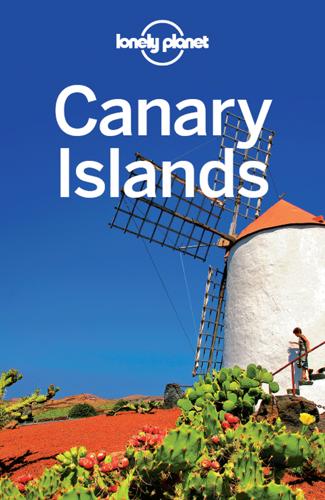
Canary Islands Travel Guide
by
Lonely Planet
On the grand scale, it was primarily Manrique’s persistent lobbying for maintaining traditional architecture and protecting the natural environment that prompted the cabildo (government) to pass laws restricting urban development. The growing wave of tourism since the early 1980s has, however, threatened to sweep away all before it. But Manrique’s ceaseless opposition to such unchecked urban sprawl touched a nerve with many locals and led to the creation of an environmental group known as El Guincho, which has had some success in revealing – and at times even reversing – abuses by developers. Manrique was posthumously made its honorary president. As you pass through villages across the island, you’ll see how traditional stylistic features remain the norm.
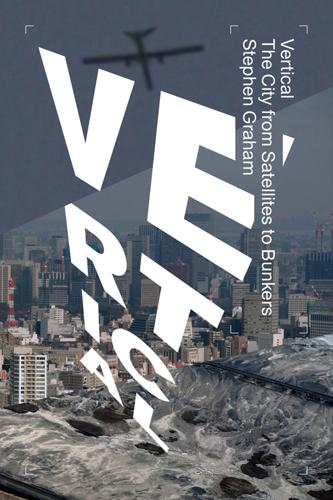
Vertical: The City From Satellites to Bunkers
by
Stephen Graham
Published 8 Nov 2016
Only a powerfully coordinated approach to planning, engineering and design between emerging groups of tall buildings similar to the integrated engineering that currently plugs them into ground and subterranean-level infrastructures might allow raised skybridge systems to emerge in the future. Were such towers built and the new, raised-access bridges fully public in terms of their accessibility, UK architectural researcher Antony Wood, for one, believes that there is considerable potential for addressing the overwhelmingly private cultures of vertical urban sprawl. ‘Could some of the retail, arts and leisure facilities that normally occur at ground level within the city’, he wonders, ‘be lifted up into the sky to occupy a new “public zone” at height?’61 Given the barriers to the successful implementation of a fully vertical and public skybridge system within vertically growing cities dominated by private real estate development, however, the sci-fi urban visions discussed at the start of this chapter will have readers waiting for a considerable while yet.

Do You Dream of Terra-Two?
by
Temi Oh
Published 15 Mar 2019
It was the final half-term before their class graduated, and the high point of the summer when the air was thick and wet as tar. As always, Poppy had booked the long train home at the last minute, because it was always a miserable affair, leaving behind the sweet-smelling tree-lined avenues near Dalton and returning to her hometown on the outskirts of Liverpool. Part of an urban sprawl that had been condemned by the city’s mayor. She’d taken the coach a thousand times from Lime Street Station, and watched from the window as glass towers slumped down. It took about forty minutes for the bus to wind into ghost-streets of boarded-up shops, Victorian terraces destined to be demolished and post-WWII social housing screaming with spray-paint.
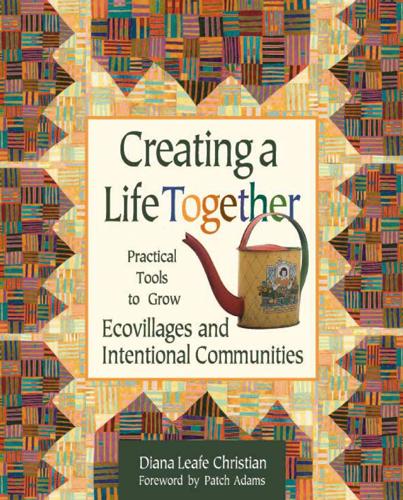
Creating a Life Together: Practical Tools to Grow Ecovillages and Intentional Communities
by
Diana Leafe Christian
Published 1 Jan 2003
As mentioned earlier, in the progressive areas where you’d think it would be easier to buy land for a community, it’s often worse. Many city planners in environmentally aware areas such as Boulder or Amherst are already advocates of sustainable development, and would love to see more clustered development with open space, shared housing, passive solar design, pedestrian pathways, and so on. Appalled by the urban sprawl and acres of parking lots, environmentally oriented citizens in such areas often elect officials who promise to enact and enforce stringent “no growth” or “slow growth” policies. While such policies effectively restrict commercial developers from churning out more housing subdivisions or strip malls, the same policies also stop community founders from creating the very kinds of sustainable developments local planners and officials would most like to see.
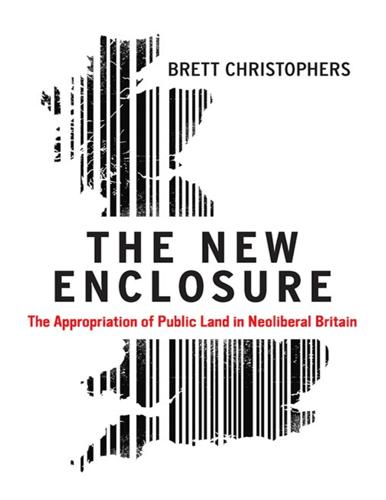
The New Enclosure: The Appropriation of Public Land in Neoliberal Britain
by
Brett Christophers
Published 6 Nov 2018
Indeed, plenty of commentators believe that the green belt is precisely where development should be taking place.2 Wiles is one of these. Not only, he observes, is Britain not being concreted over; the ‘green belt’, in fact, is not all green: Contrary to myth, the only function of the green belt is to stop urban sprawl (cities growing into one another). Green belt land has no inherent ecological or agricultural value, nor is it chosen because it has natural beauty or protected wildlife. Much of it is poor-quality scrubland or used for intensive farming, and defined as green belt purely to stop cities from growing.
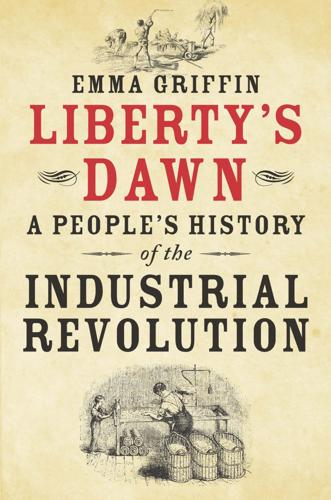
Liberty's Dawn: A People's History of the Industrial Revolution
by
Emma Griffin
Published 10 Jun 2013
With nearly 350, it is possible to identify genuine developments in the extent and nature of work available in the eighteenth and nineteenth centuries.15 An idea of the scope of the autobiographies can be captured by looking at Edward Barlow’s ‘journal’, a handwritten memoir of the early eighteenth century which recounts his successful career as first sailor, then captain. Barlow was born in 1642 in Prestwich, then a village about five miles from Manchester, now a settlement physically connected to the city through urban sprawl and subsumed administratively by the metropolitan county of Greater Manchester. Barlow was not the only autobiographer who ‘never had any great mind to country work’. Ploughing, sowing, haymaking, reaping, hedging, ditching, threshing and dunging amongst cattle were all, in his opinion, ‘drudgery’.16 But his prospects for quitting the plough in mid-seventeenth-century Lancashire were not bright.
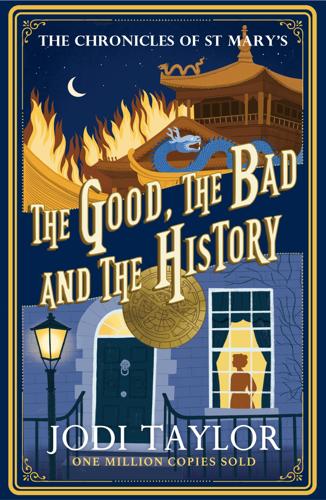
The Good, the Bad and the History
by
Jodi Taylor
Published 21 Jun 2023
I stood for some moments, quietly noting the spot. If things ever went badly for me or Markham, knowing the location of the Temple of Apollo could put me in a strong bargaining position. All of Patara lay before us and it was vast. ‘They could be anywhere,’ I said, rather defeated by all this urban sprawl. ‘We’ll find them. It’s what we do. Come on.’ Markham and I followed a goat track down into the city. No one seemed particularly bothered about who we were. Markham wore a respectable-looking chiton actually knocked together out of two bedsheets and carried a himation which, in a former life, had been an old blanket.
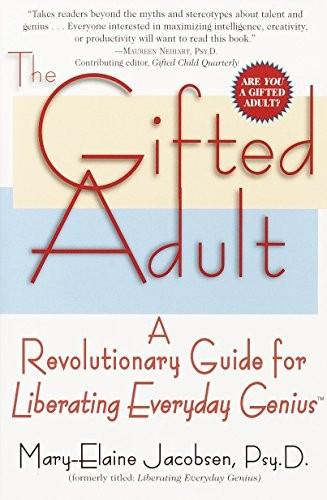
The Gifted Adult: A Revolutionary Guide for Liberating Everyday Genius(tm)
by
Mary-Elaine Jacobsen
Published 18 Feb 2015
When Jordan finally realized that neither the “meet until there’s consensus” nor the “do it all yourself” approach offered the right solution, he brought an “in-and-out” procedure to his team. Each member would retain ownership, credit, and accountability for his or her element of the research, while all were committed to the same goal and underlying principle: Save the venerable oaks of the Midwest’s Big Woods from extinction by oak wilt and urban sprawl. Even though at first the others were skeptical, thinking Jordan’s time- and ego-saving approach was too simple to be effective, they eventually found tremendous value in it. In large part this was because, just as in sports, Jordan had learned that timing was everything. Earlier in his career his sagacity had backfired because others distrusted and dismissed his ideas either when he revealed them too early in the process or if they required too great a leap of faith.
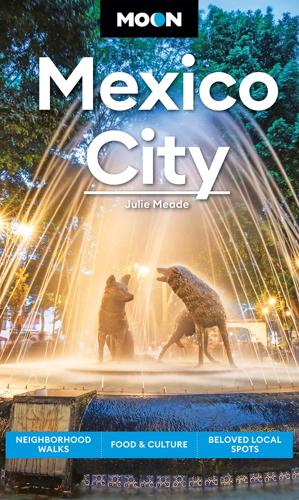
Moon Mexico City: Neighborhood Walks, Food & Culture, Beloved Local Spots
by
Julie Meade
Published 7 Aug 2023
Blanketing a broad alpine valley, it was once Tenochtitlan, an island city that was the most populous in the Americas—and by some estimates, the world—during the 15th century. Razed following the Spanish conquest, Tenochtitlan’s ruins lie beneath the modern metropolis, which covers 1,480 square kilometers and has a population of over 21 million. Amid the urban sprawl, there are lovely residential enclaves, architectural landmarks, and a multitude of cultural treasures, from dazzling pre-Columbian artifacts to artist Frida Kahlo’s childhood home. For those who love to eat, there is no better place to explore Mexico’s varied palate. The city’s famous food scene runs the gamut from relaxed street-side taco stands to elegant fine dining.
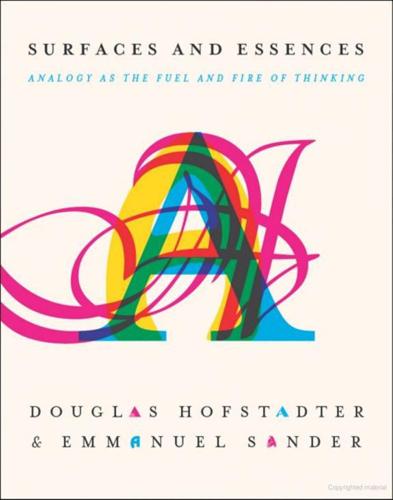
Surfaces and Essences
by
Douglas Hofstadter
and
Emmanuel Sander
Published 10 Sep 2012
Then it linked combinations of abstract qualities (“hot and cold water”), as well as of relationships (“before and after my haircut”) and other abstract attributes (“a hot and healthy meal”). And then many more came, in an avalanche. Like any category, the category of and situations expands gradually and smoothly in each human mind — indeed, so smoothly that after the fact the resulting urban sprawl seems, albeit illusorily, monolithic and uniform, as if it had been constructed all at once, as if there were but one single elementary idea there, which had never needed any generalizing at all. There are no conscious traces left of the many concentric layers of outward expansion of and, just as there are no conscious traces left of how we acquired categories that give the impression of being considerably more complex, such as mother, stop, and much.
…
And in exactly the same year, 1932, the Dictionnaire de l’Académie française defined the word “bureau” (French for “desk”) as follows (the original was in French, of course): A piece of furniture having drawers in which one can store papers and having horizontal surfaces on which one can write or draw. By extension, a table on which one does written or other work. These definitions are based on the idea of a desk as a piece of furniture. That was the “downtown area” of the vintage-1932 concept of desk. To be sure, even back then, there was already a good deal of conceptual urban sprawl in various directions. But back in 1932, no one could have dreamt of the kind of desk that we information addicts now spend most of our workdays working “upon”. Let’s give the name “hard-desk” to the concept of the 1932-style piece of furniture. It has a physical existence, and it is heavy and rather awkward to move around.

Lonely Planet Turkey (Travel Guide)
by
Lonely Planet
,
James Bainbridge
,
Brett Atkinson
,
Steve Fallon
,
Jessica Lee
,
Virginia Maxwell
,
Hugh McNaughtan
and
John Noble
Published 31 Jan 2017
The road tapers off at a high-security military compound covering the peninsula's end, from which soldiers can train their binoculars on the tourists frolicking on Samos. The first cove, İçmeler Köyü (1km from the entrance), has a sandy beach, but it is the busiest and somewhat dirty with views of Kuşadası's urban sprawl. About 4km further on, Aydınlık Köyü is a quieter, 800m-long pebble strand backed by pines, and is busy enough to warrant a lifeguard station, though it is not always staffed. About 1km further along, after the jandarma (provincial police) station turn-off, the signposted kanyon (canyon) appears on the left.
…
Mega-construction projects, including İstanbul's recently completed Yavuz Sultan Selim Bridge and the ongoing construction of the city's third airport, are contributing to mass deforestation in the Bosphorus region. On the Aegean and Mediterranean coasts, spots such as Kuşadası and Marmaris (once pleasant fishing villages) have been overwhelmed by urban sprawl and are in danger of losing all appeal. Dams Short of water and electricity, Turkey is one of the world's major builders of dams. There are already more than 600 dams and many more on the way, with controversy surrounding new and proposed developments. The gigantic Southeastern Anatolia Project, known as GAP, is one of Turkey's major construction efforts.

Lonely Planet Turkey
by
Lonely Planet
The road tapers off at a high-security military compound covering the peninsula’s end, from which soldiers can train their binoculars on the tourists frolicking on Samos. The first cove, İçmeler Köyü (1km from the entrance), has a sandy beach, but it is the busiest and not the cleanest, look to the north and there are sweeping views of Kuşadası’s urban sprawl. About 4km further on, Aydınlık Köyü is a quieter, 800m-long pebble strand backed by pines, and is busy enough to warrant a lifeguard station, though it is not always staffed. About 1km further along, the signposted kanyon (canyon) appears on the left. Boards here give information and maps of the park.
…
Mega-construction projects, including İstanbul’s Yavuz Sultan Selim Bridge and the ongoing construction of the city’s third airport, the first stage of which opened in 2019, are contributing to mass deforestation in the Bosphorus region. On the Aegean and Mediterranean coasts, spots such as Kuşadası and Marmaris (once pleasant fishing villages) have been overwhelmed by urban sprawl and are in danger of losing all appeal. EARTHQUAKE DANGER Turkey lies on at least three active earthquake fault lines: the North Anatolian, the East Anatolian and the Aegean. Most of Turkey lies south of the North Anatolian fault line, which runs roughly parallel with the Black Sea coast.

Broken Angels
by
Richard Morgan
Published 31 Aug 2008
It stuck up at the edge of the district like a burnished bronze conning tower, double the height of the surrounding blocks and utterly featureless from the outside. Like much of the architecture in Landfall, it was mirror-surfaced and the reflected sun made its edges difficult to look at directly. It wasn’t the tallest tower in Landfall, but the structure had a raw power to it that throbbed across the surrounding urban sprawl and spoke volumes about its designers. Testing the human frame to destruction The phrase flopped out of my memory like a corpse from a closet. “How close you want to get?” asked Schneider nervously. “A bit closer.” The Khumalo sleeve, like all Carrera’s Wedge custom, had a satdata locational display wired in as standard and reckoned to be quite user-friendly when not fucked up by the webs of jamming and counter-jamming that currently swathed most of Sanction IV.
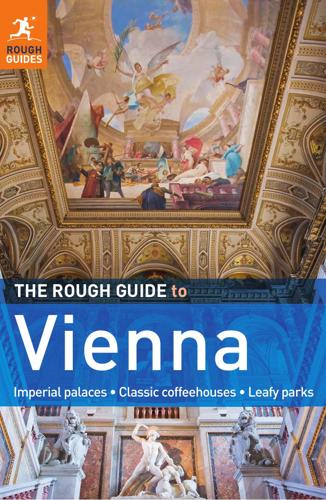
The Rough Guide to Vienna
by
Humphreys, Rob
Schiele succumbed three days later at his mother-in-law’s house and is buried in the nearby Friedhof Ober-St-Veit, beneath a tombstone sculpted by the Hungarian Benjamin Ferenczy, commissioned by Schiele’s friends on the tenth anniversary of his death. 177 SCHÖNBRUNN, THE W I E NE RWAL D AND THE Z E N T R A L F R I E D H O F later; free), enclosed within a 25km-long wall by Emperor Josef II. It’s now the wildest of Vienna’s public parks, with virtually no traffic, and no formal gardens at all – head here if you want to leave the urban sprawl far behind. It may not boast the views of the Wienerwald, but you’re more likely to spot wildlife, including wild boar, mouflon, woodpecker, and, most easily, red squirrels and deer; in addition, the famous Lipizzaner horses of the Spanische Reitschule spend their summer holidays in the park. The main entrance is the Lainzer Tor, at the end of Hermesstrasse (tram #60 or #62 and then bus #60B), where a visitor centre can help you get your bearings.
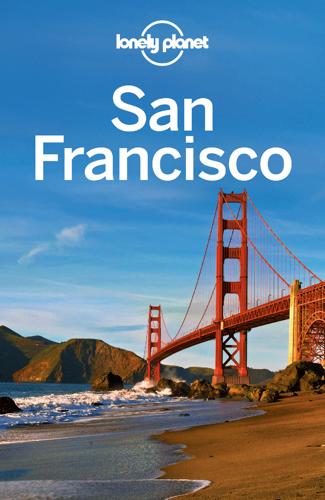
San Francisco
by
Lonely Planet
A bronze plaque with this ditty still graces the resilient Italianate building. Embarcadero Center Notable Building Offline map Google map (www.embarcaderocenter.com; Sacramento St; 10am-5pm; & Embarcadero; California St) The skyscrapers of the Embarcadero Center, joined by overhead walkways, form an urban-sprawl mall and have little to recommend them beyond some good public art and the crowd-pleasing Embarcadero Center Cinema (Click here ). They connect to the north with Golden Gateway Center – a 1950s-designed modernist housing development on the site of the city’s former wholesale vegetable market – anchored by One Maritime Plaza (née the Alcoa Building, 300 Clay St), the city’s first skyscraper to use crisscrossing-steel seismic reinforcements.

Barcelona
by
Damien Simonis
Published 9 Dec 2010
Return to beginning of chapter THE LAND Barcelona spreads along the Catalan coast in what is known as the Pla de Barcelona (Barcelona Plain), midway between the French border and the regional frontier with Valencia. The plain averages about 4m above sea level. Mont Tàber, the little elevation upon which the Romans built their town, is 16.9m above sea level. To the southwest, Montjuïc is 173m high. Urban sprawl tends to be channelled southwest and northeast along the coast, as the landwards side is effectively blocked off by the Serralada Litoral mountain chain, which between the Riu Besòs and Riu Llobregat is known as the Serra de Collserola. Tibidabo is the highest point of this chain at 512m, with commanding views across the whole city.

The Rational Optimist: How Prosperity Evolves
by
Matt Ridley
Published 17 May 2010
As far as the planet is concerned, this is good news because city dwellers take up less space, use less energy and have less impact on natural ecosystems than country dwellers. The world’s cities already contain half the world’s people, but they occupy less than 3 per cent of the world’s land area. ‘Urban sprawl’ may disgust some American environmentalists, but on a global scale, the very opposite is happening: as villages empty, people are living in denser and denser anthills. As Edward Glaeser put it, ‘Thoreau was wrong. Living in the country is not the right way to care for the Earth. The best thing that we can do for the planet is build more skyscrapers.’

Connectography: Mapping the Future of Global Civilization
by
Parag Khanna
Published 18 Apr 2016
* * * *1 On average across developing countries, participating in the intermediate stages of product creation represents 30 percent of GDP and far more if SEZs are used not just for specialization but also to diversify into more complex industries. *2 Hukou refers to the system of permits that regulates Chinese citizens’ residency rights in the countryside. *3 China’s urban sprawl has hastened due to cheap Japanese and Korean scooters, followed by even cheaper Chinese-made ones, which muscled over bicyclists while expanding the effective range of commuting. While China is now trying to encourage bicycling again, other cities have learned the lesson and are banning scooters, taxing automobiles, building more public transport, and designating more pedestrian zones
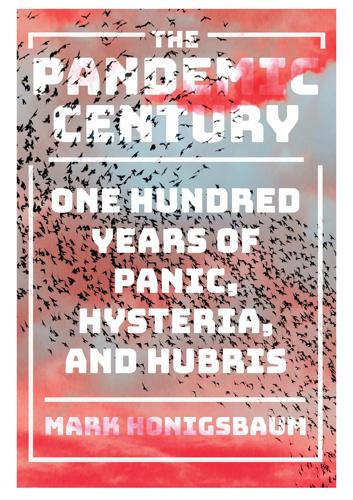
The Pandemic Century: One Hundred Years of Panic, Hysteria, and Hubris
by
Mark Honigsbaum
Published 8 Apr 2019
Similar behavioral shifts also occurred spontaneously in Sierra Leone around the same time, particularly in Kailahun and Kenema, the two districts that had been hit earliest and hardest by Ebola. Elsewhere, however, resistance to the Ebola control measures persisted. Noncompliance was a particular problem in the Western District, the area that includes Freetown and its extra urban sprawl, and Port Loko, a 2,000-square-mile district to the north of the capital scored with swamps and rivers. For instance, in March 2015, shortly before Liberia released its last Ebola patient from the hospital, a fisherman infected with Ebola evaded government contact tracers and persuaded three colleagues to ferry him to a remote island in the Rohmbe swamps within sight of Lungi airport.
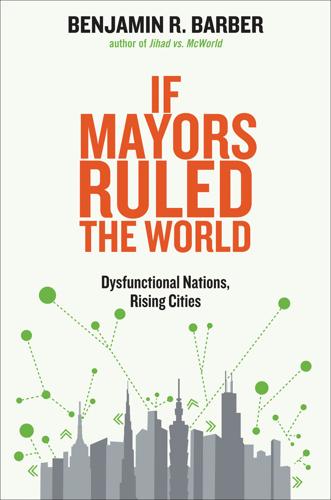
If Mayors Ruled the World: Dysfunctional Nations, Rising Cities
by
Benjamin R. Barber
Published 5 Nov 2013
Olmsted was hardly alone. In 1947, contemplating the expansion of their transit system, planners in Copenhagen devised a “Finger Plan” that allowed the city to grow outward along transit fingers that would be separated by parks, woods, and other green spaces. By planning ahead, Copenhagen avoided the anarchy of urban sprawl and environmentally pernicious brown lands, and it ensured some measure of urban-country reconciliation in a quickly growing capital district. New towns with the luxury of starting fresh on a virgin map labor to integrate Olmsted’s and Copenhagen’s ideals into their planning. Daniel Kammen, the Nobel laureate energy scientist, recently sketched a vision of his own version of an Ecopolis responding to these ideals on his television series Ecopolis (2009).

Capitalism in America: A History
by
Adrian Wooldridge
and
Alan Greenspan
Published 15 Oct 2018
In his early days he struck a deal with a Chicago bookmaker to buy rights to a piece of land known as “the wildcatter’s graveyard” and quickly drilled thirteen gushers. He also made a second career as an urban developer. In 1974, he built a planned community, the Woodlands, in the pine forests north of Houston, in a bid to tackle the problems of urban sprawl. It contains a mix of social housing and offices as well as million-dollar villas. His stubbornness was his most important quality. With the major oil companies scoffing and his investors ruing their foolishness, he spent two decades poking holes in the land around Fort Worth. “I never considered giving up,” he said, “even when everyone was saying, ‘George, you’re wasting your money.’”

Model Thinker: What You Need to Know to Make Data Work for You
by
Scott E. Page
Published 27 Nov 2018
“Evolution of Cooperation Among Tumor Cells.” Proceedings of the National Academy of Sciences 103, no. 36: 13474–13479. Axtell, Robert L. 2001. “Zipf Distribution of U.S. Firm Sizes.” Science 293: 1818–1820. Bajari, Patrick, and Matthew E. Kahn. 2008. “Estimating Hedonic Models of Consumer Demand with an Application to Urban Sprawl.” In Hedonic Methods in Housing Markets, 129–155. New York: Springer. Bak, Per. 1996. How Nature Works: The Science of Self-Organized Criticality. New York: Springer. Baldwin, Carliss Y., and Kim B. Clark. 2000. Design Rules. Vol. 1, The Power of Modularity. Cambridge, MA: MIT Press. Ball, Eric, and Joseph LiPuma. 2012.

Good Economics for Hard Times: Better Answers to Our Biggest Problems
by
Abhijit V. Banerjee
and
Esther Duflo
Published 12 Nov 2019
Making matters worse, as Ed Glaeser has argued in his wonderful book Triumph of the City, are city planners who resist building dense neighborhoods of high-rises for the middle class, aiming instead for a “garden city.”56 India, for example, imposes draconian limits on how high buildings can be, much stricter than what is found in Paris, New York, or Singapore. These restrictions result in massive urban sprawl and long commutes in most Indian cities. The same problem also shows up in China and many other countries, albeit in a less extreme form.57 For the would-be low-income migrant, this set of bad policy choices creates an unenviable trade-off. He can crowd into a slum (if he is lucky), commute many hours a day, or resign himself to the daily misery of sleeping under a bridge, on the floor of the building where he works, in his rickshaw or under his truck, or on the pavement, protected perhaps by the awning of a shop.

Next Stop Execution: The Autobiography of Oleg Gordievsky
by
Oleg Gordievsky
Published 13 Apr 2015
After the modest proportions and cleanliness of Copenhagen, London seemed a colossal mess. A car from the Soviet Embassy met us, and our drive into the West End of the city was itself a revelation. I had frequently read that London was one of the richest cities in the world — but here was a vast, undistinguished urban sprawl, with street after street of grimy old houses, litter in the gutters, and appalling traffic. To some extent the squalor was redeemed by the little gardens in front of the houses, and by the immaculately kept public parks but, on the whole, I had imagined that everything would be much tidier and more attractive.
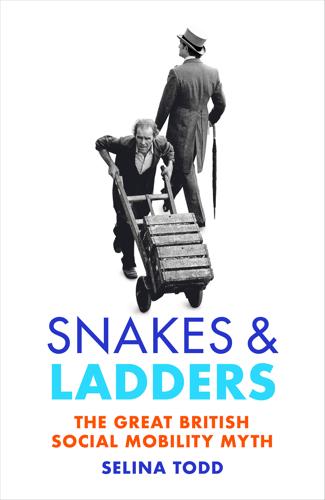
Snakes and Ladders: The Great British Social Mobility Myth
by
Selina Todd
Published 11 Feb 2021
This expansion of opportunity owed much to the changes wrought by rapid industrialisation, especially in the growing towns and cities. Factory and mill owners, businessmen, merchants and the proprietors of new railway companies wanted banks and insurance companies to protect their wealth, lawyers to defend it and shops to spend it in. The urban sprawl needed efficient sewage systems, proper lighting, and new roads for trolleybuses and trams. Reformers demanded more hospitals, schools and libraries. Some of these amenities were provided by local and national government, others by churches, and still more by philanthropists. Even those who opposed ‘handouts’ to the poor wanted more policing and workhouses to prevent the beggars, street urchins and flower sellers from becoming an unruly or rebellious mob.

Grand Transitions: How the Modern World Was Made
by
Vaclav Smil
Published 2 Mar 2021
The most important reason for much higher per capita energy use is the increased demand for electricity, from a single low-power light per room and perhaps a small TV in a village to residential high-rises where not only multiple lights but a refrigerator, cooking elements, a larger TV, and window air conditioning unit(s) are found in most apartments—and where a single standard toilet flush may consume more water than the daily household use for drinking and cooking in a traditional village (Smil 2014). As a result, India’s per capita urban electricity use is nearly double the rural rate (Woodbridge et al. 2016), as is average tap water use in Chinese cities (Yu et al. 2015). Megacities also create extreme urban sprawl and strong heat islands. By fragmenting habitats and destroying natural plant cover (particularly in coastal areas, above all in mangrove regions of the subtropics and tropics), sprawling cities reduce biodiversity, destroy farmland, and affect regional water runoff, thanks to the dominance of impermeable surfaces and the channeling of streams into concrete troughs.
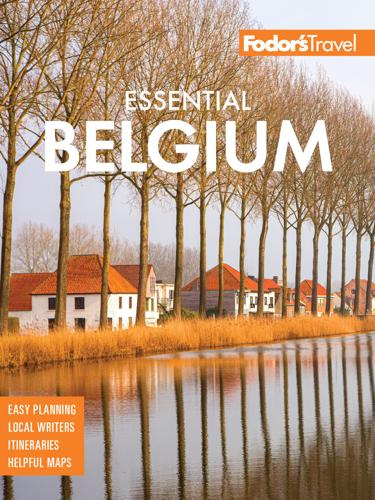
Fodor's Essential Belgium
by
Fodor's Travel Guides
Published 23 Aug 2022
Maison Autrique (Autrique House) HISTORIC HOME | The first house designed in Brussels by the architect Victor Horta (he’d done others in Ghent by this time) was built in 1893 for a friend, Eugene Autrique. It was to have “not a single luxury,” and became the first manor house built by Horta, marking his early explorations in Art Nouveau. At the time, Schaerbeek was mostly agrarian, best known for the small, sour cherries used to brew kriek beers—a state almost unimaginable given its current urban sprawl. Having undergone extensive renovation to return it to its original state, the house is now a museum on Horta’s early days, and holds the odd exhibition. EChau. de Haecht 266, Schaerbeek P02/215–6600 wwww.autrique.be A€7 CClosed Mon. and Tues. rReservations required mTram: 3. Mini-Europe AMUSEMENT PARK/CARNIVAL | FAMILY | Just a short stroll from the Atomium lies this kids’ favorite, which is essentially a park full of scale models of important European monuments.
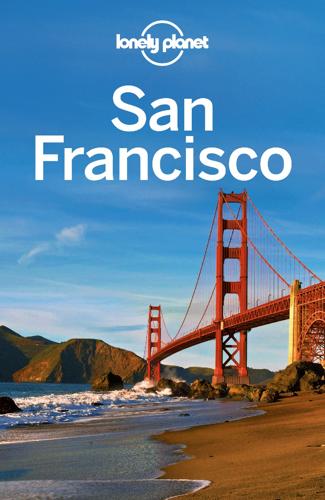
San Francisco
by
Lonely Planet
A bronze plaque with this ditty still graces the resilient Italianate building. Embarcadero Center Notable Building Offline map Google map (www.embarcaderocenter.com; Sacramento St; 10am-5pm; & Embarcadero; California St) The skyscrapers of the Embarcadero Center, joined by overhead walkways, form an urban-sprawl mall and have little to recommend them beyond some good public art and the crowd-pleasing Embarcadero Center Cinema (Click here ). They connect to the north with Golden Gateway Center – a 1950s-designed modernist housing development on the site of the city’s former wholesale vegetable market – anchored by One Maritime Plaza (née the Alcoa Building, 300 Clay St), the city’s first skyscraper to use crisscrossing-steel seismic reinforcements.
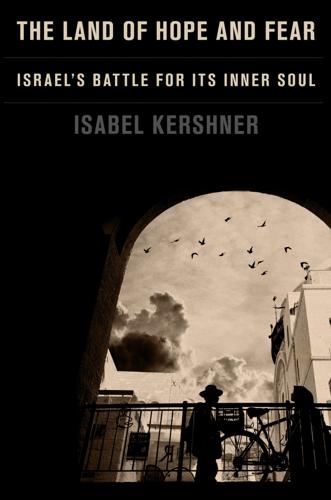
The Land of Hope and Fear: Israel's Battle for Its Inner Soul
by
Isabel Kershner
Published 16 May 2023
Straight ahead was Mount Zion, the traditional site of King David’s tomb; the walled Old City, with its iconic golden cupola of the Dome of the Rock marking out the Temple Mount; and the Palestinian neighborhoods, their gray houses and apartment blocks seemingly piled on top of one another and threatening to tumble down the hillsides. To the east rose the ridges of Mount Scopus and the Mount of Olives, with their three hallmark towers and ancient Jewish graveyard, the gilded onion-domed Church of Mary Magdalene, and the Garden of Gethsemane; and to the north and west the urban sprawl of the new city. The grassy slopes below the promenade took on the atmosphere of a fete. Stalls were set up, selling ethnic arts and crafts. In a tent, youth counselors conducted discussion circles. Menberu Shimon, an Ethiopian Israeli resident of Jerusalem, was selling copies of his illustrated children’s book explaining the meaning of Sigd, a name taken from the Hebrew word for prostration.
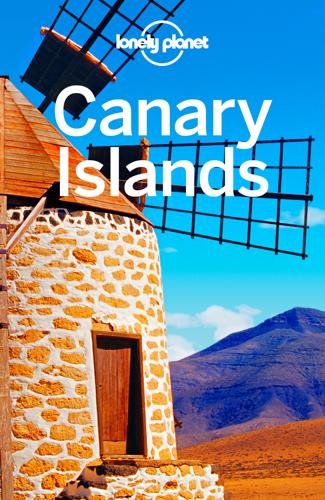
Canary Islands Travel Guide
by
Lonely Planet
On a grander scale, it was primarily thanks to Manrique’s persistent lobbying for maintaining traditional architecture and protecting the natural environment that prompted the cabildo (island government) to pass laws restricting urban development. The growing wave of tourism, beginning in the early 1980s, has threatened to sweep away all before it. But Manrique’s ceaseless opposition to such unchecked urban sprawl touched a nerve with many locals and led to the creation of an environmental group known as El Guincho, which has had some success in revealing – and at times even reversing – abuses by developers. Manrique was posthumously made its honorary president. As you pass through villages across the island, you’ll see how traditional stylistic features remain the norm.

Lonely Planet Mongolia (Travel Guide)
by
Lonely Planet
,
Trent Holden
,
Adam Karlin
,
Michael Kohn
,
Adam Skolnick
and
Thomas O'Malley
Published 1 Jul 2018
The huge Oyu Tolgoi mine in Ömnögov requires the use of 360L of water per second, prompting some locals to call for a ban on underground water usage. China’s appetite for minerals is opening up new mines but another threat lies in China’s hunt for the furs, meat and body parts of endangered animals. Chinese demand has resulted in an 80% decline in the number of marmots and an 85% drop in the number of saiga antelope. Urban sprawl, coupled with a demand for wood to build homes and for heating and cooking, is slowly reducing the forests. This destruction of the forests has also lowered river levels, especially that of the Tuul Gol near Ulaanbaatar. Large-scale infrastructure projects are further cause for concern. The 18m-tall Dörgön hydropower station, built on the Chon Khairkh Gol in Khovd, has submerged canyons and pastures.

The Rough Guide To Devon & Cornwall
by
Rough Guides
Published 29 Apr 2024
< Back to Dartmoor Shutterstock PLYMOUTH HOE Plymouth and around Plymouth Mount Edgcumbe Saltram House Buckland Abbey Cotehele Plymouth and around As the largest city in Devon and Cornwall, Plymouth has a very different feel to anywhere else in the region. There could be no greater contrast to the snug villages nearby in the South Hams, or the miles of wilderness in Dartmoor, than the city’s urban sprawl or the immensity of Plymouth Sound, with its docks and naval base. Plymouth is an essential component of Devon’s seafaring identity, and the city’s maritime traditions are most obvious when you’re gazing down onto the Sound from historic Plymouth Hoe. While much of modern Plymouth is offputtingly ugly, the Barbican and Sutton Harbour are as compact and unspoilt as any of the West Country’s medieval quarters, and the city’s National Marine Aquarium holds one of the country’s finest sea-life collections.

Empire of Things: How We Became a World of Consumers, From the Fifteenth Century to the Twenty-First
by
Frank Trentmann
Published 1 Dec 2015
In London, with its fragmented administration, public takeover of water was also delayed until 1902.28 This movement is known as ‘municipal socialism’, though the driving force behind it had little to do with socialist parties, which were still in their infancy. The main pressure came from urban growth and the limits of nature. Unlike food and clothing, water became more, not less, expensive in the late nineteenth century. Urban sprawl meant longer pipes to suburbs and more distant, expensive sources. Private companies had maximum prices set by legislators early on, and so had little incentive to invest. Cities were forced to take over. Many businessmen were happy to swallow the pill of public ownership as long as it ensured enough water for their factories.
…
With a socialist background, he had served as chargé de mission under Pierre Mendès France in 1954–5, before becoming inspector-general of finances, a top-ranking civil servant. At the time of writing, he was director general of the bank Crédit Lyonnais. As a founding member of the Club of Rome, he recognized the dangers of pollution, poverty and urban sprawl. Growth needed to be slowed down and managed. Still, he argued, it was foolish to think any progress could be made by forsaking consumption. The world of goods had brought collective as well as individual freedoms. People found genuine satisfaction in the use of things, something an older ‘sacralization of labour’ had denied them.
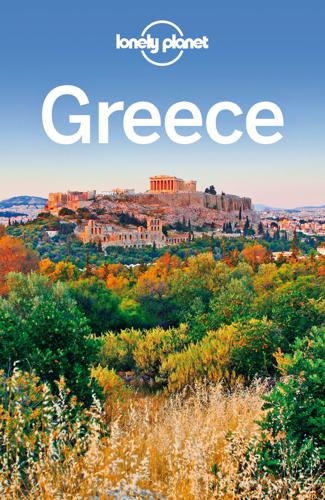
Greece Travel Guide
by
Lonely Planet
Piraeus, 10km southwest of central Athens, is the biggest port in the Mediterranean (with more than 20 million passengers passing through annually), the hub of the Aegean ferry network, the centre of Greece’s maritime trade and the base for its large merchant navy. While technically a separate city, these days Piraeus virtually melds into the urban sprawl of Athens. Central Piraeus is not a place where visitors choose to linger because it’s congested with traffic. Beyond its shipping offices, banks and public buildings are a jumble of pedestrian precincts, shopping strips and rather grungy areas. The most attractive quarter lies to the east around Zea Marina and touristy Mikrolimano harbour, which is lined with cafes, restaurants and bars.
…
Illegal development of mainly coastal areas, and building in forested or protected areas, has gained momentum in Greece since the 1970s. Despite attempts at introducing laws, and protests by locals and environmental groups, corruption and the lack of an infrastructure to enforce the laws means little is done to abate the land-grab. The issue is complicated by population growth and increased urban sprawl. Developments often put a severe strain on water supplies and endangered wildlife. While a few developments have been torn down, in more cases illegal buildings are legalised as they offer much needed, affordable housing. In 2014 NATO's plan to decommission 700 tonnes of Syria’s chemical weapons off the southern coast of Crete was protested by over 10,000 islanders concerned for the environment and their livelihood.

Lonely Planet Brazil
by
Lonely Planet
Complementing Minas’ historical treasures are the state’s magnificent scenery and wildlife, with a host of state and national parks providing critical habitat for endangered species such as the maned wolf and northern muriqui. Belo Horizonte %0xx31 / Pop 2.5 million / Elev 858m Known to locals as Beagá (pronounced ‘bay-ah-gah’, Portuguese for BH), Belo Horizonte was named for its beautiful view of nearby mountains. Urban sprawl may make it a little more challenging to appreciate the natural setting nowadays, but Brazil’s third-largestcity still has considerable charm. Walk down the buzzing cosmopolitan streets of the Savassi neighborhood on a Saturday evening, eat at one of the fine restaurants in Lourdes, stroll through the densely packed stalls at Mercado Central, attend the exuberant weekend street fair alongside leafy Parque Central, take in a concert at the Palácio das Artes, or visit the Inhotim art museum west of the city, and you’ll see that Belo Horizonte has countless dimensions.
…
English is spoken. WORTH A TRIP ILHA DE ITAMARACá Less than 40km north of Olinda, Ilha de Itamaracá (separated from the mainland by a wide channel) is a peaceful island retreat with some interesting historical buildings and a pleasant weekend beach scene that feels a world apart from the urban sprawl that surrounds Recife just a short drive away. Immense Forte Orange (1631) on the southern tip of the island is Itamaracá’s star attraction. There are several bars and restaurants here, and locals offer boat trips across to Ihla Coroa do Avião, a tiny island surrounded by inviting waters. Three kilometers west of Forte Orange is Vila Velha, a small port founded in 1540, one of the earliest Portuguese settlements in Brazil.
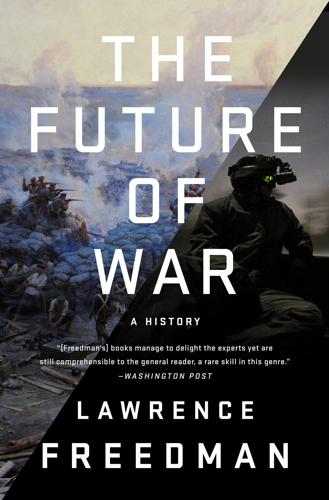
The Future of War
by
Lawrence Freedman
Published 9 Oct 2017
Moreover, the abstract analyses about future combat surrounding the RMA had not really addressed the problem of fighting in urban areas. Until modern times, cities, with their walls and elaborate defences, had always posed a severe strategic challenge to the point where armies had to break off from their advance through a country to lay siege. As a result of urban sprawl and with armies shrinking, cities had become too large to be encircled and sealed off. The alternative prospect of fighting through streets and alleys was deeply unattractive. Buildings allowed enemy fighters opportunities for concealment, ambushes, and snipers. Attempts to dislodge them by artillery, bombs, and mortars might simply create rubble that would complicate movement and provide new opportunities for defenders.

MacroWikinomics: Rebooting Business and the World
by
Don Tapscott
and
Anthony D. Williams
Published 28 Sep 2010
In the developed world, roads consume about 40 percent of land in urban areas and even more in North America.4 In 2008, the world’s expansive road network covered some 70 million kilometers—enough roadway to build 180 expressways to the moon.5 Urban planners have long known that high rates of car ownership encourage urban sprawl—sprawl that further entrenches our car dependency while increasing roadway congestion. Fewer people recognize that roads also disrupt ecosystems, interfere with species migration, and compromise natural drainage. Given that cars are one of the most popular forms of transportation in the developed world, cars inevitably become a nexus for death.
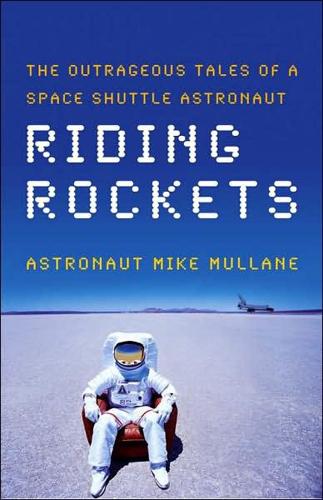
Riding Rockets: The Outrageous Tales of a Space Shuttle Astronaut
by
Mike Mullane
Published 24 Jan 2006
Except for size, every building was identical, each featuring a façade of exposed aggregate concrete. The major buildings were positioned around a duck pond landscaped with pine and oak trees to relieve the otherwise flat, boring terrain of southeast coastal Texas. Johnson Space Center was located in the far south of Houston’s urban sprawl. It was nearly as close to Galveston as it was to Houston’s city center. The community in which many NASA employees lived was the suburb of Clear Lake City—implying a lake nearby, and a clear one at that. Wrong. Clear Lake was neither clear nor a lake, but rather a chocolate-tinted, humidity-shrouded inlet from the nearby Gulf of Mexico that served as a time-share for a couple billion vacationing mosquitoes.

To Save Everything, Click Here: The Folly of Technological Solutionism
by
Evgeny Morozov
Published 15 Nov 2013
Granted, you won’t have a chance to express your impeccable morality at every left turn, but you have still expressed it when, unsure of your own driving abilities, you surrendered control to the car itself. Of course, there may be other reasons to oppose automated and driverless cars; for instance, they might completely devastate whatever is left of public space in America, as urban sprawl might continue even more aggressively. But this is a very different type of critique from Kerr’s concerns about automating virtue. There are perhaps good arguments to be made as to why mastering how to drive an unautomated car might be as intellectually and aesthetically stimulating as repairing a motorcycle.
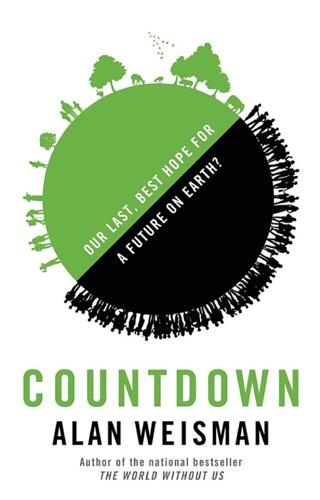
Countdown: Our Last, Best Hope for a Future on Earth?
by
Alan Weisman
Published 23 Sep 2013
In his early forties, Foley has a lean, boyish face that smiles far more than you’d expect from someone who knows as much as he does about what we’re up against. He showed me a map of the world, color-coded in green and brown. “All the world’s cropland lumped together,” he said, indicating the green splotches, “adds up to about the size of South America. All our pastureland”—the brown—“equals the continent of Africa.” My shock over urban sprawl was misplaced, he said. Humans use sixty times the amount of land that’s paved to feed ourselves. Everything else is either desert or mountains too dry or craggy to cultivate, or forests that we need to soak up carbon. “We’re already using all the cropland we’ll ever have. In the coming years, we have to feed two billion more people, using the same land.
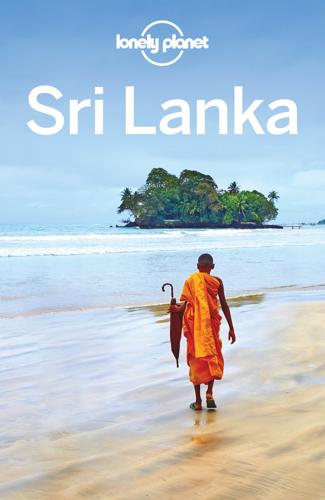
Lonely Planet Sri Lanka
by
Lonely Planet
Best Places to Eat A Sanctuary at Tissawewa A Hotel Shalini A Traditional Foods Sales Centre Best Places to Sleep A Rice Villa Retreat A Sigiri Lion Lodge A Jim's Farm Villas A Ulagalla A Sanctuary at Tissawewa Ancient Cities Highlights 1 Abhayagiri Dagoba Feeling utterly humbled by the epic scale of the former capital of Anuradhapura. 2 Sigiriya Scaling the great rock for epic views, outstanding murals and intriguing ruins. 3 Polonnaruwa Admiring the exquisite carved temples and Buddhas at the fascinating ruins of this former Sinhalese stronghold. 4 Minneriya Spotting elephants, crocodiles and birdlife on the lake shores and in the jungles of this national park. 5 Dambulla Cave Temples Peering at some of Sri Lanka’s most stunning Buddhist murals and images. 6 Ridi Vihara Getting off the beaten track at this little-visited site, with its beautiful Buddhist murals and friendly monastic community. 7 Mihintale Climbing monumental stairways to the stupas and viewpoints where Buddhism first took root in Sri Lanka. Matale %066 / Pop 46,000 This midsize regional city at the heart of the island lies in a broad, fertile valley at an elevation of 300m. Matale is a featureless urban sprawl with a congested one-way system, so you're unlikely to want to linger long. However, the road north of town is lined with dozens of visitor-friendly spice plantations where vanilla, rubber, cinchona, jackfruit, cocoa and cardamom thrive. The area is also famous for kohila (a type of watercress) and small, mild chillies.

The Rough Guide to Devon & Cornwall
by
Robert Andrews
< Back to Dartmoor Plymouth and around Plymouth Mount Edgcumbe Saltram House Buckland Abbey Cotehele As the largest city in Devon and Cornwall, Plymouth has a very different feel to anywhere else in the region. There could be no greater contrast to the snug villages nearby in the South Hams, or the miles of wilderness in Dartmoor, than the city’s urban sprawl or the immensity of Plymouth Sound, with its docks and naval base. Plymouth is an essential component of Devon’s seafaring identity, and the city’s maritime traditions are most obvious when you’re gazing down onto the Sound from historic Plymouth Hoe. While much of modern Plymouth is off-puttingly ugly, the Barbican and Sutton Harbour are as compact and unspoilt as any of the West Country’s medieval quarters, and the city’s National Marine Aquarium holds one of the country’s finest sea-life collections.
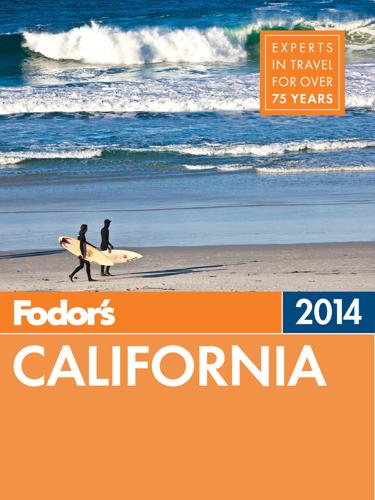
Fodor's California 2014
by
Fodor's
Published 5 Nov 2013
Go for the glitz of the entertainment industry, but stay for the rich cultural attributes and myriad communities of people from different cultures. The Central Coast. Three of the state’s top stops—swanky Santa Barbara, Hearst Castle, and Big Sur—sit along the scenic 200-mile route. Channel Islands National Park. Only 60 miles northwest of Los Angeles, this park, accessible only by boat, seems worlds away from urban sprawl and tangled freeways. The Inland Empire. The San Bernardino Mountains provide seasonal escapes at Lake Arrowhead and Big Bear Lake, and the Temecula Valley will challenge your ideas of “California Wine Country.” Palm Springs and the Desert Resorts. Golf on some of the West’s most challenging courses, lounge at fabulous resorts and luxurious spas, check out midcentury-modern architectural gems, and experience the simple life at primitive desert parks.
…
Getting Here and Around Car Travel An isolated island of pristine wilderness—a rarity these days—Joshua Tree National Park is within a short drive of 11 million Southern California residents. Most visitors, in fact, make the two-hour drive from the Los Angeles area to enjoy a weekend of solitude in 792,726 acres of untouched desert. The urban sprawl of Palm Springs (home to the nearest airport) is 45 miles away, but gateway towns Joshua Tree, Yucca Valley, and Twentynine Palms are just north of the park. If you’re staying in the Palm Springs area, you can enjoy the highlights of the park in one day, including a stop for a picnic at a scenic spot.

Aerotropolis
by
John D. Kasarda
and
Greg Lindsay
Published 2 Jan 2009
Kennedy International Airport, (JFK), 32–33 Johnson, Boris, 16 Johnson, Stan, 273–74 John Wayne Airport, 35–37, 137 Jullens, John, 204, 205 J. van de Put Fresh Cargo, 215, 216 Kaczynski, Lech, 18 Kansas City, Kans., 11 Karev, Ori, 272 Kasarda, John, 6–10; “aerotropolis” coined by, 5, 383, 419; and Bangkok’s aerotropolis plans, 247–48, 250, 255, 262; Beijing Capital Airport City plans of, 387; career of, 159–60, 169; childhood of, 7, 162–63; Chongqing strategy of, 397; cities by and for companies envisioned by, 181; and Detroit’s future as aerotropolis, 24, 187–89, 192; and Dubai plans, 313–15; early forms of aerotropolis idea by, 169–73; education of, 7, 159, 163–64; efficiency in the name of growth touted by, 413; on environmental impact of aviation, 338–43; Fast Company profile of, 24; on fate and agency, 7, 18, 164; FedEx use of plans by, 8, 79, 171, 373, 384; as frequent flyer, 6–7, 8–9, 261, 414; future of air travel as seen by, 412–13; governance of aerotropoli proposed by, 177; Hong Kong International admired by, 382; on impact of Open Skies, 403; in India for consultation, 282, 284; influences and mentors of, 5, 164–67, 339–40, 424–25; Law of Connectivity by, 113–19, 272, 333, 339, 423; Memphis seen as aerotropolis by, 79; new urbanism in ideas of, 136; and Orange County airport debate, 36; speeches and conference appearances by, 8, 173, 339; Subic Bay as validation for, 171; 21st century cities as imagined by, 12–13, 19–20, 24, 358 Kassa, Berhanu, 322, 323, 324 Katrina, Hurricane, 185 Kautai, Alex, 91 Kelbaugh, Douglas, 197, 198 Kelly, Matthew, 103 Kenan-Flagler Business School, 8 Kenya, floral industry in, 212, 221, 222–23 Kershinnik, Terri, 142, 144 khat, 323 Kilborn, Peter T., 106 Kilpatrick, Kwame, 181, 188 Kim, Angela, 118 Kinston, N.C., transpark planned for, 169–70, 171–73 Kirn, Walter, 97–98 Kitty Hawk, 341 Kiva Systems, 72, 74 Knox Mine Disaster, 7 Kohn Pedersen Fox, 355 Koolhaas, Rem, 10, 19, 35, 293, 383 Kowloon, China, 372, 374, 377–78 Kraska, Iris, 290 Krugman, Paul, 393 Kuala Lumpur, as transportation hub, 261 Kuala Lumpur International Airport, 261, 262 Kynge, James, 391, 395 Kyoto Protocol, 346 La Guardia, Fiorello, 192, 426 LaGuardia Airport, 22–23, 32, 192, 411–12; Marine Air Terminal at, 103, 411–12 Lakewood, Calif., 27 Land’s End, 73–74 Lang, Robert, 145–46 laptops, see netbooks Las Colinas, 119–24, 136, 138, 191, 196, 423 Las Vegas, Nev., 109–10 Law of Connectivity, 113–19, 272, 275, 333, 339, 423 layovers: being “nowhere” during, 96–98; as DFW byproduct, 96 LCOR, 53 Leahy, Terry, 228–29, 232, 427 Leinberger, Christopher, 186 Lenovo, 9, 125–26, 172, 368 Levittown, N.Y., shaped by automobile, 11 LG Chem, 203 Li & Fung, 374–75, 395 Limits to Growth, 339 Lindbergh, Charles, 25, 179, 180 Liu Jieyin, 404–406 Livingstone, Ken, 14, 16 Lockheed, 27–28 London: airport in, see Heathrow Airport; as financial capital, 14 Los Angeles, Calif., 25–38; aviation and aircraft industry in, 26; cities in style of, 21; ports of, 34; regional airports around, 31, 35–37; as shaped by automobile, 11, 12; Westchester neighborhood of, 28–29 Los Angeles International Airport (LAX): condition of, 32, 38; as declining cargo hub, 33–35; early complaints about, 26–27, 176; early history of, 25–29, 420–21; economic impact of, 30; expansion of, 31; litigation involving, 29;municipal neglect of, 32; noise complaints against, 28–29; as political pawn, 26; Theme Building of, 32; traffic through, 33–35, 38; urban sprawl around, 29 Loughead, Allan and Malcolm, 27 Louisville, Ky., 64–69; economic history of, 80–81 Louisville Airport Improvement Program, 87–90; opposition to, 88–90 Louisville International Airport, expanded for UPS, 64 Lovins, Amory, 329, 342 Lutz, Bob, 203 Lutz, Scott, 126–27 Macau, China, as tourism hub, 378–79 Madrid: airport in, 16; high-speed rail in, 352 MAE-East, 41 Magna International, 197 Malaysia: floral industry in, 221; Multimedia Super Corridor in, 261–62 Malthus, Thomas, 339 Manjoo, Farhad, 75 manufacturing sector: employment in, 202;in U.S. recession, 202 Mao Zedong, 409 Marchetti, Cesare, 116–17 Marchetti’s Constant, 116–17 Martin, James G., 169–70, 173 Marx, Karl, 11 Ma Ying-jeou, 388–89 McCain, John, 49, 87–88 McCarran International, 110 McDonnell Douglas, 27 MCI, 41–42 McKenzie, Roderick D., 424 McKinsey, 126 McWilliams, Carey, 28 Mears, Walter, 183 medical tourism, 265–76, 429; aerial connectivity as boost to, 275–76; as boon to developing nations, 269; in India, 275–77; insurer’s acceptance of, 272, 273; outcomes from, 272–73; political opposition to, 273–74; prices driving, 268–69; promoted by word of mouth, 272, 276; to U.S.
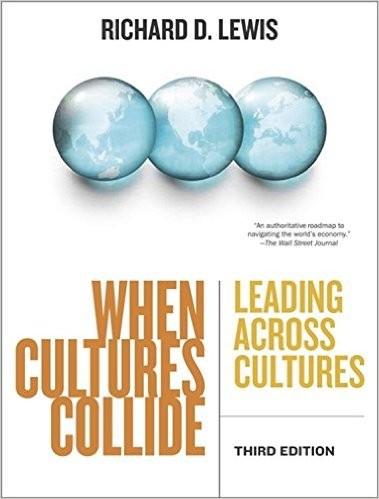
When Cultures Collide: Leading Across Cultures
by
Richard D. Lewis
Published 1 Jan 1996
Having said that, Mediterranean Turks are somewhat tactile among friends (this is usually confined to one’s own sex). In many towns and villages, men dancing with men is a common spectacle. Foreigners are often invited to participate—don’t be shy! Things take time in Turkey and people turn up late for appointments. Istanbul—the largest urban sprawl in Europe—is not easy to move around in, and many delays originate from traffic problems. at te e s At 392 WHEN CULTURES COLLIDE Cultural Factors in Communication Communication Pattern The Turkish communication style derives from its three main roots: Islamic, Mediterranean and Eastern (Ottoman, Seljuk).
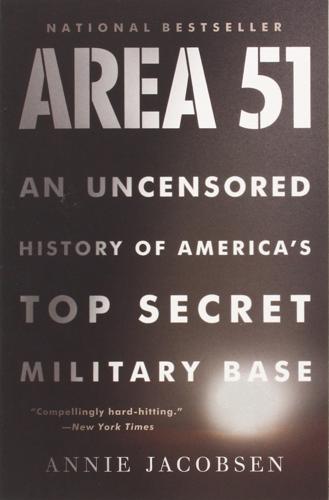
Area 51: An Uncensored History of America's Top Secret Military Base
by
Annie Jacobsen
Published 16 May 2011
It was the lake bed itself that originally appealed to the CIA; for decades it had doubled as a natural runway for Area 51’s secret spy planes. Almost everything visible on approach to Area 51 from the air is restricted government land. There are no public highways, no shopping malls, no twentieth-century urban sprawl. Where the land is hilly, Joshua trees and yucca plants grow, their long spiky leaves extended skyward like swords. Where the land is flat, it is barren and bald. Except for creosote bushes and tumbleweed, very little grows out here on the desert floor. The physical base—its hangars, runways, dormitories, and towers—begins at the southernmost tip of Groom’s dry lake.
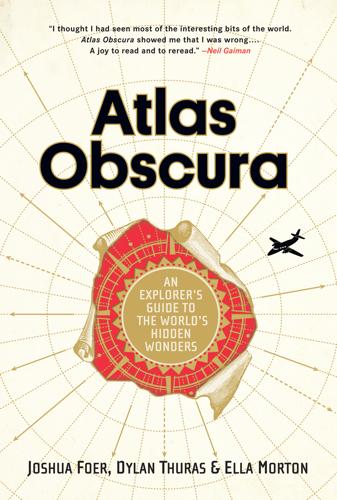
Atlas Obscura: An Explorer's Guide to the World's Hidden Wonders
by
Joshua Foer
,
Dylan Thuras
and
Ella Morton
Published 19 Sep 2016
Landscaping workshops and internships are still available for people who want to be part of the urban experiment. Work at Arcosanti is funded by sales of bronze and ceramic wind chimes. The buildings are a little rundown and shabby; Soleri passed away in 2013, so they’ll likely stay that way. But Arcosanti is a fascinating look at one man’s ambitious alternative to urban sprawl. 13555 South Cross L Road, Mayer. Arcosanti is located between Sedona and Scottsdale. 34.345418 112.116278 Arcosanti’s experimental community is run by eco-loving volunteers. Also in Arizona Santa Claus Mohave County · At this abandoned Christmas-themed town in the middle of the desert, the faded festive decor is covered with graffiti.
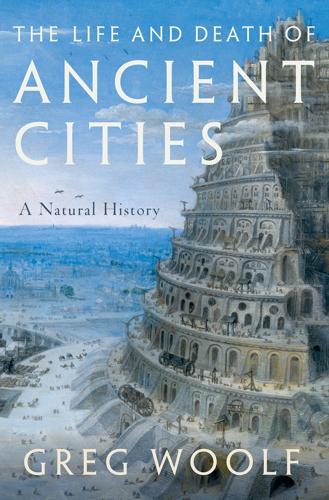
The Life and Death of Ancient Cities: A Natural History
by
Greg Woolf
Published 14 May 2020
This was good news for fishermen, but farmers had fewer resources to work with than their counterparts in the Nile Valley and Babylonia. The Mediterranean world we see today has not changed very much over the last four thousand years, if we can imagine it without the huge increase in population and the consequent urban sprawls and pollution. Sea levels have fluctuated a little in historic times, and some rivers have silted up. Much of the Roman port of Ostia has been lost to the shifting line of the Tiber, and the port of Ephesus now lies far from the sea. These effects varied from place to place. There are Roman villas lying in shallow water offshore in the Bay of Naples, and the Egyptian cities of Canopus and Thonis-Herakleion on the delta sank into the mud sometime in the Middle Ages.

Lonely Planet Kenya
by
Lonely Planet
Around Nairobi Ngong Hills Immortalised in the opening lines from Karen Blixen's classic, Out of Africa, the green and fertile Ngong Hills have a certain mythical quality about them. The best views are from the road which climbs up and over the hills to Lake Magadi, or to put them in their most evocative historical context, from Karen Blixen's House & Museum. Sadly, large swathes of the hills are in danger of being swallowed up by Nairobi's urban sprawl. The Ngong Hills are still something of an expat enclave, and you may stumble upon perfect reproductions of English farmhouses with country gardens full of flowering trees – only the acacias remind you that you aren’t rambling around the home counties of England. You can also try and track down the dishevelled last resting place of Denys Finch Hatton, but you'll need a guide.

Central America
by
Carolyn McCarthy
,
Greg Benchwick
,
Joshua Samuel Brown
,
Alex Egerton
,
Matthew Firestone
,
Kevin Raub
,
Tom Spurling
and
Lucas Vidgen
Published 2 Jan 2001
* * * Overpopulation and the exploitation of the land for export agricultural crops (such as coffee, sugar and cotton) continue to propel El Salvador’s massive deforestation. High population density remains the principal obstacle to the regeneration of ecosystems. Today, a mere 17% of the country is forested, with only a minuscule 2% to 5% of that primary forest. As a result, many native species have become endangered or extinct. Deforestation and unplanned urban sprawl intensify the effects of natural disasters. In recent years El Salvador has been repeatedly pummeled by Mother Nature, producing a laundry list of disasters. In 1998, floods caused by Hurricane Mitch produced 200 fatalities and left 70,000 homeless, acutely damaging the lower Río Lempa. Earthquakes in 2001 brought on landslides and destroyed buildings, killing 1159 people and destroying or damaging almost 300,000 homes.
…
At an altitude of 975m, Tegucigalpa has a fresher and milder climate than the country’s coasts – although long-term residents report a steady temperature rise, as in many other areas of the world. The city is also struggling to cope with huge migration to its bright lights – you will see shantytowns clinging to the mountainsides in the upper reaches of the urban sprawl. The name Tegucigalpa (teh-goos-ee-gal-pa) is a bit of a mouthful; Hondurans often call the city Tegus (teh-goos) for short. The name, meaning ‘silver hill’ in the original local Nahuatl dialect, was given when the Spanish founded the city as a silver and gold mining center in 1578, on the slopes of Picacho.
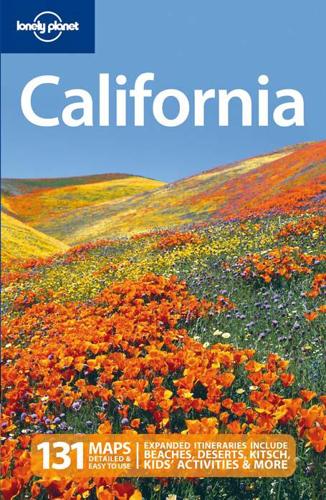
California
by
Sara Benson
Published 15 Oct 2010
A cluster of isolated and supremely scenic HI hostels, at Point Montara (22 miles south of San Francisco) and Pigeon Point (36 miles), make this an interesting route for cyclists, though narrow Hwy 1 itself can be stressful, if not downright dangerous, for inexperienced cyclists. Pacifica & Devil’s Slide Pacifica and Point San Pedro, 15 miles from downtown San Francisco, signal the end of the urban sprawl. South of Pacifica is Devil’s Slide, an unstable cliff area through which Hwy 1 winds and curves. Drive carefully, especially at night and when it is raining, as rock and mud slides are frequent. Heavy winter storms often lead to the road’s temporary closure. A tunnel will soon bypass this dramatic stretch of the highway.
…
Besides sand and ocean, attractions include the Santa Monica Pier and the paved shoreline path for strolling, in-line skating and cycling. Venice (Map) LA’s most outlandish beach thanks to the Venice Boardwalk, with its nonstop parade of friends and freaks. Drum circle in the sand on Sundays. * * * Horseback Riding Leave the urban sprawl behind on the forested bridle trails of Griffith Park or Topanga Canyon. All rides are accompanied by an experienced equestrian wrangler. Rates vary, and a 20% tip is customary. Los Angeles Horseback Riding (Map; 818-591-2032; www.losangeleshorsebackriding.com; 2661 Old Topanga Canyon Rd, Topanga Canyon) Sunset, day and full-moon rides along the Santa Monica Mountains Backbone Trail with fabulous views all around.
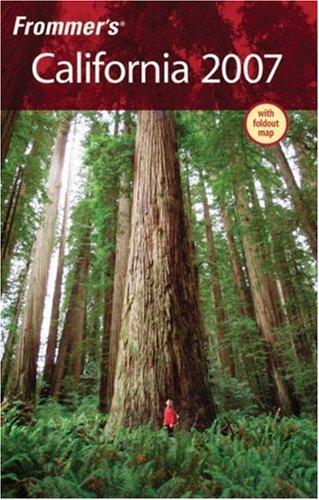
Frommer's California 2007
by
Harry Basch
,
Mark Hiss
,
Erika Lenkert
and
Matthew Richard Poole
Published 6 Dec 2006
For most visitors, Fresno, 185 miles southeast of San Francisco, is just a place to pass through en route to the state parks; it can, however, be a good place to stop for food and lodging, and it makes a good base for exploring the Sierra National Forest (see below). Founded in 1874 in the geographic center of the state, Fresno is in the heart of the Central Valley and has experienced incredible growth in recent years. Like most growing cities, it has seen increases in crime, drugs, and urban sprawl. As the seat of Fresno County, the city handles more than $3 billion annually in agricultural production. It also contains Sun Maid, the world’s largest dried-fruit packing plant, and Guild, one of the country’s largest wineries. If you have any reason at all to be in Fresno, try to visit between late February and late March so you can drive the Fresno County Blossom Trail .
…
These areas feature public gardens, historic neighborhoods, house museums, and quiet bed-and-breakfast inns. 2 Getting Around BY CAR Need I tell you that Los Angeles is a car-crazed city? You’re going to need wheels to easily get around (there is public transportation in L.A., but you don’t want to rely on it). An elaborate network of well-maintained freeways connects this urban sprawl, but you have to learn how to make sense of the system and cultivate some patience for dealing with the traffic—purchasing one of those plastic-covered fold-out maps is a smart investment. The golden rule of driving in Los Angeles is this: Always allow more time to get to your destination than you think you might need, especially during morning and evening rush hours (40 min. of leeway usually suffices).
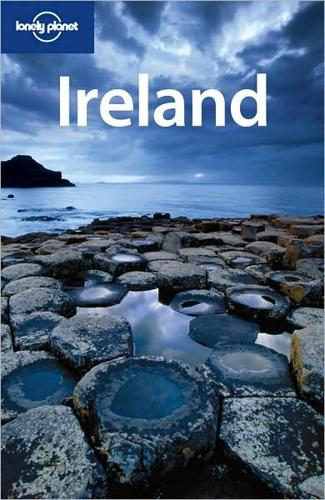
Ireland (Lonely Planet, 9th Edition)
by
Fionn Davenport
Published 15 Jan 2010
Bus You can walk to almost everything in Galway, including out to Salthill, but you’ll also find frequent buses departing from Eyre Sq. For Salthill, take bus 1 (€1.50, 15 minutes). Car Parking throughout Galway’s streets is metered. There are several multistorey and pay-and-display car parks around town. Galway’s unprecedented growth and the resulting lack of infrastructure serving its urban sprawl means that traffic in and out of the city centre can bank up alarmingly. For a stress-free holiday, leave the roads to commuters at peak hours if possible. Taxi Taxi ranks are located on Eyre Sq, on Bridge St, and next to the bus-train station. You can also catch a cab at a taxi office.
…
Loughcrew Gardens are northwest of Kells, along the R154, near Oldcastle. Return to beginning of chapter COUNTY LOUTH The Wee County, as it’s known locally, has prospered greatly in recent years thanks to its proximity to Dublin, but along with a welcome increase in activities, restaurants and nightlife comes commuter congestion and urban sprawl. Louth’s most appealing town is Drogheda, a bustling place steeped in history that makes a good base for visiting Brú na Bóinne, just over the border in County Meath. Nearby are the evocative ruins of Mellifont Abbey and Monasterboice, and to the north the county town of Dundalk. From here it’s a quick trip to the lonely and evocative Cooley Peninsula to enjoy the mountainous landscape and the implausibly picturesque village of Carlingford.
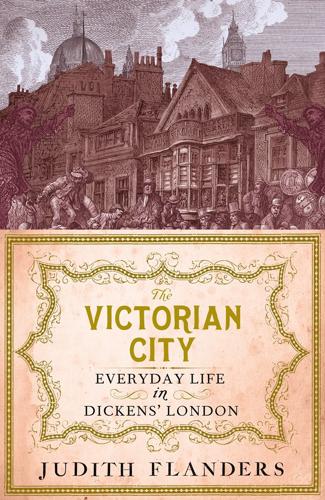
The Victorian City: Everyday Life in Dickens' London
by
Judith Flanders
Published 14 Oct 2012
In 1844, the Metropolitan Buildings Act reversed the prohibition on house drains being connected to the sewers: now such a connection was mandatory, to wash the waste from the city into the river, and from there out to sea. But all that happened was that ‘The Thames is now made a great cesspool instead of each person having one of his own.’ To compound the problem, by mid-century urban sprawl had pushed the market gardens that took the waste-turned-fertilizer ever further away and the economic returns of transporting it were diminishing. When in 1847, guano, concentrated bird excrement, began to be imported as fertilizer, the market for normal waste collapsed, with prices halving. Soon farmers found they could refuse to pay for waste entirely, the nightsoil men being pleased to find anyone at all to take it.

Migrant City: A New History of London
by
Panikos Panayi
Published 4 Feb 2020
The 958,863 inhabitants of 1801 had increased to 6,586,000 by 1901, ‘a fifth of the inhabitants of England and Wales’ largely because of international migration, with over 80 per cent of those arriving between 1841 and 1891 originating in Great Britain, 7 per cent from Ireland and 10 per cent from other parts of the world, overwhelmingly Europe;42 although the period from the late eighteenth until the middle of the nineteenth century also resulted in a fall in London’s death rate which now resembled the rest of the country, due to some improvement in cleanliness and some growth in living standards.43 Nevertheless, the London slum evolved in the metropolis to house the population growth, both in reality and in middle-class fears,44 as many of the newcomers found homes in the urban sprawl which occurred, swallowing an increasingly large section of the surrounding countryside. Some of the areas devoured by the expansion such as St Pancras had greater populations than some of the major provincial cities including Bradford, Bristol or even Leeds.45 The growth of the first four decades of the century ‘was broadly bourgeois in tone, making its biggest push in the north and west’.
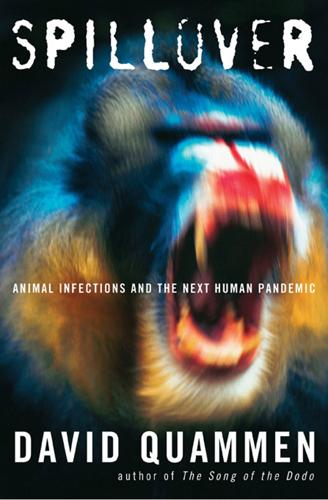
Spillover: Animal Infections and the Next Human Pandemic
by
David Quammen
Published 30 Sep 2012
Habitat alteration was an ancient tradition in Australia, in the form of burning by Aboriginal people, but in recent decades land clearance has become a more drastic and mechanized trend, with less-reversible results, especially in Queensland. Vast areas of old forest have been cut, or chained down with bulldozers, to make way for cattle ranching and urban sprawl. People have planted orchards, established urban parks, landscaped their yards with blossoming trees, and created other unintended enticements amid the cities and suburbs. “So bats have decided that, as their native habitat is disappearing, as climate is becoming more variable, and their food source is becoming less diverse, it’s easier to live in an urban area.”

Mauritius, Réunion & Seychelles Travel Guide
by
Lonely Planet
While most travellers pass right on by en route from coast to coast, there are enough sights to warrant a day or half-day excursion by taxi – we suggest you don't drive yourself or you'll waste valuable time trying to find each place. In addition to the following, consider adding the highlights of Moka, Pailles and Curepipe to your tour. The town of Rose Hill (pronounced row-zeel by locals), wedged between Beau Bassin and Quatre Bornes in the heart of the Central Plateau's urban sprawl, is virtually a suburb of Port Louis. Here, architecture buffs will appreciate the unusual Creole structure housing the Municipality of Beau Bassin-Rose Hill ( MAP GOOGLE MAP ; St Jean Rd). The building was constructed in 1933 as a municipal theatre. The attractive Creole manse next door – Maison Le Carne ( MAP GOOGLE MAP ; St Jean Rd) – houses the Mauritius Research Council.
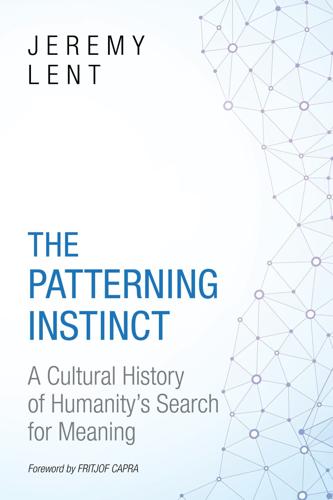
The Patterning Instinct: A Cultural History of Humanity's Search for Meaning
by
Jeremy Lent
Published 22 May 2017
Randers's book forecasts that Pakistan will run out of resources “well before 2052,” leading to increased internal conflicts, which could be especially perilous given the country's nuclear arsenal.70 Along with the human catastrophe of failed states and the misery of billions in overwhelmed coastal megacities, the nonhuman world will be suffering its own form of collapse. Natural ecosystems will be reduced to islands of conservation habitats surrounded by vast agribusiness plantations and urban sprawl. Tropical rain forests will only survive as degraded, shrinking remnants in national parks. Cameron and Jude might not, however, consider this situation as gravely as we do, given their reduced expectation of the natural world from shifting baseline syndrome, as well as their ability to experience vastly enhanced virtual-reality immersions in wildlife reservations, enabling them to feel closer to nature in some ways than do many urban residents in today's world.71 On the other hand, might Cameron and Jude be more profoundly disturbed by the convulsions of their world than an equivalent couple in today's society would be?
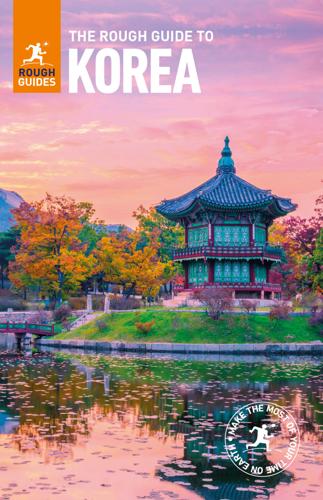
The Rough Guide to Korea
by
Rough Guides
Published 24 Sep 2018
Elsewhere, bar a café or two and a couple of gallery and exhibition spaces, the complex seems a little overlarge and underused. Northern Seoul North of Gyeongbokgung, Seoul appears to come to a rather abrupt end, with lofty mountains rearing up immediately behind the palace. The city did, indeed, once peter out here, but the “Economic Miracle” of the 1970s saw its population mushroom, and consequently Seoul’s urban sprawl pushed around the mountainsides. Development was, however, not as rampant as in other parts of the city, and Seoul’s northern quarters maintain a relatively secluded air. Northwest of Changdeokgung is the buzzing student district of Daehangno, a long-time favourite with visiting backpackers. Better for sightseeing is Seongbukdong, just north of Daehangno; here you’ll find a secluded temple, plus the enchanting Suyeon Sanbang tearoom, possibly the best in the city.
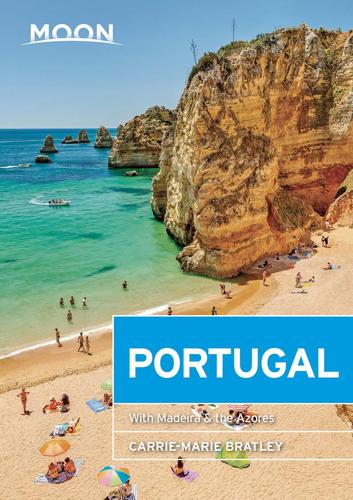
Moon Portugal
by
Carrie-Marie Bratley
Published 15 Mar 2021
Divided into the older uptown and the newer downtown, Coimbra is the country’s third most-populous city. In the late medieval period, the city became a hub of culture and learning, propelled by sprawling Coimbra University. Coimbra’s well-preserved medieval center pumps with a youthful vivacity and a blend of ancient and modern. Surrounded by mountains, the densely constructed urban sprawl is famous for nightlife and its own type of fado. Orientation Bathed by the Mondego River, Coimbra is a steeply heaped pile of handsome buildings, topped off by the revered university complex. Upper Coimbra (the Alta), on the east bank of the Mondego, is the oldest part of the city, where visitors will find many main attractions, including the imposing Coimbra University, which sits like a crown atop the splendid mount; the Machado de Castro National Museum; and the Old Cathedral.
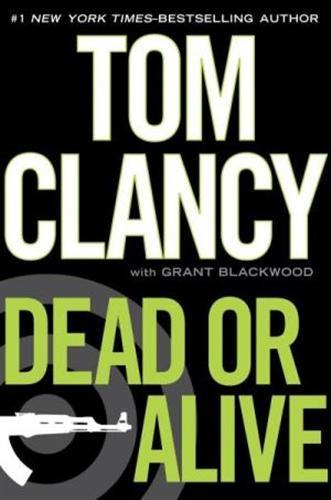
Dead or Alive
by
Tom Clancy
and
Grant (CON) Blackwood
Published 7 Dec 2010
Knowing Allah would take it as a sign of faithlessness, Hadi had always resisted believing in omens, but the proximity of Rio’s Botanical Garden to the O Cristo Redentor, or Christ the Redeemer statue, was unnerving. But then again, he reminded himself, in Rio everything seemed close to the O Cristo Redentor. Sitting at 2,300 feet atop Corcovado Mountain, gazing down at hundreds of square miles of jungle and urban sprawl, the 120-foot, 600-ton soapstone-and-concrete monolith was the city’s most famous landmark—and a reminder to Hadi that he was in a largely heathen country. Hadi had made good time after parting company with Ibrahim and the others, but he’d spent the first two hours of the journey with his hands clenched white on the wheel and looking in his rearview mirror every twenty seconds.

The Rise of the Network Society
by
Manuel Castells
Published 31 Aug 1996
Before developing this idea, I think it is first necessary to introduce the diversity of emerging urban forms in the new historical period, to counter a primitive technological vision that sees the world through the simplified lenses of endless freeways and fiber-optic networks. America’s last suburban frontier The image of a homogeneous, endless suburban/ex-urban sprawl as the city of the future is belied even by its unwilling model, Los Angeles, whose contradictory complexity is revealed by Mike Davis’s marvelous City of Quartz.60 Yet it does evoke a powerful trend in the relentless waves of suburban development in the American metropolis, West and South as well as North and East, toward the end of the millennium.
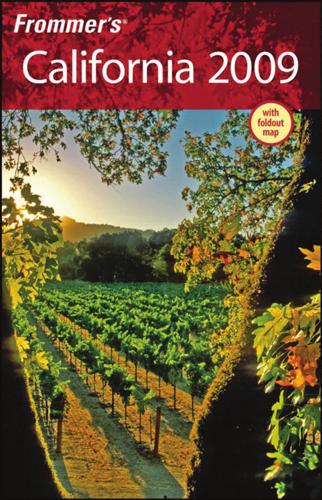
Frommer's California 2009
by
Matthew Poole
,
Harry Basch
,
Mark Hiss
and
Erika Lenkert
Published 2 Jan 2009
For most visitors, Fresno, 185 miles southeast of S an Francisco, is just a place to pass thr ough en route to the state par ks; it can, ho wever, be a good place to stop for food and lodging, and it makes a good base for exploring the S ierra National Forest (see below). Founded in 1874, in the geographic center of the state, F resno is in the hear t of the Central Valley and in recent years has experienced incredible growth. Like most growing cities, it has seen increases in crime, drugs, and urban sprawl. As the seat of F resno County, the city handles mor e than $3 billion annually in agricultural production. It also contains S un Maid, the world ’s largest dried-fr uit packing plant, and Guild, one of the countr y’s largest wineries. If you have any reason at all to be in Fresno, try to visit between late February and late March so you can drive the Fresno County Blossom Trail .
…
Lake Ave. 14 494 2 GETTING AROUND LO S A N G E L E S BY C AR GETTING AROUND 14 Need I tell you that Los Angeles is a car-crazed city? Los Angeles is a sprawling metropolis; ergo, y ou’re really going to need some wheels to get ar ound easily (ther e is public transportation in L.A., but y ou really don’t want to rely on it). An elaborate networ k of well-maintained freeways connects this urban sprawl, but you have to learn how to make sense of the system and cultiv ate some patience for dealing with the traffic—pur chasing one of those plastic-covered fold-out maps is a smar t investment. For a detailed vie w of L.A.’s freeway system, see the tear-out map tucked inside the back co ver of this guide.

Southeast Asia on a Shoestring Travel Guide
by
Lonely Planet
Published 30 May 2012
Try to book at least a day in advance, or several days beforehand, for travel on public holidays and long weekends. The railway’s Train Information Service (www.kereta-api.com) has more information (on the website, Jadwal means schedule). Jakarta 021 / POP 8.9 MILLION First impressions of Jakarta are not good. One of the world’s greatest megalopolises, its grey, relentlessly urban sprawl spreads for tens of traffic-snarled kilometres across a flood-prone plain with barely a park to break the concrete monotony. And yet beneath the unappealing facade of high-rises, slums and gridlocked streets, this is a city of surprises and many faces. From the steamy, richly scented streets of the old quarter to the city’s riotous, decadent nightlife, Jakarta is filled with unexpected corners.
…
Besides the popular dance-and-music shows, there are numerous courses that allow you to become fully immersed in Balinese culture. Ubud is home to chilled-out restaurants and cafes, plus artful and serene places to stay. Around Ubud are temples, ancient sites and whole villages producing handicrafts (albeit mostly for visitors). Although the growth of Ubud has engulfed several neighbouring villages, leading to an urban sprawl, parts of the surrounding countryside remain unspoiled, with lush rice paddies and towering coconut trees. You’d be remiss if you didn’t walk one or more of the dozens of paths during your stay. Ubud Area Top Sights Agung Rai Museum of ArtC5 Neka Art MuseumB1 Sleeping 1Aji LodgeD4 2BiangsD3 3Puri Asri 2D4 4Santra PutraA2 5Swasti CottageB5 6Yuliati HouseD3 Eating 7Mama's WarungD3 8Warung Pulau KelapaB2 Drinking 9Jazz CaféD3 Entertainment 10Arma Open StageC5 Sights Spend time in the museums and walking the beautiful countryside.
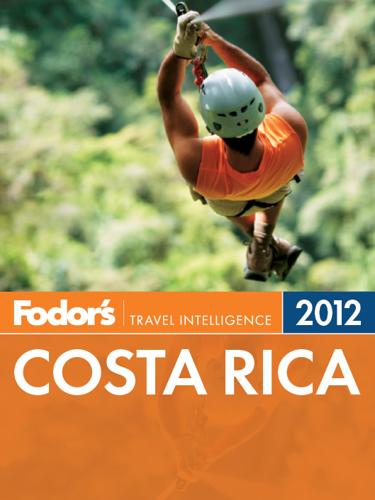
Fodor's Costa Rica 2012
by
Fodor's
Published 6 Oct 2011
Unemployment stands at just under 7%. Tourism Today Costa Rica faces the challenge of conserving its natural resources while still permitting modern development. The government has been unable or unwilling to control illegal logging, an industry that threatens to destroy the country’s old-growth forests. Urban sprawl in the communities surrounding San José and the development of megaresorts along the Pacific coast threaten forests, wildlife, and the slow pace of life that makes Costa Rica so desirable. Although tourism injects much-needed foreign cash into the economy, the government has not fully decided the best way to promote its natural wonders.
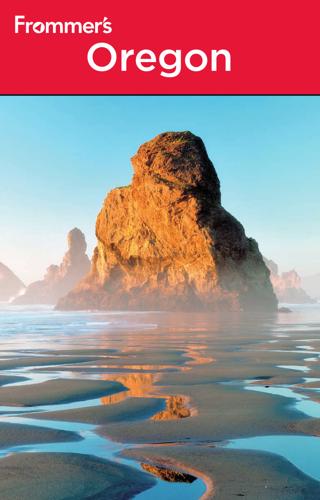
Frommer's Oregon
by
Karl Samson
Published 26 Apr 2010
Other wines you’ll likely encounter in this area include Müller-Thurgaus (usually off-dry white wines), muscats (dessert wines), and sparkling wines (often made from pinot noir and chardonnay grapes). Wine country begins only a few miles west and southwest of Portland. Approaching the town of Newberg on Ore. 99W, you leave the urban sprawl behind and enter the rolling farm country of Yamhill County. These hills form the western edge of the Willamette Valley and provide almost ideal conditions for growing wine grapes. The views from these hills take in the Willamette Valley’s fertile farmlands as well as the snowcapped peaks of the Cascades.

The Evolutionary Void
by
Peter F. Hamilton
Published 18 Aug 2010
She is rather busy right now, after all. And she has my number.” “Don’t we all,” Beckia muttered. Araminta stood at the front of the big passenger capsule, looking through the transparent fuselage that wrapped around her. Five hundred meters below, Greater Makkathran was laid out across the ground, a phenomenal urban sprawl that stretched to the horizon in every direction. Sunlight glinted and flashed off the crystal towers rising from lush parks; lower buildings shone with implausible colors. It was, she acknowledged, a beautiful city. However, her vision of the capital was slightly obscured by the sheer number of capsules rising up out of the designated traffic streams to wait for her to pass.

Lonely Planet Eastern Europe
by
Lonely Planet
,
Mark Baker
,
Tamara Sheward
,
Anita Isalska
,
Hugh McNaughtan
,
Lorna Parkes
,
Greg Bloom
,
Marc Di Duca
,
Peter Dragicevich
,
Tom Masters
,
Leonid Ragozin
,
Tim Richards
and
Simon Richmond
Published 30 Sep 2017
While it hurtles towards a brighter future, its chaotic past unfolds before your eyes: socialist blocks are squeezed between art nouveau masterpieces, and remnants of the Habsburg legacy contrast with Ottoman relics. It's here where the Sava River meets the Danube, contemplative parkland nudges hectic urban sprawl, and old-world culture gives way to new-world nightlife. Grandiose coffee houses and smoky dives all find their rightful place along Knez Mihailova, a lively pedestrian boulevard flanked by historical buildings all the way to the ancient Kalemegdan Citadel, crown of the city. The old riverside Savamala quarter has gone from ruin to resurrection, and is the city's creative headquarters.

Gnomon
by
Nick Harkaway
Published 18 Oct 2017
Cobbles reveal themselves from a given perspective to be bitumen or limestone flagging, and all roads are runways, canals or rivers, so that one might go from London to Boston to Amsterdam as easily as from number nine to number twelve. Growing bolder, one might leave the immediate white European neighbourhood and pass on to Cairo or Kirghizia, to Santiago de las Vegas or Addis Ababa. The journey of a thousand miles does not begin with a single step; it is one step. Humanity exists in a unitary urban sprawl whose laws may vary and whose travel infrastructure may take more or less time in conventional space to connect any given part with any other, but in these fictions there is no such difficulty and the conceptual truth becomes the practical. The reader and therefore also de facto the protagonists move from one room to the next without passing through the intervening space, because there is none.

Spain
by
Lonely Planet Publications
and
Damien Simonis
Published 14 May 1997
* * * MALLORCA’S TOP FIVE BEACHES ▪ Platja de Formentor (Click here) ▪ Cala Llombards (Click here) ▪ Cala de Sant Vicenç (Click here) ▪ Cala de Deià (Click here) ▪ Es Trenc (Click here) * * * Return to beginning of chapter SOUTHWEST COAST A freeway skirts around the Badia de Palma towards Mallorca’s southwest coast. Along the way you’ll pass the resorts of Cala Major, Ses Illetes (lovely little beaches), Palma Nova and Magaluf (nice long beaches and mass British tourism), basically a continuation of Palma’s urban sprawl. From the inland town of Andratx (worth a stop for a taste of an inland Mallorca town, especially busy in the early evening when people sit around for drinks at terraces on Plaça d’Espanya and Plaça des Pou), two turn-offs lead down to the coast: one goes to Port d’Andratx and the other to Sant Elm.
…
Cala d’Or to Cala Mondragó Once a quaint fishing village, Cala d’Or is now an overblown big-dollar resort. Its sleek marina is lined with glistening megayachts and the surrounding hills are crowded with blindingly whitewashed villas. Plenty of lifestyle, little substance. Immediately south of Cala d’Or (and virtually joined to it by urban sprawl) is the smaller and more tranquil Portopetro. Centred on a boat-lined inlet and surrounded by residential estates, it has a cluster of harbourside bars and restaurants, and a couple of small beaches nearby. Two kilometres south of Portopetro, Cala Mondragó is one of the most attractive coves on the east coast.
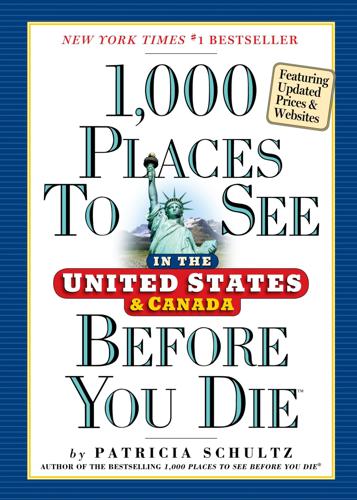
1,000 Places to See in the United States and Canada Before You Die, Updated Ed.
by
Patricia Schultz
Published 13 May 2007
Designed to house the ever-expanding Getty art collection and a library of more than one million books, the hilltop citadel is a work of art itself in gleaming off-white travertine marble and glass. Inside, soaring galleries rely heavily on natural light and are interspersed with courtyards, fountains, connecting walk-ways, and windows that frame views of the Robert Irwin–designed gardens and urban sprawl beyond. Van Gogh’s Irises and five Cézannes (including his Still Life with Apples) are the Getty’s magnets to the masses, offset by its esoteric specialty collections, from Renaissance to Impressionism and 18th-century European decorative arts. The Getty Center’s intimate sunken gardens, glass walls, and open floor plans provide fluid movement between indoor and outdoor space.
…
BEST TIMES: early Aug for Old Spanish Days Fiesta (www.oldspanishdays-fiesta.org); every Sun for waterfront arts and crafts show. 26 Miles Across the Sea SANTA CATALINA ISLAND California Just 26 miles from the coast of Southern California, the jewel-like island of Santa Catalina seems worlds away from the bustling urban sprawl of Los Angeles. It was first purchased and developed by William Wrigley (of chewing gum fame) in 1915, as a popular resort destination for movie stars and Hollywood folks seeking weekend escapes. Today, it’s still an oasis that recalls a simpler time and a glimpse of what undeveloped Southern California once looked like.
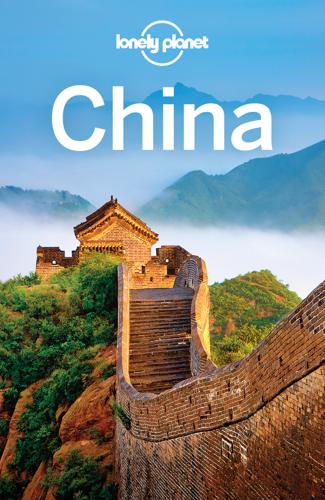
Lonely Planet China (Travel Guide)
by
Lonely Planet
and
Shawn Low
Published 1 Apr 2015
Best for Scenery AShennongjia AWudang Shan AThree Gorges Dam Best for History AJingzhou AWudang Shan AWuhan AHubei Provincial Museum Hubei Highlights 1 Study taichi where it all began, on the awe-inspiring mountain slopes of Wudang Shan. 2 Explore the historic gates, city walls and ruined temples of ancient Jingzhou. 3 Find a bar and knock back a beer in the riverside concession district of mighty Wuhan. 4 Flee China’s urban sprawl and camp out in the wilds of stunning Shennongjia. 5 Go against the tourist tide and start your Three Gorges cruise in Yichang rather than Chongqing. History The Hubei area first came to prominence during the Eastern Zhou (700–221 BC), when the powerful Chu kingdom, based in present-day Jingzhou, was at its height.
…
CYCLING HaINaN Hainan is a great destination for recreational touring. You’re rarely more than an hour from a village with food and water, and never more than a few hours from a town with a decent hotel. At the same time, you’ll find most of your riding is out in nature or through pretty farming valleys, not urban sprawl. Preparation time for a tour can be minimal. Some popular routes include the following: Haidian Island Plenty of fishing villages and rural landscapes and so close to Haikou. North Coast Ride alongside kilometre after kilometre of sand beaches and down side routes into the interior. Wenchang County Ride 100km out to Dongjiao Coconut Plantation and spend the night at a quiet beachside cabin.
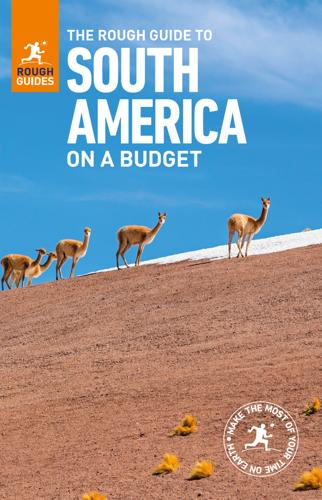
The Rough Guide to South America on a Budget (Travel Guide eBook)
by
Rough Guides
Published 1 Jan 2019
The tiny plaza is said to be the site of the first Spanish settlement, though the tiled-roof colonial chapel on the southwest corner is a modern reconstruction. Cerro de Monserrate Perched above La Candelaria is the rocky outcrop that is one of Bogotá’s most recognizable landmarks: Cerro de Monserrate. The hilltop, crowned by El Santuario de Monserrate church, offers spectacular views back down on the seemingly endless urban sprawl that is Bogotá. It is easily reached by the frequent teleférico cable car (Mon–Sat noon–midnight, Sun 10am–4.30pm; return prices: C$19,000 before 5.30pm, C$20,000 after, Sun C$11,000; cerromonserrate.com) or by funicular railway (Mon & Wed–Fri 6.30–11.45am, Sat 6.30am–4pm, Sun 6.30am–5.30pm; prices same as teleférico).
…
Crossing into Colombia or Brazil: the three-way frontier Leaving or entering Peru via the Amazon means experiencing the three-way frontier between Santa Rosa (Peru), Tabatinga (Brazil) and Leticia (Colombia). Leticia is a lively jungle town with a good selection of guesthouses and restaurants, while Tabatinga is an unpretty urban sprawl a few blocks away (the two towns blend into one another), from where you can take a boat to Manaus if continuing on in Brazil. The route by river from Iquitos to Santa Rosa takes some 9–10hr by rápido (speedboat; S/160 one-way, including meals) or 2.5–3 days in a standard cargo boat (from S/100 hammock one-way; cabin from S/160).

USA's Best Trips
by
Sara Benson
Published 23 May 2010
For a great-view detour, grab Mulholland Dr off Cahuenga Blvd, winding an eighth of a mile to the top of the hill. Turn left to enter the small Hollywood Bowl Overlook. Even on hazy days, the sight of the Hollywood Bowl, Griffith Park and the city unfurling below is memorable, highlighting the rarely considered juxtaposition of raw nature and urban sprawl. Continue west a third of a mile and make a quick left at the bend onto Outpost Dr, a twisting ride past homes tucked behind hedges, trees and canyon nooks, which will take you back to Hollywood Blvd. If you’re in the mood for driving, pass Outpost Dr and continue west on Mulholland Dr. As this famous roadway winds along the summit of the Santa Monica Mountains, you’ll have views of the San Fernando Valley to the north and Hollywood to the south.
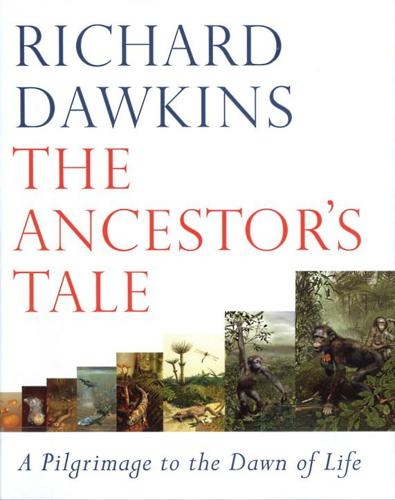
The Ancestor's Tale: A Pilgrimage to the Dawn of Evolution
by
Richard Dawkins
Published 1 Jan 2004
'Mediterranean' communities have arisen not just around the Mediterranean Sea itself, but on the coasts of California, Chile, south-western Australia and the Cape region of South Africa. The particular species of plants found in these five regions are different, but the plant communities themselves are as characteristically 'Mediterranean' as, say, Tokyo and Los Angeles are recognisably 'urban sprawl'. And an equally characteristic fauna goes with the Mediterranean vegetation. Tropical reef communities are like that. They vary in detail but are the same in essentials, whether we are talking about the South Pacific, the Indian Ocean, the Red Sea or the Caribbean. There are also temperate-zone reefs, which are somewhat different, but one very particular thing the two have in common is the remarkable phenomenon of cleaner fish -- a wonder which epitomises the sort of subtle intimacy that can arise in a climax ecological community.

Fodor's Hawaii 2012
by
Fodor's Travel Publications
Published 15 Nov 2011
The reserve is off-limits to the public, but all beaches in Hawai‘i are public to the high-water line, and there is a beach-access pathway a few houses before the road’s end. Turn left when you get to the beach and find your spot near where the houses end. | Kalaniana‘ole Hwy. | Just past Niu Valley, on right, on Paikō Dr | 96721. Windward O‘ahu Looking at Honolulu’s topsy-turvy urban sprawl, you would never suspect the Windward side existed. It’s a secret Oahuans like to keep, so they can watch the awe on the faces of their guests when the car emerges from the tunnels through the mountains and they gaze for the first time on the panorama of turquoise bays and emerald valleys watched over by the knife-edged Ko‘olau ridges.

Fodor's Hawaii 2013
by
Fodor's
Published 22 Jul 2012
For more information, see www.shangrilahawaii.org. * * * Windward Oahu Approximately 15 miles northeast of downtown Honolulu (20–25 minutes by car), approximately 25 miles southeast of downtown Honolulu via Ka Iwi and Waimanalo (35–45 minutes by car). Looking at Honolulu’s topsy-turvy urban sprawl, you would never suspect the windward side existed. It’s a secret Oahuans like to keep, so they can watch the awe on the faces of their guests when the car emerges from the tunnels through the mountains and they gaze for the first time on the panorama of turquoise bays and emerald valleys watched over by the knife-edged Koolau ridges.
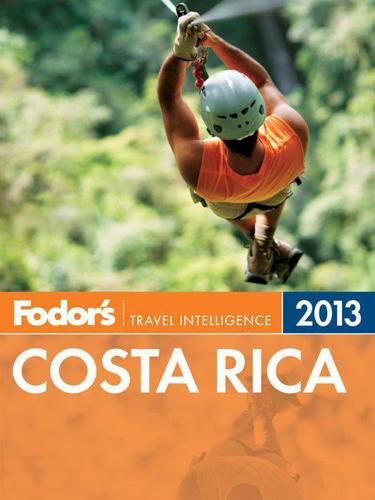
Fodor's Costa Rica 2013
by
Fodor's Travel Publications Inc.
Published 1 Oct 2012
Unemployment stands at just under 7%. TOURISM Today Costa Rica faces the challenge of conserving its natural resources while still permitting modern development. The government has been unable or unwilling to control illegal logging, an industry that threatens to destroy the country’s old-growth forests. Urban sprawl in the communities surrounding San José and the development of megaresorts along the Pacific coast threaten forests, wildlife, and the slow pace of life that makes Costa Rica so desirable. Although tourism injects much-needed foreign cash into the economy, the government has not fully decided the best way to promote its natural wonders.
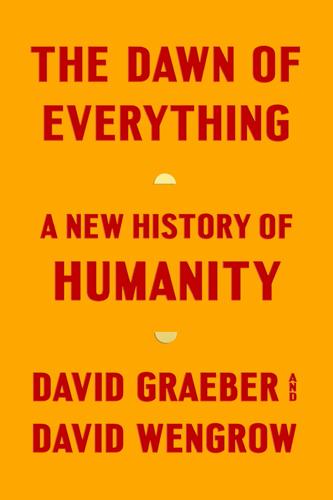
The Dawn of Everything: A New History of Humanity
by
David Graeber
and
David Wengrow
Published 18 Oct 2021
Seafood arrived from the distant coast, presumably smoked or salted; but how far the various sectors of the urban economy were integrated at this time, and how exactly resources were pulled in from a wider hinterland, is altogether unclear.24 What we can say is that the Teotihuacanos’ efforts to create a civic identity focused initially on the building of monuments: the raising of a sacred city in the midst of the wider urban sprawl.25 This meant the creation of an entirely new landscape in the centre of Teotihuacan, requiring the work of some thousands of labourers. Pyramid-mountains and artificial rivers went up, providing a stage for the performance of calendrical rituals. In a colossal feat of civil engineering, the channels of the Rio San Juan and Rio San Lorenzo were diverted, tying them to the city’s orthogonal grid and transforming their marshy banks into solid foundations (all this, recall, without the benefit of working animals or metal tools).
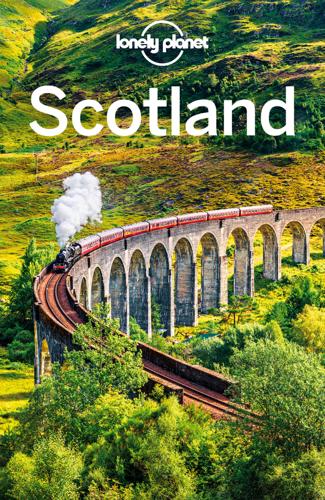
Lonely Planet Scotland
by
Lonely Planet
Outside the centre, the 'battlefield' itself is no more than an expanse of neatly trimmed grass, crowned with a circular monument inscribed with a poem by Kathleen Jamie, and a Victorian statue of the victor astride his horse. There has been much debate over exactly where the Battle of Bannockburn took place, but it was definitely somewhere near here on the southern edge of Stirling's urban sprawl. Exploiting the marshy ground around the Bannock Burn, Bruce won a great tactical victory against a much larger and better-equipped force. Church of the Holy RudeCHURCH ( MAP GOOGLE MAP ; www.holyrude.org; St John St; suggested donation £2; h11am-4pm Easter & May-Sep) The Church of the Holy Rude has been the town’s parish church for 600 years; the infant King James VI was crowned here in 1567, making it the only British church still in daily use to have witnessed a royal coronation, other than Westminster Abbey.

Lonely Planet Scotland
by
Lonely Planet
Outside the centre, the ‘battlefield’ itself is no more than an expanse of neatly trimmed grass, crowned with a circular monument inscribed with a poem by Kathleen Jamie, and a Victorian statue of the victor astride his horse. There has been much debate over exactly where the Battle of Bannockburn took place, but it was definitely somewhere near here on the southern edge of Stirling’s urban sprawl. Exploiting the marshy ground around the Bannock Burn, Bruce won a great tactical victory against a much larger and better-equipped force. Stirling Old BridgeBRIDGE (HES; h24hr) F Dating from the 15th century, this graceful arched stone bridge is one of the oldest in Scotland, now reserved for pedestrians and cyclists only.
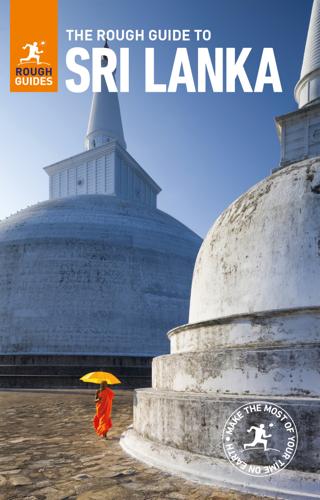
The Rough Guide to Sri Lanka
by
Rough Guides
Published 21 Sep 2018
Ella The island’s most beautifully situated village, with superb views and country walks. Sinharaja This unique tract of undisturbed tropical rainforest is a botanical treasure trove of global significance. HIGHLIGHTS ARE MARKED ON THE MAP Colombo to Radawaduna Heading inland from Colombo along the Kandy road, the urban sprawl continues for the best part of 25km until you pass the turn-off to the large town of Gampaha. Beyond here, a series of roadside settlements (shown on the map) exemplify the continuing tendency for Sri Lankan villages (especially in the Kandyan region) to specialize in a particular craft or crop.
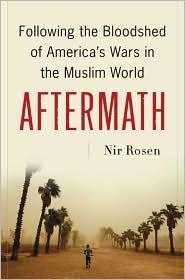
Aftermath: Following the Bloodshed of America's Wars in the Muslim World
by
Nir Rosen
Published 21 Apr 2011
When I visited in late February 2006 the crowds of Iraqis there exceeded the numbers at the nearby section for Palestinian refugees. Iraqis continued to enter Egypt by the planeload. They came on tourist visas at first, but extended them indefinitely or applied for temporary protection at the UNHCR, and settled into the urban sprawl of Cairo. In the Medinat Nasr district, past the Layali Baghdad (Baghdad Nights) restaurant, I found a small Internet cafe owned by Muhamad Abu Rawan, a twenty-seven-year-old Sunni man who fled Iraq on May 15, 2006, with his wife, Lubna, also twenty-seven. Muhamad walked me to their nearby apartment, where we found Lubna watching a soap opera and holding their three-month-old daughter, Rawa.
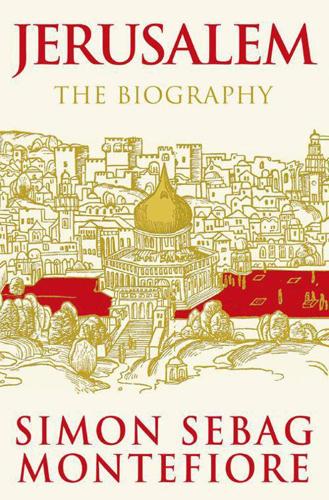
Jerusalem: The Biography
by
Simon Sebag-Montefiore
Published 27 Jan 2011
His baronetcy was inherited by his nephew Sir Abraham who was childless (his wife went insane on their wedding night) but Moses left his estates to his Moroccan-born nephew Joseph Sebag who became Sebag-Montefiore. The Ramsgate mansion burned down in the 1930s. An almost forgotten figure (except in Israel), his tomb was neglected for a long time, threatened by urban sprawl and graffiti, but in the twenty-first century, his tomb has become a shrine: thousands of ultra-Orthodox Jews make a pilgrimage there on the anniversary of his death. * Ironically Twain stayed in the Mediterranean Hotel in the Muslim Quarter, the very building which the Israeli Likud leader and general Ariel Sharon bought in the late 1980s in his bid to judaize the Muslim Quarter.
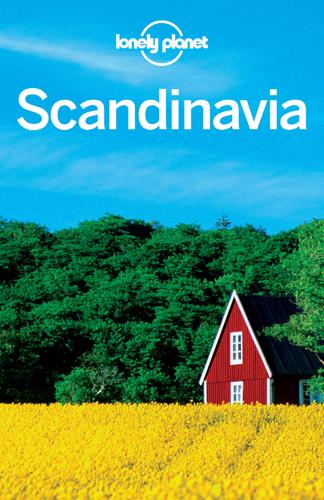
Scandinavia
by
Andy Symington
Published 24 Feb 2012
But the main attraction is Norðragøta’s Blásastova ( 222717; www.blasastova.fo; adult/child Dkr40/10; 2-4pm Fri-Tue mid-May–mid-Sep) , a historical museum that incorporates half a dozen turf-roofed buildings, including the village church. Stones in the basement of one such house are supposedly remnants of the home of saga-era anti-hero Tronður i Gøtu, whose statue looks towards it from a bizarre horizontal posture. Southern Eysturoy Prosperous Runavík (www.visiteysturoy.fo) is the centre of a semi-urban sprawl that lines much of the Skálafjord. The area isn’t worth a detour but if you’re driving this way there are moorland and headland views from the wind farm above forgettable Æðuvik, while Nes has ancient and modern churches plus a one-gun WWII sea-defence emplacement. Villages Lambi and Selatrað have the area’s most picturesque rural settings.
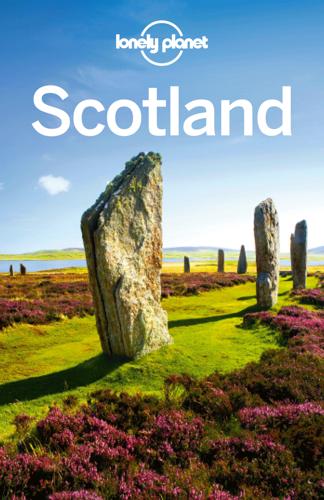
Scotland Travel Guide
by
Lonely Planet
As the last stop on the Pennine Way, Kirk Yetholm SYHA ( 0845 293 7373; www.syha.org.uk; Kirk Yetholm; dm £15.25; Apr–mid-Sep) is often busy; book well in advance. Bus 81 from Kelso runs up to seven times a day Monday to Saturday (three times on Sunday). Melrose POP 1656 Tiny, charming Melrose is a polished village running on the well-greased wheels of tourism. This little enclave is a complete contrast to overbearing Galashiels, whose urban sprawl laps at its western edges. Sitting at the feet of the three heather-covered Eildon Hills, Melrose has a classic market square and one of the great abbey ruins. Sights Melrose Abbey ABBEY (HS; www.historic-scotland.gov.uk; adult/child £5.20/3.10; 9.30am-5.30pm Apr-Sep, 9.30am-4.30pm Oct-Mar) Perhaps the most interesting of all the great Border abbeys, the red-sandstone Melrose Abbey was repeatedly destroyed by the English in the 14th century.

Lonely Planet Morocco (Travel Guide)
by
Lonely Planet
,
Paul Clammer
and
Paula Hardy
Published 1 Jul 2014
Industrialisation has put considerable pressure on Morocco’s delicately balanced natural environments, and while steps are being taken to create wildlife reserves for Morocco’s endangered species, visitors can do their part to preserve natural habitats by staying on marked pistes (dirt tracks) and taking out waste. Coastal Species Away from the urban sprawl of port cities and resort complexes are long stretches of rugged Moroccan coastline, where people are far outnumbered by abundant bird populations and marine mammals such as dolphins and porpoises. Along beaches, you’ll spot white-eyed gulls, Moroccan cormorants and sandwich terns. Seabirds and freshwater birds thrive in preserves such as Souss-Massa National Park, where you might spy endangered bald ibis along with the ducks and waders who migrate here from Europe for the winter.

Egypt Travel Guide
by
Lonely Planet
Then again, an Egyptian will also be there to sell you some papyrus or perfume – an undeniable reality of travel here. But the souvenir sales are a minor irritant when compared with the chance to connect with some of the world’s most generous people. Top of section TOPexperiences Pyramids of Giza 1 Towering over the urban sprawl of Cairo and the desert plains beyond, the Pyramids of Giza (Click here) and the Sphinx are at the top of every traveller’s itinerary. Bring lots of water, an empty memory card and plenty of patience! You’ll have to fend off lots of people pushing horse rides and Bedouin headdresses in order to enjoy this ancient funerary complex, but no trip to Egypt is complete without a photo of you in front of the last surviving ancient wonder of the world.

Egypt Travel Guide
by
Lonely Planet
Is it the way the lush Nile Valley gives way, from one footstep to another, to the harshness of the desert? Is it the light in the eyes of the person telling me a story in a cafe, who has just burst into laughter? The intensity of the light, the love of life and the sense of family are just three reasons of many, many more. Egypt’s Top 17 Pyramids of Giza Towering over the urban sprawl of Cairo and the desert plains beyond, the Pyramids of Giza and the Sphinx are at the top of almost every traveller’s itinerary. Bring lots of water, an empty memory card and plenty of patience! You may have to fend off a few eager locals pushing horse rides and Bedouin headdresses in order to enjoy this ancient funerary complex, but no trip to Egypt is complete without a photo of you in front of the last surviving ancient wonder of the world.
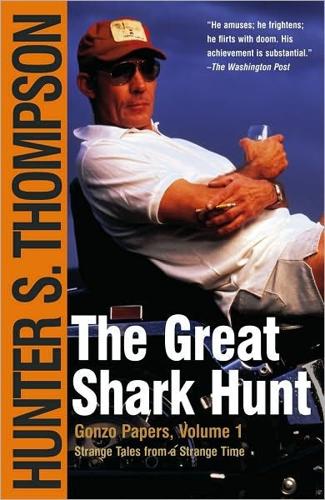
The Great Shark Hunt: Strange Tales From a Strange Time
by
Hunter S. Thompson
Published 6 Nov 2003
Now he's trying to get rid of Restrepo, cut the balls off the news and turn KMEX-TV back into a safe Tio Taco station. Shit! And he's getting away with it." The total castration of KMEX-TV would be a crippling blow to the Movement. A major media voice can be an invaluable mobilizing tool, particularly in the vast urban sprawl of Los Angeles. All it takes is a sympathetic news director with enough leverage and personal integrity to deal with the news on his own terms. The man who hired Ruben Salazar, former station director Joe Rank, considered him valuable enough to out-bid the blue-chip Los Angeles Times for the services of one of that paper's ranking stars -- so nobody argued when Salazar demanded absolute independence for his KMEX news operation.
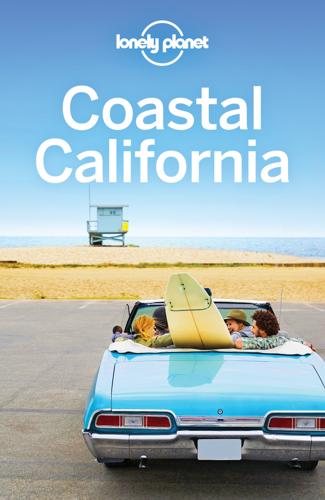
Coastal California Travel Guide
by
Lonely Planet
Check www.sjdowntownparking.com for details. Pacifica & Devil’s Slide One of the real surprises of the Bay Area is how fast the cityscape disappears along the rugged and largely undeveloped coast. The lazy beach town of Pacifica, just 15 miles from downtown San Francisco, signals the end of the urban sprawl. Most beaches along Hwy 1 are buffeted by wild and unpredictable surf, making them better suited to sunbathing (weather permitting) than swimming. Immediately south of Pacifica is the Devil’s Slide, a gorgeous coastal cliff area now bypassed by a car tunnel. Pacifica State BeachBEACH (Linda Mar Beach; GOOGLE MAP ; %650-738-7381; www.parks.ca.gov; 5000 Pacific Coast Hwy; per car $5-9; h5am-dusk; pc) In Pacifica, collecting a suntan or catching a wave are the main attractions at popular Pacifica State Beach, as well as Rockaway Beach just north.
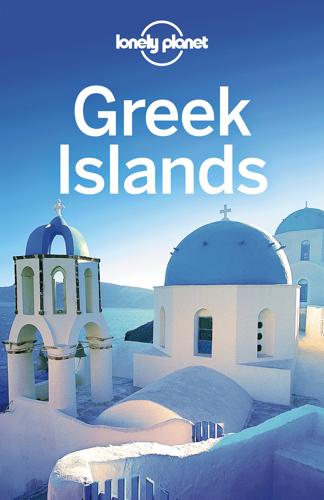
Lonely Planet Greek Islands
by
Lonely Planet
,
Alexis Averbuck
,
Michael S Clark
,
Des Hannigan
,
Victoria Kyriakopoulos
and
Korina Miller
Published 31 Mar 2012
Piraeus, 10km southwest of central Athens, is the biggest port in the Mediterranean (with more than 20 million passengers passing through annually), the hub of the Aegean ferry network, the centre of Greece’s maritime trade and the base for its large merchant navy. While technically a separate city, these days Piraeus virtually melds into the urban sprawl of Athens. Central Piraeus is not a place where visitors choose to linger because it’s congested with traffic. Beyond its shipping offices, banks and public buildings, you find a jumble of pedestrian precincts, shopping strips and rather grungy areas. The most attractive quarter lies to the east around Zea Marina and touristy Mikrolimano harbour, which is lined with cafes, restaurants, bars and nightclubs.
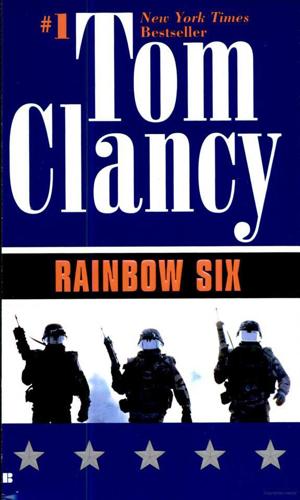
Rainbow Six
by
Tom Clancy
Published 2 Jan 1998
The customs clerks were kind and waved him right through to the cabstand, where, for the usual exorbitant fee, he engaged a Pakistani driver to take him into town, making him wonder idly if the cabbies had a deal with the customs people. But he was on an expense account-meaning he had to get a receipt-and, besides, he had ensured that day that he could afford such things without one, hadn't he? He smiled as he gazed at the passing urban sprawl. It got thicker and thicker on the way to Manhattan. The cab dropped him off at his apartment house. The flat was paid for by his employer, which made it a tax-deductible business expense for them-Popov was learning about American tax law-and free for him. He spent a few minutes dumping his dirty laundry and hanging up his good clothes before heading downstairs and having the doorman flag a cab.
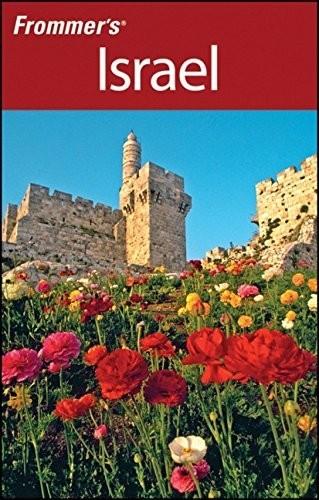
Frommer's Israel
by
Robert Ullian
Published 31 Mar 1998
The trip takes about half an hour, and it’s a splendid drive along the uppermost rim of Carmel. The Mediterranean is way down below you, as are the entire city, the port, and the industrial area. Bring your camera. Architecturally, the villages are no longer the quaint enclaves of 30 or 40 years ago; instead, they’ve become part of the urban sprawl at the outer edge of the city. Israelis visit the villages for the many home-style Middle Eastern restaurants that have sprung up, and for bargain-basement shopping, especially on Saturday (see below). The Druze are Arabic-speaking people who are, however, not Muslims. Theirs is a rather secretive religion; they draw heavily on the Bible and venerate such personages as Jethro (a Midianite priest and the non-Israelite father-in-law of Moses).
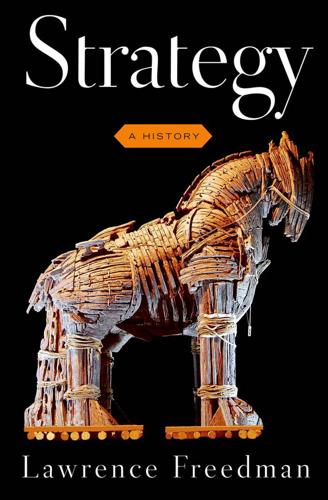
Strategy: A History
by
Lawrence Freedman
Published 31 Oct 2013
It reflected an essentially romantic and nostalgic view of strategy, unhampered by the normal constraints of politics and economics, over-impressed by both Soviet doctrine and its supposed vulnerability to maneuver warfare, as well as over-optimistic about the Western ability to implement it successfully.44 The maneuver strategies advocated were often impractical. They would be high-risk options in European conditions, with its urban sprawl and complex road and train networks, and place enormous strain on good intelligence and effective command and control. A faulty maneuver could lead to absolute disaster and leave the rear exposed. Furthermore, a new offensive doctrine could unsettle American allies in Europe, notably the Federal Republic of Germany, which was wary of association with anything that could be considered an aggressive strategy or a defensive strategy that involved turning its territory into a battleground.
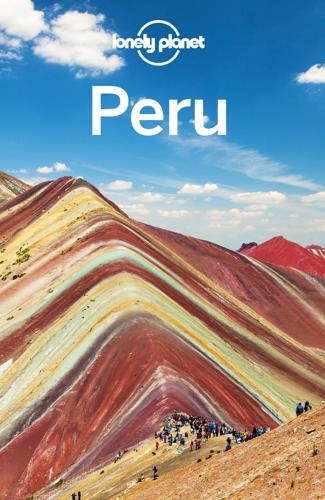
Lonely Planet Peru
by
Lonely Planet
That said, a number of international agencies and not-for-profit organizations contribute money, staff and resources to help with conservation and education projects. Environmental Issues Peru faces major challenges in the stewardship of its natural resources, with problems compounded by a lack of law enforcement and its impenetrable geography. Deforestation and erosion are major issues, as is industrial pollution, urban sprawl and the continuing attempted eradication of coca plantations on some Andean slopes. In addition, the Carr Interoceánica through the heart of the Amazon may imperil thousands of square kilometers of rainforest. Reduced growth in mining earnings in the 21st century has led the government to install protectionist measures, much to the detriment of the environment.

Hawaii
by
Jeff Campbell
Published 4 Nov 2009
Swimming is a no-go though, as a rocky shelf creates unfavorable conditions for water activities. CENTRAL MAUI Your first look at Maui will likely be here, on the windswept flatlands that separate Maui’s two mountain masses. Paradoxically, central Maui lays claim to both the island’s largest urban sprawl and its greenest agricultural land. Fields of waving sugarcane stretch clear across the central plains from Kahului to Ma′alaea. But central Maui’s claim to fame for travelers is found in the water. Anything with a sail rips in this wind-whipped region. Kanaha Beach has morphed into one of the hottest windsurfing and kiteboarding destinations on the planet, bursting each day into a colorful mile-long sea of sails.
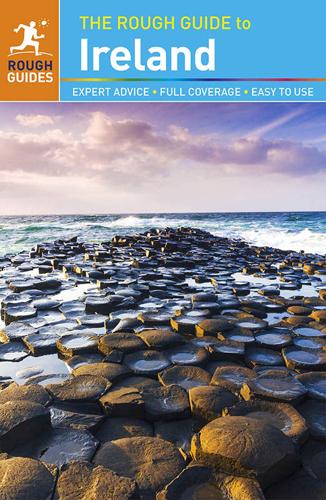
The Rough Guide to Ireland
by
Clements, Paul
Published 2 Jun 2015
The lay of the land and the road network lend themselves to a democratic exploration, with each part of the country fair game, and you’re unlikely to feel swallowed up by the cities’ gravitational pull. In rural areas, switch modes to walking boots or two wheels (motorized or otherwise) and you’ll be in no great hurry to return to the urban sprawl, however vibrant. In some areas public transport coverage fades to black, and you have no choice but to feel your way – the perfect opportunity to get to grips with Ireland’s rich textures. The west coast is famous for its long beaches and windswept cliffs with views of the western islands; the drama of the landscape here is awe-inspiring, not least to the surfers who flock to Donegal and Galway.
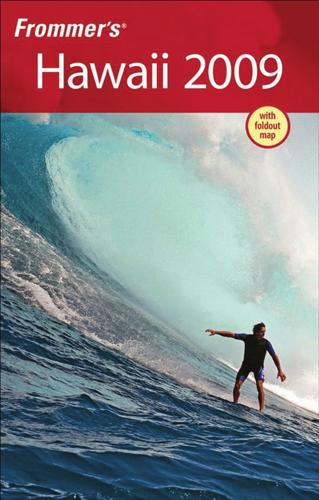
Frommer's Hawaii 2009
by
Jeanette Foster
Published 2 Jan 2008
King St., Room 202, at Smith Street (& 808/ 533-3181; www.chinesechamber.com; bus: 2). The cost is $10 per person; call ahead to reserve. The price of all the delicious goodies you will sample on the tour is included in the low $10 fee. For a self-guided walking tour of the neighborhood, see p. 215. GUIDED ECO-TOURS Oahu isn’t just high-rises in Waikiki or urban sprawl in Honolulu, but extinct craters, hidden waterfalls, lush rainforests, forgotten coastlines, and rainbow-filled valleys. To experience the other side of Oahu, contact Oahu Nature Tours (& 808/924-2473; www.oahunaturetours.com). It offers seven different eco-tours, starting at $24 per 09_285558-ch05.qxp 202 8/11/08 10:39 PM Page 202 C H A P T E R 5 .
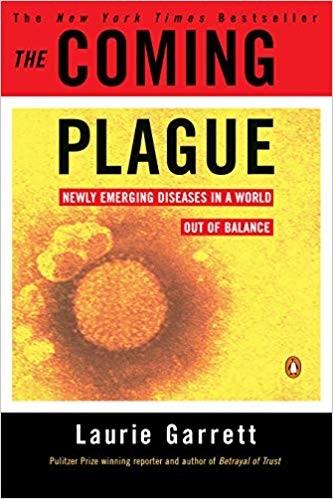
The Coming Plague: Newly Emerging Diseases in a World Out of Balance
by
Laurie Garrett
Published 31 Oct 1994
At the same time public health authorities in the port of Liverpool, England, reported that forty cases of PPNG had surfaced in their city during the previous eight months.12 By early 1977, PPNG reports were coming in from all over the United States, and a third of the cases involved U.S. military personnel recently returned from Asia, particularly the Philippines.13 The U.S. Navy and Air Force both had enormous bases in the Philippines, surrounded by a dense urban sprawl of tens of thousands of people eager to earn U.S. dollars. Notably, prostitution thrived around both bases, and black-market penicillin was sold to the brothels and the hookers. Surveys in the Philippines revealed that some 40 percent of all gonorrhea cases in cities near U.S. military bases were PPNG.
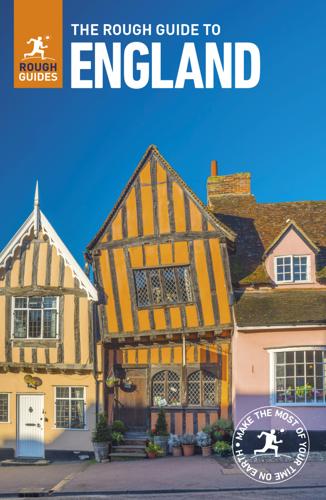
The Rough Guide to England
by
Rough Guides
Published 29 Mar 2018
Sure enough, Southampton has figured in numerous stirring events: it witnessed the exodus of Henry V’s Agincourt-bound army, the Pilgrim Fathers’ departure in the Mayflower in 1620 and the maiden voyages of such ships as the Queen Mary and the Titanic. Despite its pummelling by the Luftwaffe and some disastrous postwar urban sprawl, the thousand-year-old city has retained some of its medieval charm in parts and has reinvented itself as a twenty-first-century shopping centre in others, with the giant glass-and-steel West Quay as its focus. A short stroll north of here, Southampton’s new Cultural Quarter is worth a visit, with its open squares, excellent art gallery and superb Sea City Museum.
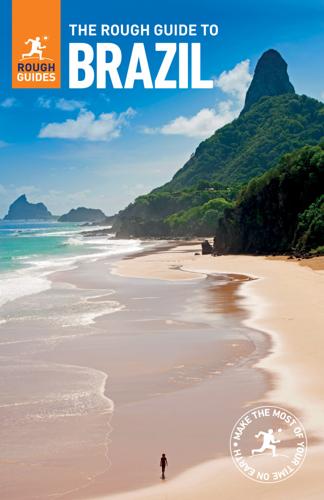
The Rough Guide to Brazil
by
Rough Guides
Published 22 Sep 2018
R$155 Caldas Novas More easily accessible than many of Goiás’s attractions, the thermal resorts of Caldas Novas, around 185km south of Goiânia, are incredibly popular with Brazilians from beyond the state. It claims to be one of the world’s largest hot-spring aquifers, a massive and very hot natural subterranean reservoir. The healing reputation and the sheer joy of relaxing in these natural spa resorts lure plenty of people from the urban sprawl of the São Paulo region. While some people do come for long, expensive courses of treatment, most visitors are simply here on holiday, relaxing, sunbathing and taking the waters for a few days or a week. It gets crowded in the dry season from May to September, but there are thousands of hotel beds within this relatively small town of only around 40,000 people.

The Rough Guide to New Zealand: Travel Guide eBook
by
Rough Guides
Published 1 Jan 2024
With more time, head out to the Hauraki Gulf islands: craggy, volcanic Rangitoto, sophisticated Waiheke, bird-rich Tiritiri Matangi and chilled-out Great Barrier. Auckland’s climate is temperate and muggy, though never scorching hot, and the humidity is always tempered by a sea breeze. Winters are generally mild but rainy. The average daytime high is 23°C in January and February, and drops down to 14°C in July and August. Auckland AUCKLAND’s urban sprawl smothers the North Island’s wasp waist, a narrow isthmus where the island is all but severed by river estuaries probing inland from the city’s two harbours. To the west, the shallow and silted Manukau Harbour opens out onto the Tasman Sea at a rare break in the long string of black-sand beaches continually pounded by heavy surf.

Frommer's England 2011: With Wales
by
Darwin Porter
and
Danforth Prince
Published 2 Jan 2010
Lowry (the artist, not to be confused with the galleries, the hotel, or the theater that bears his name) depicted the horror of the England’s industrial north, before it disappeared forever. His matchstick people are dwarfed by the smokestacks and viaducts in his paintings. Those paintings, as seen here, imposed a vision of a grim and gloomy urban sprawl, but he found a cohesion and lyric beauty in the industrial landscape. He was especially fond of depicting the crudeness of capitalism, forcing workers into boxlike row houses, as railroads nearby rattled across viaducts belching smoke. His best-known paintings are from 1905 to 1925. 20_615386-ch17.indd 59420_615386-ch17.indd 594 8/24/10 2:14 PM8/24/10 2:14 PM The Lowry, Pier 8, Salford Quays. & 0843/208-6000. www.thelowry.com.
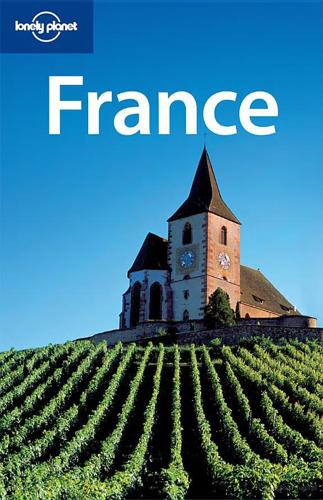
France (Lonely Planet, 8th Edition)
by
Nicola Williams
Published 14 Oct 2010
CYCLING To get from Dijon to Beaune by bike, follow the quiet (but almost vergeless/shoulderless) D122, which gradually becomes pretty south of Couchey, to Nuits-St-Georges. From there, take either the challenging D8 and the D115C, or the flatter D20, just east of the N74, which offers fine views of the wine slopes. The ride takes three or four hours and covers about 50km. To avoid cycling both ways (or through Dijon’s ugly and heavily trafficked urban sprawl, which stretches as far south as Marsannay-la-Côte), you can take your bike along on most Dijon–Beaune trains – look for the bicycle symbol on train schedules. The 20km Voie des Vignes (Vineyard Way), a bike route marked by rectangular green-on-white signs, goes from Beaune’s Parc de la Bouzaize via Pommard, Volnay, Meursault, Puligny-Montrachet and Chassagne-Montrachet to Santenay, where you can pick up the Voie Verte (Click here) to Cluny.
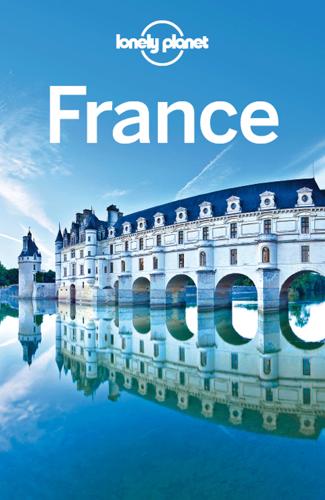
Lonely Planet France
by
Lonely Planet Publications
Published 31 Mar 2013
Sights & Activities Vieil Antibes HISTORIC QUARTER Vieil Antibes is a pleasant mix of food shops, boutiques and restaurants. Mornings are a good time to meander along the little alleyways, when the Marché Provençal (cours Masséna; 7am-1pm Tue-Sun Sep-Jun, daily Jul & Aug) (market) is in full swing. Check out the views from the sea walls, from the urban sprawl of Nice to the snowy peaks of the Alps and nearby Cap d’Antibes. Musée Picasso ART MUSEUM (www.antibes-juanlespins.com; Château Grimaldi, 4 rue des Cordiers; adult/student/child €6/3/free; 10am-noon & 2-6pm Tue-Sun) ‘If you want to see the Picassos from Antibes, you have to see them in Antibes.’
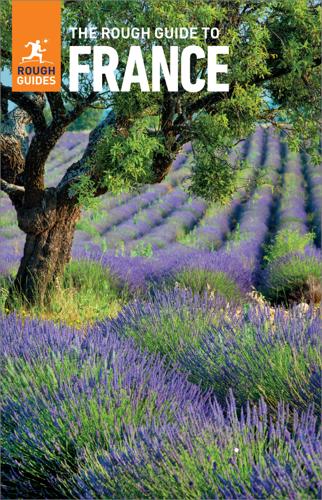
The Rough Guide to France (Travel Guide eBook)
by
Rough Guides
Published 1 Aug 2019
< Back to Provence iStock LE VIEUX PORT, MARSEILLE The Côte d’Azur Marseille Cassis La Ciotat Bandol and around Hyères and around The Corniche des Maures The Massif des Maures St-Tropez and around Ste-Maxime Fréjus and around Cannes and around Antibes and around Above the Baie des Anges Nice The Corniches Monaco Menton The Côte d’Azur The Côte d’Azur polarizes opinion like few places in France. To some it remains the most glamorous of all Mediterranean playgrounds; to others, it’s an overdeveloped victim of its own hype. Yet at its best – in the gaps between the urban sprawl, on the islands, in the remarkable beauty of the hills, the impossibly blue water after which the coast is named and in the special light that drew so many artists to paint here – it captivates still. The ancient city of Marseille possesses its own earthy magnetism, while right on its doorstep there’s swimming and sailing in the pristine waters of the Calanques national park.

Europe: A History
by
Norman Davies
Published 1 Jan 1996
The logic of exploitation was advancing from ‘the rape of nature’, i.e. of renewable botanical and zoological resources, to the unbridled consumption of non-renewable resources, especially of fossil fuels such as coal and oil. At this stage, Europe definitely took the lead. The Industrial Revolution vastly increased the sheer weight of human numbers, the urban sprawl, the expectation of affluence, and the rate of consumption, pollution, and exhaustion. Above all, it magnified mankind’s capacity for causing ecological trauma on a scale which Solon and Plato could never have imagined. It has taken a long time for people to take the effects of a damaged environment seriously.